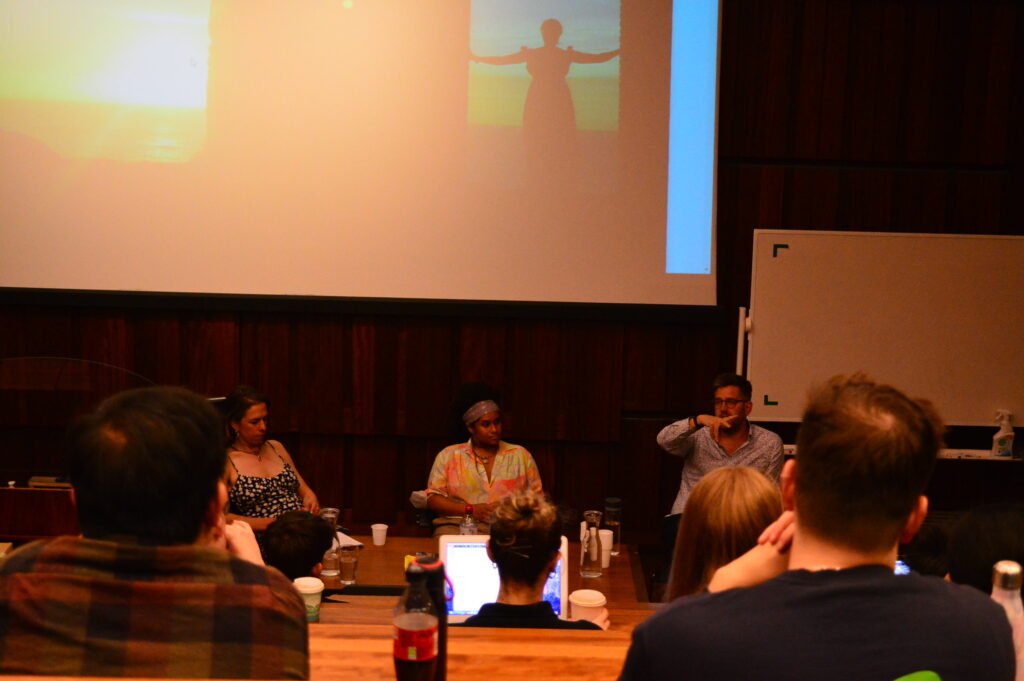
It's a delight and honour to introduce this blog post by Sara Pelham on our work, and our recent theatre workshop at the University of Oxford. This workshop was part of our consultancy with ERC TIDE, which explored the links between Emma Frankland’s upcoming production of John Lyly’s Galatea and TIDE’s project research into travel and identity in early modern England. Galatea is an extraordinarily important early modern English play, and yet the play has almost no stage history since 1588, and is only starting to be better known amongst academics and students. The play offers contemporary performers and audiences an unparalleled affirmative and intersectional demographic, exploring feminist, queer, transgender and migrant lives in a cast of characters that includes very few cisgender adult males, and builds towards the celebration of a queer and trans marriage. Emma Frankland, Andy Kesson, and a group of performers and researchers have developed a production of Galatea which foregrounds the role of migrants and migration in the play, and which aims to centre intersectional identities of all kinds. Galatea will be staged in May 2023 in the UK – we aren't allowed to be more specific yet, but keep an eye out for our show!
Dr Andy Kesson
An Afternoon with Galatea:
In the stuffy, tiered lecture room 2 of the English Faculty building in Oxford, Emma Frankland, Andy Kesson and Subira Joy introduced us to their work on their upcoming production of John Lyly's early modern play and queer love story, Galatea.
Exploring an early modern playwright other than Shakespeare was an enlightening experience. Unlike Shakespeare, Lyly wasn’t dedicated two entire mandatory terms of study in Oxford’s English literature degree. As we spent the afternoon engaging with Galatea some beliefs of mine were confirmed: that the early modern period is not just Shakespeare, and that we should perhaps take him off his pedestal!
Binary gender roles and patriarchal customs are commonly found in Shakespeare’s works and wider canonical narratives; and even in instances where early modern social expectations are challenged and resisted (like the notable crossdressing in Twelfth Night and As You Like It), these seemingly transgressive plays still conclude with cis-het-normative rectifications.
As a story that reveals the euphoric effects of crossdressing, deposits Neptune of from his position of patriarchal control, and ends with the divine approval of a queer union, Lyly’s Galatea, however, is a work that is feminist, accepting of queer love, and promoting trans joy.
The play’s queerness extends beyond its surface-level subversion of normative sexuality, gender identity and gender roles, and plays out more implicitly in its fluid setting. Even at the most fundamental, pragmatic level, binaries and boundaries collapse when we find out that the play was staged for a woman (Elizabeth I) and performed on a stage owned by a woman (Blackfriars). Everything about this work breaks contemporaneous conventions and Lyly has Venus clearly affirm in response, “I like well, and allow it.”
Revived for the first time since it was last known to be performed 500 years ago, Emma Frankland’s Galatea takes Lyly’s queer legacy and uses it to open up silenced narratives and uplift marginalised voices. She allows for an open-ended exploration of identity by applying the lived identities and experiences of her actors to the performance. She invites them to share elements of themselves in the project, instead of reducing their roles to a single category as happens in much mainstream theatre.
The production has unfortunately been in working progress for the past six years due to a lack of funding. What this delayed production has allowed, however, is an extensive exploration and sensitive understanding such dense aspects of identity truly deserve. During the workshop, Emma Frankland talked of how such time really allowed for the “undoing of each other’s gender” and the grappling with the play’s “gender confusion”. Questions like, “Is Galatea trans masc?” or “Philida doesn’t like wearing the masc clothes and Galatea does, does this make Philida trans fem?” were raised along the way. Initially a result of invalidation, the prolonged time it has taken to shape the project has opened up a positive space to explore identity in all its complexities and free the performance from rigid social expectations. It shows how stories are ever-expanding and can be pushed to encompass marginalised-inclusive spaces that were previously never made, let alone thought, possible.
This expansiveness was really felt in the lecture room itself. When Emma, Andy and Subira first entered lecture room 2 room, it was clear that the space was not ideal. It immediately created a divide between us and them. Emma pointed out that the set up was somewhat “hierarchical”. But they encouraged us to creatively acclimatize to it and this made me come to a lovely realisation: that queer people, who’ve been handed a cis-het-normative world, will find ways to make this space our own and claim our place in it. We will constantly make use of what we’re given, and make it better.
What also notably helped understand the space and discover its malleability was Andy Kesson’s suggested improv status game. The space was not ideal, but, with some roaming around the room of our own and some awful attempts at acting, I found that the game, in the given space, began to make more sense as it allowed for questions of agency (with its relation to status) to be explored.
Even with this short activity alone, the familiarity of the English lecture room – where hours of labouring lectures on the greats and the classics had been delivered to me – was beginning to break down. Our creative adaptation to the space we were given helped destabilise our rigid cognitive ways so that new understandings about status could arise.
My understandings of the Early Modern period and Shakespeare in particular were challenged upon hearing Emma’s, Andy’s and Subira’s thoughts on Lyly. Unlike the archaic ways of the past, Lyly’s work is very much in line with openness and acceptance of identity in the present. The workshop demonstrated how Shakespeare doesn’t have a story for everyone, and this is a notion that, as Emma declared, is “important to break down.”. Shakespeare isn’t the ‘universal voice’ he is often made out to be.
Within these few hours of the afternoon, I really felt Oxford’s academic tradition re-forming into something new, I felt my interests in works beyond the classics and the greats being validated, and most invigorating of all, I felt my identity, as a queer person in the arts, being affirmed. Such an afternoon is a rare find, which goes to show that the university still has so much work to do to make sure that these spaces remain open, and these conversations continue.
Sara Pelham
English and French
Exeter College, Oxford
Pearls and Empire
Prompted by our reading of the 1592 account of the English capture of the Portuguese ship, the Madre De Dios, published in Richard Hakluyt’s The Principal Navigations (1599), we were fascinated by the range of objects listed in the account, and chose to research more about the circulation of pearls. It was important for us that we think about the dangerous labour and production that underpinned the pearl trade, and not just their associations with beauty and luxury in European literature and art.
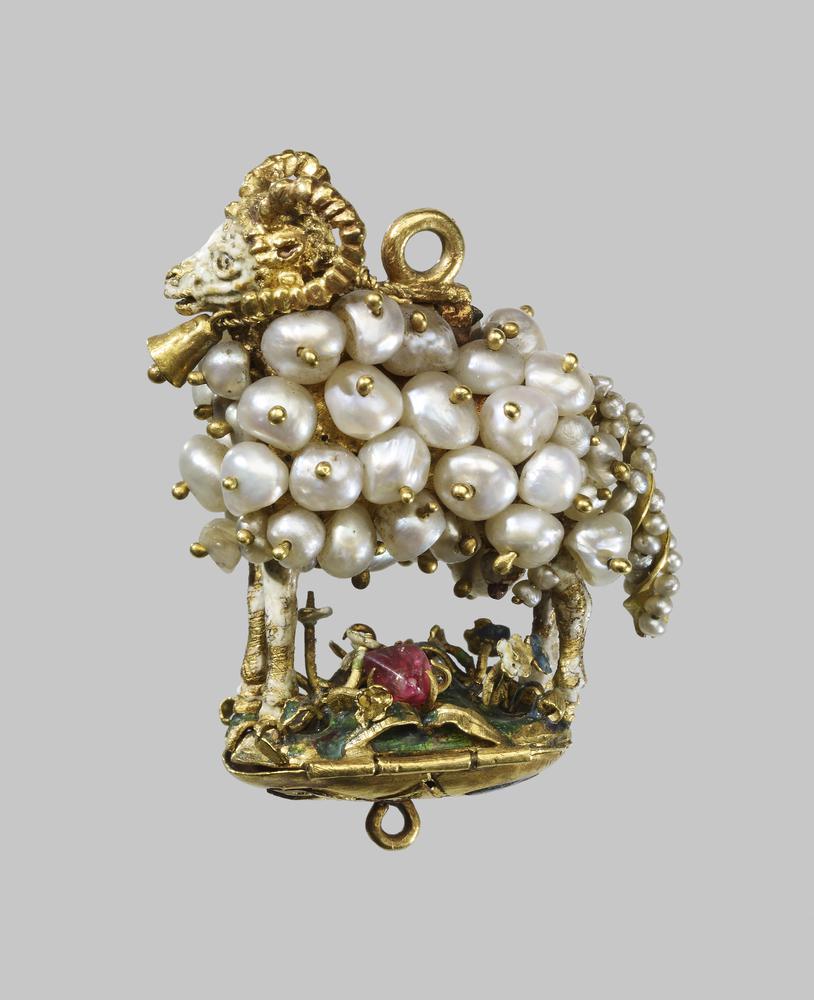 Figure 1. Standing Ram Pendant, British Museum, donated by Ferdinand Anselm Rothschild. The above pendant from the British Museum is believed to have been made in Spain during the 1500s with pearls sourced from South America.
Figure 1. Standing Ram Pendant, British Museum, donated by Ferdinand Anselm Rothschild. The above pendant from the British Museum is believed to have been made in Spain during the 1500s with pearls sourced from South America.
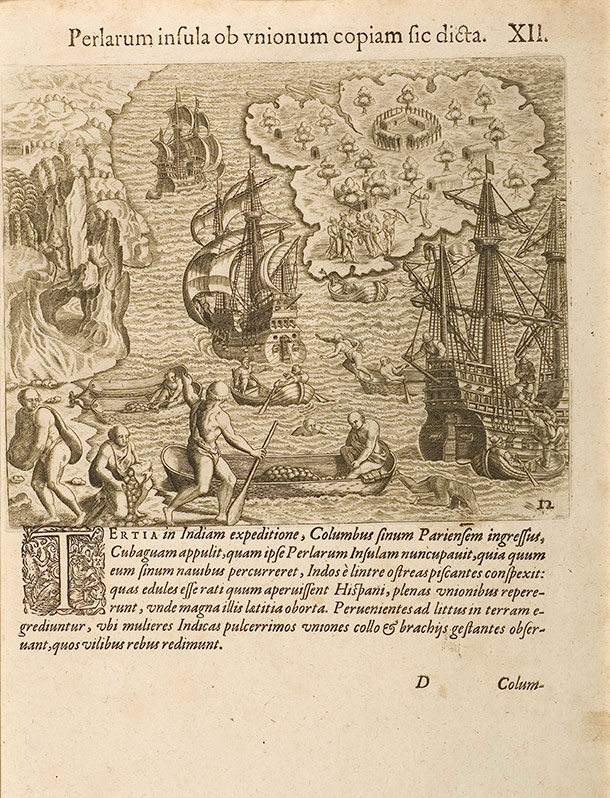 Figure 2. Pearl fishing in the Caribbean, from Les Grands Voyages (1590).
Figure 2. Pearl fishing in the Caribbean, from Les Grands Voyages (1590).
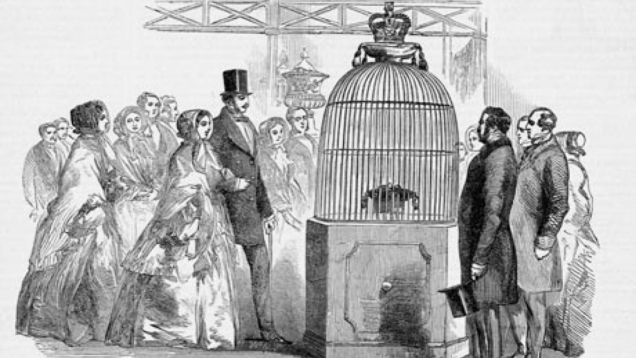 Figure 3: Illustration of the Koh-i-Noor on display at the Great Exhibition, featured in Illustrated London News (1851). Courtesy of the Victoria and Albert Museum.
Figure 3: Illustration of the Koh-i-Noor on display at the Great Exhibition, featured in Illustrated London News (1851). Courtesy of the Victoria and Albert Museum.
Grace Dye
In my first semester as a new assistant professor at Butler University, I incorporated ERC-TIDE’s open-access Keywords of Identity, Race, and Human Mobility in Early Modern England (Amsterdam UP, 2021) in my undergraduate British Literature survey on worlding and worldmaking. In the text we read, my class traced how British writers of the premodern past imagined the world and their place in it. To this end, our class was interested in how language contributes to world-building: particularly, how words shape our knowledge of the world, our encounter with difference, and our understanding of the expansive scope of space and time. Looking through the interpretive prism of TIDE’s Keywords, my students quickly realized that language points to conceptions of the world in two different directions: one aims at possession, control, and extraction, or what postcolonial theorists like Gayatri Spivak call “worlding”; and the other, worldmaking, especially when attached to marginalized communities, dreams of alternative worlds built around human and planetary interconnectedness or conviviality (see the scholarship of Paul Gilroy and Pheng Cheah).
The historical essay assignment builds on Amrita Dhar’s incisive and generative lesson prompts, which she details in a post on this website’s blog. In the spirit of circulating rather than hoarding knowledge, students chose a keyword each; they wrote about their keyword’s journey from the premodern past into our present; and most importantly, they shared the insight they harvested during lively class presentations. By emphasizing collaborative learning, this assignment provided a daily reminder that language and power are intimately connected; they exist as facets of the same apparatus through which we can detect the workings of empire and its mechanisms of racial terror. For example, the conversations around the keywords “rogue,” “vagrant,” “alien/stranger,” and “gypsy” offered a glimpse of a world defined against belonging and in relation to citizenry, surveillance, and control. Asking students to position their keyword in the context of worlding and worldmaking allowed them to draw informed conclusions about the constellations of material and figurative forces that survey and hierarchize the world we continue to inhabit.
Closer to home, words shape policy, justify war, and have consequences on real lives. To illustrate my point, I will focus on the keyword “rogue”; particularly, how my class’s discussion of this keyword opened up critical paths to explore the power dynamics that render a person, groups, or nations as threatening outsiders, in the premodern past as well as in our lived realities. In the “Act for Punishment of Vagabonds” (1572), my class detected the punitive language of the state in eradicating those who threaten its ideology. When we juxtaposed “rogue” with the keyword “citizen,” we discerned the rhetorical strategies that inversely authorize the ideal citizen from which these borderless people depart. More perniciously, this language hardens through time: what starts as policing “lawless” individuals in the premodern past morphs into the hegemonic control of “rogue states” in our present.
The word “rogue,” my class realized, was utilized to designate nation-states that did not adhere to the Western hegemonic world order. The same rhetorical strategies that legitimized the identification and persecution of outsiders in the premodern past, including vagrants and vagabonds, the poor and the homeless, seasonal workers and refugees, migrated into our twenty-first-century world. In United States foreign policy lexicon, the word “rogue” became a nomenclature for recalcitrant and racialized states such as Iraq, Iran, Cuba, and Libya, “whose identity is to some extent defined by acting outside of the standard rules of international law,” in the words of Former National Security Advisor Anthony Lake. This “rogue” designation justified aggressive intervention, from economic sanctions, to regime change, to violent bombing campaigns.
Undoubtedly, my students were amenable to making connections through a transhistorical arc because they have digested the main purpose of Keywords of Identity, Race, and Human Mobility: “to examine certain terms which repeatedly illuminated points of tension, debate, and change around issues of identity, race, and belonging throughout this period” (9). What this work makes crystal clear is that as present-day readers of the humanities, we cannot overlook, excuse, and rationalize histories of violence. As residents of an imperialist power on stolen indigenous land, one that continues to punish homeless and migrant people, criminalize borders, and violate the Global South, our duty is to address, to make legible, the attendant harm in the texts we read, as we dream of a just and harmonious future.
Mira Assaf Kafantaris

On the weekend of 31 July and 1 August 2021, following its ‘On Belonging’ conference, TIDE held a free online cultural festival. Through seven events, TIDEfest showcased the project’s five-year engagement with creative practitioners, bringing together all of TIDE’s visiting writers and a range of other authors, educators, and artists.
TIDEfest began with ‘Teaching Migration, Empire, and Belonging in Schools’ with writer Nikesh Shukla, historian Kate Williams, and teachers and researchers, Wendy Lennon and Hannah Cusworth. In the afternoon, Preti Taneja discussed her award-winning novel, We That Are Young, and shared the writing she had produced for the interactive multimedia collaboration, TIDE Salon. Written from the future, Preti’s ‘fragments’ powerfully layer places and time, where the era of social media and digital fragments share space with Sappho and dark matter, Montaigne and a new millennium. An archive, Preti reminds us, ‘is whatever falls into an envelope’. ‘Giving Voice Part 1’ was a creative writing workshop led by the award-winning poets Sarah Howe and Fred D’Aguiar, where participants were guided through a series of writing exercises that drew on objects, from a carved ivory salt cellar to Chinese porcelain, introduced by curators from the London National Portrait Gallery, Pitt Rivers Museum, World Museum, and Oxford Herbaria. The day concluded with Nikesh Shukla in conversation with the authors Yashica Dutt and Tanaïs, who discussed writing memoir, generational trauma, and ‘bringing truth to the page’. Throughout the day, there were multiple discussions about the destruction of archives, from Windrush records to Hindu temples, and about the responsibility scholars have to recover the fragments of the past. Writers also expressed the importance of making visible these processes of recuperation and to acknowledge the biases and ‘curatorial silences’ that might arise. This echoed Ladan Niayesh’s evocative reference in her paper for the ‘On Belonging’ conference a few days before: as with the rebuilding of Paris’ Notre Dame Cathedral after the 2019 fires, historians looking at the materials of the past must continually ask themselves what aspects of history to interpret, restore, make visible, and preserve.
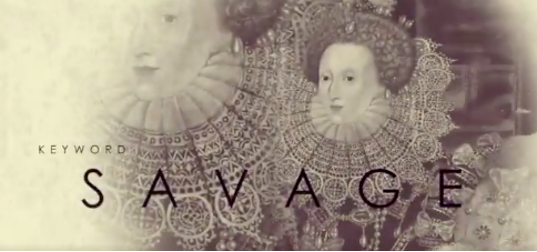
The second day of TIDEfest began with ‘Globes, Networks, & the Early Modern World’, an event featuring TIDE postdoctoral researchers Lauren Working and Emily Stevenson and the artist Loraine Rutt. The three discussed their forthcoming collaborative exhibition, ‘From the Middle Temple to Manoa’, organised with Middle Temple librarian Renae Satterley and forthcoming at Middle Temple Library in London in autumn 2021. Their discussion moved from early modern travel and contemporary globemaking to digital social network analysis, examining ways of bringing these different areas of exploration into conversation and effective collaboration. This event was followed by a reading by TIDE’s current visiting writer Elif Shafak from her new book, The Island of Missing Trees, and a conversation between Elif and Nandini Das about family memory, democratic rights, and how a book that adopts the perspective of a tree can invite us to step outside of our human perspectives. TIDEfest concluded with ‘Giving Voice Part 2’ with poets Sarah Howe, Fred D’Aguiar, and Sandeep Parmar. This final event saw the premiere of two film poems based on Fred and Sarah’s TIDE-commissioned poetry, and featured a discussion of the many poems submitted online as part of Sarah and Fred’s workshop the day before (you can read some of these on Twitter by following the hashtag #SpeakingObjects). ‘Giving Voice’ also unveiled a poem jointly written by Fred and Sarah as their own response to the workshop prompts. Fred, Sarah, and Sandeep spoke powerfully about the urgency of dialogue, excavation, and the need for writers and academics to work together to make sense of the present as well as the past. In the words of Fred D’Aguiar: ‘history is a scary place. I’m not going in there alone’. Celebrating collaboration and collective effort, it was the perfect way to bring TIDEfest, and the preceding ‘On Belonging’ conference, to a close, with a reminder that belonging and identity are rarely singular concepts; they exist as layers and intersections moving across borders, meaning different things in different places.
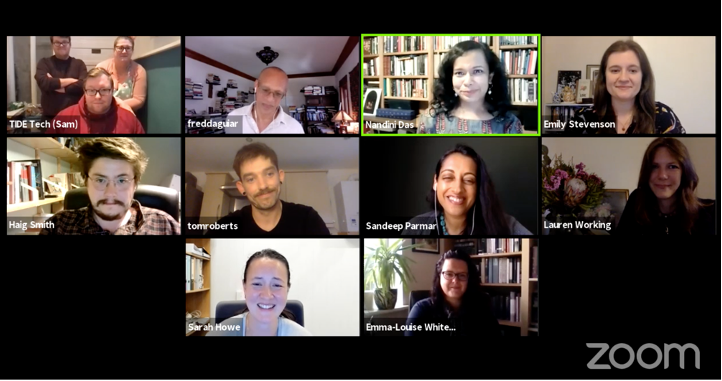
Lauren Working and Emily Stevenson
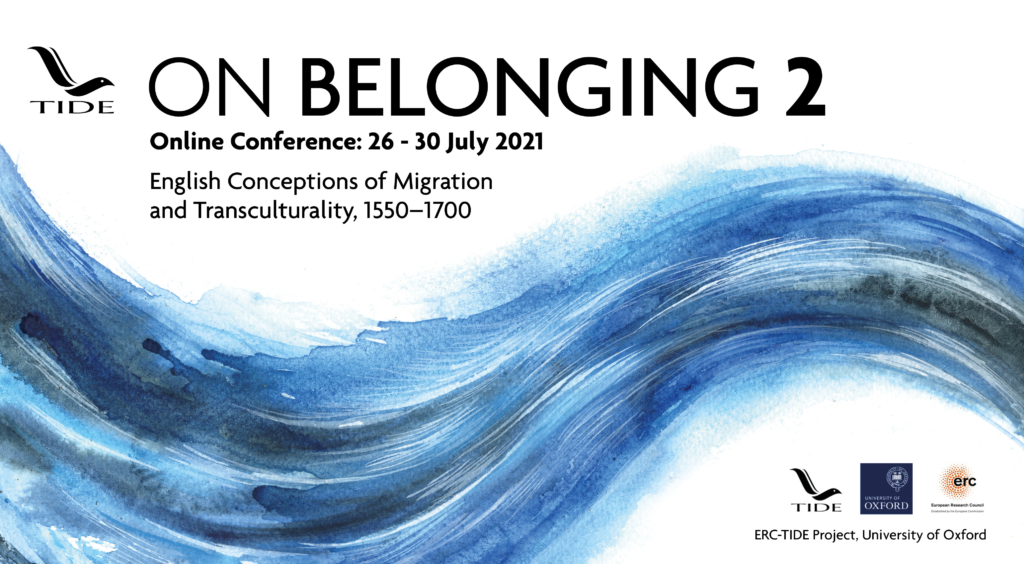
Almost exactly three years after our first ‘On Belonging’ conference, the TIDE team organised a digital follow-up to expand on and reflect upon the conversations we have had so far. Though COVID-19 restrictions took us online, running a virtual event also offered a number of benefits. We were able to offer a longer, much more expansive conference than before, and also trial several new initiatives to help make academic conferencing more inclusive, accessible, and communal. Spanning 5 days, ‘On Belonging 2: English Conceptions of Migration and Transculturality, 1550-1700’ included 2 social events, 15 panels, 3 roundtables, and 1 book launch, totalling 66 papers, presentations, roundtables, and creative sessions that amounted to 24 hours’ worth of digital content. Forgoing the traditional keynotes meant that each voice had an equal weight in these discussions of belonging, identity, migration, and race regardless of career stage. Pre-recording the sessions and making them available on YouTube and Crowdcast for preview and catch-up recognised the time restrictions of our different work and personal commitments, giving attendees the opportunity to engage in these conversations at a time of their convenience. For those who could not attend ‘On Belonging 2’ at all, proceedings were live-tweeted from the TIDE account across the week. In total, the account tweeted 500 times during the course of the conference, resulting in 114 new followers and over 24,000 profile visits. Without costly and time-consuming international travel, we were able to bring academics from Seoul and the US in conversation with academics in Oxford, and provide ECRs from Germany, India, and elsewhere with a platform to discuss their ideas on border crossing and borders crossers. In total, the conference’s innovative digital platform successfully brought together 66 scholars across six continents. The low running costs also allowed TIDE to offer attendance to all free of charge. In lieu of a fee, participants and attendees in full-time employment were instead encouraged to donate a discretionary amount to the Society of Renaissance Studies (SRS) in order to help fund their ECR and inclusivity initiatives – an innovative addition to registration that has helped set the template for how the SRS offers financial support.
It was both heartening and stimulating to see such a broad range of fields, disciplines, and perspectives brought into fruitful conversation across the week. For Day 1, sessions on ideas of transculturality, identity, and contemporary cultural perceptions provided a useful broader context for the conversations to come. A session on recording early modern travel experiences discussed rhetoric, life-writing, imagined worlds, and the racialisation of sound across several different forms of travel writing, confessional literature, and even legal examinations. The people who wrote these texts and imagined these worlds were the subject of the second session of the day, with papers on creative Italianate English identities, diplomatic belonging at the Mughal court, the perambulations of Italian performers in England, and the extent of female mobility in the period. In the afternoon, three five-minute lightning talks on animal and human go-betweens were followed by a session on cultural perceptions and seventeenth-century academic knowledge of Islam and ideas about Ottoman Culture. The final event of the evening, a roundtable organised by the Medieval and Early Modern Orients (MEMOs) project, took a wider lens to these kinds of cross-cultural encounters, providing fascinating insights into the social, political, economic, and cultural exchanges between England and the Islamic worlds in the early modern period.
Day 2 opened with a panel on the geographies of devotion, taking us from Caribbean pearl fisheries to the Ottoman Empire, and out on the open ocean for thoughtful discussions on seventeenth-century colonial meditations, Anglican obsession with the Greek Orthodox Church, and the religious significance that one English traveller gave his maritime experiences. In the afternoon, the sessions focused more on language, multilingualism, and different forms of translation. Following two insightful lightning talks on borderscapes in Aphra Behn’s Oroonoko and the Welsh heritage of two celebrated Italianate Englishman, a session on early modern translation cultures tackled standardisation, facilitating English access to Italian republicanism, and the role and representation of native interpreters in a celebrated translation of Peter Martyr. This session, comprised of members of the Paris Early Modern Seminar and the Translation and Polyglossia in Early Modern England project, provided attendees with fascinating and wide-ranging insights into the world of early modern polyglossia, from Italian miniatura to English limning, loanwords, the political ambitions of ‘truthful’ chronicles, and transcultural terminologies. The emphasis that all of these papers placed on the multiplicity of meaning attached to single terms led nicely into the final event of the day: the launch of Keywords of Race, Identity and Belonging in Early Modern England, a collection of essays on terms that were central to the conceptualisation of identity, race, migration, and transculturality in the early modern period. Members of the team were joined by Professor Jyotsna Singh to discuss the origins of the project, the process of choosing, drafting, and editing the keywords, and using the essays in KS3, undergraduate, and postgraduate teaching to interrogate ideas of belonging both then and today.
Day 3 focused more on conceptualisation of difference and belonging in a commercial and colonial context, beginning with an extraordinary roundtable that traced the debates over and development of foreign birth in English law. This was followed by a session on joint-stock companies, with each of the three panellists speaking on either culture, community, or corporation as/for overseas governance. An afternoon session continued on the theme of proto-colonial venture, with participants speaking on various attempts to map and demarcate difference and belonging in works of navigation, political commentary, and chorography. The often violent displacement that occurred when these imperial ambitions were realised was explored in the next panel with presentations on translation and enslavement, nonvolitional travel, and the exile’s continual search for home. Our role in presenting these stories and texts was the subject of the day’s last event, a rich insight from esteemed scholars on the process of editing early modern travel and colonial writing.
On the fourth and final day of the conference, attendees were treated to a whistle-stop tour of migrant London, with papers looking at multilingualism at the Royal Exchange, the Evil May Day riots of 1517, Italian gardens, and needleworkers of African descent in the parish of St Botolph without Aldgate. We then turned to the representation of these migrants and other groups on stage and in print with fascinating papers on humoral discourses of race and female otherness in Shakespeare’s plays, women under siege in English romance, and the construction of English and Moorish identities in the playhouse. The following session focused on a different, exceedingly popular kind of early modern entertainment: bear-baiting. The AHRC-funded Box Office Bears project treated us all to a masterclass in interdisciplinary research with insights into historical bear-baiting from theatre scholars, geneticists, archaeologists, and Zooarchaeologists. With our appetite for more ursine research whetted, the final event of ‘On Belonging 2’ asked us to consider the implications of the so-called ‘ontological turn’ on early modern conceptions of transculturality. For a conference that brought together scholars working in different fields both in the humanities and STEM, a discussion of Viveiros de Castro’s essay ‘And’ which posits the question, ‘what is at stake in this seemingly innocuous yoking together of heterogeneous fields?’, was a suitably challenging and provocative note to conclude on.
When organising a conference of this size using a more or less unfamiliar format, one is bound to run into some challenges and obstacles, even when in the safe hands of our superb tech team: Dr Sam Robinson, Dr Amy Chambers, and Dr Peter Good. However, perhaps the biggest challenge we faced when putting ‘On Belonging 2’ together was creating a productive, sociable, and safe space for participants and attendees. We like to complain about sour wine and suspicious sandwiches at conference coffee and lunch breaks as much as the next person, but that is also where we get to meet the scholars in our field, enthuse about each other’s work, and formulate new ideas. With most of us spending the year in lockdown unable to visit friends, family, and colleagues, and adjusting to the restrictions on research and teaching, we felt it more important than ever to try to replicate this space virtually. The team organised two social events, one for participants and one for attendees. The evening preceding the first day of On Belonging 2, Dr John Gallagher and TIDE’s very own Dr Tom Roberts organised an early modern travel-themed quiz for speakers and chairs. It was a roaring success thanks to John’s matchless hosting ability and some wonderful prizes courtesy of Amsterdam University Press, the Hakluyt Society, and Cambridge University Press. The second social event for both participants and attendees was hosted on the Wonder.me platform. Wonder is a virtual social space in which people can move an avatar between a number of designated ‘areas’ in a room using their trackpad/mouse/arrow keys. Once you move your avatar into an area, you automatically join a Zoom-like video chat with all the other people in that area. In this sense, it imitates that kind of large-group socialising where you can move easily between different groups to talk more with other attendees. Alongside ‘The Mitre’, ‘The Bear’, and other early modern spaces of conviviality, we also set up several areas as virtual ‘publishers’ tables’ where representatives from the Society of Renaissance Studies, Amsterdam University Press, and the Cambridge Elements in Travel Writing series could speak to any interested party about current/forthcoming publications and events.
The atmosphere of conviviality and support during this event and the conference as a whole was a testament to the kindness and generosity of many of those working in our field. We are proud that ‘On Belonging 2’ successfully fostered new and deepened old relationships between scholars of all career stages. Through our shared interest in examining the voices of people inhabiting transcultural spaces, we hope that TIDE has helped build a transnational and transcultural community to continue querying the established canon.
Che portasti tu d’Italia? (What did you bring from Italy?)
Io ne portai a fatica la vita (Barely I brought my life)
Michelangelo Florio’s (1518-1566) biography as an Italian religious refugee in London transpires in this short dialogue in his manuscript grammar Regole de la Lingua Thoscana (Rules of the Tuscan language) dedicated to his young aristocratic student Henry Herbert (c.1538- 1601) in August 1553.
Around a year before, the Florentine Florio interrupted his public role in the Italian Church in London after economic and doctrinal contrasts with other Italians, and an accusation of sexual abuse. Thanks to the interest of powerful figures (the Archbishop Thomas Cranmer, the King’s Secretary William Cecil, and the Lord Protector of England John Dudley,) Florio became private tutor of Henry Herbert and his sister-in-law Jane Grey. In fact, another undated version of the grammar was dedicated to Jane Grey who became queen for few days (10th - 9th July 1553), just one month before Florio’s dedication to Herbert.
Florio’s grammar was an advanced and less schematic alternative to William Thomas’s Principal Rules of Italian Grammar (1550), the first printed Italian grammar for English speakers. The Florentine praised Guilielmo Thomas’ grammar, but in his opinion, he proposed a better version thanks to more precise and extended explanations, especially in regard of the adverbs. However, the Italian could not publish his grammar in London. As the new Queen, Mary I, ordered the execution of Jane and the banishment of protestants in England, Florio had to flee once again in March 1554, starting a new life in Soglio, in the Swiss Grisons.
In his Regole, Florio included Italian exemplary sentences provided of Latin translations for maggiore chiarezza (better clarity) following each explanation of grammatical rules regarding articles, nouns, verbs, adverb, and other parts of speech). Most of these sentences tell us between the lines that the author was a religious refugee and anti-papist, i.e. a new kind of immigrant compared with the Italian merchants and bankers that had traditionally operated in England since the thirteenth century CE.
Indeed, Florio did not send clothes to Italy and bring wine back as did the merchant protagonist of few examples in part xvii of the grammar. In fact, Florio’s dramatic story appears in the subsequent example where a person brought his life from Italy instead of goods. Here he alluded to the twenty-seven months that he spent imprisoned and tortured in Rome, and the other persecutions encountered, due to his preaching of reformist doctrines in several Italian cities such as Rome, Naples, Padua, and Venice in the 1540s. Finally, Florio fled Italy reaching England on 1st November 1550 and taking on Bernardo Ochino’s position as minister of the Reformed Italian Church in London. Ochino was a celebre reformist preacher who had, since 1547, consolidated a corridor to the country of the protestant king Edward VI for Italians escaping religious persecutions.
Numerous sentences show Florio’s attempts to suggest an assimilation between his situation of unjustly persecuted individual to the one of the Church of England. For example: Quando fui tenuto in pregio dal Papa, non ero amato da Dio. Hora che dal Papa sono perseguitato, son’ certo che da Dio sarò tuttavia difeso (When I was appreciated by the Pope, God did not love me. Now that I am persecuted by the Pope, I am sure that God will defend me in any case). These models created to explain grammatical points (e.g. passive sentences and past participles in the previous sentences) offered Florio chances for fashioning himself to enter the grace of his new powerful anti-Catholic English protectors i.e the Greys, the Herberts, William Cecil Lord Burghley, and John Dudley Duke of Northumberland.
Moreover, Florio believed that language students and Christians both needed to find truth for themselves in their reading; even against authorities as it emerged in the sentence La dottrina del Vangelo piace à ognuno in fuori che al papa (Anyone likes the doctrine of the gospel but the Pope). So, often facing the impossibility of giving a regola ferma (firm rule) the personal preferences and explanations of grammarians, such as Florio himself or Pietro Bembo, could be ignored if more convenient for the language learning process. Ultimately the students had to find their way reading the authors: [...] qui potrei confermar’ quanto v’ho detto con l’autorità di Dante, del Boccaccio, e del Petrarca; ma sarei troppo lungo; leggendogli voi troverete la verità. (Here I could confirm what I said with the authority of Dante, Boccaccio and Petrarch. But I would be too verbose. Reading them you will find the truth).
Florio described himself as a povero forestiero (poor stranger) in the dedication to Herbert, but at the same time signalled in the entire grammar that he was not a ’spiritual stranger’ in England. Also, his grammar shows how his religious beliefs, and the practicality acquired teaching Italian language to foreigners, shaped his vision of the wide theoretical discussion on Italian codification (la questione della lingua). This discussion stimulated, during the same years, the valorisation of English language, in a nationalist and religious key, by Italianate and reformist authors such as William Thomas and Thomas Hoby.
Michele Piscitelli
University of Birmingham
Mxp792@student.bham.ac.uk
Linkedin: https://www.linkedin.com/in/michele-piscitelli-b7005375/
Midlands4cities Doctoral Training Partnership: https://www.midlands4cities.ac.uk/student_profile/michele-piscitelli/
Biography
Michele Piscitelli is a Ph.D. candidate at University of Birmingham, with a thesis on the presence, teaching and learning of the Italian language in sixteenth century England; in particular the project aims to certain gaps in the literature focusing on the pre-Elizabethan period and alternative sources for language learning beyond Italian-English manuals and vocabularies.
Between 1671 and 1677 John Covel, an Anglican cleric and fellow at Christ’s College, Cambridge, served as chaplain to the English embassy to the court of the Ottoman Empire. During this time, Covel travelled across large parts of Thrace and Asia Minor, before returning to England via much of Greece, Italy and France. Over the course of his travels, Covel devoted a considerable amount of time and energy to studying the Greek Church. This is hardly surprising, given that many Anglicans in this period regarded Greek Christians – because of their geography and history – as witnesses to ancient Christian tradition, who might be relied upon to clarify contentious points of doctrine between – and among – Catholics and Protestants. Covel certainly harnessed his engagement with the Greek Church in this way, using his experiences of Greek worship to intervene in a contemporary dispute among English divines over the use of the sign of the cross, particularly in baptism, where it was commonly performed over the forehead of the baptised.
In the second half of the seventeenth century, English Protestants were divided over whether the sign of the cross was a fundamental Christian behaviour, or simply a superstitious rite which had developed out of the Roman corruption of the faith in the Middle Ages. For the Presbyterian minister Richard Baxter (1615-91), the sign of the cross was ‘a (transient) Image, used as a means of Worship’, and ‘Therefore unlawful by the Second Commandment.’[1] Covel was of a completely different mind, however, owing partly to his encounter with the Greek Church in the Ottoman Empire, which had taught him the value of the practice.[2] In his correspondence, Covel related a story about ‘a poor Greek’ sentenced to death by the Ottoman authorities, whom he watched during his trial and execution, noting that:
when either he could not speak, through weaknesse of body or anguish of mind or else could not be heard amongst the thronging multitude, he in a manner continually made the sign of the crosse upon his breast, to signify to the world by this dumb Rhetorick his undaunted resolution of being and dying a true Christian. I confesse it made me wth great pleasure reflect upon that antient Rite used by our church in Baptisme, I mean ye sign of the Crosse.
Covel’s description here of the sign of the cross as ‘that antient Rite used by our Church in Baptisme’ was significant in and of itself, for it pre-empted the common criticism that it was merely a Medieval Catholic invention, without precedent in the early Church. In any case, Covel conceded that the sign of the cross ‘may seem a very uselesse and empty ceremony’, whether in baptism or among adult Christians, ‘to men that never lived abroad amongst unbelievers, nor considered the state of the primitive Church by which this practice prevayled’. Yet of course Covel, unlike most of his compatriots and colleagues, had ‘lived abroad amongst unbelievers’, where he had witnessed the persecution of Christians at the hands of the non-Christian Ottomans, which provided him with a different perspective on the sign of the cross. For under these circumstances, Covel had found the practice very useful, for it signified ‘throughout the whole world, where no other language is understood, that the person so signed is own’d, or owns himself to be a member of Christ’s body.’ By way of illustration, Covel informed the recipient of his letter that in Ottoman territories, the sign was commonly used by local Christians to ‘begge your charity, when all language is insignificant’. Covel also recalled using the sign himself, when he had travelled ‘in Turkish habit [or dress]’, in order to reassure frightened local Christians that he was of their faith, and thereby ensure that he was ‘immediately admitted and kindly treated’ by them.
Covel had therefore seen what it must have been like for those early generations of ‘primitive’ Christians, surrounded by ‘unbelievers’ and subjected to frequent bouts of persecution. Although English Christians no longer faced such challenges, the sign of the cross, even if used only in baptism, remained a potent symbol of Christian solidarity, of one’s resolution to ‘maintein the inward and spirituall fight against sin and the Devil’, and a crucial reminder that Christians, wherever they found themselves, ‘should not be ashamed publickly, even by this outward sign, to confesse to ye world and all the powers’ their faith in Jesus Christ. In Covel’s view, the sign of the cross was part of the ‘universal Character of a Christian, which was wisely introduced by our forefathers and ought still to be used’, particularly in baptism.
Thus Covel believed that his direct experience of a Church persecuted by non-Christians gave him unique insight, noting, as we have seen, that the sign of the cross only appeared useless to those ‘that never lived abroad amongst unbelievers’. In using the Greek Church to defend the practice, Covel distinguished himself from several of his Anglican colleagues, who championed the sign of the cross using the writings of theologians from the early Church. In so doing, Covel suggested that overseas travel, and exposure to religious diversity specifically, equipped one with a better sense of right belief and devotion, particularly when it came to contested issues such as the sign of the cross. Indeed, Covel’s defence of the sign of the cross vis-à-vis the Greek Church testifies to the role of early modern travel, and of transcultural exposure, in shaping and shifting travellers’ views of familiar debates at home, in ways that often distinguished them from their non-travelling contemporaries.
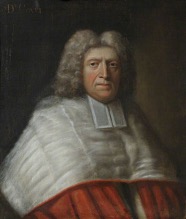 Fig. 1: Portrait of John Covel, c. 1716. Painted by Claude Laudius Guynier (fl. 1713-16), oil on canvas. Available via Wikimedia Commons.
Fig. 1: Portrait of John Covel, c. 1716. Painted by Claude Laudius Guynier (fl. 1713-16), oil on canvas. Available via Wikimedia Commons.
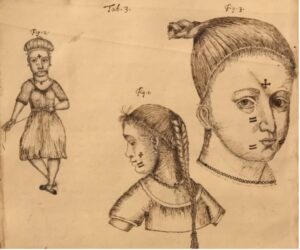 Fig. 2: Covel’s sketches of Bedouin women in North Africa, whose faces were inked with crosses, though they had long since converted from Christianity to Islam. See British Library (hence BL), Add. MS 22912, 27v.
Fig. 2: Covel’s sketches of Bedouin women in North Africa, whose faces were inked with crosses, though they had long since converted from Christianity to Islam. See British Library (hence BL), Add. MS 22912, 27v.
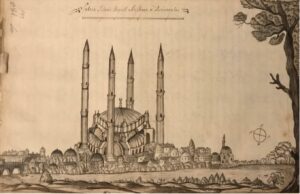 Fig. 3: ‘Sultan Selym’s Royall Mosque in Adrianople’, drawn by the French artist Jerome Saltier, whom Covel met in Izmir. See BL, Add. MS 22912, 231r.[3]
Fig. 3: ‘Sultan Selym’s Royall Mosque in Adrianople’, drawn by the French artist Jerome Saltier, whom Covel met in Izmir. See BL, Add. MS 22912, 231r.[3]
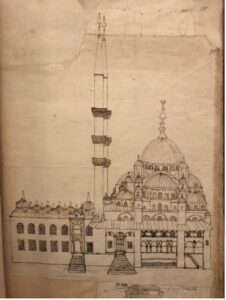 Fig. 4: Covel’s sketch of the New Valide Mosque in Istanbul. See BL, Add. MS 22912, 118r.
Fig. 4: Covel’s sketch of the New Valide Mosque in Istanbul. See BL, Add. MS 22912, 118r.
[2] Covel’s remarks about the sign of the cross are quoted from John Covel, ‘A peice of my letter to Dr Womock about ye Crosse in baptisme’, date unknown, London, BL, Add. MS 22910, 115.
[3] See also Jean-Pierre Grélois, ed., Dr John Covel, Voyages En Turquie 1675-1677. Texte Anglais Établie, Annoté et Traduit Par Jean-Pierre Grélois (Paris: P. Lethielleux, 1998), 108–9.
Charles Beirouti
University of Oxford
charles.beirouti@new.ox.ac.uk
Biography
Funded jointly by the Arts and Humanities Research Council (AHRC) and New College, my research centres broadly on the depiction of religious diversity in seventeenth-century English and French travel accounts, particularly those written by clerics who lived, worked and travelled in the Islamic world, stretching from the eastern Atlantic to the Indian Ocean. My broader research interests include seventeenth-century European travel and travel literature; Europe’s relations with and perceptions of the Islamic world from the Renaissance to the Enlightenment; seventeenth- and eighteenth-century British and French history, particularly religious and intellectual; the practice of Islam in the seventeenth-century Islamic world, particularly in the Mughal and Ottoman empires; and non-Muslim communities in seventeenth-century Islamic states, particularly Eastern Christians.
Something I’ve repeatedly come up against in my doctoral research is the perception of early modern England as a homogenous entity. Matthew Greenfield has rightly observed the problematic depiction of ‘English culture as a homogenous entity with clear boundaries, uncomplicated by the British question’. Happily, recent scholarship has done much to counteract this depiction, redirecting our attention to England’s elision and oppression of its archipelagic neighbours and to the uncertainties this produced. I want to try and apply this thinking more locally. Perhaps in addition to being complicated by ‘the British Question’ the ‘nation’ is complicated by what we might call ‘the English Question’. To that end, I’d like to turn to an underexplored moment in Henry V: the dispute between Corporal Nym and Ancient Pistol, to suggest that the oppositional dynamics of Henry V are not limited to England’s archipelagic or continental neighbours but encompass a wide variety of tensions within England as well.
We first encounter Nym bemoaning his lot in II.i, having lost both his fiancée and eight shillings to his erstwhile friend Pistol. Taken on its own, the scene is a humorous episode between two of Falstaff’s former drinking companions, preoccupied as usual with women and money. But when set against the backdrop of the civil unrest in Henry IV and the foreign conflict of Henry V, the scene raises questions. Just how unified is Henry’s ‘band of brothers’? The play as a whole insists on ideals of friendship and brotherhood while at the same time challenging and interrogating our assumptions regarding the unity they imply. The first instance of the former word appears in II.i – encountering Nym, Bardolph asks ‘are Ancient Pistol and you friends/yet?’ – and reappears throughout the scene. The interrogative ‘yet?’ sets the tone for the rest of the play, in which the bonds of friendship and brotherhood are repeatedly cast into doubt.
The scene’s position is also significant. This scene displaces treason from its announced appearance; it also offers our first glimpse into popular military discontent in the play. The Chorus’s assurance that ‘honour’s thought/reigns solely in the breast of every man’ – already cast into doubt by its mention of the traitors Cambridge, Scroop, and Grey – is further eroded by the quarrel in Eastcheap, which revolves around two distinctly dishonourable actions: Pistol’s theft of Nym’s fiancée and his failure to pay his debts. Although the scene implies that both issues have been settled, it is by no means clear that this is the case. Pistol and Nym may be ordinary soldiers, but they are also representatives of a national military entity. Their unresolved dissent in this scene points towards broader underlying fractures in the unity of the ‘happy few’ Henry casts in opposition to the French.
Nym and his companions are representative of a broader lack of enthusiasm for the war which runs throughout the scenes with common soldiers, even shadowing Henry’s interactions with fellow noblemen. By studying these moments of intranational conflict, then, we gain a better understanding of popular military sentiment, both in the play and in the cultural context in which it was first performed. At the time of Henry V’s composition there was significant popular resentment regarding both conscription and the fees levied to fund the war in Ireland. This resentment is played out not only in the more disreputable characters of Bardolph, Pistol, and Nym, but in the sentiments of those soldiers depicted as conventionally honourable, such as John Bates and Michael Williams.
Redirecting our gaze to such moments of intranational tension in the play allows us to challenge the idea that England as a whole was a homogenous entity. This might enable us to consider how England’s varied and often conflicted identities were understood by its inhabitants, then as now. In early modern London, for example, playgoers were in the midst of a substantial immigrant community composed of both strangers (those coming from overseas) and ‘Englishmen forren’ such as Shakespeare, who had migrated to London from more rural areas. That is not to say that some degree of division is incompatible with nationhood. Instead, let’s attend to internal divisions alongside those between England and its archipelagic or continental neighbours. Doing so enables us to reconsider Shakespeare’s England as a composite of parts rather than a cohesive whole, offering an alternate perspective on the problematic boundaries of the early modern nation.
Biography:
Chloe Fairbanks is a third-year doctoral student at the University of Oxford. Her research reconsiders Shakespeare’s treatment of national identity through an ecocritical and spatial lens. She is the co-host and co-writer of 'On the Nature of Things', a forthcoming podcast on how people of the past understood and interacted with the natural world. She can be reached on Twtitter @fairban_c.
In the late 16th century William Harborne, English ambassador to the Ottoman Empire, managed to secure a set of capitulations from the Turkish Sultan which reduced tariffs on English goods and paved the way for a fruitful economic relationship that would last until the dawn of the 20th century. Harborne’s friendly relations with the Ottoman elite, coupled with his knowledge of the Levant and diplomatic skill, has earnt him praise from scholars of Anglo-Ottoman history. Naturally, Harborne’s successors have received less attention. It is my intention to redress this imbalance by focusing on two letters written by Sir Henry Lello, who served as ambassador to the Sublime Porte in 1597. Lello’s mission and letters from Turkey highlight Protestant England’s desire to learn more about the Islamic world, but also shed light on the importance of information exchange in Early Modern diplomacy and how knowledge of ‘Eastern’ countries could be politically useful and economically beneficial when formulating wider state policy. Viewed from this perspective, Lello’s successes may have been more subtle than Harborne’s, but is equally deserving of praise.
Sir Henry Lello wrote two letters in relatively quick succession to the English Secretary of State, Sir Robert Cecil. In them, he informs Cecil of the imminent arrival of the Persian ambassador to Constantinople who is ‘expected daily’ and will discuss ‘the redelivery of the towns and fortresses he hath lately taken from the Grand Signour.’ In his next dispatch, written a mere 14 days later, Lello notifies Cecil of the arrival of the ambassador, ‘who was received with great pomp’ and who ‘cometh to demand those two great countries of Tauris and Sheryan, otherwise called Medea, which were won from the Persian by the Grand Signour.’ Lello’s description of the embassy and the relations between the Ottoman Empire and Persia make up a significant portion of his letter, and he goes into further detail about potential unrest in the Ottoman Empire which the Persians were looking to exploit. It must also be noted that Cecil was receiving similar information about Turkey and Persia from other clients, including the Shirley brothers. Furthermore, Lello sheds light on the relationship between the Sultan and Tsar of Russia, stating ‘another (ambassador) from the Emperor of Muscovia for the concluding of a perpetual peace’ is soon expected in Constantinople. Naturally, this leads us to consider why information about Ottoman-Persian relations and their wider diplomatic alliances were important to Cecil and Protestant England.
The most obvious answer is commerce, given the fact that English trade to both Persia and the Ottoman Empire could be sufficiently hampered by prolonged periods of conflict between the two. The Levant Company, set up under a charter by Elizabeth I, helped English trade to the Near East flourish. The English monarch was also keen to start a regular trade with Persia, with her merchants in Russia asking several times for a transit route to be restored along the River Volga, thereby allowing British merchants access to Persian markets. In addition, Lello’s letters could also be politically useful for English diplomacy with other Northern and Eastern powers. Knowing the Tsar was attempting to secure a peace with the Ottoman Sultan had the potential to remove a significant barrier to Anglo-Russian relations, as successive Russian kings, including Ivan the Terrible and Boris Gudunov, constantly questioned English support for the ‘infidel Turk.’
Whilst we have considered the importance of information to Cecil and the monarchy, it is also worth briefly exploring how providing these ‘intangible gifts’ of information on the Islamic world also benefitted ambassadors like Sir Henry Lello. Having written these letters to Robert Cecil in 1599, two years later we find a request from the same Henry Lello to Cecil, asking ‘for favour for his brother Hugh Lello’ ‘who desires some change in martial affairs.’ It seems that in return for providing information about the Islamic world, Lello was able to lobby Cecil for favours, including for members of his family, thus highlighting the reciprocal nature of information exchange in Early Modern England.
Viewing Lello’s mission from the perspective of information exchange allows us to shed a new light on his embassy to Constantinople, not merely as a footnote to William Harbourne, but as a successful diplomat in his own right who acted as an important source of information about the Wider Islamic World. Perhaps more importantly, his correspondence in 1599 also illustrates how important the ‘East’ and wider Islamic World was to the English crown. Given the West’s recent military involvement in the Middle East, there seems like no better time to highlight Lello’s embassy and this period of relatively peaceful exchange.
Shahid Hussain
University College London
Biography:
Shahid Hussain is a current MPhil research student hoping to complete his PhD at University College London (UCL) on the patronage and networks of British Ambassadors to Muscovy in the 17th century. He completed his Undergraduate and Master’s degree at UCL, where he investigated various aspects of Russian History in the Early Modern Period, including the military relationship between Muscovy and the Ottoman Empire during the reigns of Ivan the Terrible and Suleiman the Magnificent. A strong interest in diplomacy and the interplay between The West, Russia and The Islamic World has also culminated in a number of articles on contemporary diplomatic affairs for journals including The Diplomat and Modern Diplomacy. He can be reached on LinkedIn here, or by email at shahid.hussain.10@ucl.ac.uk.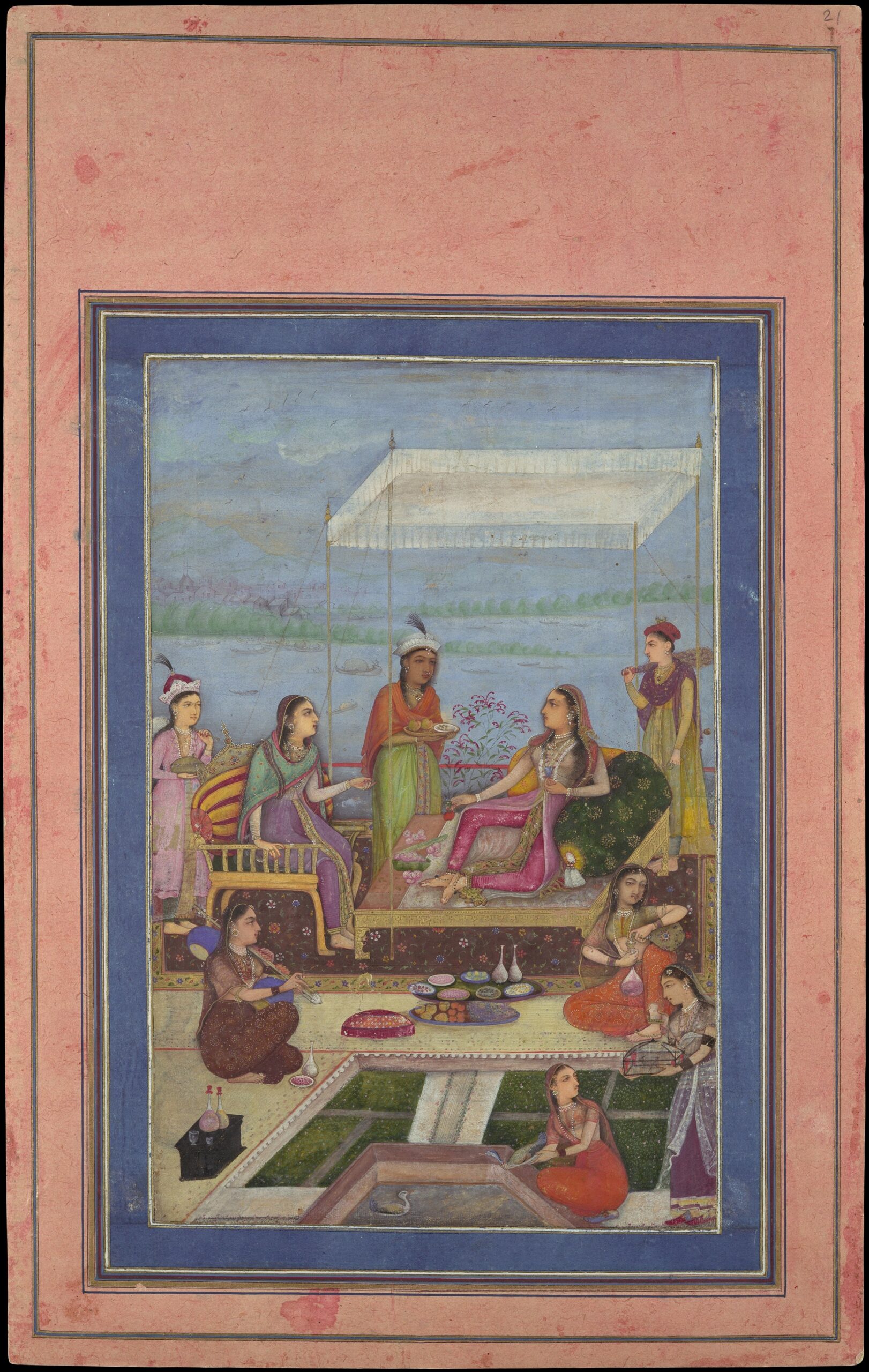
TIDE Salon is a radical new archive: a ground-breaking, interactive multimedia collaboration between TIDE, the award-winning novelist Preti Taneja, six extraordinary sound and spoken word artists (Steve Chandra Savale, Sarathy Korwar, Shama Rahman, Ms. Mohammed, Sanah Ahsan, and Zia Ahmed), curator and creative producer Sweety Kapoor, and critically-acclaimed filmmaker Ben Crowe (ERA Films). It is supported by the TIDE project, and the Humanities Cultural Programme, one of the founding stones of the Stephen A. Schwarzman Centre for the Humanities.
Background to the Project
Alien, stranger, foreigner, traveller, exile, citizen – these words are ubiquitous in contemporary debates about belonging and identity, yet many were shaped by travel, trade, and colonialism in the sixteenth and seventeenth centuries. The musicians and spoken word artists produced their work using TIDE’s research and drawing on their own personal histories and stories to ask:
- What do those words mean to us now?
- How does knowing their meaning and migration change our social world?
- Can we communicate across form, distance and time to explore the politics of translation and its lived realities?
From Drawing Rooms to Digital Realms
Though often associated with early modern European literary culture, salons were also prevalent among Asian elites in the sixteenth century. This collaboration takes the intimate ghar (home)-style salon as its inspiration to explore transculturality in the early modern period and today, evoking the creative atmosphere of early modern salons and their mix of scholars, poets, and artists.
‘The journey of words and their meanings that people carry as they travel physically and figuratively from their real and imagined homelands to the lands of their destinies and legacies, formed the conceptual basis in my curation for the TIDE Salon project. Drawing from the inspiring wellspring of the TIDE project research, I sought to bring together artists who embody this complex matrix of space, time, mobility, language, identity, tradition and faith. Along the entwined twins of a jugalbandi—a conversation of two equals whose unique strategies result in new, unpredictable moments of creative kinship—there are also the ghosts of the past, the present and the future who whisper secret incantations into the atmosphere. These special collaborations between six highly talented British musicians and spoken word artists of South Asian descent are in response to operative TIDE keywords, that have journeyed to a moment in time inheriting meaning and heft, and are now subject to contemporary socio-cultural and political forces. The result is a sort of creative register formed of these atmospheric sounds and voices, echoing in turn, the artists’ own histories, memories, conversations, and journeys, not to mention ours as well. The inheritance of words morphs with time, and with the tide.’
– Sweety Kapoor (Curator and Creative Producer)
While the collaboration originally entailed a one-off, ticketed event for a public audience, the outbreak of the Covid-19 pandemic and the lockdowns that ensued transformed the project in unexpected ways. The interactive installation that has emerged, created by Ben Crowe (director of ERA Films), showcases the pieces produced by the artists and spoken word poets while simultaneously offering an inside look at the process of collaboration and ‘doing’ history. The installation is a salon, port, and archive all at once: a place where different layers of source material mix and mingle, allowing visitors to hear new music, embark on a series of visual and textual discoveries, and gain behind-the-scenes access into the ideas and exchanges that produce creative work.
‘These creative collaborations between some of our best music and written/spoken word artists, framed by Preti Taneja’s original fiction and drawing on the work of TIDE, reimagine the potential of what a digital archive can offer a Renaissance one, all from a “future archivists” perspective. The installation dissolves the boundaries of time to present the artists’ reconfigurations of the relationship between the distant past and the highly-charged political present: it also mirrors a sense of journey and discovery at the heart of creative work, as well as research, and allows people to form their own narratives from the fragments. It embeds the non-linearity, plurality and interaction necessary to challenge binary narratives of identity, and celebrate the complex mutuality of our social world. I think it's a radical new kind of archive.’
– Ben Crowe (Filmmaker and Installation Designer)
The digital installation allows visitors to navigate their own routes. No two journeys need be the same. From the embarkation page, click the journey map and choose your own voyage through keywords, soundbites, video clips, images, poetry, and literary fragments. These interconnections are meant to replicate the messy, eclectic process of historical research itself, where different ways into source material can influence the stories we tell, and where archives often invite self-reflection and creative expression. You are accompanied by three fragments by Preti Taneja, written as if found by you, as you encounter an archivist and a translator working a century on from now.
‘The fragments are in a unique form: part translation, part diary of desire; one is a ghazal (for “Savage”): they are inspired by and include material drawn from the process of the actual TIDE researchers, the keywords they collaborated on and material and music provided by the TIDE Salon artists, which can be found through the whole installation. I also draw on the work of Sappho, William Shakespeare, Michel de Montaigne, Walter Benjamin, Agha Shahid Ali and more. Working in oral puns, overheard lyrics, canonical texts, original ideas, and found phrases, the fragments can be read in any order – yet they speak to each other, forming a conversation across the installation and offering a story of TIDE, the Salon artists and our times full of isolation, digital connection and pixelated dreams. They allow the researcher to discover them in their own time and space of longing for unity beyond hierarchy, reversing through the installation itself the divisive project begun by Empire, allowing the researcher through interacting with the fragments and the installation to embrace and celebrate hybridity in all forms.’
– Preti Taneja (TIDE Visiting Writer, 2019-2020)
The musical experience we had originally planned for our in-person event has come full circle. While lockdown might prevent us from all meeting in person, you can now experience the salon in your own home. By the seventeenth century, English travellers noted the Ottoman and Persian taste for sharbat (‘sherbert’), a drink made from water, sugar, and dried fruits, flowers, and spices such as peaches, saffron, or mint (when George Sandys visited Constantinople, he wrote of ‘sundry sherberts...some made of sugar and lemons, some of violets, and the like’). So stir yourself a sharbat and journey through the fragments, accompanied by the sound of travellers moving across thresholds, searching for home: ‘open at a page that moves you’.
On November 9 and 11, ERC-TIDE hosted a series of two online seminars coorganised with the LARCA research centre (UMR8225, Université de Paris) on “Polyglot Encounters in Early Modern English Narratives of Distant Travels”. With more than 300 participants from around the world for each session, the topic and attendance were very much in resonance! The speakers took us from the nearly-next-door of Richard Hakluyt’s Christ Church and Thomas Crosfield’s Queen’s College in Oxford to the New World of explorers Jacques Cartier, John Davis, and Thomas Frobisher, with mediator figures ranging from translator John Florio to the supposed Indian descendants of the legendary Welsh prince Madoc. Meanwhile attendance at the seminar ranged as wide as Islamabad, Bogota, Montreal, Dijon and Rome for fruitful exchanges on transculturality and multilingualism in the period.
The two sessions aimed at exploring the practices and strategies underpinning polyglot encounters in travel accounts produced or read in England. Drawing on linguistic, lexicographic, literary and historical methodologies, we looked into some of the contexts and significances of textual contact zones and communication circuits. Particular attention was paid to uses of polyglossia in processes of identity construction, defining and promoting national and imperial agendas from commercial to university circles, appropriating and assimilating foreign linguistic capital, but also meeting resistance and limits from linguistic and cultural others refusing to lend themselves to subaltern status.
For the first session, Andrew Hadfield (University of Sussex) beautifully guided us through some of the ways in which the Madoc legend, propped up by fanciful etymologies of Indian words, was enlisted to serve the Anglo-British agenda of imperial expansion. Sarah Knight (University of Leicester) aptly followed on the commercial and scholarly ramifications of imperial thinking, unpacking early modern English universities’ rhetoric in addressing cultural and linguistic difference through sartorial analogy.
For the second session, Donatella Montini (University of Sapienza Rome) cogently complicated existing models of translation/communication circuits by considering the case of deliberate retranslations, focusing on the textual journeys of Cartier’s account of his Canadian voyages through Florio’s choice of translating them out of the Italian of Ramusio’s Delle Navigationi e Viaggi rather than their original French for Hakluyt’s Principal Navigations. Mat Dimmock (University of Sussex) brilliantly nuanced questions of identity and authority by looking at the records of Inuit vocabulary in accounts of Frobisher’s and Davis’s journeys in the Far North, with natives turning the tables around on their “discoverers” by pointing at their difference and their singularity.
These two engagingly rich sessions were chaired respectively by Laetitia Sansonetti (Université Paris Nanterre, Insitut Universitaire de France) and Sophie Lemercier-Goddard (Ecole Normale Supérieure de Lyon, IHRIM). The material covered throughout will be part of the larger project of “Translation and Polyglossia in Early Modern England” and its “Polyglot Encounters” series with Brepols Publishers, under the general editorship of Ladan Niayesh and Laetitia Sansonetti.
For the practical organization of these events, we are much beholden to Rachel Willie and the Society for the Renaissance Studies, opening to us the beautiful showcase of the SRS Crowdcast platform, where recordings of both sessions will be kept:
Ladan Niayesh
By the time I completed planning the semester-long arc of an undergraduate seminar on ‘Movements, Migrations, Memories’ for The Ohio State University’s English course on ‘Studying the Margins: Language, Power, and Culture,' I was sure I wanted to use TIDE Keywords in my class as testaments to the changing valences of words we think we know, but which have multifarious and sometimes surprising histories of usage. I wanted my students to take away that language is not neutral, that it has a history, and that that history is not unconnected from prevailing ideology.
My course was designed for students to ‘consider contemporary texts in a variety of genres as we examine how movements, often at the intercontinental and planetary level, form and inform our current sense of human inhabitation of the earth and our responsibilities towards each other in an era of unprecedented mass migrations and human influence on the natural world’ (from the course description in my syllabus). The course goals were: a thoughtful sampling of a variety of contemporary works exploring movements, migrations, and margins; developing awareness of and empathy for familiar and unfamiliar ways of longing and belonging in the world; inculcating methods and strategies for interpreting complex ideas and language, and explaining those interpretations in precise oral and written work.
Most of our readings were in recent or contemporary writings: Thi Bui’s The Best We Could Do (New York: Abrams, 2017); Amitav Ghosh’s Gun Island (New York: Farrar, Straus and Giroux, 2019); Mohsin Hamid’s Exit West (New York: Riverhead Books, 2017); Valeria Luiselli’s Tell Me How It Ends: An Essay in Forty Questions (Minneapolis: Coffee House Press, 2017); Marjane Satrapi’s Persepolis (London: Vintage, 2008); and many of the Refugee Tales from the three volumes edited by David Herd and Anna Pincus (Manchester: Comma Press, 2016, 2017, 2019). In addition to these readings which would eventually lead to the term papers (on research questions of the students’ choosing), however, there were also short readings geared towards oral presentations. That is where TIDE Keywords came in. Students were asked to read the TIDE Keywords Introduction for an orientation of why the keywords warranted a close look, and to pick one keyword to read thoroughly about and present on. The goal was to collectively hear about as many keywords as possible in the class—a class of seventeen—and we therefore didn’t want to “repeat” keywords. The questions that each presentation had to address were:
- - what is the history of the keyword in question? (i.e., please provide a summary of what you read in your Keyword chapter.)
- - what in the history of the keyword you read has been surprising to you, as you encountered that history from a 21st-century perspective?
- - having read the keyword of your choice, what contemporary examples/issues/matters come to mind, and why? (i.e., how would you connect what you read to the world around you today?)
- - and finally, open-ended-ly: what questions came up for you?
Each student would present their keyword for fifteen minutes, with up to fifteen more minutes for subsequent comments and questions. After the day’s presentation, the student would also summarise the main points of their presentation into a single-page document and submit it to me through the class website on Canvas. In my evaluation, I would grade along the following criteria: the student’s ability to address the assignment prompt; the student’s clarity of comprehension and presentation (i.e., their care about the comprehension of the rest of the class); their engagement with what they read and their ability to make cogent and thought-provoking connections with the world they lived in; and their ability both to ask substantive questions of their classmates and to field questions that they received. Students were welcome to bring PowerPoint slides for their presentations, if they wanted to.
As my students picked their keywords, the choices varied between what they thought they knew, and what they knew they didn’t. For instance, if ‘Foreigner’ was an apparently known concept, ‘Denizen’ was not; if ‘Jew’ was potentially known, ‘Blackamoor’ was not; if ‘Merchant’ was possibly known, ‘Mercenary’ was not. Since the editors of the TIDE Keywords have provided such a rich array of known-unknowns and almost-knowns, and since the appearance of the keywords on the web page encourages scrolling and browsing, my students had no trouble picking seventeen different keywords on the day of the sign-up. The choices came accompanied with comments such as ‘I know what this word means now, or I think I know—but I wonder what that word meant in the sixteenth and seventeenth centuries,’ or ‘I mean, it’s still English, but is it the same English?’ or ‘I’ve never heard that word before, I want to know what it means!’
The presentations occurred over a period of five weeks, with up to two presentations in each class meeting, and the class meetings themselves held twice a week. Owing to the US lockdown over COVID-19 in spring 2020, a couple of presentations carried over to online formats. Whether the presentations happened in person or online, the students consistently demonstrated both genuine curiosity and engaged attention with one another. I see this as a testament both to the intellectual integrity and generosity of my students, and to the accessibility of the keyword chapters themselves. The students wanted to do the reading and did do the reading. And, in a few cases, students also ‘read along’ with their classmates even though they were not themselves responsible for presenting particular keywords. This, of course, only led to richer discussions, with the work of a few helping to propel the whole class into deeper conversations and more thoughtful back-and-forth. In keeping with my pedagogical principle of facilitating situations where students can and even must teach each other, I usually held back for the first ten minutes of the q-and-a unless specifically asked (when I was specifically asked, it was usually where a student wanted to double-check with me about historical context). I knew, and my students knew, that the weight of the class discussions was on them—and they carried that weight beautifully.
Here are some of my favourite instances from the questions and comments I heard, and also had the pleasure of responding to or building on over the weeks of the TIDE Keyword discussions: ‘You know, being a denizen sounds like being a second-class citizen—like if you’re from Puerto Rico [and in the US]. We like your taxes, but we don’t like you.’
- ‘You’re saying that being a pirate was actually legal?!’
- ‘I knew that people couldn’t have been calling themselves pagans—it was the Christians calling them that. Which explains some of the things they [the Christians] said about them [the pagans].’
- ‘I’m seeing that Merchant of Venice speech about an ‘alien’ plotting against a ‘citizen’ now in a whole new light.’
- ‘The word they’re using is ‘rogue,’ or even ‘gypsy,’ but really, they’re using these categories to define disability, in a way. Otherwise why go on about the ‘sturdie’ beggar or vagabond?’
- ‘The way we refer to people, that is, the terms we use, has consequences for how people are legally treated.’
- ‘Wow, I didn’t know that passports were something that not everyone could get!’
- ‘Can one become a stranger in their own home/country?’
- ‘So, the nervousness about the alien is a nervousness about their allegiance, isn’t it? And I also thought about how we hear a lot of ‘yes, please bring your diversity to this country [the US]’ but at the same time, ‘now please learn English and perform your belonging’.’
- ‘That reminds me, did you know that a study found that a whole lot of US citizens could not pass the US citizenship test?’
One fallout of this emphasis on discussion was that we often spent half the class period on the presentations and the lively deliberations and debates that took off. In a class time of 80 minutes, we frequently spent 45 minutes on two TIDE Keyword presentations. I don’t regret this, because as the days passed, I inculcated some important skills myself: of explicitly building aspects of the students’ discussion into my own lectures (for instance, of an ‘alien’ condition as having parallels in the lives of unaccompanied minors crossing the US-Mexico border, as Valeria Luiselli’s book discusses); of offering some summative comments and remarks to further contextualise the keywords for the class (for instance: yes, ‘Indian’ remains a very fraught word, especially in the US, with this country’s history of Native genocide); and of generating keywords-related study-questions for texts we were about to read (for instance: in Amitav Ghosh’s novel, what picture do we get about the belonging and loyalties of a global ‘citizen’?). It is also—always—a joy for me when the point-following-point kind of discussion that I have modelled for my class is actually taken up and emulated by my students—and I can sit back for a while and just steer. But when I do this TIDE Keywords assignment again, I shall provide a bit more scaffolding—telling students, for instance, how much time to spend on each part of the presentation (I shall recommend no more than 3 minutes), and asking each student, before their presentation, to send on to the rest of the class a paragraph of about 300 words outlining the thrust of their initial interest and findings (something along the lines of ‘I started this research because I thought I knew or wanted to know X, I found out Y, and I shall talk in class about the connections with Z’).
In a mid-term check-in, and in end-of-term reflections, students documented how valuable they had found their engagement with the keywords. One student wrote: ‘Much of my learning in this class came from our in-class discussions that followed our keyword presentations. The presentations were great because they allowed me to learn the origins of key English words and how those words were used to push ideologies and oppress marginalized groups. And with this, our class discussions that followed allowed us to address tough questions regarding these topics of oppression, and receiving varying viewpoints on these questions helped open my mind to various possibilities.’ Another wrote: ‘[Without the TIDE Keywords assignment] I would have never seen parts of history repeating itself again and again, I learned so much from my own keyword project that I would have never expected to learn.’
I shall close with a mention of one final and valuable aspect of the TIDE Keywords: that they are free and open-access. I teach on a campus where students often struggle to purchase or rent textbooks. To me, to them, the TIDE Keywords functions as a gift.
Amrita Dhar
dhar.24@osu.edu
In 2019, ERC TIDE and the Runnymede Trust created a twelve-week professional development programme to provide teachers with subject expertise, practical experience, and pedagogical methods to reinvigorate their curriculums. The Beacon Teacher Fellowship enabled and empowered teachers to develop creative and innovative approaches to the teaching of empire and migration. Findings from the Fellowship and the research of TIDE and the Runnymede Trust resulted in the Teaching Migration, Belonging, and Empire report that was presented to government in parliament in July 2019 by Jason Todd, Kimberly McIntosh and Nandini Das, supported by the Beacon Fellows and TIDE researchers.
A year on from the fellowship, I’ve asked some of the Beacon Alumni to reflect on their work; the opportunities they have created to include a rich, nuanced, decolonised curriculum; the challenges they have faced; the whole school curriculum audits that have taken place; and the impact of being involved in the TIDE Beacon Fellowship. For many years, teachers and students have campaigned for changes to be made to the teaching of history, with the Runnymede Trust calling for the teaching of migration to be mandatory in secondary schools. Here, I investigate how some have taken on the challenge and sought change in their own learning environments.
Clare Broomfield, head of history at Villiers High School, Southall, explains how she has adapted the history curriculum: Working in a school where almost the entire student body is of a BAME background, it was becoming clear to me that our current history curriculum was not doing enough to show them where they fitted into, as Michael Gove termed it, our island’s history.
The course began in a way James Baldwin advocated. We were asked to consider our own unconscious bias, to be made aware of what we were bringing to any lesson on migration, empire and race that we may be teaching. The course allowed me to develop a series of lessons, based around a key enquiry question on the migration of groups to my school’s local community. Without the course I would not have had the knowledge, and the confidence, to completely rewrite our KS3 curriculum. I am now armed with the language and tools to guide the students I teach through this complex nuanced history.
Roz Morton, an English teacher at Chesterfield High School in Liverpool, shares her experience: The absolute professional joy of being involved in the TIDE Beacon Fellowship halted my descent into cynicism and provided me with both a challenge to improve my knowledge and a structure to implement something meaningful. I set about it with enthusiasm, much supported by my fellow Beacons, as we opened lines of enquiry with one another and critiqued ideas and texts together. The end result for me was a fantastic final term with my Year 10 English class as we used the texts studied on the Fellowship, paired with contemporary non-fiction, poetry and prose extracts, to explore questions of migration, empire and identity.
The ongoing impact of the Fellowship in my own school is linked to the work I did with my Year 10 class during the TIDE programme, which has now transposed into a ‘Spine Unit’ for Year 9. This approach has engaged pupils across the ability range in a much more diverse body of literature and led them into the study of Stephen Kelman’s ‘Pigeon English’ with a more readily empathetic attitude to Hari and his tribulations. The knock-on effect of sharing this work, and the lines of enquiry behind it, has been a developing awareness that the rest of our curriculum must be challenged and examined in a similar way.
It’s difficult to pinpoint the greatest barrier to the ongoing success of this work because teaching is so often about managing a myriad of external pressures, but certainly one in my own setting is the shifting personnel and therefore dynamics, confidence, expertise and enthusiasm of the department: the crisis of retention in teaching has serious ramifications for our ability to embed systemic rather than superficial change. It’s a challenge, but it won’t stop me trying.
Another important aspect of the Fellowship was the inclusion of a range of educators, including Laura Turnage, Programme Manager for secondary schools at The Museum of London. Laura reflects on the impact of the Fellowship in her educational setting: I was delighted to be accepted onto the scheme. My work revolves around finding new ways to engage KS3 students with London’s fascinating stories and facilitating discussions. I had recently been given the responsibility of becoming the Learning Specialist for Schools for the new Museum of London project.
Participating in the scheme was inspiring, I often felt in awe of the confident and brave teachers I joined. Their reflections on the weekly readings gave me an opportunity to learn. I increased my knowledge of the time period we were focusing on. I gained a more creative outlook from listening and participating in discussions and they provided insights into classroom teaching that I was unaware of and, I hope, I gained a little bit of their determination too.
I have two key learnings that I try to input into any discussions we have at the museum around these topics. Firstly, a handy reminder, that students always visit the museum with preconceptions about how the world works and we must understand what their view is first. Secondly, the feedback I received when preparing for my presentation in the final session, to try making the familiar unfamiliar, and the unfamiliar familiar. These learnings help me to question decisions we’re making around the needs of schools now, and at the new museum.
Since the Beacon Teacher Fellowship, I’ve introduced the project to the Secondary Learning Network - a group of professionals in the museum and heritage industry that work directly with secondary schools. I continue to actively use my participation in the project and have compiled a list of primary sources available on the museum website for teachers to use in the classroom.
Lauren Cowan, an English teacher and KS3 coordinator at a KS3-5 comprehensive secondary school in North London, shares her personal motivation and professional teaching experience: As someone who has stories of migration in my immediate family, I came to the Beacon Fellowship with an interest in what it could teach me about my own history and identity, but more importantly I hoped that the Fellowship could enrich the teaching and learning of these subjects within my school, as it had become clear to me that the story of our nation’s diversity wasn’t being adequately or accurately reflected in the curriculum.
A year on from completing the Fellowship, my department now teaches two KS3 schemes of work that directly engage with the subjects of migration and includes some opportunities to engage with these subjects within pre-existing schemes of work. Feedback from students and staff has been overwhelmingly positive and the department is committed to doing more moving forward.
Beyond my department, I established a working party comprised of my school’s humanities leads to consider how we can develop the teaching and learning of these topics across our subjects. Our project has been revived by the renewed national interest in decolonising the curriculum. English, geography, history, RS and citizenship will all be ending this academic year by beginning the process of formally auditing their curriculum, to assess the quality of engagement.
The senior leadership team is in support of our project and has indicated that our work will be used to inform wider curriculum development. Fortuitously, this coincides with my school’s development plan to redevelop our KS3 curriculum from the next academic year onwards; I am optimistic about a motion for all departments to assess the quality of their engagement. I am also excited to work with my school’s newly appointed BAME coordinator who has some related school-wide plans that have potential to effect real and lasting change.
Finally, Dr Gillian Groszewski considers the impact of changing institutions and her continued commitment to developing the KS3 and KS4 schemes of work: My experience of the Beacon Fellowship was both personally moving and professionally stimulating. The presentations by teachers who had integrated modules on race successfully into their schemes of work gave me ideas about how to blend specific lessons into the existing curriculum.
As the year progressed, however, I made the decision to leave my school. During interviews, I was asked what kind of module I would like to create for the English department; I always answered: one on race and empire. I secured a new teaching position and am now happily part of a department committed to reviewing its curriculum in light of the need for more diverse representation of gender and ethnicities.
Following the Beacon Alumni reflections and the application of our practical experience in a range of settings, the group of dedicated Beacon teachers are currently developing a Beacon Alumni Training Pack for other schools and educational settings to train teachers in how to diversify their curriculums.
Wendy Lennon
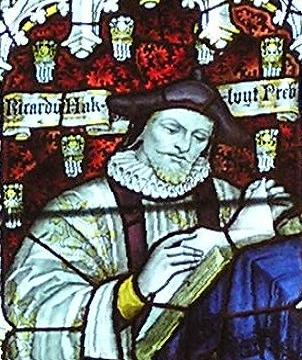
Back in January I spent an afternoon transcribing and translating part of the Bodleian’s copy of Delle Navigationi et Viaggi, Giovanni Battista Ramusio’s Venetian collection of travel narratives. As part of my ongoing research comparing Ramusio’s work to Richard Hakluyt’s Principal Navigations, I’ve been looking back over this material during lockdown.
One of the stories in Ramusio’s Navigationi that fascinates me is his retelling of Marco Polo’s return to Venice. Ramusio frames his knowledge of the tale through chains of oral history, writing that ‘since I was a young man I have heard much spoken [about this] by Gasparo Malipiero, a very old gentleman and senator of singular kindness and integrity, who had his house on the canal of Santa Marina […] [he] reported to have heard [this story] from his father and ancestors.’[1] This opening situates his retelling within localised oral tradition to establish Malipieros’s authority as a ‘true’ Venetian. In turn, Ramusio’s childhood link to Malipiero connects him to this wider chain, contextualising his knowledge within the city’s social networks to remind the reader that he is entirely Venetian, and thus possessed of private information which only he can share with them.[2]
After establishing his place within this tradition, Ramusio proceeds to tell the tale of Polo’s triumphant return. He describes Polo and his men hosting a banquet for their disbelieving family, appearing first to greet their guests dressed in ‘long floor-length robes of creamy satin’, stripping these off to reveal robes of ‘creamy damask’, removing these in turn to put on ‘velvet robes’, before finally changing into the ‘habit of usual [Venetian] clothes.’[3] Polo then left the table to bring back ‘the worn coarse cloth’ the men had worn when they first returned (then described as ‘ill ordered’). He began unpicking the seams and hems of these with a sharp knife, bringing out ‘rubies, sapphires […] diamonds and emeralds which had been sewn into each of these’. The guests, seeing this, ‘truly knew that these were the honoured gentlemen whom they had doubted and gave them tremendous honour and reverence.’[4] Ramusio’s tale begins with the classic trope of the unrecognised traveller’s Ulyssean return, before moving into traditional folkloric triplicate patterning with the three outfits and rich descriptions of fabric and jewels.. This narrative stands out in Navigationi for its tonal differences to other material; its unusual structure emphasises its origin and re-iterates Ramusio’s connection to Venetian tradition.
Like Ramusio, Hakluyt positioned himself as a link within chains of oral history to establish an authorial identity. In his telling of ‘The voyage of M. Hore and divers other gentlemen to Newfoundland’, he notes that Oliver Dawbeny ‘was in this voyage’ and ‘told M. Richard Hakluyt of the middle Temple these things following.’[5] Further on, he tells the story of their return:
Hakluyt uses the same narrative structures as Ramusio to reassert his claim to authorial authority: the hidden truth of the Ulyssean unrecognised traveller, the unimpeachable authority of oral tradition, and an authorial connection to this history. Hakluyt bolsters his authority with these explicit connections to the institutions of ‘the middle Temple’ and ‘Oxford’: formal institutions whose authority here sits alongside the passage of knowledge through a 200-mile truth-seeking ride. Ultimately, both writers aim to establish the ‘truth’ of their tales through this process of refracting oral history into printed narrative, a fascinating process I am only beginning to unravel.
Emily Stevenson
- [1]. Giovanni Battista Ramusio, Delle Navigationi e Viaggi, (Venice, 1550), 3 vols, II, sig 5v, 5r.
- [2]. Richard Hakluyt, The Principal Navigations, Voyages, Traffiques and Discoveries of the English Nation, (London, 1589), sig 2v.
- [3]. Ibid., Sig 5v.
- [4]. Ibid.
- [5]. The Original Writings and Correspondence of the Two Richard Hakluyts, ed. by Eva Germaine Rimington Taylor, 2 vols (London: The Hakluyt Society, 1935), II, p.391
- [6]. Ibid., II, p.393.
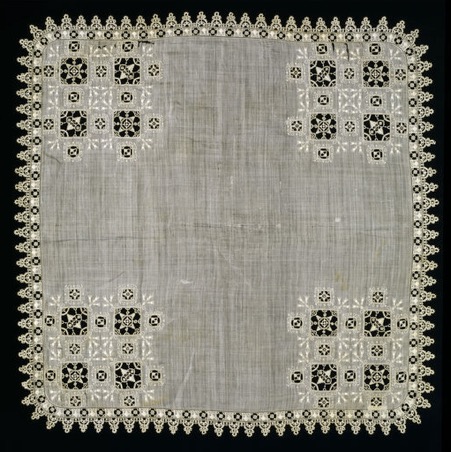
I have been thinking a lot about handkerchiefs recently. This was an unexpected development in my research on how the early modern English imagined the commedia dell’arte – a form of Italian comedy where professional players (comici) perform as stock characters (maschere) and semi-improvise around a written plot (scenario). However, there is a scene in Ben Jonson’s Volpone in which this object seems bound to English ideas of the Italian professional theatre. Act II.2 of the play begins with a masked Volpone, disguised as the mountebank Scoto of Mantua, taking to a trestle stage in the Piazza San Marco with his servant Nano, dressed as Venetian street entertainer ‘Zan Fritatta.’[1] As a crowd gathers, Scoto launches into a lengthy oration denouncing the quack cures of licensed physicians and celebrating the near-miraculous benefits of his own ‘Oglio del Scoto.’[2] He haggles with his audience, but when the price has decreased to sixpence, he’ll negotiate no longer: ‘Therefore, now,’ he says, ‘tosse your handkerchiefes, chearefully, chearefully.’[3] Celia, who enters at a window above at some point during the performance below, drops her handkerchief into Scoto’s outstretched hand below. He catches or picks it up off the ground and presses it to his lips: ‘Lady, I kisse your bounty.’[4] At this moment, Corvino, who we can presume has been watching the spectacle unfold, enters and beats Volpone away
- Bloud of the devill, and my shame! Come down, here;
- Come downe: No house but mine to make your Scene?
- Signior Flaminio, will you downe, Sir? Downe?
- What is my wife your Franciscina? Sir?
- No windores on the whole Piazza, here,
- To make your properties, but mine? But mine?
- Hart? Ere to morrow, I shall be new christen’d,
- And cald the Pantalone di Besigniosi,
- About the towne.[5]
This scene is often cited as evidence of English fluency in the precepts of the commedia dell’arte. It is the most explicit description of the form in English print from the period and, considering England’s sporadic contact with the Italian companies of the day, it is also a surprisingly accurate description of how performance is structured: a streetscape with houses for entrances and exits; the use of windows as properties for women to interact with their husbands, lovers, and servants; the masks of Francescina, the courtesan or serving woman, Pantalone, the Venetian magnifico, and Flaminio, the innamorato. Even when Corvino comes on stage to break up the scene, it continues to resemble the commedia dell’arte. He rages and swears oaths like the neoclassical bravura, and touches on a narrative found throughout the extant collections of commedia dell’arte plots: a shut-away woman hoodwinks her jealous husband and begins an affair from above with a younger, more virile man below.
I would argue that this episode says little about English knowledge of the commedia dell’arte. Mountebanks, windows, handkerchiefs – none explicitly invoke the semi-improvised comedies nor the performance practices of the professional companies of Cinquecento Italy. Rather it seems to me that this scene deliberately draws attention to the horizon of interpretation available to the spectator when certain props (and handkerchiefs in particular) are moved or manipulated in certain ways. A seemingly innocuous action like dropping a handkerchief from a balcony triggers certain associations and expectations based on the spectator’s prior experience of handkerchiefs falling from windows on stage, as well as the cultural life of the object outside the world of the play. In an age preoccupied with the ability of clothing to mould and shape subjecthood, handkerchiefs were often exchanged between lovers as tokens of remembrance. The antiquary John Stow would note how the young women of London would present small handkerchiefs with tassels ‘in the Frenche fashion’ to their preferred suitors.[6] This symbolic gesture was heightened by the proximity of the handkerchief to the body, and instilled with a certain eroticism by the intimacy of its primary use: wiping away bodily excretions. By willingly relinquishing a handkerchief, then, Corvino argues that Celia permits Scoto to touch her body. When Scoto ‘most sweetly, kissed the receipt’, he kisses Celia.[7]
However, the way in which Corvino conceptualises this ‘infidelity’ underscores how diverse experiences determine the horizon of interpretation. Before he interrupts the performance, he is first a spectator. Watching unseen from the stage or the pit, the spectacle unfolding before him triggers the same cognitive processes as his fellow audience members; however, he interprets according to experience. ‘You were an Actor,’ he bellows at Celia, ‘with your handkerchief.’[8] Such a public display of purported licentiousness reminds Corvino, a Venetian and fellow countryman of the old cuckold Pantalone, of the women actors of the commedia dell’arte and the lascivious comedies of his homeland. Here Jonson invites us to consider how experience shapes interpretation whilst, in a typically Jonsonian fashion, showing off his own knowledge of an intriguing foreign dramaturgy.
Tom Roberts
- [1]. Ben Jonson, ‘Volpone’, in The Alchemist and Other Plays (Oxford: Oxford University Press, 1995), II.2.110.
- [2]. Ibid., II.2.129.
- [3]. Ibid., II.2.204-205.
- [4]. Ibid., II.2.211.
- [5]. Ibid., II.3.1-8.
- [6]. Quoted in Bella Mirabella, ‘Embellishing Herself with a Cloth:The Contradictory Life of the Handkerchief’, in Ornamentalism: The Art of Renaissance Accessories, ed. by Bella Mirabella (Ann Arbor; University of Michigan Press, 2011), p. 59.
- [7]. Jonson, II.5.41.
- [8]. Ibid., II.5.40.
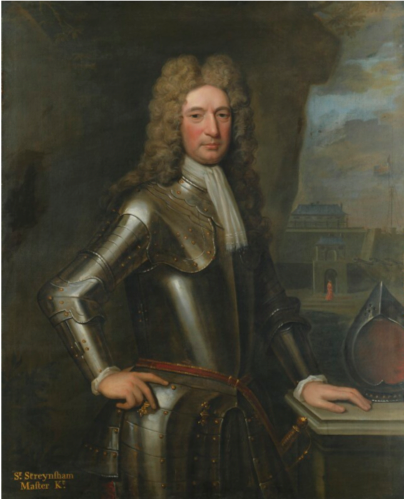
‘When I was in England with you it was your great fear and my doubt that the English as well as other Christians in these Parts, did not live agreeable to any Rule of Religion.’[1] This is the opening line to an undated and unsent letter by East India Company employee Strenysham Master. Indeed, Masters was highlighting a common concern shared by many who had left England to travel abroad in this period. Whether the reason for travel was in the interest of commercial, military, and national service, or just personal, it had long been perceived as being a spiritually and temporally corrupting influence on the individual. Master himself was no stranger to these concerns, reassuring the recipient of his letter that he would ‘not forget God’ on his travels.[2] Away from safety English society travellers, of all stripes, were exposed to a variety of people whose faith, culture and governmental sensibilities differed from those they had left in England.
The interactions and cultural exposure facilitated bytravel divided the opinion of many early modern English commentators who saw it as both socially educational and culturally dangerous. This lead to some arguing in favour of travel such as Sir Thomas Bodley. Whilst reasoning his journey to Switzerland, Bodley argued that what could be learnt from it was in ‘publique service of the State.’[3] Others, such as the sixteenth century theologian, Thomas Holland believed that there were many ‘great abuses by travaile’ and that ‘by it many corruptions have crept into florishing nations.’[4] From the opening line of Masters letter, it could be assumed that almost eighty years later, English commercial and territorial expansion into religiously cosmopolitan environments in India had done little to support Bodley’s assertion or dispel Holland’s fears of corruption.
However, across 20 pages, Master’s letter, traces a journey away from this misconception of Indian religious life and politics and the fear it would harmfully influence the naïve English traveller, to one of reluctant admiration for Indian people’s faith, and their religious governance. In line with Bodley’s comment, Master’s letters highlight how some early modern’s not only believed that travel was intellectually stimulating , making it possible to learn about other cultures, faiths, laws and languages, but also how this experience could inform one’s own governmental practices. Master, like many other EIC personnel who went to India, dismissed his initial concerns over the influence that local religious interaction on English employees. Instead criticising the religious governance of the company for not encouraging English employees to mirror the pious lives of the Indian people.
It had long been a key aim of EIC officials to regulate the lives and interactions of English employees with local Indian people, thereby ensuring that their behaviour did not negatively affect the commercial mission of the company. Masters believed that it was only when Christians mirrored the local devotion of Indians to their faith, thereby forming ‘emulation between the Indians & us’ that the English would live godly lives and the EIC’s commercial mission would succeed.[5] Moreover, the letter shares recurring theme with other correspondences of EIC officials, which highlighted the difficulties, the EIC faced had in regulating the behaviour of not only English people, but also Indian peoples.
Haig Smith
- [1]. British Library (BL) India Office Records (IOR) Mss E/210 Unsent letter by Strenysham Master
- [2]. Ibid.
- [3]. Thomas Bodley, The Life of Sir Thomas Bodley, the honourable founder of the publique library in the University of Oxford, written by himself (Oxford: Bidleian Library, 1983), p. 4.
- [4]. Thomas Holland, Paneguris D. Elizabethae, Dei gratiâ Andliae, Franciae, & Hiberniae Reginae (London, 1601), sig. D4r.
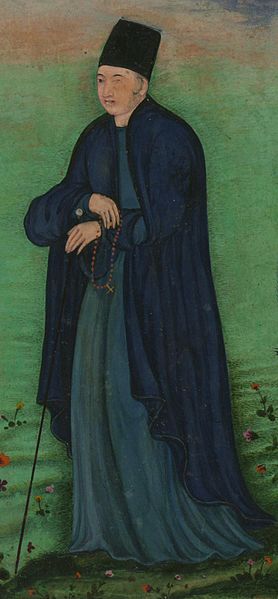
This English fulano was the picaresque and obscure John Mildenhall, a merchant who had been previously involved in the Levant trade. Around 1600, he was contemplating the possibility of travelling to Cairo from Aleppo, but he rapidly changed his plans and decided to travel to Lahore, probably influenced by news of the formation of the East India Company (EIC). Mildenhall’s sudden decision to travel to Lahore suggests that he sought to establish contacts with the Mughal authorities in the hope of obtaining a reward for his good services. Indeed, some years later after returning to England, Mildenhall petitioned the East India Company, the English crown and wrote a long letter on his exploits in India addressed to Richard Staper, a prominent and well-connected London merchant who was behind the foundation of the Levant Company and the East India Company.[3]
Mildenhall’s days at the Mughal court were not only one of the primordial moments of the English presence in India, but also an important and neglected episode of the complex triangular interactions between the Portuguese (represented by the Jesuits), the English and the Great Mughal. Although he was not an official emissary from Elizabeth I, Mildenhall’s impromptu attempts to obtain commercial privileges from Emperor Akbar paved the way to a series of intense diplomatic and commercial exchanges between England and Mughal India.
However, Mildenhall remains a somehow ignored figure in the grand narrative of the English presence in India. One reason for this neglect resides in his failure to persuade the EIC or the English Crown to support him. Indeed, by the time that Mildenhall returned to London, the EIC had launched its third voyage to the Seas of India in which William Hawkins was assigned to present a letter from James I to Jahangir. Besides the bad timing of Mildenhall’s petitions, his letter to Richard Staper draws upon a careful narrative of his exploits which, apart from his direct exchanges with Akbar and clashes with the Jesuits, is rather laconic about his interactions with other elements of Mughal society and politics. More concerned in self-promotion than in providing a careful description of the Mughal court, Mildenhall and his letter became a sort of passing reference in the history of Anglo-Mughal relations and cross-cultural interactions.
Yet Xavier’s report on the exploits of the English fulano at the Mughal court encourages a reappreciation of John Mildenhall’s time there. Throughout his letter, the Jesuit missionary complaints about Mildenhall’s surprising ability to manoeuvre within Mughal courtly circles by establishing friendships with relevant courtiers, an indication of the success of the English fulano in not only engaging with local actors according to their own forms of social interactions, but also of his capacity of adaptation to local commercial and political interests.[4] Mildenhall is also castigated for his disruptive impact in the Christian community. According to Xavier, the fulano enticed one Portuguese resident to spread rumours about the deviant behaviour of Jesuit missionaries towards women.[5] This episode reveals that Mildenhall had been for some time fully integrated into the small but heterogenous Christian community of Agra, a group formed by members of the Armenian, Georgian and Greek Orthodox churches, besides a handful of Catholics of Portuguese, Venetian, Florentine, German and French origin, all of them under the de facto leadership of the Jesuit missionaries. The image of Mildenhall emerging from Xavier’s letter is that of an English agent who, despite his failure to obtain a palpable outcome from Akbar, persuaded the Mughal authorities to consider England as a potential commercial and diplomatic partner.
The juxtaposition of the letters written by Mildenhall and Xavier is a good example of the importance of comparing English sources with a wide range of similar documents written in other languages scattered across European, Asian or African archives. Such comparisons not only offer the possibility to reassess historical narratives or events, but also to put together a more complete (or complex) picture of the ways in which transcultural agents formed their strategies and acted accordingly.
João Vicente Melo
- 1. ‘Doc. 2, Letter from Jerónimo Xavier to the Jesuit Provincial in Goa, 6 September 1604’ in Documentação Ultramarina Portuguesa, vol. III ed. António da Silva Rego (Lisbon: Centro de Estudos Históricos Ultramarinos, 1963), p. 15.
- 2. Ibid., p. 15
- 3. Committee to confer with John Midnall concerning his demands and project for going to “Mawgoule” in the East Indies, 30 May 1609’ in Calendar of State Papers Colonial: East Indies, China and Japan, vol. 2, 1513-1616 ed. W. Noel Sainsbury (London, 1862) , p. 185; ‘Petition of John Midnall to the King, 27 July 1609’ in Calendar of State Papers Colonial: East Indies, China and Japan, vol. 2, 1513-1616 ed. W. Noel Sainsbury, p. 190; ‘John Mildenhall, 1599-1606’ in Early Travels in India ed. William Foster (London: Oxford University Press, 1921), pp. 52-59.
- 4. ‘Doc. 2, Letter from Jerónimo Xavier to the Jesuit Provincial in Goa, 6 September 1604’ in Documentação Ultramarina Portuguesa, vol. III ed. António da Silva Rego (Lisbon: Centro de Estudos Históricos Ultramarinos, 1963), p. 20.
- 5. Ibid., p. 16.
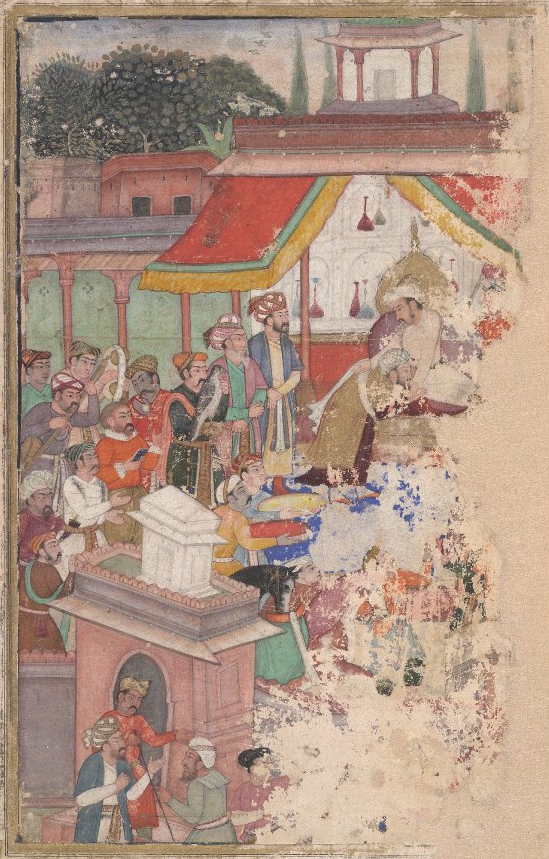
I have been trying to trace an elusive figure over the last couple of months. When the libraries closed, I thought it would be a good idea to let my search rest for a while. For reasons that are not entirely clear to myself, I had a vague idea of sneaking up on my unsuspecting object of study in the crammed manuscript pages of archival documents once we were allowed to venture out again. The problem is that I keep spotting tantalising references – like a figure glimpsed out of the corner of the eye – before the traces disappear again.
The figure in question is a man, an Indian broker retained by the fledgling East India Company in the early 1600s, at a time when the English were still trying to figure out the nature of their ‘enterprise’ in South Asia. The records refer to him variously as Jadu, Jadow, or even, in one case, ‘Sadow,’ and there are quite a few records to go through. His is the one Indian name that crops up time and again in the correspondence of the English merchants trying to establish a toehold in Surat, the first English ambassador attempting to decipher the diplomatic practices of the Mughal court, and the Company in London, measuring success and loss in their accounts.
It seems that Jadu was one of the first Indian brokers to the East India Company. There is a reference to him helping the EIC merchant, John Jourdain, escape Portuguese blockades and board an English ship in 1611.[1] In 1616, the ambassador, Sir Thomas Roe, lasts exactly 5 days when Jadu leaves his service over a disagreement about his wages. ‘I am so without any linguist that I cannot answer the King what it were a clock,’ Roe complains, and sends messengers after him to call him back: cue much relief in Roe’s meticulous journal when Jadu reports for duty on Christmas Eve, 1616, and a new contract is agreed.[2]
It seems that Jadu was one of the first Indian brokers to the East India Company. There is a reference to him helping the EIC merchant, John Jourdain, escape Portuguese blockades and board an English ship in 1611. In 1616, the ambassador, Sir Thomas Roe, lasts exactly 5 days when Jadu leaves his service over a disagreement about his wages. ‘I am so without any linguist that I cannot answer the King what it were a clock,’ Roe complains, and sends messengers after him to call him back: cue much relief in Roe’s meticulous journal when Jadu reports for duty on Christmas Eve, 1616, and a new contract is agreed.
Trying to trace Jadu is firstly an exercise in decoding the various products of phonetic mangling of Indian names in English accounts. There is a marked ambivalence about him throughout that act as a connecting thread among all those appearances. There is uncertainty about his trustworthiness as a financial and mercantile intermediary, coupled with uncertainty about language. Jadu translates for Thomas Roe, who – despite a relatively long sojourn in India (1615-19), is remarkably resistant to acquiring any Indian languages himself. The problem is that he never quite appears to trust the exchanges that Jadu facilitates with Mughal court officials either. That ambivalence is familiar: as we revised the entry for ‘agent/broker’ in TIDE: Keywords over the last few months, we were reminded time and again of the shifting sands on which such intermediaries operated. Their ability to move between languages, as well as within multiple networks made them both indispensable, and the subject of suspicion and mistrust.
But my attempts to trace Jadu also reaffirm the difficulties that attend our efforts to trace non-European presence and agency on which European endeavours so often depended. Jadu continues to elude me. He remains a shadowy figure behind the financial, mercantile, and social dealings of the English in India for over two decades – then disappears without a trace. In the only scholarly article about him, Amrita Sen notes that ‘Jadu’, a name derived from the Hindu god Vishnu, was and is still common in India, and that he may have been ’a member of what could be considered the indigenous elite—the Surat Banians.’[3] He is likely to have had a wife, or a ‘woman,’ as one English account puts it in 1609.[4] Elsewhere, in EIC records, I find repeated references to his connections within the Surat bania community – he comes from a family of prominent brokers variously employed by foreign merchants. Company records refer to him as 'Jadowe, the kinsman of Gourdas, and of Calliangee [Kalyanji]'.[5] He is repeatedly accused of ‘cozening’ Company merchants, fined or otherwise reprimanded, then brought back, and the remarkable profit margins in Company trade deals often note his involvement in the negotiations. The last reference I could find of him, dated 1635, is typically short and fleeting. It simply notes the hopelessness of ‘recovering any money from Jadu, who is very poor’.[6]
Nandini Das
- 1.The Journal of John Jourdain, 1608-1617, ed. William Foster (London, 1905), p. 178.
- 2.The Embassy of Sir Thomas Roe to India, ed. William Foster (London, 1926), pp.326-29.
- 3. Amrita Sen, ‘Searching for the Indian in the English East India Company Archives: The Case of Jadow the Broker and Early Seventeenth-Century Anglo-Mughal Trade,’ Journal for Early Modern Cultural Studies, 17.3 (2017), pp. 37-58.
- 4. Danvers, Frederick Charles, ed. Letters Received by the East India Company from its Servants in the East Transcribed from the ‘Original Correspondence’ Series of the India Office Records. Vol. I. 1602–1613 (London, 1896), pp. 26.
- 5.The English factories in India (1630-1633), ed. Foster (Oxford: Clarendon Press, 1910), p. 90.
- The English factories in India (1630-1633), p. 275.
Lauren Working on William Davenant’s Madagascar (1638)

In 1635, Sir William Courteen obtained a royal charter to establish Courteen’s Association, a trading company that fell outside the aegis of the East India Company. One of Courteen’s projects, supported by prominent courtiers, was the colonization of Madagascar – the first English attempt to colonize a region outside the Atlantic. The scheme proposed Charles I’s nephew, the seventeen-year-old Prince Rupert, as leader of the expedition.
Although the project ultimately failed, it spurred a number of textual and visual responses: a cluster of printed promotional literature, the artist Van Dyck’s ‘Madagascar portrait’ of the Earl and Countess of Arundel, and a lengthy poem by the court poet William Davenant. Reading ‘Madagascar’, I was struck by Davenant’s evocation of the world of things. Gold and ambergris, coral and silk, exotic fruits that put the ‘sowre winter-plumme’ to shame. A world where men drown diving for oversized pearls, where the ‘golden isle’ itself is a physical entity, ‘seated for predominance’ between the continents of Africa and Asia. The poem panders to the fashionable Neoplatonism of Henrietta Maria’s Catholic court in London – Prince Rupert and his band of ‘lovers’ ludicrously conquer the local inhabitants through their beauty – yet the verses are also mired in this distinctly un-platonic world of goods. As colonizers explore ‘virgin Mines’ and glittering gemstones, the narrator wishes his soul had been brought to the island with his body: ‘Not as a Poet, but a Pione[e]r’.
But Davenant is both, if we take early seventeenth-century definitions of the ‘pioneer’. As well as a miner, a pioneer is one who ‘goes before others to prepare or open up the way’. I have been thinking about the poem’s relationship to colonialism and court aesthetics, and how it might fit within wider networks of sociability and the circulation of goods, from raw Madagascan commodities such as aloe and ginger to the Malagasy knife owned by Davenant’s friend Endymion Porter. What is the relationship between literary production and visual and material culture, and what might this tell us about the English colonial gaze?
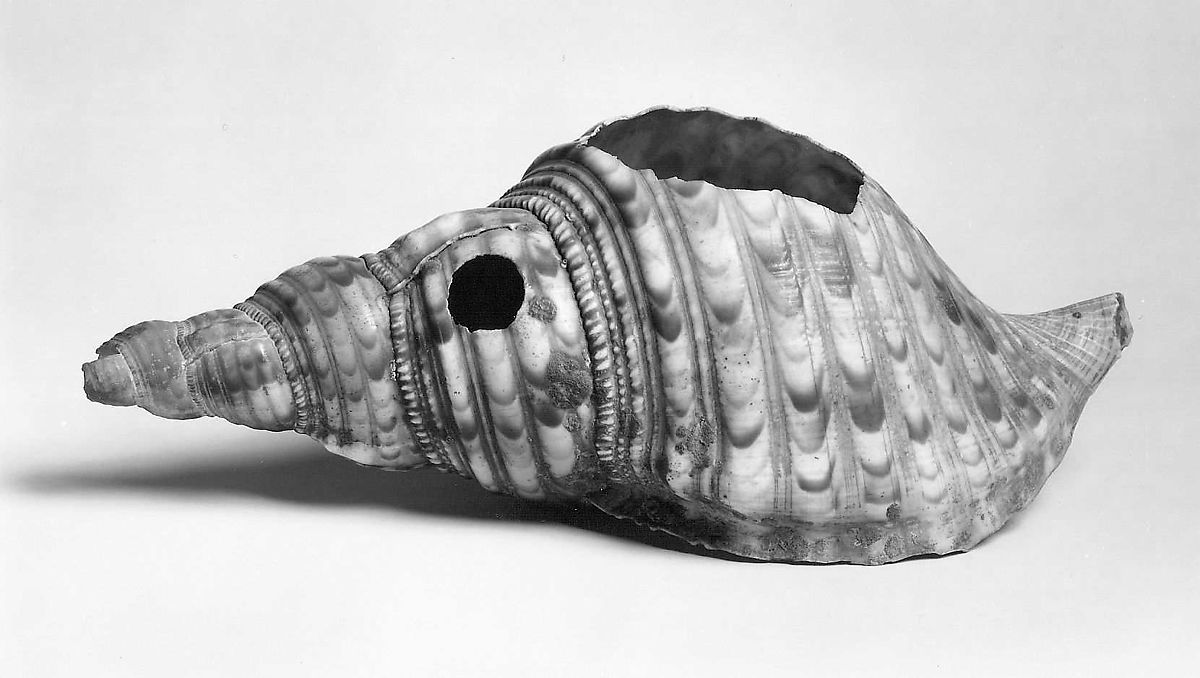
The idea of the gaze is reinforced in Davenant’s very choice of the dream-vision genre. If we place Davenant’s ‘eye’/I alongside the dream-vision poems popular among wits in the 1620s and 30s, we find that such narratives are often about the erotics of desire and possession. Robert Herrick dreams of turning into a vine that can creep between his mistress’ thighs as she slumbers; John Suckling dreams of an abundant landscape of apricots and spices before stumbling on ‘the place which I most long’d to see/My Mistress’ Bed’. So what happens when dream-visions are applied to colonization? Like dreamers, colonists are portrayed as lovers. The Malagasy submit not unlike the way women do in such verses, subserviently and with little real resistance. Madagascan landscape or naked mistress: both offer a ‘rich Mine, to the enquiring eye/Expos’d’. Such ideas may seem to belong purely to the realm of ‘fancy’ so prized by cavalier poets. Yet the hope of fulfilment in Davenant’s poem ultimately relies on the acquisition of goods, rendering court poets, through their use of ekphrasis (the description of ‘things’ in poetry) and energeia (a narrative technique used to vividly create mental images), complicit in geopolitical intervention and in contributing to a courtly vision of what an English empire might look like, lush as the compositions by Van Dyck. This interest in consumption was not restricted to the Madagascar scheme, but what Davenant’s poem does, along with the panegyric verses penned by fellow wits, is to invite a conversation about how poetry relates to colonialism, and colonialism to friendship and civility. What ultimately distinguished ‘the civility of Europe, from the Barbarity of the American salvages’, wrote the political philosopher Thomas Hobbes to Davenant, was precisely the ‘workmanship of Fancy’. Such fancy must, however, be guided by the ‘Precepts of true Philosophy’ – not unreason, in other words, but an imaginative possibility undergirded by truth and technical skill: by wit itself.
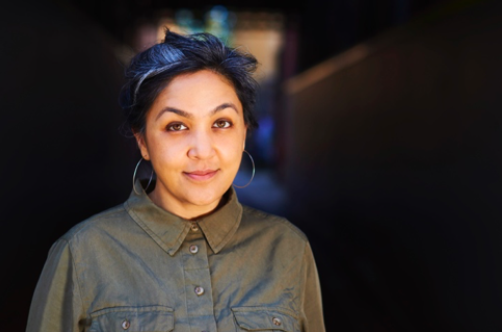
This February, TIDE welcomed Preti Taneja to Oxford as the TIDE Visiting Writer for 2019-2020. Preti teaches writing in prisons and holds an honorary fellowship at Jesus College, Cambridge. She was the 2019 UNESCO Fellow in Prose Fiction at the University of East Anglia and in April 2020, she will join the University of Newcastle as lecturer in Prose Fiction. Her novel We That Are Young (Galley Beggar Press), a translation of Shakespeare’s King Lear into a modern Indian context, won the 2018 Desmond Elliot Prize for the UK’s best debut of the year. It has been translated around the world and listed for a number of other awards, including the Republic of Consciousness Prize for Small Presses, the Folio Prize, and the Prix Jan Michalski.
Over the course of her visit, we had the opportunity to share our research with Preti, and she joined in discussions of some the TIDE ‘case studies’, a series of microhistories on transcultural figures from the period that the team are currently researching and writing. On her last day in Oxford, Preti sat down with TIDE DPhil candidate Tom Roberts to talk about her impressions and experiences of the project so far.
What was your impression of TIDE and you time in Oxford these last few days?
I have not used this week for personal research but instead used all of you as a living library. I had access to your online outputs earlier, but not you thinking or talking about your own and each other’s work. It’s unusual and a great privilege to see such interdisciplinary research as it happens; to listen to these kinds of conversations, and to see how you think and respond to your individual case studies. If I’m not physically here, I don’t get to observe these conversations between you, and I don’t get to ask you how you feel about me making artifice about your research. These are the ways fiction writers think and we don’t get to research often.
We definitely felt challenged by some of your questions! Yesterday you asked us what we thought about our individual case studies as people, and our collective reaction was to push back: ‘We have to work with what we have, and the evidence only gives us a small insight into their lives.’ ‘We’re hesitant to make comments when we are so far removed from their experience.’ I started thinking about his again, and – speaking for myself – I’m not entirely convinced by these answers. We do make these comments and we do inhabit them.
Yes, on Day One during our chat in the common room, I asked you all who you identify with the most. There was a lot of laughter, and everyone was saying ‘well, such and such is like me,’ or ‘this person got under my skin the most’. Yet by Day Two or Three, when we were having more academic and more formal discussions in college spaces, your responses changed. ‘No, no, no we’re all historians!’ If I only record the second conversation instead of the first, then the archive will never show that actually you’re just as possessed by these people as you are possessing them.
Like you say, a lot of it comes down to the space we’re in when we talk about them, and whether we have our formal researcher hats on or not.
And part of what I do as a fiction writer is observe this transition. Those are the places where human behaviour is so interesting to me, and I start thinking about how your case studies might have performed themselves as well? When they sat down to write, what were they doing 30 seconds before? How would they talk about the work they were doing before they decided that this is the formal space in which they’re going to leave their legacy? That’s the material for me, the little interliminal spaces, those interstices of time, that’s where the imaginative work gets to be done. There are probably clues in the text, in the source material you’re working with, but they’re also in how you decide to write up the narratives of these people, because you’ve got that understanding of their characters, and you might not even realise it. That’s what I’m going to be looking for.
Of course, I’m meeting you all in Oxford, so I have no idea how the experience of doing this would have been in somewhere like Liverpool [where TIDE was based till September 2019], which is a very different space and has a different nature to the city. The period you’re studying is very alive here in Oxford – it’s in the stones, the panels, portraits, rituals – it was probably legislated here. Does it feel different now than in Liverpool?
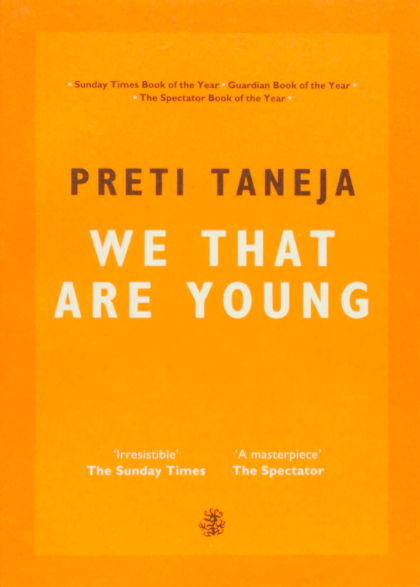
Strangely I felt more connected to what we’re trying to do when we were in Liverpool because what immediately happened after our period is Liverpool. It was a small settlement in the sixteenth and seventeenth centuries, but by the eighteenth century it had obviously become a massive trading centre, a cornerstone of the colonial project. And the legacy of the people we study and that expansionism felt very alive and very much embedded in Liverpool as a city and a physical space, despite the fact that I don’t think a single one of the case studies had a connection to the city. Yet it still somehow felt more real and more relevant. I don’t feel the connection so much here, if that makes sense?
It does makes sense, but it feels like a dangerous statement in a way, and because you have that feeling, I think it matters more that it’s here because the work needs to be done here. Liverpool is a very self-aware city, it understands its transatlantic slave trade and colonial history, it has a strong left wing political identity, and it is very good at organising. The quiet here has a kind of charge to it, and the voices that you are listening to, and the ways in which these ideas were beginning to be set down on paper – these ideas that were then implemented in Liverpool – that is a structure of society. You do the thinking here and the policy making here, and they have to live with the reality over there. When you enter into the heart of empire, into the heart of colonialism, it’s very quiet. It’s years and years, decades and generations of cultural silencing that pretends all we’re doing is thinking. We can cry - ‘Look at Liverpool! Look over there!’ while the actual crux of violence is here. That’s why it’s important that the project is here, to be part of that moment and deconstruct some of those things. You’re all looking at the beginnings of colonisation, and in doing so, the project seems to be all about decolonisation.
Yes, absolutely. It challenges notions about how early modern people understood the world and their place in it during the period. It’s trying to get to grips with the complexity of this understanding, and how it was embedded in the very language. I feel like this is at the heart of research like TIDE: Keywords.
What’s brilliant about Keywords is the particularity about the words you’ve all chosen – ‘foreigner’, ‘stranger’, ‘subject’, ‘citizen’, ‘denizen’. They ask all these perennial questions: what do these terms mean to us now? What negotiating do we have to do to prove we’re citizens? Who gets to decide? How are we going to use language to keep people in? Or keep people out? What I think is particularly great is that you’re not just thinking about these perennial questions but asking why they are perennial questions. It’s been four hundred years, Communities are once again suffering state sanctioned violence over these questions in India, in America and here in the UK.
On a theoretical note, it’s also important that you come to these questions from an English literature and textual point of view, because when you come to early modern texts like Shakespeare and you come to these words and you think ‘there is a connection I want to make,’ it’s vital to have those etymological traces so we know we’re not misrepresenting how someone spoke in a play. And one you know that, then you can work with the language and the possibilities.
I think about that a lot in my own work. It’s flipped my understanding of these plays and the period on its head. The use of one word like ‘stranger’ or ‘alien’ in one line completely changes how you think about that play, what’s happening, and its relation to that moment.
It’s essential to understand that, and it highlights the problems in our education system that are feeding into contemporary political debates on who belongs. I’m not sure if those failures, gaps, and elisions have evolved or were decided on or ‘just happened’, but what I do know is that this project is filling a gap which is way long overdue to be filled, because it’s only by understanding the roots of how these words inform our understandings of others and of people that we can actually start to change our lives. To try to actually model what you guys are doing here which is having a shared conversation about how to understand and how to be.
There is a lot of push back against this kind of work. That recent Telegraph article on the ‘woke’ brigade ‘cancelling’ our beloved Shakespeare is an obvious example, and the blatant racism and ableism in using an image of actor Nadia Nadarajah as Celia in As You Like It for the accompanying picture.
You know I think about this a lot in my own academic work and fiction writing. Shakespeare is the ‘national bard’, and what this actually means is there are two reasons why Shakespeare is so popular over the world. First one, the elasticity of his language, the range of emotion, the vastness of his understanding of human nature, and so on. The rest of it is colonialism. You can be a literary genius in your own languages and never get translated, disseminated worldwide.
The afterlife of Shakespeare is what made Shakespeare!
Absolutely, and this is why I work with him the way I do. There are things to be said about empire and belonging through the language of Shakespeare, and Shakespeare understood that. He can feel ‘untouchable’ at times because of who decides who gets to learn what and who decides what’s on the curriculum. And that is where the joined up thinking of what you are doing comes in. One of the main reasons for why I agreed to taking part in the TIDE project is that I grew up as part of this education system that didn’t tell me why I was born in the UK. The first time I encountered partition in school was with Lear.I’d grown up with stories of the British in India, of Partition violence, but when your mum tells you story about a man who came and drew a line without ever having been to the country, about all those millions dead, about a house locked away in a place your own grandmother could never go back to – you’re just thinking ‘alright Mum, this is fiction, or science fiction’. The British system undermines out own belief in our own mothers’ oral stories. And then you see it in school and your teacher is telling you this is the canon and you need it to pass your A-Levels, you’re suddenly thinking, wait a second this is a story I know. The happy product of this experience is We That Are Young,a book that I’m very proud to have written, but it’s not ok to have had that gap. And as I’ve worked in youth services, prisons and across the UK in disadvantaged areas with children, teaching them to do heritage projects, or think about representation in museums, this comes up again and again and again. These kids have no idea why they’re here, and this gap makes them susceptible to all kinds of vulnerabilities that mainstream culture and politicians are happy to exploit. So I love the fact that the project is thinking about and tackling that through the teaching workshops, and the policy report with the Runnymede Trust, as well as doing this core research to retrace the origins of language. But something that has come up that concerns me slightly is that if you only have the sources to go on, can you as historians ever avoid just re-inscribing the violence that has been inscribed?
We’re continually wary about this. A key source for my work is the migrant census surveys taken in London throughout the late sixteenth century. When you look at the manuscripts, you might not realise at first how these migrants who have travelled to London and set up shop all over the city have been recorded by parish and ward. So already we have this political and ecclesiastical spatialising framework imposed on these people, dictating how we think about their lives. So what we have to do here is just go in aware of the politics of the archive and the politics of the documents we are working with and keep reminding ourselves why things are being recorded in the way they are and why somethings are ignored entirely. We can then try to fill these gaps and emissions using other source materials, which I think is where the interdisciplinary nature of the project comes in.
Yes, I think this is where literature can help. I think what is particularly illuminating is ways in which playwrights, poets, and essayists of the period were discussing and interpreting statehood and law. The fact that Shakespeare had the imagination that he did – with people transmuting bodies, upturning social orders, and imagining dream spaces – tells us that there was intuitively something about questioning power that was possible, surely? Lear is set in a pre-Christian moment to bypass blasphemy and treason laws. So it is that legal system that generated the constraints that put Learin a pre-Merlin place and time and yet that’s what has given it it’s longevity. It’s set outside a Judeo-Christian understanding of time, though of course that eschatological thinking does saturate the play. That he’s doing this shows that he’s trying to get around rules and critique them at the same time.
You translated King Lear into a modern, Indian context in We That Are Young. Was there anything about this process of translation that you found difficult? Were there any ideas in Shakespeare’s Lear that resisted the story you wanted to tell?
No, not at all. The Indian context is perfect for this story. Obviously, you can take Lear and use aspects of it and make lots of different kinds of narratives. One of my favourite Lears is Edward Bond’s, which is just this completely Brechtian annihilation, and an extraordinary piece of theatre. And obviously he doesn’t stick solely to the characters and solely to the plot, he changes them in ways that are striking in themselves. But fidelity to the plot was a decision that I made. For political and aesthetic reasons, I wanted to see if I could take absolutely every aspect of this play and make it work in India, and it did. One of my favourite moments to write was this kind of weirdly boring scene of the play, when Kent is locked in the stocks. He has this line ‘Fortune, good night. Smile once more. Turn thy wheel.’, and for an Indian context you have the principles of dharma, karma, samsara: life is a circular thing, and faith, religion, spirituality turns into how we live now, and what our role is in life and our duty and so on, and it’s such a perfect chance for translation and transposition, so for some of those Shakespearean things I was able to find Indian concepts, or Hindu concepts, because most of the characters in the novel are Hindu.
The thing I did find difficult was that – because the play’s language means so much to me, and I’ve know it like a familiar song – as a writer you want to find your own voice that fits the world that you’re making. When you’re working with Shakespeare, one of the dangers is that the lines are so iconic, and so deeply in us, that we don’t realise when we’re just quoting. And if I just quoted a line it would have meant that in whatever scene I was translating, the reader would have immediately been like ‘Oh well, I’m out of the world now and into Shakespeare’s’. The bones stick through, and that’s what’s really difficult, and it took a lot of drafts. I had to find a way to get the text hidden inside the text that I was writing.
Finally, how do you think your work with TIDE will evolve?
I’m going to go away and think about what we’ve spoken about, and read your research, and I’m going to write a piece of fiction, a short story. I don’t know what about yet, but I’m going to go over my notes and something will come up, I’m pretty sure of that – it can’t not! We’re also going to run a creative writing workshop for black and ethnic minority students and staff in Oxford using your archive material, and I can’t go into the details now, but we’ve just heard that we’ve been given funding for a music event through the TORCH Humanities Cultural Programme. It's going to be a ghar-style salon, bringing British South Asian spoken word poets and music into contact with the TIDE keywords. I want to bring some joy in our fraught cultural moment by putting on an event that will transport people with sound and poetry, and make them feel good.
On the evening of 29 January 2020, Nandini Das presented TIDE’s third annual report, which can be accessed here. Particular highlights for this past academic year include our TIDE-Runnymede Trust report on ‘Teaching Migration, Belonging, and Empire in Secondary Schools’, which we launched in parliament in July 2019, our ongoing work on the permanent redisplay of pre-modern Chinese ceramics at the World Museum in Liverpool, and our collaborations with our annual visiting writers. We welcomed Preti Taneja to Oxford this term and next, where Preti will be exploring issues of translation.
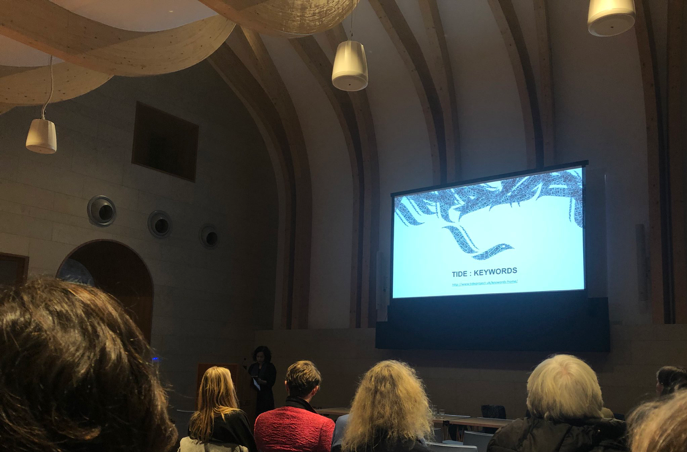
The event then celebrated the project’s first open access book-length publication, Lauren Working’s The Making of an Imperial Polity: Civility and America in the Jacobean Metropolis (Cambridge University Press, 2020). Lauren’s PhD supervisor, Adrian Green (University of Durham), joined her in a discussion about how early colonial projects influenced taste and political culture in London. Readings from a range of historical material were interwoven within this conversation, masterfully carried out by James Wallace and John Hopkins, two actors who specialize in early modern theatre. The readings ranged from legal ordinances to George Chapman’s evocations of temples in the rainforest in his epic poem, ‘De Guiana’; wit poetry about tobacco to letters from colonial governors about the brutal realities of plantation. These included English subjects eating the dead in James Fort and a note on the arrival of Africans to Bermuda in 1616, sent by London councillors to provide the labour needed to meet the rising demand for tobacco and pearls in the metropolis.
These readings vividly illustrated Lauren’s research into how colonization became entrenched within early seventeenth-century political culture, reframing the Jacobean era as a definitive moment in which the civil self-presentation of the elite increasingly became implicated in participating in imperial projects. One of the readings, an excerpt from Elizabeth’s intelligencer Francis Walsingham urging Richard Hakluyt to continue to pursue his interests in cosmography and western plantation in Oxford, offers a reminder that that English hopes for an empire partly took root in the very streets of this university town. Hakluyt’s place of study at Christ Church is a fifteen-minute walk from where the launch took place.
Perhaps this might also be the place where reconciliation can begin. The cover of The Making of an Imperial Polity is an image of a feather headdress from South America, now on display at the Pitt Rivers Museum. Indigenous worlds are there when we look for them; coming to terms with imperial legacies can begin on our doorstep. The Algonquian mantle on display at the Ashmolean Museum, like the objects at the Pitt Rivers, invites much-needed debate about confronting the legacies of empire and the possibilities of reconciliation. To rethink the ‘romance’ of early colonization, Lauren concluded, ‘is to re-think our relationship to empire and the stories we are willing to tell about it; it is to allow the voices and material fragments of invaded and colonized peoples to speak back to those gentlemen in the 1590s, who sought, in Francis Bacon’s words, to “leave deep footsteps of your power in the world”’.
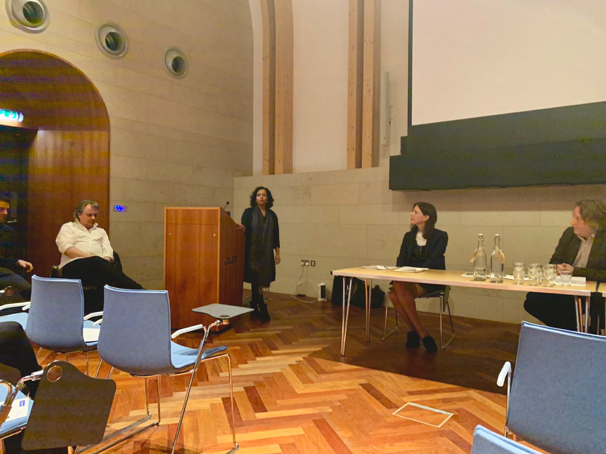
To listen to a podcast about the book here.
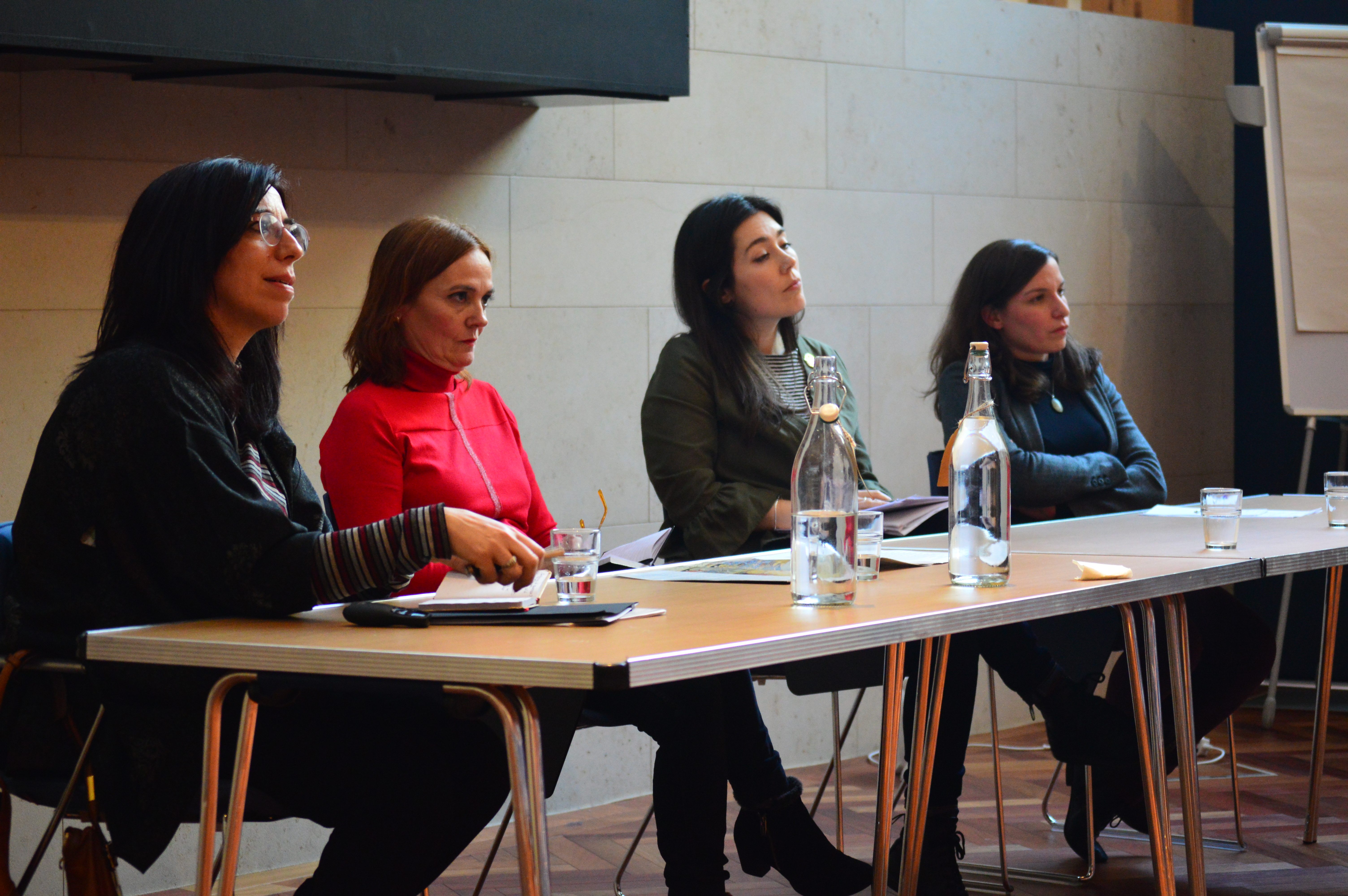
On Thursday 29 January 2020, TIDE held its first seminar of the term with two fascinating papers from Ana Sáez-Hidalgo and Berta Cano Echevarría of the University of Valladolid on Anglo-Iberian Exchanges in the early modern world. Ana’s paper, ‘Robert Persons at El Escorial: A story of textual conversion’, examined the reception of English Catholic and Protestant books in Spain in the sixteenth and early seventeenth centuries. Focusing on the works of the Jesuit Robert Persons and one of his Protestant opponents, Edmond Bunny, the paper highlighted the role of English controversial works in the efforts made by the Inquisition to combat religious heterodoxy in Spain or to prepare the students of the English Colleges based in the Iberian Peninsula to controversies and disputes with Protestant opponents. The study of the circulation and reception of these books, which were an important part of an exile Recusant literary culture, also reveal the dynamism of a different Anglo-Spanish networks formed by merchants, exile Catholics, Protestants who embraced Catholicism, as well as Spanish book collectors.

Berta’s paper, entitled, ‘The Construction of English Catholicism in Spain: Fake News or White Legend’, explored the formation of a ‘White Legend’ in Spain which presented the English as secret Catholics who awaited the fall of the Protestant regime. By examining one Spanish account of the martyrdom of Henry Walpole and a romance on the negotiations of the Treaty of London (1604), Berta exposed how Spanish texts on England deliberately manipulated or occulted information to persuade its readers of England’s imminent return to Catholicism and the correct path of the Spanish interactions with England. More than a problem posed by a language barrier or inquisitorial censorship, the lack of information on English affairs was encouraged and exploited by the Spanish authorities and the English Catholic exiles to disseminate distorted news that supported a political narrative which justified the Spanish Crown’s policy vis-à-vis England and its support of English Catholic exiles.
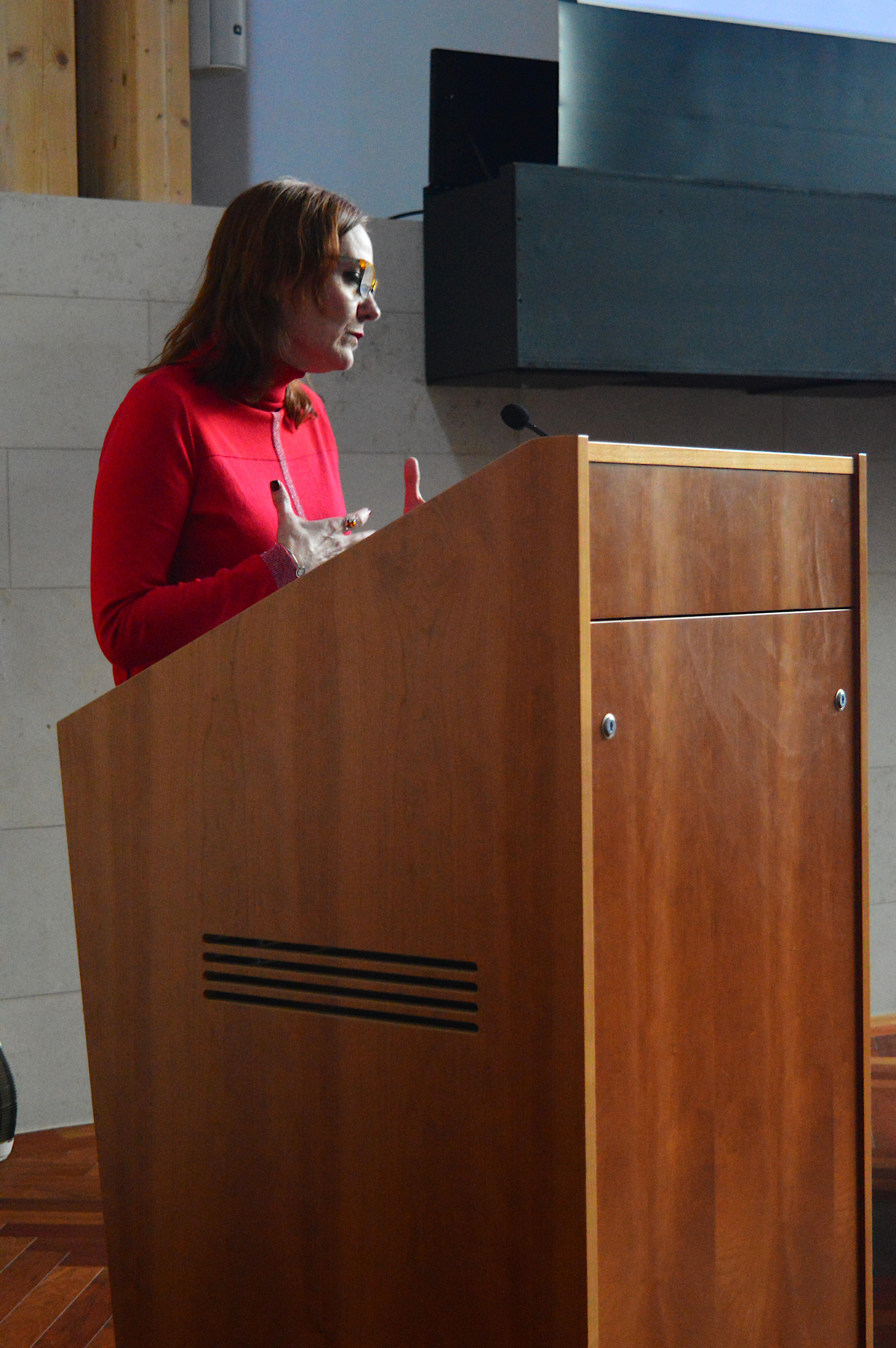
Both papers offered a thorough and insightful historicising of the literatures of the Anglo-Iberian exchange, and we are grateful to Dr Sáez-Hidalgo and Dr Cano Echevarría for sharing their research with us. Thanks also to discussants Dr Cecilia Tarruell of Oriel College, Oxford and Dr Stephanie Cavanaugh of Exeter College, Oxford.
I designed a Keywords assignment based on the TIDE Keywords resource in an undergraduate Senior Research Seminar at Michigan State University. This seminar served as a ‘Capstone’ course designed for graduating seniors, to bring together the various skills they have learned in English courses thus far (close reading, engaging with secondary sources and literary theory, interpreting a literary text from within historical contexts, structuring a literary essay and developing a solid thesis). They were required to deploy different critical approaches and specific methodologies, working towards more extensive research on a particular critical problem in early modern literary criticism through some primary research of contextual early modern texts in the Special Collections (MSU Libraries) or on Early English Books Online.
The research methods covered both primary and secondary texts, leading up to some critical questions that students addressed more fully in their final essay. Their initial task in developing their thesis was to explore some broad issues relating to early modern literary and cultural texts from roughly 1590 to 1625. These included some shared themes that cohered together to form a discourse or a set of ideas and perspectives on the period. Based on those explorations, students were asked to expand them into a Final Research Essay, developing it through two earlier drafts based on primary sources. I begin by reproducing the assignment below:
Keywords Assignment Please follow the steps below and write a 3-4-page, single space essay, divided into 2 coherent sections.SECTION I
- 1. Begin by studying the list of keywords on the TIDE online resource
- 2. Choose any 3 words from the list and briefly summarize the history of their usage, and identify and describe any 2-3 themes around which they cohere. Choose words that (preferably) are applicable to your final research project. Pay some attention to how the words may have evolved and accrued a range of meanings, via a “complex history of usage."
SECTION II
- 1. Identify 3-4 words (not included in TIDE Keywords) from your FINAL research essay that illustrate the main themes of your thesis. Following the models and structures of the TIDE Keywords, write a description of each word, including a short bibliography for each entry.
Rationale and Student Responses:
In order to establish a discursive framework for their final essay, students identified and defined Keywords around which each individual argument cohered (assignment defined above).
Why examine Keywords within the context of a research essay format?
Through their analysis of Keywords, students learn that meaning and knowledge do not only take shape in a linear and chronological sequence, as they follow specific points of time. Rather, they deploy a diachronic approach through which they consider the development and evolution of a word (and its related connotations) through history. The examples in the TIDE Keywords project demonstrate such a diachronic approach with historical depth and rigor.
For example, the TIDE editors offer fascinating insights into the words ‘translation’ and ‘interpretation’. They note how the word ‘Englishing’ is used to describe the process in which translators took foreign texts and made them publicly available. Immigrants and refugees from different parts of Europe would take texts from their native tongue and, with a level of cultural authority, produce an English document for others to read. Religion also played a key role in the field of translation: the King James Bible was published in 1611, and European missionaries would translate Christian texts into the cultural contexts of regional Indian dialects.
Interestingly, the TIDE Keywords resource also makes a note in their study of the word ‘translator’ that in early texts the words ‘interpreter’ and ‘translator’ were often used interchangeably. In a sixteenth-century translation of the Holy Bible, for instance, the word ‘interpreter’ is used when talking about communication of different languages through dialogue. And another text from roughly the same time used ‘interpreter’ as a way to describe religious figures that analyzed the Bible. By the terms of seventeenth-century England, though, the general description of both words is similar, but the contexts ultimately differ. According to Italian-born Elizabethan State official (and translator of Cinthio) Lodowick Bryskett, the translator is more of an academic, while the interpreter is more colloquial. That is, the translator deciphers not just the language, but also the context in which the language ‘resides’.
This account of ‘interpreter’ and ‘translator’ highlights the significance of the shifting nature of contextual variants. For my students, following the journey of specific keywords added depth and nuance to their research essays. Their exercises point to the contingency of language and the shifting currencies of meaning, often with varying moral (or immoral) connotations. For example, in one essay on the ‘Surveillance of Women’s Bodies in Early Modern Theatre,’ a student, Cortney Cox explored the representations of prostitution in Shakespeare’s Measure for Measure, and for her Keywords assignment, examined the words, ‘whore,’ ‘brothel,’ and ‘stew’ (‘stews’), with varying details.
Whore: Today, the word is used as a blanketed term for a woman who sleeps with many men or who has ‘loose’ morals. The word is also used during the Early Modern period in the King James translation of the bible where the Whore of Babylon is mentioned in the last book, Revelations. This ‘whore’ is supposed to represent the Catholic Church but it is still important to note that the whore is also associated with the antichrist and the downfall of mankind.
Brothel: This word is commonly known in contemporary times as a place where prostitutes reside, but it was not always used to describe a place but a person. According to the OED, there are two definitions that fall under the word: ‘A worthless abandoned fellow, a wretch, scoundrel, scapegrace, good-for-nothing’ and ‘An abandoned woman, a prostitute.’ The first definition is very significant when looking at how the history of the word has changed through time. ‘Brothel’ was not a word that was exclusively about women’s sexuality. Instead, the word ‘brothel’ is noted by OED as stemming from the Old English word Broden which means ruined, degenerate. The word once was used to describe immoral men which can be traced back as early as the 1300s. The change from this meaning to the one we know today had occurred with the close association to the French word for a prostitution house, bordel. In a blog post from Oxford University Press, etymologist Anatoly Liberman argues that the confusion between the French word bordel and the English ‘brothel’ seems to have happened because ‘Words for sex and prostitution move easily from language to language.’ Liberman suggests that some of the connotations from ‘brothel’ linked well with those who dwelled in bordels. The prostitutes and their clients were seen as immoral ‘scoundrels’ which is what the word ‘brothel’ described. These words were used interchangeably thus making ‘brothel-house’ which was commonly used throughout 1530-1599 according to The Historical Thesaurus of English. The ending was soon dropped and the word ‘brothel’ is now solely meant to label the place where prostitutes dwell.
Stew: Although ‘brothel’ is not specifically used in Measure for Measure, other synonyms are chosen to describe the place such as the word ‘stew’. Looking up the OED definition of ‘broth’, some interesting words seem to appear that help connect these words to the themes of appetites and lascivious desires within plays and other forms of literature: ‘The liquid in which anything has been boiled, and which is impregnated with its juice; a decoction; esp. that in which meat is boiled or macerated; also, a thin soup made from this with the addition of vegetables, pearl barley, rice, etc., as Scottish ‘broth’.’ The word ‘impregnated’ is commonly used to evoke women’s sexuality and the ‘juice’ that is mentioned could also be easily connected with the bodily fluids women and men produce during sex. In the same light, the word ‘stew’ also associates heat and boiling. Some of definitions found in OED define ‘stew’ as: ‘A heated room used for hot air or vapour baths: hence, a hot bath.’ Stews/ Brothels were also synonymous to bath-houses as the OED has noted. Partridge’s Shakespeare’s Bawdy, describes the ‘original sense of stews [as] ‘bath’-room or –house, hence ‘hot bath’…‘a turkish bath’... Public baths were formerly, in many other countries, the resort of persons of ill-fame’ (Partridge, p.191). Hence, it is easy to see how words such as ‘stew’ or ‘broth’ fit into the frame of prostitution. The heat described in the two words reinforces the spreading of bacteria and disease while also describing how the broth/stew are mediums that soak up the juices of meat. Similarly, women’s bodies are viewed as vessels that take in sperm and carry children. In this, we see how the prostitutes’ use of their bodies is threatening to the social order because this must be regulated by people such as Angelo and the Duke in Measure for Measure: ‘My business in this state made me a looker-on here in Vienna, where I have seen corruption boil and bubble till it o’errun the stew’ (5.1 317-320).
Other student’s keyword choices – as below – helped to animate their arguments and representations of their research essays. The Keywords resource on the TIDE website offers a productive pedagogical model, especially in courses on early modern literature, history, and culture as it enables scholars to metaphorically ‘mine’ selective words and concepts, illuminating a discursive field of interconnected meanings. Thus, an analysis on witchcraft becomes more complex when viewed through the varied lenses of the word ‘magic’, or an essay on travel narratives to Africa reveals emerging European biases through their deployments of categories such as ‘Negro’.
Student Choices (SECTION II)
- 1.Topic: Ghosts, Religion, and Anti-Catholicism
- Keywords chosen: superstitious, supernatural, ghost
- 2. Topic: The Surveillance of Women’s Bodies in Early Modern Theatre
- Keywords chosen: whore, brothel, stews
- 3. Topic: The Discourse Around Women and Witchcraft in the Literature of the English Renaissance
- Keywords chosen: demon/daimon, magic, occult
- 4. Topic: The Rape of Lucrece: Criticism of Roman Morality through Female Autonomy, Metaphor, and Characterization
- Keywords chosen: virgin, rape, ravish
- 5. Topic: Travel Narratives about Africa in the Early Modern Period
- Keywords chosen: negro/negroes, virtue, vice
- 6. Topic: Navigating Women’s Spaces in Early Modern Drama: The Tragedy of Mariam
- Keywords chosen: dumb, blush, chaste
- 7. Topic: Martyrdom in English Renaissance Drama
- Keywords chosen: martyr, virtue, persecute
- JYOTSNA G. SINGH
- Professor, Department of English
- Michigan State University
- US

Broken coach wheels, gaping sea monsters, cozening tricksters – we’ve read enough classical and early modern literature to know that voyaging contains a litany of perils. While we have high hopes for reaching our new destination intact, what makes our impending departure less difficult is the knowledge that we’ll be continuing our collaborations with partners and colleagues at the University of Liverpool and beyond.
With the World Museum (National Museums Liverpool) and our 2017-18 visiting writer, Sarah Howe, we’ll continue to develop the redisplay of the Chinese ceramics case in the museum’s World Cultures Gallery. We’re hugely excited to see how this collaboration unfurls as we move ahead with the museum’s curatorial staff and design team, and with the further participation of Belle Vue Filming and the girls at Birkenhead High School Academy.
Howe’s TIDE-commissioned poetry, written from the perspective of six of the museum’s objects, humorously and movingly probes ideas around displacement, transformation, and identity. This is evident even in a brief excerpt of Howe’s verses:
- The riddle of my origins
- begins on a spinning wheel in Fujian, and ends
- across two continents, with a silversmith
- in Restoration London.
- ...Some twists
- in my provenance are lost even to me:
- a Pope’s embassy, the halls of Versailles,
- hands that held me up to the light in awe
- at my lustre, placed me in locked cabinets.
Selections of Howe’s poems will come to life in the display case next year as part of TIDE and the museum’s shared vision of encouraging visitors to think creatively, and critically, about the nature of collecting, acquisition, and display.
The School of the Art’s Centre for New and International Writing at the University of Liverpool will continue to work with us on the activities around our annual visiting writers. In the past, these events have involved poetry readings and student workshops in Liverpool as well as at the London Review Bookshop and Waterstones Piccadilly in London. We also hope to retain our valuable relationship with the Everyman Theatre, where our visiting writer Nikesh Shukla hosted a comedy event in March 2019.
We remain deeply invested and committed to the partnerships we’ve developed whilst at Liverpool. Like the travelling vessels in Howe’s poetry, each place imprints and shapes us along the way, and we look forward to sharing more developments as they come.
At the start of my doctoral research last year in the Archivio di Stato di Venezia, I spotted a familiar but unexpected name in the Venetian state papers. It was signed at the bottom of a receipt, in handwriting that I had only seen in a British Library music manuscript [1]. This was the signature of Angelo Notari (1566-1663), a Paduan singer, lutenist, and composer who immigrated to England circa 1610 and worked as a Stuart court musician. Early music specialists have recognized him for introducing a great deal of Italian music into 17th-century England, from virtuosic violin sonatas to theorbo-accompanied monody and madrigals. So what was his name doing here, amid streams of cipher in secret diplomatic dispatches?
Closer examination of these documents revealed that between 1616 and 1619 Notari was an informant for the State Inquisitors of Venice, a powerful counterintelligence division of the Republic’s centralized secret service [2]. This information has heretofore escaped the attention of musicologists, perhaps because Notari’s name is spelled differently in most Venetian sources, and political historians who have studied those sources never made the connection.
After the sudden death of Prince Henry Stuart in 1612, Notari temporarily lost his royal patronage and had to make a living elsewhere. He published his only known book of printed music [3]. He seems to have found employment at the Venetian embassy in London, only to be fired for bringing plague-infected items into the ambassador’s home. And then, like many of his musical contemporaries, he turned to espionage.
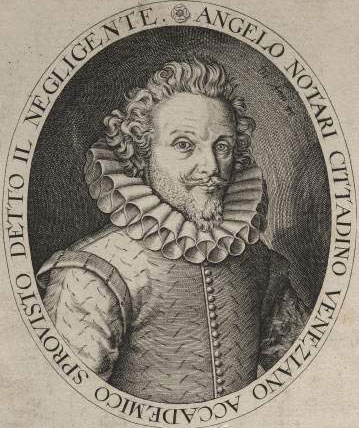
As an intelligencer, Notari was entangled in a contentious international trial involving the Venetian ambassador to England, Antonio Foscarini, and two of Foscarini’s embassy staffers. Notari approached various Venetian authorities in London with incriminating information about all three diplomatic agents, adding to an already long list of bizarre, yet serious accusations against them by other local residents. Notari’s detailed depositions accused Foscarini of disrespectful name-calling, indecent behavior during Mass, and more alarmingly, sexual assault. Notari also alleged that the embassy secretary, Giulio Muscorno, had slandered and publicly mocked Foscarini throughout the city. Notari eventually transitioned into paid work for the State Inquisitors. Thanks to Notari, they discovered that Foscarini’s valet, Ottavio Robbazzi, had been selling the ambassador’s letters to other foreign agents in London.
Foscarini, Muscorno, and Robbazzi were all discharged and imprisoned in Venice. While they awaited sentencing, Notari helped the State Inquisitors settle a debt that Muscorno still owed to an Englishman. This led to another international scandal when the English ambassador to Venice, Henry Wotton, tried to pocket the money for himself. After the trial ended, the State Inquisitors recommended Notari’s intelligence services to another Venetian official who remarked that Notari’s frequent presence in the homes of political elites made him an optimal candidate for the job. Several scholars have speculated that Notari became a spy for Spain by the early 1620s.
Notari aside, the Foscarini-Muscorno case takes several surprising twists and turns into musical territory. In fact, Muscorno’s own musical activities were of great significance to the trial. His musical talents gained him formidable allies at the English court who supported his aggressive campaign against Foscarini. And yet, the Venetian government ultimately held Muscorno’s music-making against him as evidence of criminal conduct; he was indicted for singing in Anglican churches and defaming Foscarini through crude, buffoonish musical performances.
As I continue my dissertation research on music and mobility, I’m thinking about music in this period as a major economic export and transnational currency, traded for more than just financial compensation. Music could buy valuable information and contacts. Foreign musicians in London capitalized on their art to gain entry into powerful political networks, thus rising to prominence in their own expatriate communities and indelibly changing the course of diplomatic history.
My journal article detailing Notari’s intelligence intrigues soon to be published in Early Music History. In the meantime, I’ll be sharing more on this subject at the annual American Musicological Society conference in Boston this November. Hope to see you there!
Alana MailesAlana Mailes is a PhD candidate in Historical Musicology at Harvard University. Her work explores issues of diaspora and migration in early modern music of Italy, Britain, and Ireland. She is also an enthusiastic performer of early music.
- 1. Angelo Notari, Add. MS 31440, British Library, London.
- 2. The Venetian State Papers in question are Inquisitori di Stato, Buste 155, 156, and 442. Some have been transcribed and translated in the Calendar of State Papers Relating to English Affairs in the Archives of Venice, Vols. 12-15, ed. Horatio F. Brown and Allen B. Hinds (London: The Stationery Office, 1905-9).
- 3. Notari, Prime musiche nuove (London: Engraved by William Hole, 1613).
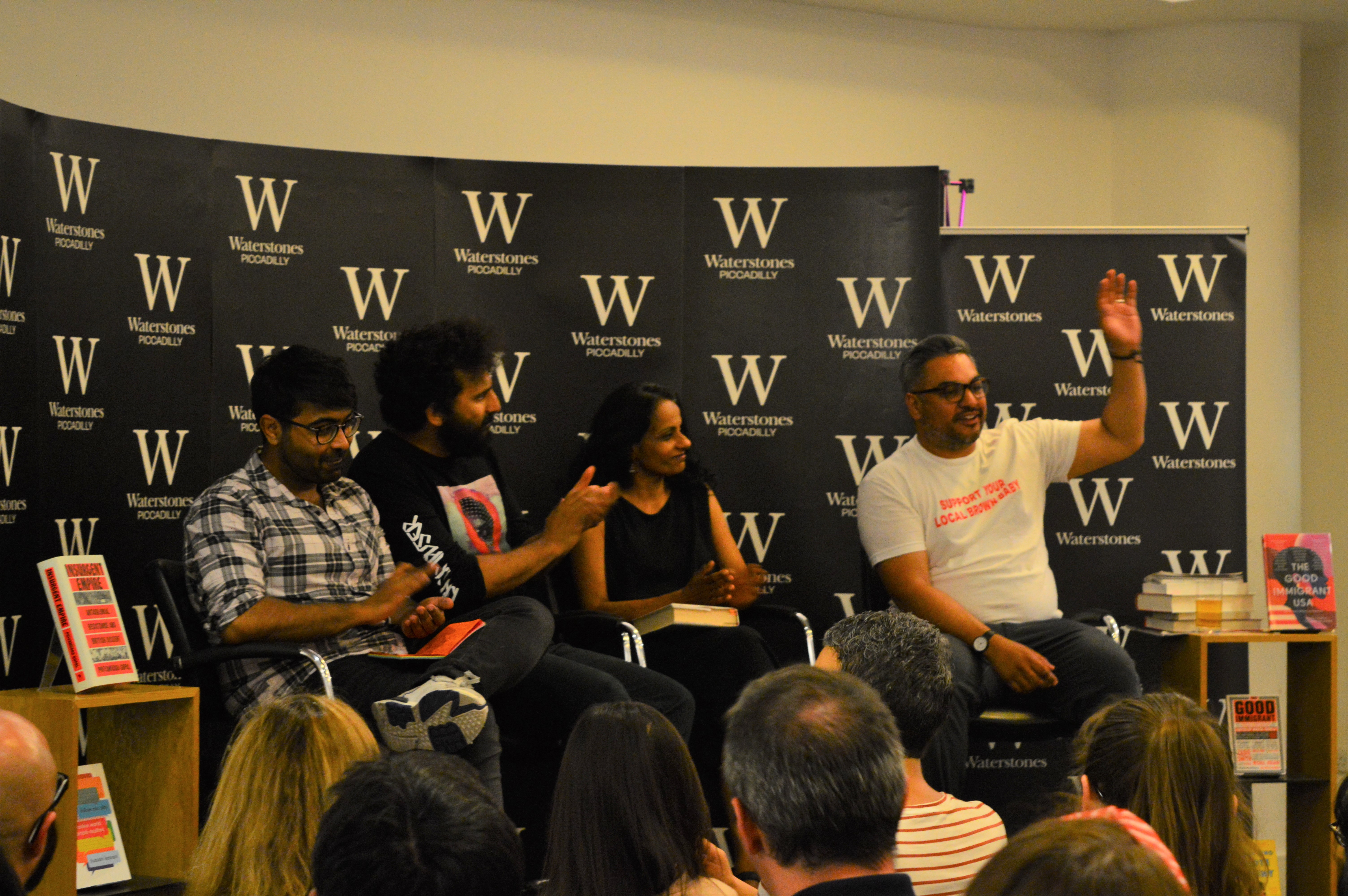
Last Friday, TIDE visiting writer Nikesh Shukla sat down with Priyamvada Gopal, Reader in Anglophone and Related Literatures in the Faculty of English at the University of Cambridge, Nish Kumar, a critically acclaimed comic, and journalist, editor, and producer Hussein Kesvani for a conversation about anger, social media, and the place of humour in public debate.
- Civil Discourse and Social Media
- Civility Contested
In today’s highly-charged political climate, fruitful conversations about identity and the notion of ‘Britishness’ are often impeded by accusations of ‘uncivil’ or indecorous behaviour. The idea that ‘reasoned’ debate should be free from passion or emotion goes back to Greco-Roman political theory and is grounded in our ideas of civic participation, but such allegations can also become a means of divesting people of the authority to speak. Over the course of the evening, the panellists explored these issues through questions of voice. Who has a right to express themselves, who are prevented from doing so, and how can the subversive nature of comedy instigate change?
Does the internet encourage civil debate, or do different online platforms merely foster hate speech and division? Sites like Twitter can operate as a form of resistance or add new voices to political debate, but such platforms also give rise to accusations and threats that shut down debate. ‘Civility,’ Kesvani commented, ‘has been weaponised by those who don’t like what they hear’. Kumar considered the fine line between political comedy and politics, where navigating jokes about contentious topics can be both empowering and difficult to manage when taken out of context. Kumar, Shukla, and Kesvani discussed how BME communities, particularly young Muslims, have used social media to navigate their identities while also contending with the experience of racism.
Shukla’s ongoing conversations with TIDE brought historical ideas around civility into the conversation. Does civility - a concept that became deeply imbedded in English ideas of authority and belonging in the sixteenth and seventeenth-centuries, at a time when the English began to view themselves as an imperial power for the first time - foster or hinder conversations between those of different countries, faiths, or political affiliations? Hosted the day after TIDE and The Runnymede Trust presented their report on ‘Teaching Migration, Belonging and Empire in Secondary Schools’ in Parliament, the evening’s discussions around civility go to the heart of questions about how the English ‘national’ story is constructed and conveyed.
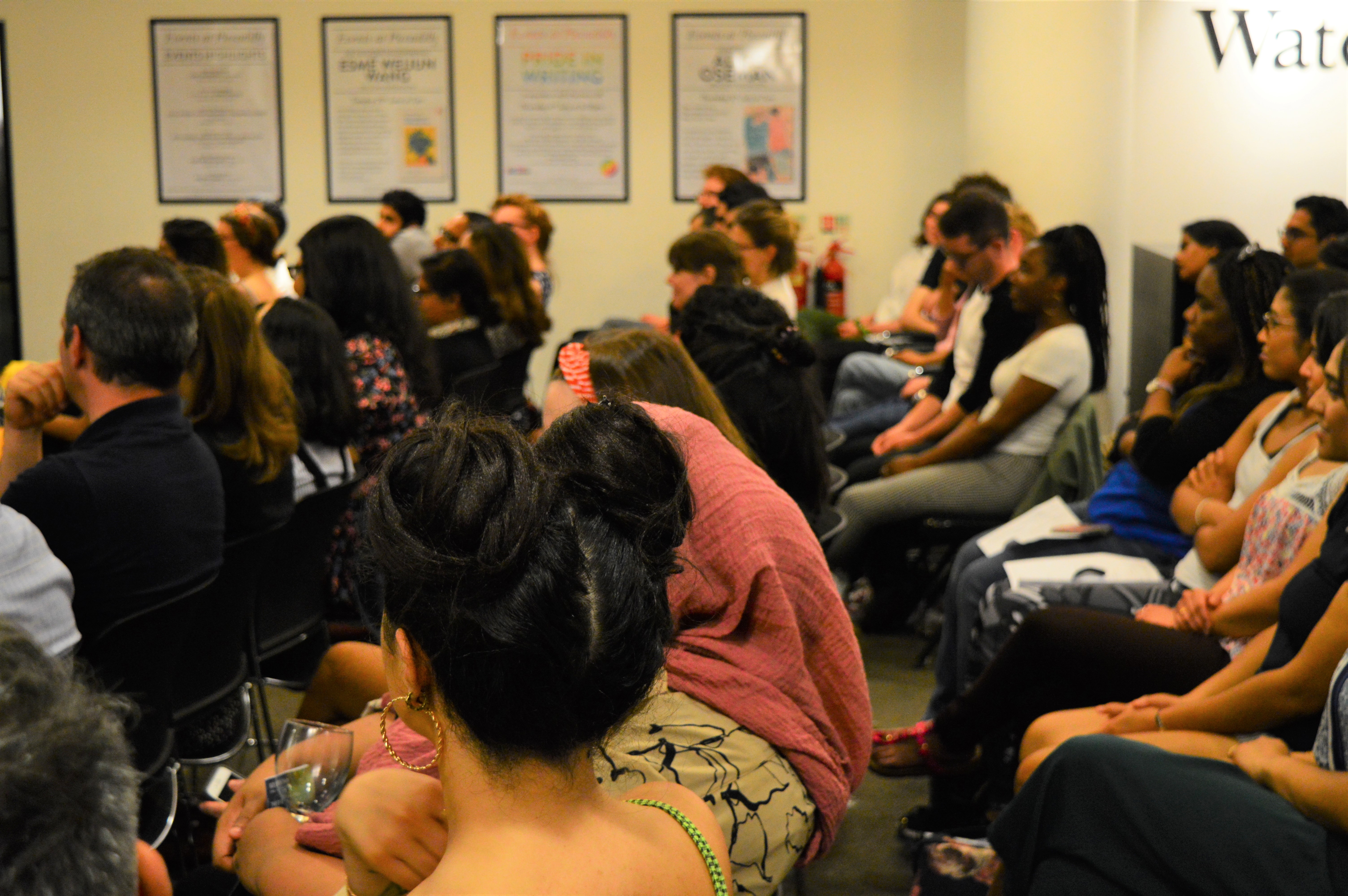
Reading from her book, Insurgent Empire, Gopal spoke of the value of the historic ‘archive of resistance’ to English colonialism and its implications for British identity today. The long history of resistance to imperial domination - not ‘retrospective anticolonial critique’ but the active pressure on dominant structures that is present through time - serve as a reminder that the freedom and agency of individuals and invaded peoples have long relied on public debate and the relentless questioning of national stories.
While the language of incivility as a form of slander has long been present in English writing, so too has been an admission, however begrudging, of cultural relativism and of the value of learning through interaction with those who adhere to different ways of seeing and understanding the world. One of TIDE’s largest project outputs, the open-access Keywords, is a collection of essays that probe the contentious political, legal, and religious terms around cultural difference in the early modern era. As these demonstrate, conversations about race and identity have never been one-sided. Labelling another ‘savage’ or ‘barbarous’ was often a means of ostracizing others, but alternate voices have long destabilized the authority of dominant narratives, and are present when you look for them. Whilst in Mughal India, the Englishman Edward Terry narrated an episode in which an inebriated cook in the service of the English ambassador attempted to assault the governor of Surat’s brother. Though the cook called him a ‘heathen dog’, the Mughal ‘replied civilly’ to the abuse, leading Terry to question English notions of Christian civility: ‘who was the Heathen dog at this time...the debaucht drunken Cook who call'd himself a Christian, or that sober and temperate Mahometan who was thus affronted?’ In the later account of his travels through the Ottoman Empire, Henry Blount also viewed ideas of civility as less fixed: although ‘the Turkish way appeare absolutely barbarous’ it was in fact ‘another kind of civilitie...different from ours’.
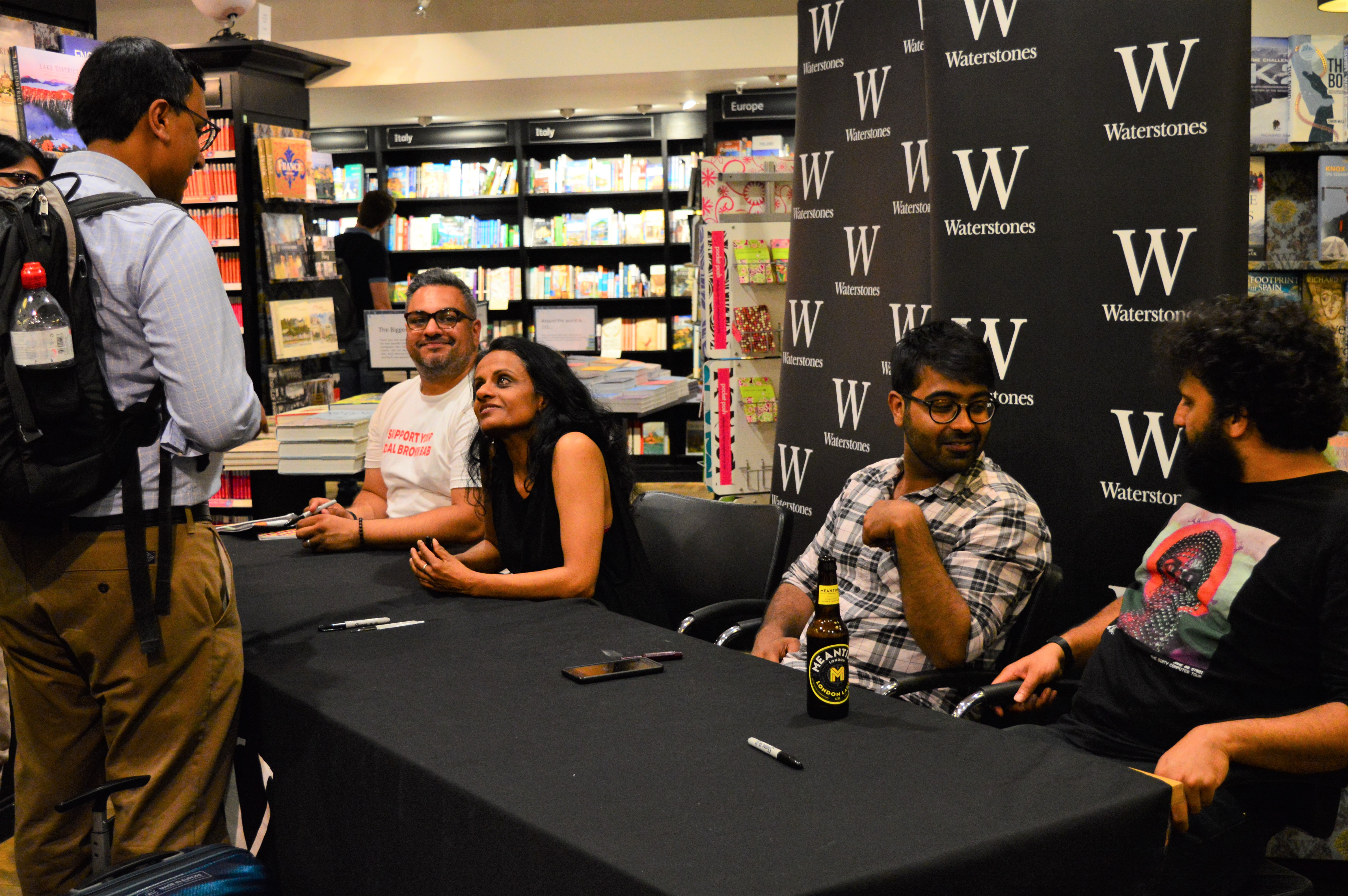
These examples may be exceptions rather than the norm, but they point to an important strand in the evening’s discussion: that the celebration of civility as a marker of English imperial power did not go unquestioned or uncontested. This has important implications for understanding the function of what we mean by civil debate today, and serves as a reminder that civility and politics are shaped by the multiplicity of voices at work within society. And as the whir of coffee grounds in the cafe at the book signing reminded us, the very idea of the ‘public sphere’ of political debate that emerged out of the seventeenth century took place around a distinctly non-English commodity: coffee, a ‘Mahometan’ drink, consumed in public spaces where new media and intelligence brought global affairs to public scrutiny. Critics lamented the ‘Heathenish Rules’ of new consumption that made the English ‘damn’d over Tea-Cups and Coffee’, but in doing so signalled the presence of other peoples and cultures in English sociability and political exchange.
Lauren Working
Check out Nikesh Shukla’s Unbound essay on civility and anger here.
You can follow threads about the TIDE/Runnymede parliament briefing on @ERC_TIDE and @Runnymede Trust, and read the migration report here.
Click here for Priyamvada Gopal’s related article in The Guardian from 6 July.
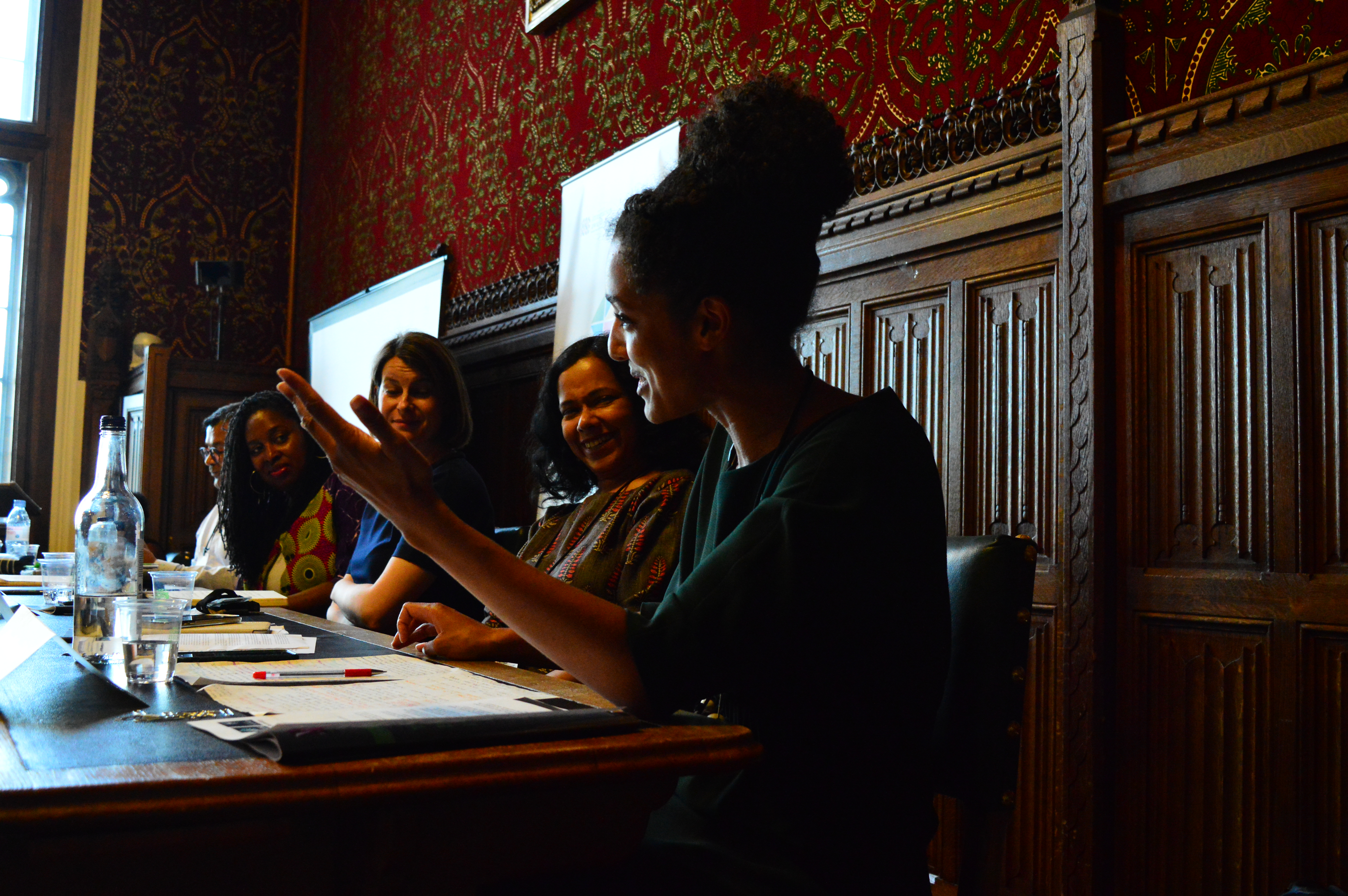
On 4 July, TIDE and the Runnymede Trust presented their joint report on ‘Teaching Migration, Belonging and Empire in Secondary Schools’ at a panel discussion in the Houses of Parliament hosted and chaired by Dawn Butler MP. The report is based on a 2-year TIDE-Runnymde collaborative study, which included the TIDE Beacon Fellowship, an innovative programme of professional development for secondary school teachers. It highlights the importance of these subjects for the curriculum, evaluates the challenges faced by teachers and proposes a series of measures to improve and expand the teaching of migration, belonging, and empire. At a packed Committee Room, the three authors of the report, Kimberly McIntosh (Runnymede Trust), Nandini Das (TIDE) and Jason Todd (University of Oxford), together with two TIDE Beacon Fellows – Lauren Cowan (Alexandra Park School, Haringey) and Hannah Cusworth (Charter School East Dulwich) – and Helen Hayes MP discussed how the findings and recommendation of the report could contribute to the improvement of the National Curriculum. The presentations spawned a conversation with the audience on the different problems faced by teachers and the relevance of migration and empire to understand contemporary Britain.
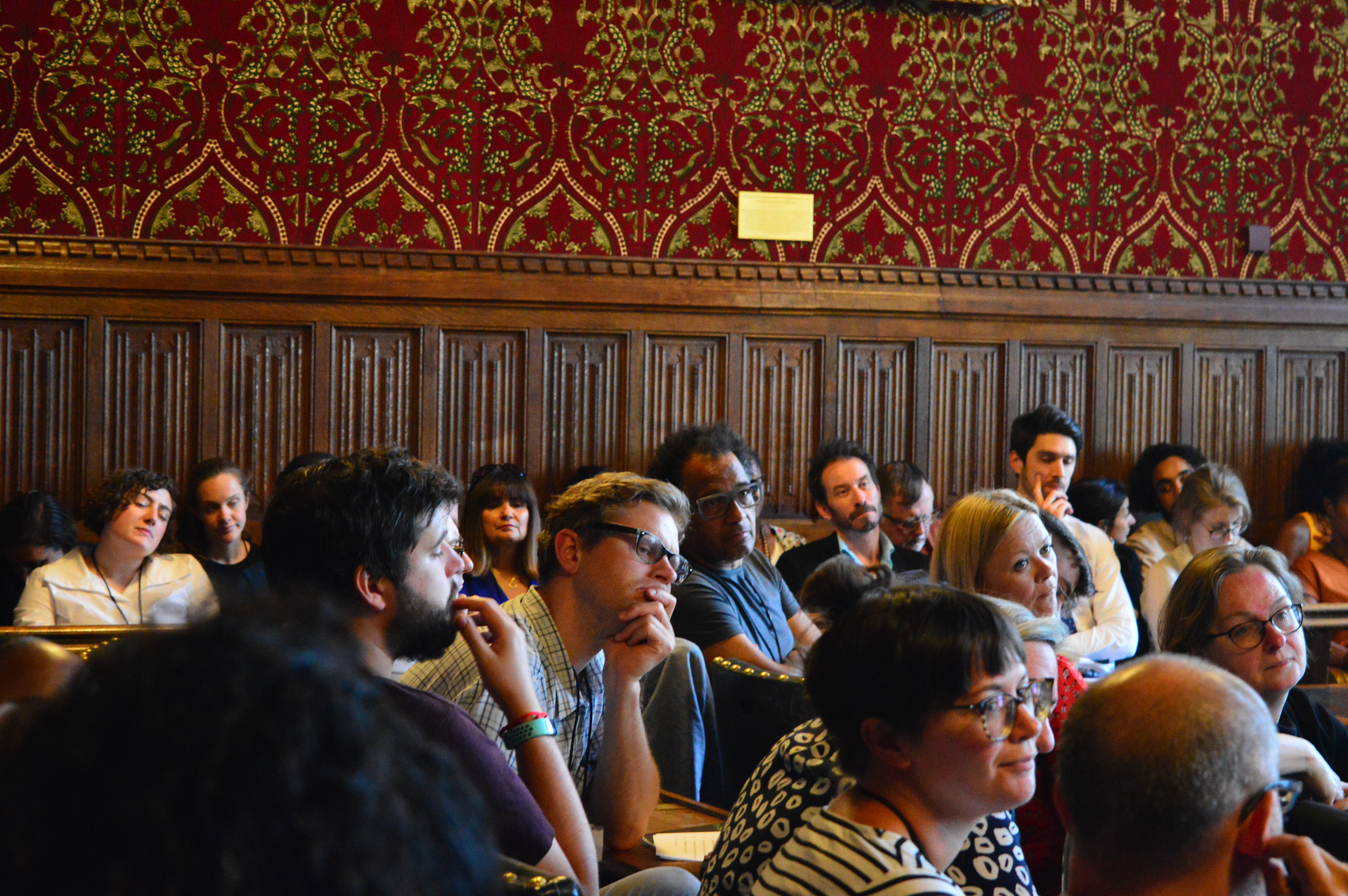
The full report Teaching Migration, Belonging, and Empire in Secondary Schools is available here.
- 1) Why is it important that students learn about this historical event?
- 2) What is their existing knowledge in this area of study?
- 3) What existing units of work are being taught now or in the forthcoming term?
- 4) How can I link and develop history and English skills?
- 5) What will the final outcome be?

It’s been quite a journey for me, working on the TIDE Project. It’s a new mode of thinking, one that relies on so much more than instinct or opinion. It relies on research, care, diligence and an ability to spot patterns. When I think about what has shaped my thinking on migration and how that has formed a worldview for me as a British-born citizen of South Asian descent, often I’m left with this feeling of precariousness. Immigration seems precarious. My citizenship feels precarious. Our sense of history is precariously retold. Often from the wrong gaze. How do I even begin to shape my thoughts on what impact migration had on Britain and on Britain’s view of identity, its own and that of people around the world.
For years this idea of precariousness has been shaping my work in a multitude of ways. I’ve been absorbing myself in the voices of British people of colour, migrant voices writing about the UK today to try and understand what we understand as multicultural Britain. The work, while it has been successful, certainly with the book of essays, The Good Immigrant, has often meant I’ve been put forward for opportunities better suited to what one might obliquely refer to as a public intellectual. I’m hardly one of those. I’m just a nerdy kid from a London suburb whose life has been shaped and changed and remoulded by key instances of racism that reminded me of my own precariousness.
At Hay Festival, I found myself pitted alongside Laura Bates (of the Everyday Sexism Project) against David Aaronovitch and Jodie Ginsberg of Index On Censorship in what became a discussion around free speech and whether with it came a sense of responsibility. Or whether, as one person once tweeted me, free speech meant that people could approach me in the street and be racist to my face, because free speech. While I don’t consider myself someone who thinks about limiting free speech, I certainly think about the right to critique, push back, respond, find something objectionable or even wrong, lost in these conversations, as less relevant than a person’s right to say whatever the hell they want.
I want us to think about the responsibility and power of words.
I remember being approached to be on a debate panel about something I felt was utterly offensive and wrongheaded and in fact meant we could never have a nuanced and impactful conversation about racism in Britain, because we were still stuck on such biliously polar opposite parameters. The organiser was quick to remind me that ‘offence was subjective’. I replied that of course it is, but that didn’t give them a get out of jail free card in discussing what I was offended by. I invited a conversation. Only to be made to feel silly for feeling a feeling in the first place.
We hear a lot about the need for civilised debate. We must debate these things civilly.
The problem is, I can’t debate these things civilly. I’m angry. And while it’s easy to dismiss me as an angry ethnic who cares more about feelings than facts, well, I’m angry. And you will hear me.
Because what have we learned about the world, through centuries of movement, what have we told ourselves about identity, if we cannot give people a space to live, free of debate, hate speech or even being made to feel like their offence is their problem.
All these things were swimming around my head when I was approached to be a writer in residence for TIDE. But how to give this discombulation focus and proper rigorous academic insight?
A conversation with Nandini and the TIDE research team led me down an interesting path I had never considered before. When I said that I was angry. I felt angry and this meant I wasn’t up for civil debate, one of the researchers said that this had a long history in colonialism and the idea of the angry ethnic vs civilised debate by public intellectuals could be linked directly to colonial ideas of the barbaric savage vs the civilised gentleman of the Empire.
A day later and I was furnished with heaps of research on the subject. Key investigations into where words like civilised, and savage, and barbaric have been used in texts throughout history and what impact these have had on the subjects of the words. And now the project has focus and I know exactly what I want to add to it, and with all this research, am excited to continue working with these post-doc researchers who have helped me to tether this cluster of thoughts to something tangible and rooted in a history I’ve known the broad strokes of, but now have the research to back it up. Watch this space: some new work is coming.
Nikesh Shukla
Nikesh Shukla's The Good Immigrant USA is out in USA from 19th February and the UK from 7th March. For the terms Nikesh mentions above, see TIDE's Open Access publication, TIDE: Keywords.
 The Renaissance Nude at the Royal Academy, until 2 June 2019 &
Elizabethan Treasures: Miniatures by Hilliard and Oliver, until 19 May 2019
My visit to the V&A’s Clothworkers’ Centre in London coincided with two exhibitions, The Renaissance Nude at the Royal Academy, and Elizabethan Treasures: Miniatures by Hilliard and Oliver at the National Portrait Gallery. Though a hundred years and the English Channel separate early Renaissance Continental nudes and Elizabethan and Jacobean miniatures, ideas around civility and exposing (or concealing) the body brought these exhibitions together in many ways. Pale skin with hints of oyster-pink and blue-green hues seemed ever present, whether in stark, defiant display or enhanced by coy degrees of exposure. Both exhibitions, when viewed through the lens of elite self-fashioning and attitudes to the body, have a great deal to say about civility and the body’s relationship to power.
The Renaissance Nude explored how naked bodies came to occupy the European imagination to the extent they did. Avoiding grand narrative claims, the exhibition explored the multifaceted and at times conflicting responses to the human form emerging in different parts of Europe. From Leonardo’s anatomical drawings to Christian mysticism, Greek mythology to gruesome apocalyptic sketches, the exhibition demonstrated how humanism and the classical revival existed alongside and sometimes in tension with Christian morality. Paintings like Perugino’s Combat Between Love and Chastity, commissioned by Isabella d’Este in Mantua, provoke a consideration of the function of art in female pleasure and collecting. Beyond idealized forms, bodies marred by sin and punishment twisted and dragged their way across the canvases and oak panels, emitting silent screams as they came to terms with their own damnation. Violence, voyeurism, and vulnerability lurked even behind the most symmetrical and proportioned bodies.
As its name highlights, Elizabethan Treasures brought to life the glittering and jewel-like wonder of miniatures, themselves often stored in ivory or gold boxes and worn as adornments on the body. The galleries presented a world as bright, esoteric, and enchanting as the objects within them, full of silver and cobalt, flickering gold meant to catch light and mimic fire, teasing glances and poignant reflections on death and memory. Undershirts spill suggestively out from slashed garments; unbuttoned and untied apparel suggest an intimacy between sitter and beholder. Garments are an important part of the interplay between secrecy and transparency that miniatures embody as objects of revelation, assisting in how individuals present their bodies and impart secret lusts or anxieties around death or rejection. These miniatures become spaces of technical ingenuity and memory, seduction and self-assertion, from Hilliard and Oliver’s self-portraits to those commissioned by middling and elite patrons. It is remarkable to see so many of these miniatures given pride of place, when they are all too often dwarfed in galleries by the larger paintings hanging on the walls.
Having spent the week investigating the stitches, patterns, and tailoring of 1620s doublets and smocks at the archive, I was struck by the brilliant ways in which the particular cuts, slashes, and tailoring of the clothed body, not just the undressed one, could convey sensuousness and desire. I recalled the lines from Spenser’s Faerie Queene: ‘all that might his melting heart entyse/To her delights, she unto him bewrayd:/The rest hid underneath, him more desirous made’. Laced and unlaced, these bodies stand, sit, and lean in their tiny casings, pinned to a playing card, framed by gardens, bedrooms, and deathbeds. In the world outside the court, pinking (the deliberate slashing of clothes) and costly, barely-there materials were heavily criticized. ‘Those silken fellows are but painted images, outsides, outsides’, warns a character in Thomas Dekker’s play, The Shoemaker’s Holiday (1604); ‘their inner linings are torn.’ At the early Stuart court, women’s bodices were cut so low that they were attacked for being both overly provocative and too masculine.
The Renaissance Nude at the Royal Academy, until 2 June 2019 &
Elizabethan Treasures: Miniatures by Hilliard and Oliver, until 19 May 2019
My visit to the V&A’s Clothworkers’ Centre in London coincided with two exhibitions, The Renaissance Nude at the Royal Academy, and Elizabethan Treasures: Miniatures by Hilliard and Oliver at the National Portrait Gallery. Though a hundred years and the English Channel separate early Renaissance Continental nudes and Elizabethan and Jacobean miniatures, ideas around civility and exposing (or concealing) the body brought these exhibitions together in many ways. Pale skin with hints of oyster-pink and blue-green hues seemed ever present, whether in stark, defiant display or enhanced by coy degrees of exposure. Both exhibitions, when viewed through the lens of elite self-fashioning and attitudes to the body, have a great deal to say about civility and the body’s relationship to power.
The Renaissance Nude explored how naked bodies came to occupy the European imagination to the extent they did. Avoiding grand narrative claims, the exhibition explored the multifaceted and at times conflicting responses to the human form emerging in different parts of Europe. From Leonardo’s anatomical drawings to Christian mysticism, Greek mythology to gruesome apocalyptic sketches, the exhibition demonstrated how humanism and the classical revival existed alongside and sometimes in tension with Christian morality. Paintings like Perugino’s Combat Between Love and Chastity, commissioned by Isabella d’Este in Mantua, provoke a consideration of the function of art in female pleasure and collecting. Beyond idealized forms, bodies marred by sin and punishment twisted and dragged their way across the canvases and oak panels, emitting silent screams as they came to terms with their own damnation. Violence, voyeurism, and vulnerability lurked even behind the most symmetrical and proportioned bodies.
As its name highlights, Elizabethan Treasures brought to life the glittering and jewel-like wonder of miniatures, themselves often stored in ivory or gold boxes and worn as adornments on the body. The galleries presented a world as bright, esoteric, and enchanting as the objects within them, full of silver and cobalt, flickering gold meant to catch light and mimic fire, teasing glances and poignant reflections on death and memory. Undershirts spill suggestively out from slashed garments; unbuttoned and untied apparel suggest an intimacy between sitter and beholder. Garments are an important part of the interplay between secrecy and transparency that miniatures embody as objects of revelation, assisting in how individuals present their bodies and impart secret lusts or anxieties around death or rejection. These miniatures become spaces of technical ingenuity and memory, seduction and self-assertion, from Hilliard and Oliver’s self-portraits to those commissioned by middling and elite patrons. It is remarkable to see so many of these miniatures given pride of place, when they are all too often dwarfed in galleries by the larger paintings hanging on the walls.
Having spent the week investigating the stitches, patterns, and tailoring of 1620s doublets and smocks at the archive, I was struck by the brilliant ways in which the particular cuts, slashes, and tailoring of the clothed body, not just the undressed one, could convey sensuousness and desire. I recalled the lines from Spenser’s Faerie Queene: ‘all that might his melting heart entyse/To her delights, she unto him bewrayd:/The rest hid underneath, him more desirous made’. Laced and unlaced, these bodies stand, sit, and lean in their tiny casings, pinned to a playing card, framed by gardens, bedrooms, and deathbeds. In the world outside the court, pinking (the deliberate slashing of clothes) and costly, barely-there materials were heavily criticized. ‘Those silken fellows are but painted images, outsides, outsides’, warns a character in Thomas Dekker’s play, The Shoemaker’s Holiday (1604); ‘their inner linings are torn.’ At the early Stuart court, women’s bodices were cut so low that they were attacked for being both overly provocative and too masculine.



Joined onstage by comedians Josie Long and Robin Ince, and Professor of English Language, Paul Simpson, award-winning author and this year’s TIDE writer-in-residence, Nikesh Shukla kicked off the evening by asking if there is such a thing as ‘universal humour’? Whether used as an everyday coping mechanism or to challenge the tyranny of authoritarian regimes, all agreed that comedy helps us confront life’s cruelties and absurdities. It underscores – as Josie noted with an anecdote about an ice cream van in Vietnam playing ‘Happy Birthday’ – a shared humanity that transcends cultural differences and dismantles language barriers, revelling in silliness.

All speakers were keen to stress, however, that while comedy might be universal, jokes are not. Oftentimes they do not occupy a neutral position, removed from the power structures and systems of oppression that shape the everyday lived experiences of marginalised communities. The performer, argued Robin, has responsibility for the material they use. This is, of course, not just limited to comedians with a public profile. We must all acknowledge that a joke told to those who know us personally and know our intentions, can have very different consequences when voiced to those who do not, whether this is a few hundred followers on Twitter, or thousands of fans in the stalls or tuning in at home. If ‘5%’ of the audience isn’t laughing, it isn’t good enough to say ‘they just don’t get the joke’. Rather the onus is on the joke-teller to figure out who’s not laughing and why.
Those who are laughing may not do so for the intended reason. Satire, especially when caricaturing bigotry, is damaging, and potentially dangerous, if even a small group take it at face-value. On the other side of the same coin is comedy that is offensive simply for the sake of being offensive. It is often followed by the tagline ‘it’s only a joke’, a phrase that risks silencing marginalised voices and – inadvertently or not – validates the systems responsible for this marginalisation. It denies the very real consequences and power of language as a primary means for social and political control. And often those who think ‘it’s just a joke’ are those unaffected by the wider, more sinister implications.
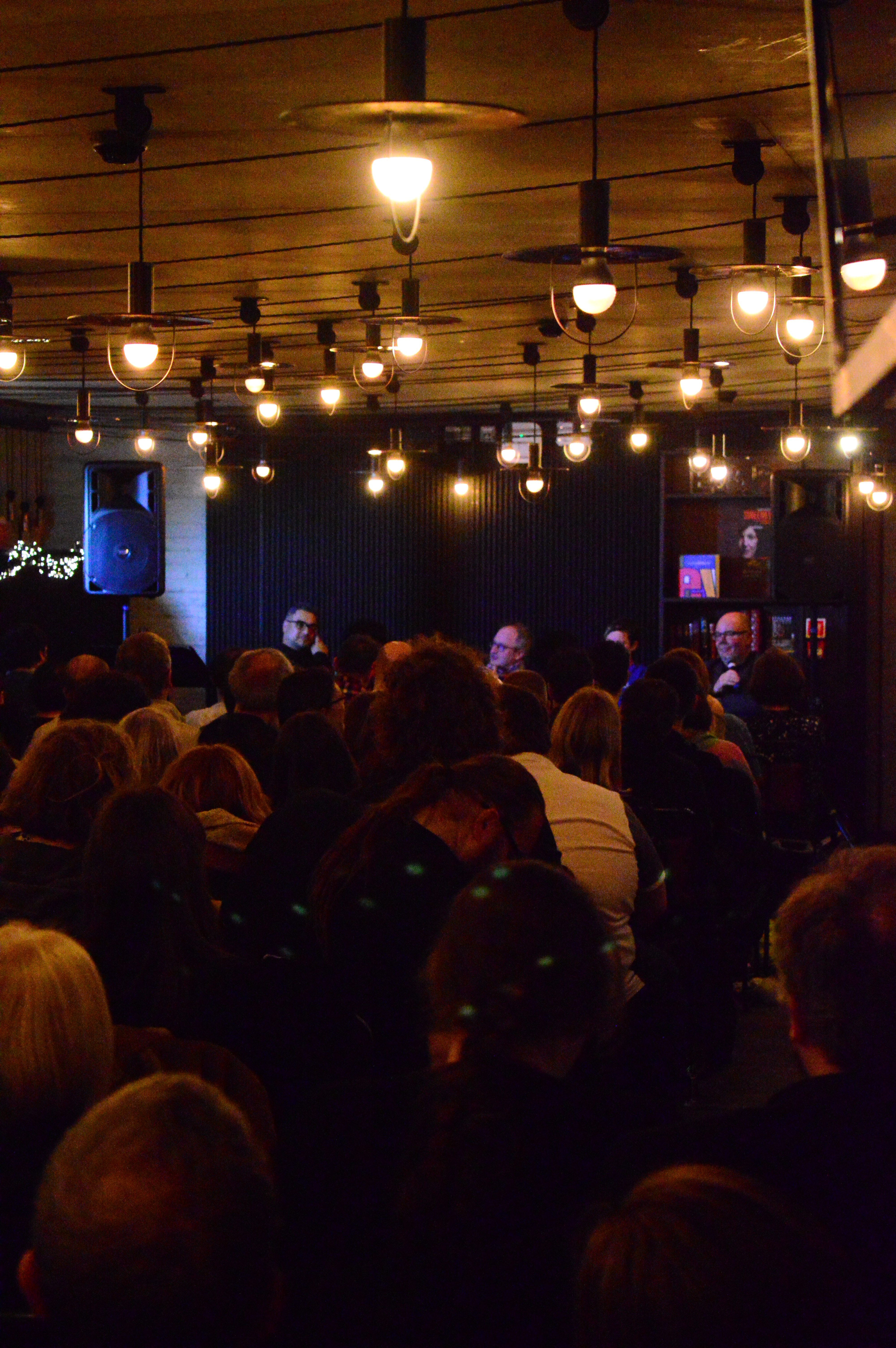
Also, as Josie suggested, offense for the sake of offense is plain laziness. It is – as her friend once told a comedian who challenged her for walking out of his pointlessly offensive gig – ‘just boring.’ It takes no personal sacrifice, no jot of originality, to punch downwards. And it is this idea that runs throughout the evening’s conversation. Comedy should, in Nikesh’s words, punch upwards, and question the ways in which we think about the world around us and probe our perspectives on what it means to belong.
Earlier this March, a group of visiting students from Ohio State University visited the TIDE project for a session exploring our work. We kicked off with an introduction to the project and its contexts before moving on to a conversation on our first major output, the Keywords database.

The three post-doctoral researchers discussed their work in writing the keyword entries, from travelling to Zafra and Seville, deciding on the best sweets sold by Spanish nuns, and taking inspiration from Emily Wilson’s translation of The Odyssey, reflecting the variety and scope of the work as well as its occasionally unexpected research tangents. Some of the students had chosen their own keywords and prepared presentations, which were delivered with great aplomb and were followed by spirited question and answer sessions.

Next, we moved to the key activity of the session: hacking Keywords. The students split into groups and discussed ideas for potential projects built around entries in the Keywords database. Taking inspiration from the work done by the TIDE visiting writers, they were free to come up with anything for their own keyword inspired projects.

The four groups each gave a presentation on their idea, varying from an informative campaign on modern piracy, playing on the ideas and perceptions of early modern piracy; artwork exploring the nature of ‘home’ and migration in the United States; and a project focusing on protest through the language of Keyword entries and modern-day Black Lives Matter protests.
The groups marked each other out of ten, leading to some extremely heated debates. After a draw for the top place the TIDE team stepped in, resolving the tie and crowning the winners with a box of Jaffa cakes before posing outside for a photo in the very authentic Liverpool wind!
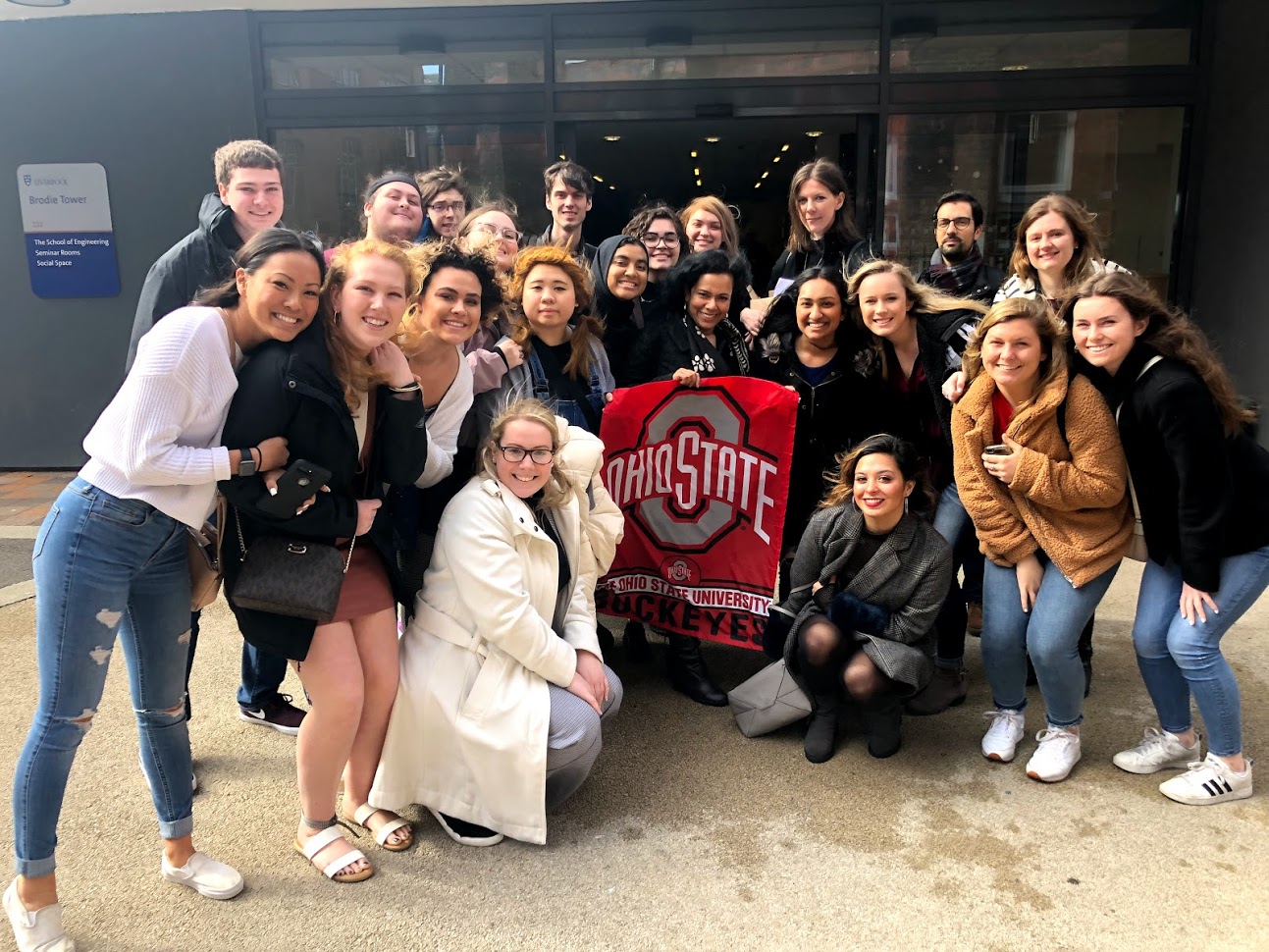
Like my early modern counterparts, I am drawn to patterns. I find pleasure in resonance and recurring motifs, in words and ideas that weave in and out of the everyday and acquire new associations and layers of significance. So as I sat eating chocolate-dipped figs in the rural Spanish town of Zafra last October, in the courtyard of what had once been the residence of a former lady-in-waiting at Mary I’s court, Jane Dormer, I recalled those Protestant libels that denounced the seductions of Catholic Spain in sugared, palpable terms: the dazzling objects of the Counter-Reformation were ‘the candied baits of Jesuits’, inducing individuals to consume ‘the poisoned fig of Spain’. Surrounding by vaulting arches and dramatic marble statues, I, for one, welcomed the poison.
Wax and wooden figures, silver and gold frames, jewelled crosses, flower garlands, a death’s head affixed to a rosary: Dormer’s Catholic tastes were apparent in the things she wore and collected, as in the large-scale building projects she commissioned during the fifty years she spent in Spain. In Zafra, it is still possible to walk through the built environment that Dormer and her kinswoman Margaret Harrington envisaged and helped create when they filled Zafra with putti and sombre paintings, reliquaries, brick archways, crosses and bells. These objects speak to Dormer and Harrington’s devotion to sanctity as well as to their politics and social status. Our next Gate of Access series probes Anglo-Spanish transculturality through female architectural patronage, diplomacy, and collecting.
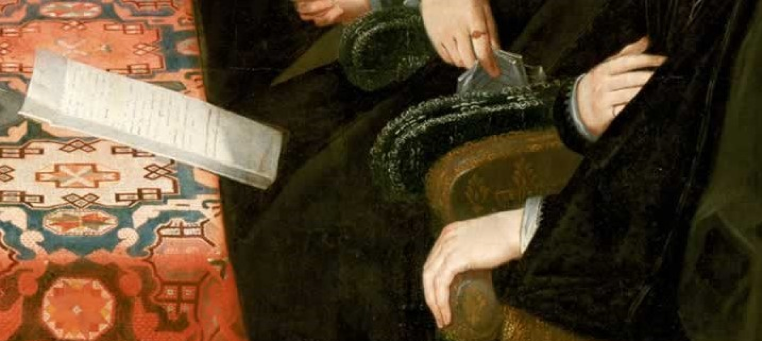
The Somerset House Conference painting at the National Portrait Gallery is often used to discuss Anglo-Spanish relations in early modern England. Spanish and English statesmen sit around the council table, circulating notes and reaching terms of diplomatic agreement: men tasked with ending war, the room enlivened by rich furnishings indicative of access to Mediterranean and eastern trade. Beyond the council chamber, however, women were also involved in Anglo-Spanish exchanges that related to both their religious belief and political affiliations. Jane Dormer’s life (1538 – 1612) spanned the reigns of Edward VI, Mary I, Elizabeth I, and part of James I’s. An unswerving Catholic, Dormer enjoyed Mary I’s favour as a lady-in-waiting until she married Philip II’s Spanish ambassador, the Duke of Feria. As Duchess of Feria, Dormer became a grandee, one of the highest-ranking members of the Spanish nobility. When the Duke died in 1571, Dormer did not return to England, but managed the Feria household in Madrid and oversaw the education of her son, Lorenzo. When Lorenzo came of age and married in 1577, Dormer continued to foster an international Catholic household, where she met and corresponded with Catholics from Europe and the British Isles. She wrote a letter to James before he became king of England, advising him on why the realm should return to Catholicism, and corresponded with other members of the English nobility on Catholic activity in Europe, negotiating the release of prisoners and providing intelligence on the status of European armies. Having travelled with Dormer’s retinue to Spain in 1599, Harrington remained in Dormer’s household until she married Don Benito de Cisneros in 1588. When she lost both her children and her husband, she began her project to found the convent of Santa Marina, which Dormer continued when Harrington died in 1601.
Zafra is still dominated by the buildings whose construction Dormer and Harrington helped oversee. This includes the Santa Clara convent, the Parroquia de la Candelaria, and the iglesia conventual of Santa Marina. The large brick structure of Santa Marina is adjacent to the Feria palace, with an oratory where tenants could hear and see the mass in ‘magnificence and devotion’. Forty nuns lived in the convent, and Dormer kept the right of patronage of the convent for herself and her heirs. Santa Clara, where Dormer was interred alongside other members of the Feria family, was about legacy as well as piety: not just ‘household stuff which descended from the duke’ but a statement of patronage, including the provision of poor relief, funding the nuns who prayed for the family, and establishing the Ferias as regional leaders.
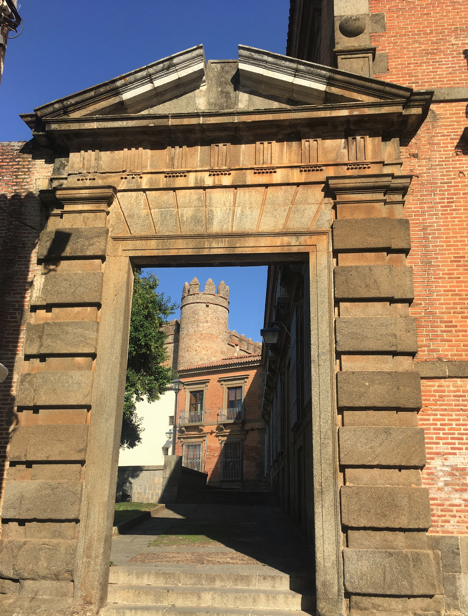
As the objects in this #gateofaccess series indicate, Dormer and Harrington displayed tastes that were influenced by the Spanish Counter-Reformation, from the churches’ structures and decor to the nature of the personal reliquaries they collected and displayed. Although observers praised Dormer for her decorum and her sombre demeanour, the influence and cosmopolitanism of the courtly elite is also evidence in surviving objects from the Feria household: the painted gold posts of her bed, large gold altarpieces and marble tombs, and a crystal vessel contained within a carved box made from a coconut. Although little is known about the box, records in Zafra’s municipal archives are a testimony to the vibrancy of Zafra as a market town with global links to Africa and the Americas. Although this project never found fruition, Jane considered Zafra to be a suitable location for establishing a Jesuit college, perhaps because of its international importance in providing a prominent meeting place for the region’s wealthy Spanish and Portuguese merchants. As a lively centre of commerce, the archives contain accounts of merchants returning from Atlantic voyages with cargo. Records include references to esclavos, or ‘blackamoor’ slaves in the households of merchants.
Dormer and Harrington’s projects shed light on devout counter-Reformation women who operated within and beyond religious spaces, from households to town squares and building sites. Using their wealth to engender change and advance Catholicism, these women secured the release of English Catholic prisoners and sold art to raise funds for armies. After her death, Dormer’s secretary Henry Clifford, to whom she bequeathed her death’s head rosary, wrote to Sir Robert Dormer in England. ‘You would say she were not only the great honour of her house’, Clifford wrote, ‘but the glory of her country.’ Clifford praised Dormer for aligning her personal sense of vocation to her commitment to Catholicism in traditional, almost hagiographical terms. Which was ‘her country’ is a little less clear.
Lauren Working
Follow our Gate of Access on Twitter @ERC_TIDE, #gateofaccess
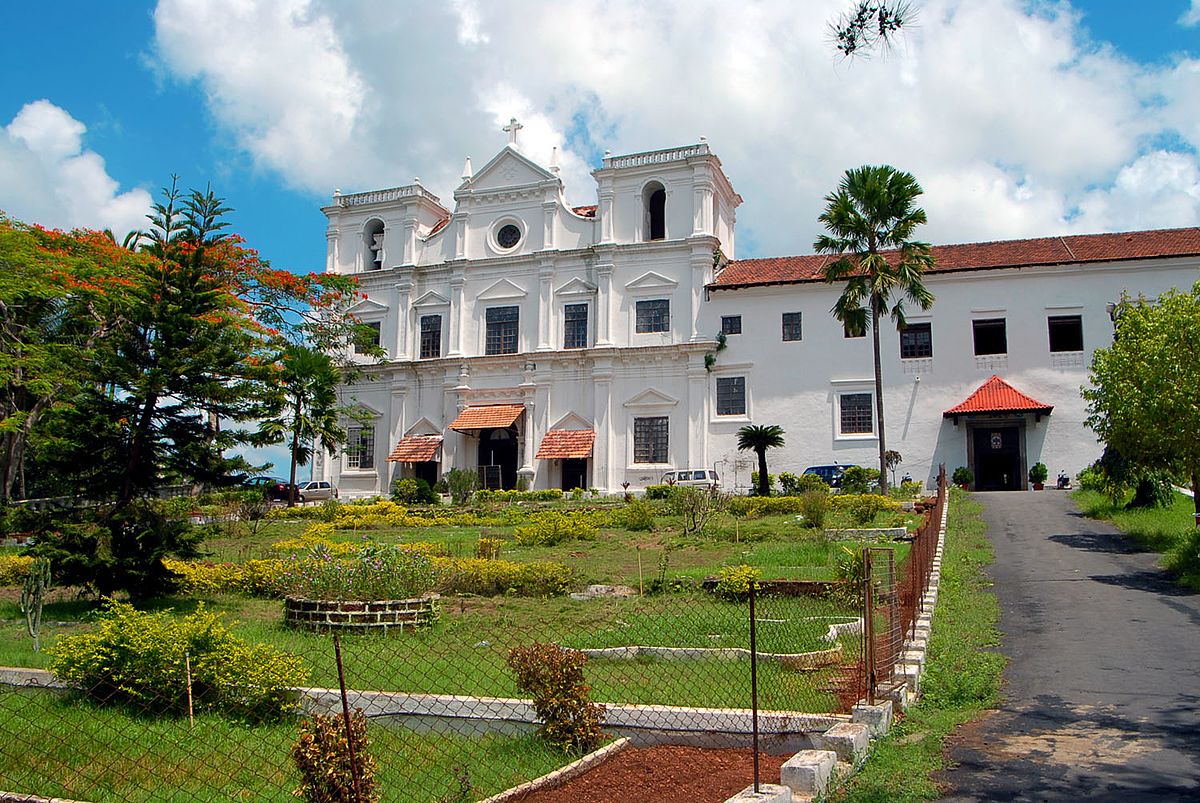
Here is a sneak peek into what we're working on, following the launch of our open access TIDE: Keywords - a set of case-studies on border-crossers in and out of England, due out next year, also as an open access publication. Read on to find out more about Thomas Stephens: English exile, Jesuit priest, Marathi poet.
On 4 April 1579, Thomas Stephens, an Englishman from Bushton, Wiltshire, embarked on a ship of the Carreira da Índia, the maritime route between Lisbon and Goa. Stephens was one of five Jesuits who sailed from Genoa to Lisbon to serve in the Jesuit missions in Asia. After a long voyage which took about seven months, the English missionary arrived in Goa on 24 October 1579. The capital of the Portuguese Estado da Índia was facing profound changes. In the early days of Portuguese presence in Goa, Afonso de Albuquerque had initiated to incorporate the local populations into the colonial apparatus by various means, like through a policy which included the promotion of mixed marriages between Portuguese men and local women of Brahman origin or of light colour converted to Christianity; the recruitment of Hindu experts and Christianised Brahmins to relevant posts in the colonial administration; and the adoption of local symbols of social and political prestige such as the palanquin and state elephants. But the death of Sebastian I of Portugal posed serious doubts about the future of the Portuguese crown and its empire, and the adoption of the directives of the Council of Trent by the Portuguese Crown led to a series of administrative reforms implemented by João III. Inspired by the Spanish experiences in Mexico and Peru, he sought to affirm the Crown’s authority in Portuguese colonial possessions such as Goa, by homogenising Goan society according to the Tridentine model. The ultimate aim was gradually to eradicate all non-Christian elements in Goan society.
Between the 1540s and the 1550s, the Portuguese authorities promoted the destruction of temples and mosques. The land revenues of the Hindu temples were transferred to the Catholic Church. In 1567, the establishment of the Goan Inquisition and the edicts issued by the first Provincial Council of Goa confirmed the end of Albuquerque’s more tolerant policies. The aggressive policies towards the conversion of non-Christians often led to violent conflicts between the Portuguese authorities and the Hindu and Muslim communities, especially in the hinterlands of Goa, where the proximity to territories ruled by Hindu and Muslim potentates stimulated the resistance of the local populations. There were also growing tensions between the Portuguese born in Portugal, and those who were born in India, or descended from the offspring of the mixed-marriages promoted by Afonso de Albuquerque in the 1510s. Those who had converted to Catholicism were becoming increasingly frustrated with the social and political privileges enjoyed by white Portuguese born in Europe.
It was in this fraught climate of racial, political, and religious tension that Thomas Stephens arrived, and after a few years at the College of St. Paul, in 1583, he was sent to the Salsete mission, one of the most difficult mission fields of the Jesuits in the Estado da Índia. Salsete was one of the provinces most affected by the destruction of temples and mosques promoted by the Portuguese authorities. It was also one of the preferred targets of the raids made by the troops of the Sultan of Bijapur, which often received the open support of members of the local Hindu and Muslim communities. Immediately after Stephens’ arrival in Salsete, a group of Jesuit missionaries was killed by a Hindu uprising in the village of Cuncolim. Stephens was deeply affected by the massacre. In one letter to his brother, Richard Stephens, he presents Salsete as a land inhabited by ‘a handful of Christians’ surrounded by ‘pagans’ described as ‘of a warlike character‘ and who were ‘doing great harm to the Christian republic, partly by their open attacks and partly by their conspiracies’.
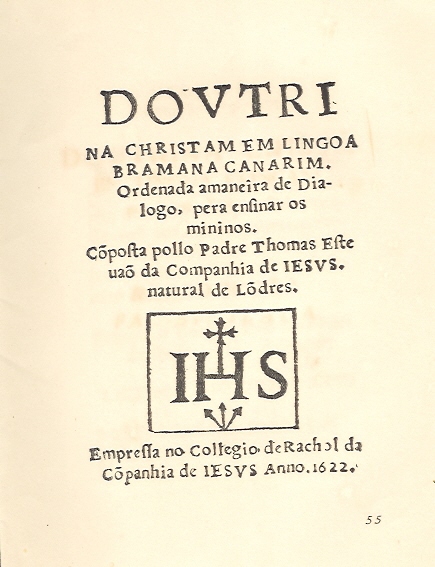
The 1583 massacre exposed the failure and limitations of the uniformising policies of the Estado da Índia in Salsete. After an initial moment of increasing repression in the region instigated by the Portuguese authorities, the Jesuits implemented a new strategy which sought to manipulate local cultural elements to ensure the conversion of the populations of Salsete. Stephens was one of the instigators of this strategy. The few surviving letters written by him reveal a special concern in promoting the use of local languages in the literature and religious ceremonies of the Salsete Catholics. In one letter to Claudio Acquaviva, the General of the Society of Jesus, Stephens stressed that the ‘best remedy’ for Salsete was to ensure ‘that everyone posted in the parishes should learn the language’.
Stephens was particularly interested in creating ‘a catechism [doutrina] written in the local language from which the children learn by heart’. This catechism, which was probably one of the inspirations of the Kristapurana, was highly appreciated by both missionaries and converts, especially children. As he told Acquaviva, the success of the catechism was usually seen ‘during confessions, [when] one realises that the little knowledge they have from this catechism is very fruitful’. These encouraging results of the experiments with the ‘catechism’ led Stephens in 1608 to ask Acquaviva to give permission and financial support to publish his works in Marathi and Konkani. The approval of the General of the Society of Jesus was absolutely necessary to validate a work which, by being written in a largely unknown non-European language, could pose the risk of suggesting an erroneous terminology for the doctrinal principles of the Catholic Church, but Stephens was also concerned about the expense that would be necessary to print his works in Marathi, as it would mean actually casting new metal type for the characters. As he explained to Acquaviva, ‘it seemed impossible to make enough matrixes for six-hundred characters which are mostly syllables and not letters, as our 24 in Europe’. In 1616, the Kristapurana was finally printed, although in Roman characters, since the Mission declined to fund the making of typeface in the Indian, Devnagri script traditionally used for Marathi.
Stephens’ work meant to contribute both to the conversion of the heathen populations as well as to the intellectual preparation of the Jesuit missionaries. It was work designed to transmit Catholic doctrine in a way that fitted into the literary traditions of the cultural world of Salsette and address individuals to whom Christianity was a total novelty. The Kristapurana was thus the result of a prolonged dialogue between Stephens and the local populations. The cultural differences that separated a missionary like Thomas Stephens and the Salsete converts led both to seek creative ways to integrate local elements that did not clashed with Catholic doctrine and practices.
The accommodationist creativity behind the production Kristapurana is also deeply related to the biography of his author. Thomas Stephens adopted a Portuguese version of his name – Tomás Estevão, and sometimes Tomás Esteves – a decision that helped his daily life, as well as it suggest a willingness to demonstrate his loyalty to the Portuguese Crown. Thomas Stephens not only became Tomás Estevão, as most of his correspondence was written in Portuguese, although he could write in Latin and Italian, two languages commonly used by Jesuits from outside Iberia and Italy. In his letters, Stephens often chose terms used by Portuguese nationals in colonial territories to refer their country and monarch such as reino (realm) or el-rei (His Majesty). The adoption of a Portuguese version of his name could be interpreted as a pragmatic decision to facilitate his daily life (many foreigners usually did the same in Iberia) or as a symbolic demonstration of loyalty to the Portuguese Crown, but it was also a gesture that suggest both an ‘accomodationist’ approach and an intention to develop a persona based on ‘inbetweeness’.
Historical evidence, however, suggests that Stephens often used his ‘inbetweeness’ to serve as a mediator between the Portuguese authorities and the English. In 1583, a group of four Englishmen - Ralph Fitch, John Newberry, William Leeds and John Storey – were arrested at the Portuguese port of Hormuz and sent to Goa. Stephens and a Flemish Jesuit, Marcos Maecht, sought to mediate their release with the Portuguese viceroy. In spite of their sudden escape, Ralph Fitch mentioned in a letter written from Goa in 1584 that if Stephens and Maecth ‘had not stuck to us, if we had escaped with our lives yet we had a long imprisonment’. The Dutch traveler, Jan Huyghen van Linschoten, who was at the time in Goa, had a different opinion and believed that the Stephens’ and Maecht’s mediation was nothing more than (for Linschoten) a typically devious Jesuit scheme to gain money from the Englishmen.
If Linschoten had doubts about the real intentions of Stephens, depicting him as a Jesuit schemer who was ready to explore his countrymen, the Portuguese authorities also resented his readiness to help foreigners from hostile countries. After Stephens’ death, Viceroy Fernão de Albuquerque evoked the experiences of the English Jesuit in a letter to Philip II of Portugal (III of Spain), where he recommended that the Crown should ban the presence of foreigners in the Estado da Índia, mentioning Thomas Stephens, ‘an English clergyman of great sanctity’, who one hour before he passed away, ‘said that the Portuguese were too lenient for allowing foreigners in this State’. Fernão de Albuquerque’s anecdote about Thomas Stephens appeared to suggest that the English Jesuit was repented for his role as a mediator between the Portuguese authorities and foreigners from enemy countries, and for his role in facilitating that non-Portuguese influx, perhaps even for the inclusion of the letter he wrote to his father, which was widely circulated in England through its inclusion in Richard Hakluyt’s monumental collection of early English travel accounts, The Principal Navigations, Voyages, Traffiques and Discoueries of the English Nation (1599-1600). This supposed regret was used by the viceroy to suggest that even foreigners who were loyal to the Portuguese, like Thomas Stephens, could not be fully trusted because they were unable to control the actions of their interlocutors in other countries.
João Vicente Melo
Works Cited
J.L. Saldanha, The Christian Purāṇa (Mangalore, 1907)
“Primeiro Concílio Provincial de Goa, 1567” in Documentos para história das missões do padroado português no Oriente, vol. X ed. António da Silva (Lisboa: Agência Geral do Ultramar, 1953), pp. 486-800
Archivum Romanum Societatis Iesu (ARSI), Goa 14-I, Thomas Stephens to Claudio Acquaviva, 18 November 1594
ARSI, Goa 15, Thomas Stephens to Claudio Acquaviva, 6 December 1601
ARSI, Goa 16, Thomas Stephens to Claudio Acquaviva, 5 December 1608
Ian Huyghen van Linschoten, Iohn Huighen van Linschoten. his discours of voyages into ye Easte & West Indies Deuided into foure books (London, 1598; STC (2nd ed.) / 15691)
Doc. 1, Viceroy Fernão de Albuquerque to Philip III, 14 February 1620, in J.H. Cunha Rivara, Ensaio Histórico de Língua Concani (Nova Goa: Imprensa Nacional, 1858), p. 204
The Exploration Session ‘Digital Humanities’ (Dr Edmond Smith, U. of Kent) offered an overview of key methodologies in this rapidly developing field as well as vibrant discussions about the future. We did this through the conversations within the session, as well as using an online voting system, through which participants were invited to share their own interests in the subject. Most were new to field, so the session offered a basic introduction to network analysis and a hands-on demonstration, which showed how interpretive and visualisation tools can be used, how they work, and what the results look like. After the demonstration, asked how they might use digital humanities in the future, the answer was clear – an enthusiastic confirmation that network analysis was on their horizons.
In addition to practical guidance about utilising digital humanities methodologies, participants discussed the ways in which interdisciplinary ideas could shape the future of humanities research. As the online voting system showed us in a real-time charting of votes by those attending the session, among the group, 42% hoped to use digital humanities as a means of interpreting or presenting large data-sets while 58% saw the field as most useful for integrating new ways of thinking into humanities research. Ideas drawn from social sciences, economics, biology and even neuroscience were presented as avenues for collaboration and development. Questions were raised about the name of the discipline, how we might develop new means of valuing multi-format publications, and even the suggestion of allowing non-text based doctoral dissertations. Indeed, it was mooted that in 20 or 30 years it might be expected that all humanities scholars will be able to interpret networks and GIS mapping as easily as bar charts and spreadsheets today.
Edmond Smith
The initial idea behind the exploration session ‘New Directions in the Cultural History of Travel, Mobility, and Transculturality’ organized by Dr Eva Johanna Holmberg (Helsinki & QMUL) and including the discussants Dr Liesbeth Corens (QMUL), Dr John Gallagher (Leeds), and Dr Mark Williams (Cardiff) was to discuss recent developments in, some long-term frustrations with, and suggestions for new avenues in a research field that could be broadly termed ‘cultural history of travel and mobility’. To put it polemically, we wanted to make people think beyond elite men gallivanting in their educational pursuits or collecting art on the Grand Tour and include not just the vast amounts of people who made the Grand Tour possible by their labour but also those who ventured to the world of travel outside its framework.
New emergent research themes and interests could include not just the different modes and contexts of mobility but also take into account a wider range of experiences, including the darker sides of mobility, the restrictions put on it, and the constant flow between travel and return, looking at stasis and mobility in conjunction. This, we hope would centre the experiences, encounters and practices of a greater variety of travellers from different genders, social backgrounds and motivations, and encourage us all to explore travel and mobility exploring richer archives and equipped with richer contextual lenses. Approached in this way, the history of travel would include mobile people whose trajectories were far from the voluntary, able-bodied, or linear of its usual suspects.
In the discussion at the conference we called for more research on travels that ‘went wrong’ or prompted unexpected reactions ranging from the emotional pleas from reluctant peregrinants to those who encountered grief, illness, and conflict whilst on the move. The session participants and the discussions that followed our brief outlining of potential themes prompted everyone to think of new ways to explore travel, including its many ‘afterlives’ and impact on societies, including the shaping part played by non-human animals and material cultures.
Eva Johanna Holmberg, Liesbeth Corens, John Gallagher and Mark Williams
‘Wither would you go? What country… should give you harbour? Go you to France or Flanders... Nay, anywhere that not adheres to England,/Why, you must needs be strangers…[spurned] like dogs, and like as if that God/Owed not nor made not you.’ These words are possibly the only surviving lines written in Shakespeare’s own hand in the play, the Book of Sir Thomas More, voiced by the character of More as he delivers a passionate defence of strangers and their communities to an angry crowd. The lines strike any modern reader with their uncanny relevance. Questions concerning the status of foreigners and their willingness to assimilate recur in public and academic discourse across the centuries: what does it mean to belong to a city, state or nation? Can one be a citizen of everywhere or nowhere? How has the migration of non-English groups shaped concepts of a national identity and heritage?
This July, in the uncharacteristic sweltering heat of the hottest summer in recent memory, we were fortunate enough to bring together a large, international, multi-disciplinary group of both early career researchers and established scholars to explore those issues.. ‘On Belonging: English Conceptions of Migration and Transculturality, 1550-1700’ took place at the University of Liverpool’s London campus between 26 and 28 July 2018. It sought interdisciplinary perspectives on early modern transculturality with a wide array of panels and speakers addressing a variety of topics. Over the course of these three days, scholars from institutions across the UK, Europe, America, and India examined transcultural figures and contemporary conceptual frameworks to probe the interconnected histories of local and global migration.

The first day of the conference focused on examining ideas of key concepts and frameworks, kicking off with a panel on ‘Immigrant Cultures and Attitudes’ or – as it was termed on twitter – lives in motion. Raingard Esser opened the discussion by taking attendees through immigrant cultures and cultural integration in early modern England, followed by Katy Gibbons examining subjects of the English crown rendered strangers through religious policy and the framework of exile. Finally, Cheryl Butler spoke on changing attitudes to immigration in Tudor Southampton. Our second panel focused on ‘Migration, Identity and Rights’, with Ruth Canning looking at Old English communities in Ireland c.1580 – 1603, Idolina Hernandez on English identity and the naturalisation of refugees within the American colonies, and Justin Meggitt on the Barbary origins of Atlantic abolitionism, with particular focus on Quaker anti-slavery discourses.
Attendees were then given a difficult choice between a pair of exploration sessions. ‘New Directions in the Cultural History of Travel, Mobility and Transculturality’ was led by Liesbeth Corens, John Gallagher, Eva Joanna Holmberg and Mark Williams, and explored new directions in the broad field of the cultural history of travel. The aim of the session was to expand consideration of early modern travellers beyond elite men on ‘Grand Tour’ style trips to include those people who travelled outside such a framework, whose trajectories were far from the voluntary, able-bodied and linear narratives we expect. Discussion focused on the ways in which new research could centre the experiences, encounters and practices of a greater variety of travellers and encourage scholars to explore travel and mobility with richer contextual lenses. The alternative session, ‘Digital Humanities: Practical Approaches and their Application in Humanities scholarship’ led by Edmond Smith, sought to introduce attendees to network analysis and visualisation with innovative mobile voting and practical demonstrations of networks created from early modern archival data. Participants explored the programmes used to create such networks and discussed the ways in which the use of such digital skills might be integral to scholars of the future, with many coming up with innovative uses for such techniques in their own research. Both of these sessions were well received, and their organisers are greatly commended on producing two such informative and engaging panels. Short reports on the sessions by the organisers will be posted on our blog later this week.
After continuing the debates and discussions through lunch, we moved into the third panel: ‘Literary Traces’ with Sarah Knight on Fulke Greville’s Ottoman world in ‘Mustapha’ and the connections between historiography and drama, Ladan Niayesh asking whether the subaltern can speak poetry, illuminating weaving and fabric puns from George Puttenham’s pattern poems, and Edward Holberton on Edward Taylor’s migration from Leicestershire to Massachusetts through his dialogues with George Herbert. Our last panel of the day established the final key concepts: ‘Language and Translation’, with Jane Stevenson on the Latinate culture of Britain and alternate canons, Emilie Murphy on language acquisition in English convents in exile, and John Gallagher on urban multilingualism and London’s stranger churches. The day concluded with a public lecture by Dame Marina Warner, on ‘Dido the Migrant Queen’, delivered to a packed room full of conference attendees and the general public.

The second day moved to looking at dialogues between transcultural agents and go-betweens, beginning with a panel on ‘Merchants and Sailors’: Claire Jowitt taking early modern ships as transcultural agents, Richard Blakemore on the communal networks of British sailors in Dutch service and Edmond Smith on the ways corporations defined and regulated English identity overseas. The next panel focused on ‘Individual agents’ with Amrita Sen communicating by Skype from India to deliver a paper on the East India Company and women travellers in the sixteenth century, Eva Joanna Holmberg on expressions of grief in Fynes Moryson’s Itinerary, and Natalya Din-Kariuki on the unique epistemological space of travelling preachers such as Edward Terry. We were also fortunate to have Imtiaz Habib deliver his last keynote lecture, a superb meditation on ‘The Unspeakability of Black Belonging,’ exploring the possibilities and challenges of giving voice to non-European historical actors, and asking how best to critically treat a class of historical subjects who inhabit the interstices of transculturality.

The first afternoon session had a new format – a set of rapid-fire short papers in our Early Career Researchers Showcase. Nailya Shamgunova spoke on the emotional ecologies of early modern England and the Ottoman Empire, Emily Betz on the continental perception of English melancholy, Alison Barker on a travelling Florentine artist’s impact on English devotion through depictions of St George, and Annalise Wolf on chromatics in The Masque of Blackness. Our final panel of the day, ‘Entertainment and Sociability’, swung from Christopher Kissane discussing fish, fasting and foreigners in early modern England, with an abundance of fishy puns, to Angela McShane on the material culture of English drinking rituals.
The final day of the conference focused on imaginative or creative responses to transculturality and new social habits, and began with a panel on ‘Minority Communities’. Gerald Maclean examined British travellers and Kurds in Kurdistan, Ariel Hessayon returned to England for the crypto-Jewish community in Cromwellian England, with particular focus on Antonio Carvajal, and Scott McDermott finished by exploring the community of wandering Jacobites and the ideology of Puritan mobility to, from and within seventeenth century New England. Our final keynote was delivered by Beverly Lemire, looking at the increased presence of non-European slaves and servants and their experiences and effects on domestic intimacy in English households both home and abroad. Next was a panel on ‘Art and Material Culture’, with Karen Hearn looking at the career of Cornelius Johnson, an artist born within the Netherlandish community in London, and Kathrin Wagner taking Wenceslaus Hollar, a Czech etcher who shaped our lasting perception of early modern London. The final panel looked at ‘Cultural Resonances’, with Barbara Ravelhofer examining the luxury debate and court culture on the eve of the civil war and Alana Mailes on the ‘musica transalpina’: the sounds of the English embassy in Venice c.1600-1630.

‘On Belonging’ concluded with the poet Sarah Howe, author of Loop of Jade (2015) and TIDE’s writer-in-residence for 2017/18, presenting her work with TIDE and the World Museum in Liverpool. Howe spoke about the ‘imagination undergirded by research’ that forms the core of her work with the World Museum, and the hope that her work will prompt museum goers to imaginatively respond to the collections through poetry, enacting the same process called for by Shakespeare’s More: imagining the lives of others from a new perspective. Howe read from her poem, ‘(k) Drawn with a very fine camel hair brush’ and encouraged the attendees to write their own responsive poem to a list of prompts. Those poems, as well as live tweeting throughout the conference, can be accessed through the hastag ‘#onbelonging’ on twitter.
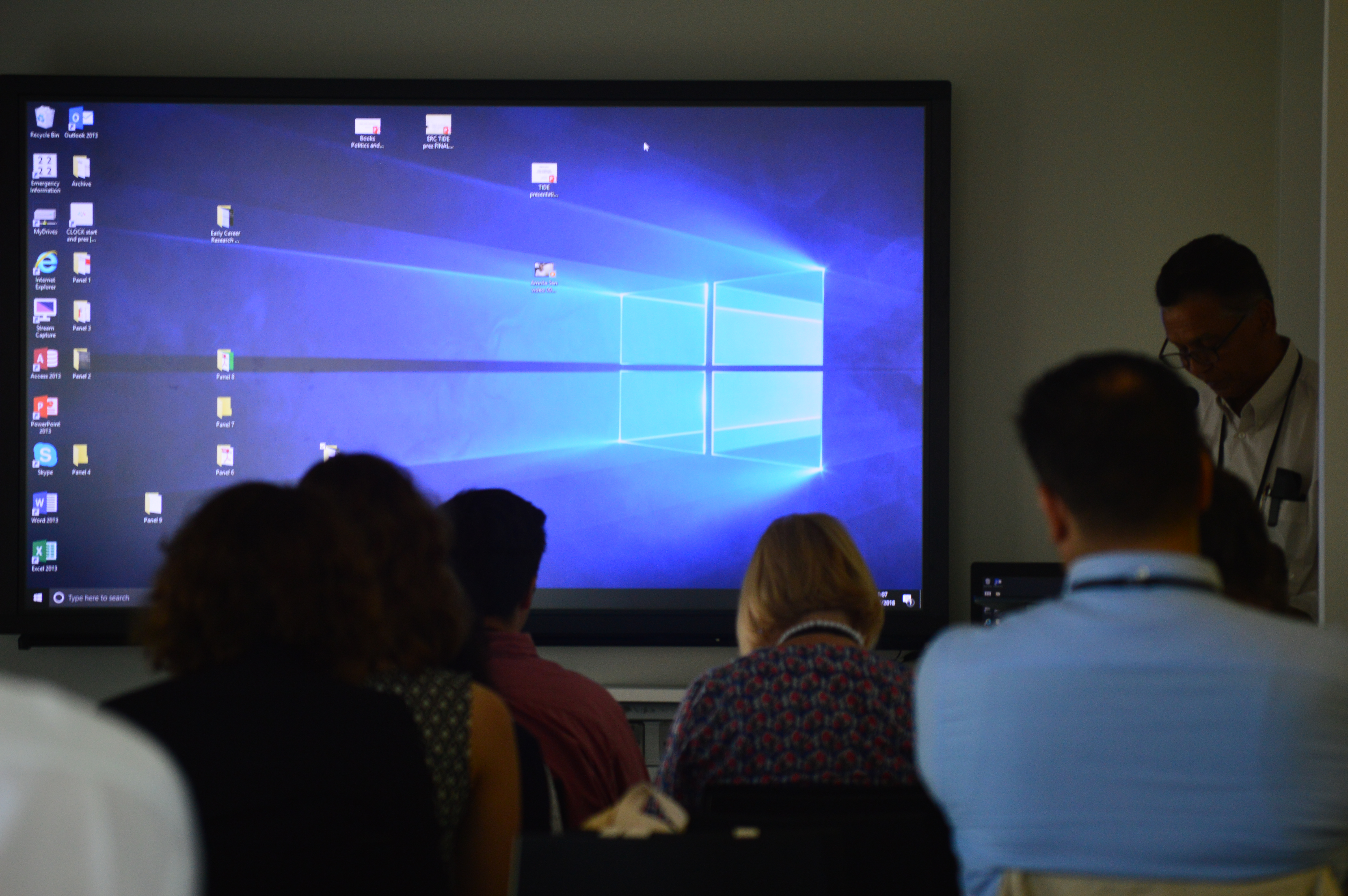
‘On Belonging’ represents the end of TIDE’s first two years. It is rare for early modern research to feel so topically relevant, and many of the attendees spoke to this theme, acknowledging the modern resonances of their research and its – at times – challenging immediacy. It is our hope that the research emerging from this conference will contribute to public engagement, education and policy initiatives about diversity, as well as shedding light on current debates on human movement. ‘On Belonging’ fostered relationships between scholars, both established and early career, and it is our hope that in connecting scholars from across the globe through a shared interest in examining the voices of people inhabiting transcultural spaces, TIDE will serve to create its own transnational and transcultural community to continue querying the established canon.
Even as this conference report was in the making, news reached us of the sudden death of Imtiaz Habib on 28 August 2018. Imtiaz's plenary lecture at 'On Belonging' was wide-ranging in its scholarship, passionate, and humane, representative of a lifetime of scholarship that had helped to shape the field. He will be deeply missed. This report is dedicated to his memory, but we want to end this post with his own words, poignant and hopeful, written shortly before his death, to an email group of scholars on the subject of early modern race studies:
As I sit here in my hotel room in London waiting to fly back home to the U.S. (a home taken over by thugs at the moment), reading this exciting conversation (appropriately, after an early modern “Belonging” conference!) engulfs me in bittersweet feelings—bitter because this comes so late, in the approaching sunset of my life, sweet because of the satisfaction it conveys of the fruition of worlds and bodies of knowledge that we have struggled so long and so hard to bring about. Yet, as I muse over the happy portends that the subject of this conversation holds I am also confronted by anxieties.
On the one hand, do we want the journal to fence off our e.m. scholarship into a protected enclave where we happily talk to ourselves, busily citing each other? [...] On the other hand, should we live amongst other discursive neighborhoods [...], where lurks the danger over time of the whitening out of the urgent particularity of our conversation[...]?
The answer, my own clumsy thoughts hint, is to achieve a border condition, a vibrantly mixed early modern dockside area, where discursive sailors from many ideological ports disembark (or should I say unload?) but all are absorbed into a stateless zone that is more many hued than single colored, and which gradually percolates into the towns and lands beyond. [...] This will take careful management and (I hesitate to say this, for want of a more elegant phrase) gentle intellectual guidance, whose integrity will be difficult to maintain in subsequent decades. That guidance will also have to be in terms of steering participants towards analytical rather than emotional output, an easy enough drift to be caught in.
So, a brave new world indeed, but exhilarating nonetheless.

'My Best Beloved Churchyard', wrote Charles Dickens of St Olave's Hart Street in The Uncommercial Traveller. The plaque outside the parish church on Seething Lane in London's financial district offers a smorgasbord of tempting historical ties. None other than 'MOTHER GOOSE' was interred here in September 1586, and three hundred and sixty-five victims of the Great Plague of 1665 were recorded in the burial register. Samuel Pepys Esq., prodigious diarist and cheese enthusiast, was 'Buried in a vault under Ye Communion Table'. Traces of the parish's early modern life surround the church; opposite sits Walsingham house, the family home of Queen Elizabeth's Lord Secretary. Once the headquarters the Tudor State's vast intelligence network, it's currently undergoing a transformation into much needed office space. To the immediate north of Walsingham House sits the Crutched Friars pub, a happy memorial to the Carmelite monastery that stood along the eponymous street, dissolved under Henry and destroyed by the Fire.
Unobserved, but deserving of attention, is the fate of the repurposed monastery buildings between these two events. It was in the hall of the Crutched Friars that the Venetian Jacob Verzelini established a furnace in the early 1570s for the production of a luxury commodity that captured the imagination and loosened the purse strings of England's wealthy elite. Produced using silica, manganese, and soda plant-ash from the Levant, Venetian glass (cristallo) was renowned across Europe for its exceptional transparency, and it appears in English royal and aristocratic household inventories from across the Tudor period. Such was the value of this crystal that when Thomas Howard, 4th Duke of Norfolk was sentenced to death in 1571 for his involvement in the Ridolfi Plot, he bequeathed Sir Nicholas Bacon, Sir Walter Mildmay, and Robert Dudley, Earl of Leicester a single piece of crystal glassware each.
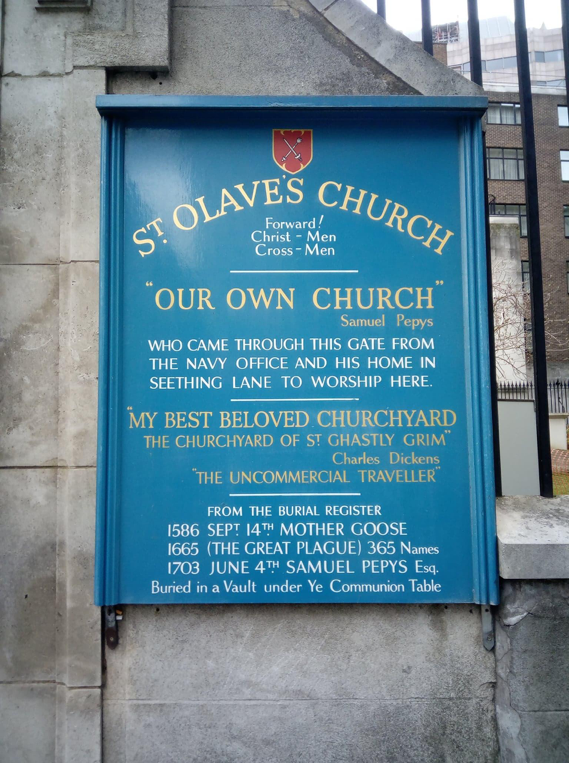
The production of cristallo in England dates back to 1549, when Edward VI invited eight Muranese glassmakers and several Dutchman to establish a furnace near Belsize park in an effort to internalise manufacturing. The emigration of glassworkers had long been forbade by the Venetian authorities, who, on receipt of the knowledge of this trade infringement, demanded their return. In an effort to broker an agreement, the workers were imprisoned in the Tower, where they remained until 1551. All but two returned across the Channel: Guiseppe Casselari and the Dutchman Thomas Cavato. Internal production abated for a while, and in 1558, William Harrison marvelled in his Description of England at the currency of 'Venice glasses' among the rich and powerful, who, as 'is the nature of man generallie [...] most coveteth things difficult to be attained'. Many became 'rich onlie with their new trade unto Murana', writes Harrison, although records do not indicate extensive importing, at least among the English merchants. Just one instance is recorded in the 1567/8 book of imports for London: the English merchant Nicholas Spering, a purveyor of luxury European commodities, imported ’35 doz. crystall glasses’ amongst other items from Antwerp in a vessel carrying the cargoes of sixty-seven other individuals. They may have come in on the galleys of resident Venetians or Genoese, who despite the gradual decline of Italian control of English foreign trade during the sixteenth-century, still dominated Venetian imports. Yet only one fragmented port book survives for the merchant strangers, who kept separate records of ships and cargoes to the native English, and it is too incomplete to garner a thorough analysis.
Yet the English market for glassware was lucrative enough to encourage immigration from the continent. Before coming to London in 1567, John Carré, a native of Arras, France, was a manufacturer of window-glass in Antwerp. He possessed a shrewd grasp of the market and once settled in England wasted no time in requesting a patent from the Privy Council for the production of both window-glass and Venetian-style crystal for drinking vessels. The application chimed with assurances of locally-sourced materials; everything was to be found within the realm, bar the soda, which must be imported from Spain. He had even already erected a fit for purpose furnace in the City by leave of the Lord Mayor. A monopoly over window-glass was granted, with the proviso that he also trains Englishmen in the skill so that upon expiration, production can continue under native workmen. A monopoly over Venetian glassware, however, was denied.
Carré continued in his cristallo venture anyway, and it appears that by 1570, the furnace was up and running. He may have used his Antwerp connections to bring in the Venetian Ogniabene Luteri to work alongside the veteran Casselari; by December that year, another seven Muranese workmen resided with Carré in the parish of St Benet Fink, Broad Street Ward: Vincent Figlio, Dominic Casselari (potentially a relative of Guiseppe), Marco Guardo, Lawrence Farlonger, Francis Gilio, Biasio Brandarmin (or Brandium), and John Morato. It has long been asserted that Carre was the first proprietor of the glasshouse at the Crutched Friars, although this is uncertain. The fact that both he and his workers lived in St Benet Fink, as opposed to St Olave’s in Hart Street, may suggest that the furnace Carré presumptuously built was located in the north of the City. He also relocated to the parish sometime in the same year as his license application, having previously resided further south near the river in the parish of St Swithen’s, Walbrook Ward. This may be coincidence, but it is worth noting that other Venetian glassblowers connected to the Frenchman's venture also occupied rooms in the parish.
Carré died in 1572. Responsibility for the glasshouse was formally charged to his brother-in-law Peter Campe and his son John Baptist, who were instructed to ‘accomplisht the contract’ made between the dying glassmaker and ‘the Italyans’. Although John Baptist would later operate a furnace in Surrey, it appears that neither party continued to produce glass within the capital. The opportunity was thus presented to the savvy Verzelini to invest in the lucrative business. He had left Venice for Antwerp in the 1550s, where his brother Nicholas was possibly already established in the glass business. He achieved not insubstantial success, as in September 1556 married the minor aristocrat Elizabeth Vanburen, of the House of Mace on her mother's side. Jacob and Elizabeth's movements following their marriage are unclear. Both 1565 and 1570 have been posited as a possible date for their arrival in London, although surviving records indicate that a Venetian surgeon by the name of Jacob Fraunces was a resident of St Olave's Hart Street parish in 1564, and there is reason to believe he and Verzelini are the same person. Fraunces still lived in the parish alongside his wife Elizabeth in 1567, and is found there again in May 1571, this time by the name of Jacob 'Frauncevercelyno'. By November, the alias or middle-name 'Fraunces' had been dropped, and he is found working as a broker, possibly in connection with his brother in Antwerp. He appears to have continued practising as a surgeon throughout his life, and was well-regarded in the profession. During the birth of Robert Sidney, future Earl of Leicester in November 1595, the family physician Doctor Browne took the precaution of sending for the now seventy-three-year-old 'Jacob of the glasshouse' in case of complications.
Sometime between 1572 and 1574, Verzelini had 'sette uppe within [London] one furneys and set of worke dyvers and sondrie parsonnes' in the hall of the Crutched Friars. He secured a patent over cristallo manufacturing with the same proviso as Carre: that Englishmen are trained to continue production upon expiry. For at least the next ten years, however, all those employed appear to have been Venetian. These 'parsonnes' included three of Carré’s workers, Vincent Figlio, Dominic Casselari, and Marco Guardo, who had relocated to St Olave’s Hart Street to live alongside the newly employed Venetians Zatario Brunoro, Satario Moro, Augustin Corona, Marcas Fingamo, Jerolimo Fero, and Baptista Sorte. With this new influx of workers, St Olave's Hart Street became the most concentrated area of Italian immigrants in the city. Vincenzo Guicciardini, the herring exporter, occupied rooms near the church on Seething Lane. Acerbo Velutelli, the exceptionally wealthy Lucchese merchant and close friend of Leicester, resided next door with his five servants: Hippolito, Ascania, and Scipio Velutelli, as well as the Venetian Racheo de Vitello and the Frenchman, John Vidale. Other Italian merchants, factors, and servants all lived and worked within close proximity to the glasshouse. While most of these men have left few traces, evidence of their sociability can be found both directly and indirectly in records pertaining to well-connected Italians.
During the New Year's Celebrations at court in 1577/8, the musician Marc Antonio Galliardo, of neighbouring Portsoken Ward, presented the Queen with 'a viall'; the following year, he gifted 'four Venyse glasses'. Younger members of the Italian dynasties who dominated court music during Elizabeth's reign can be found associating with glasshouse workers. In August 1581, the court musician Joseph Lupo was interrogated by the Consistory of the Italian Church in London on the activities of the silk-dyer Gasperin de Gatti of St Martin Vintry, Vintry Ward, who had been accused of consulting a ‘sorcerer’. Lupo was walking through Crutched Friars when he stopped to talk with Elizabeth Verzelini outside of the glasshouse. Verzelini informed him that de Gatti’s boiler was broken and the tincture was not taking to the material. He believed that they had been enchanted and as such had sent a servant to consult a woman in Rochester on how to lift the enchantment. In August 1585, the court musician Marc Antonio Bassano, son of Alvise, was conversing with the London weaver Valentine Wood and two of Verzelini’s men just beyond Aldgate when they he was attacked and nearly slain by a group of soldiers who took them for Spaniards.
Anti-alien sentiment was not limited to isolated acts of violence. The Crown and City were often at odds in the period over the economic freedoms to be extended to immigrants who took up residence in capital. The latter, concerned with the trade infringements on its constituent Guilds, enacted stringent measures that severely limited the retail practices of stranger craftsmen. Immigrants were prohibited from trading with anyone who was not a freeman of the City of London, a regulation that Verzelini fell afoul of in 1579 when he sold glass to a 'foreigner' from Leicester. The Crown, however, recognised the financial benefit of skilled immigrant labour, particularly that of liberal artisans who catered to the Italian cultural vogue at court. At the interjection of the Privy Council - possibly championed by Robert Dudley, the great defender of England's Italians - Verzelini's glasses were restored. Again in 1581, the Privy Council argued the glasshouse keepers case when one Sebastian Orlandini, a glassblower from Venice, infringed on Verzelini's monopoly by producing cristallo goblets in his furnace at Beckley near Rye.
On occasion, anti-alien sentiment boiled over into acts of violence or destruction of property by English workmen and competitors. Angered by the sudden requirement of to a license fee made payable to Verzelini on all Venetian glass imports, it may have been shopkeepers who started the fire that burned the furnace to the ground 4 September 1575. Fed by an adjoining storeroom containing forty thousand billets of wood, only the buildings outer stone wall prevented the blaze from spreading. Verzelini was forced to set his men working at a temporary furnace at Newgate while the Crutched Friars was rebuilt.
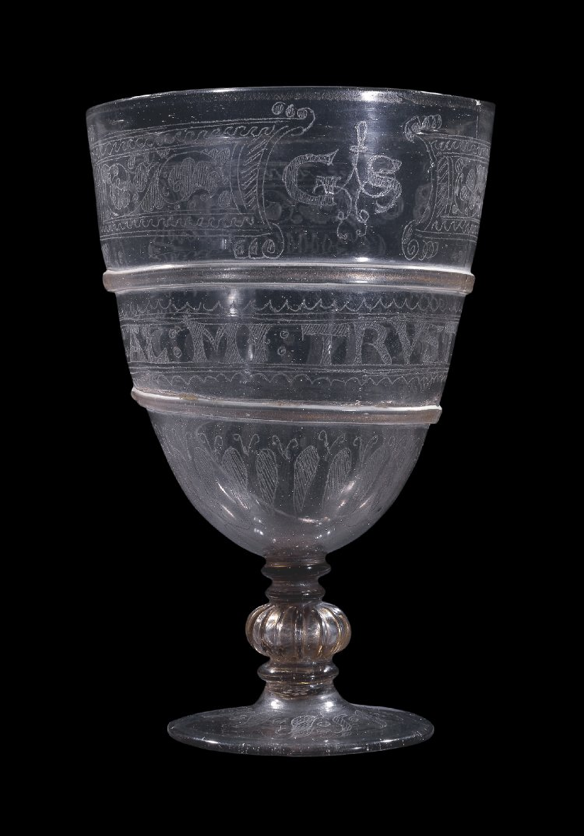
The glasshouse was reopened in 1579, and Verzelini continued to run manufacturing until his retirement in 1592. It is difficult to attribute the dozen extant glasses from the Venetian's furnace to any original owners, although two have ties to aristocratic patrons. The British Museum hold a tankard with silver-gilt lid and base (c.1574) which may have belonged to William Cecil, Lord Burleigh, and a note in an eighteenth-century hand was found in a leather case holding a crystal cup that reads: 'This glass belong'd to Queen Elizabeth, out of which she drank: It has been in Mr Vicker's family Time after mind. In 1726 I was married to Mr Vickers'.
The popularity of his glassware made Verzelini a rich man, and upon his retirement he moved to his large estate in Downe, Kent. It appears that his sons were charged with continuing the business, although the intentions of the proviso in the license that stipulated the training of native Englishmen in the art of cristallo production came to fruition within a few years. The diplomat Sir Jerome Bowes was awarded the Italian's monopoly upon its expiration in 1595 for good service on an envoy to Russia, Although a protracted legal dispute between Bowes and the Verzelini's followed, the Englishman won the suit. By the end of the year, the Crutched Friars glasshouse closed its doors for good.
Tom Roberts
On 5 September 1687, the University of Oxford offered a banquet in honour of James II at the Bodleian Library. The king seemed to have been less impressed by the pantagruelian menu of 111 hot and cold dishes prepared by the university, than with the Bodleian catalogue. After taking his seat, James asked if the library had a book translated by a Jesuit. The book in question was the Confucius Sinarum Philosophus translated by Philippe Couplet, a Flemish Jesuit who had been touring Europe since 1684 as the procurator of the Jesuit China mission. The king’s request was motivated by his recent encounter with Couplet’s Chinese assistant, Michael Shen Fuzong, who visited England between March and December 1687.
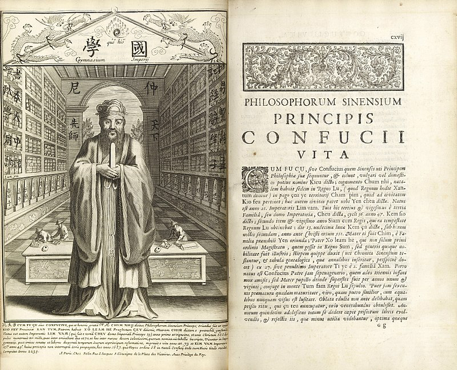
James was particularly impressed by Shen, who had become a sort of celebrity since first arriving in Europe in the winter of 1684. Immediately after landing in the Dutch port of Enkhuizen, Couplet noticed that the rare presence of a Chinese captivated the attention of Europeans, and he used his assistant as an exotic attraction. Shen was always dressed in Chinese clothing in his public appearances, and although the son of Christian parents, Couplet presented the young Chinese Jesuit novice as a convert to illustrate the apparent proselytizing success of the Jesuits, and to instigate the curiosity of crowds, ecclesiastical authorities, scholars and royal courts. In Paris, a large crowd went to Montmartre to attend a mass said by Couplet and the ‘Chinese convert’. In an audience with Louis XIV, Shen appeared in a lavish Chinese silk tunic adorned with dragons, performed a kowtow bow, ate with chopsticks and even taught the French king how to use them. Fascinated by Shen and the array of Chinese curiosities brought by Couplet, Louis XIV ordered to all fountains in Versailles to be turned on as a homage to the ‘Chinese convert’. More importantly, the meeting with the Flemish Jesuit and his assistant paved the way to Louis’ decision to send five Jesuit ‘Mathématiciens du Roi’ to Beijing in 1685.
Shen also caused a sensation in Rome in 1685. He was received by the Father General of the Society of Jesus, prominent Roman aristocrat families, and met Queen Christina of Sweden, who was particularly curious about Chinese tea habits. Pope Innocent XI was also impressed by Shen and the Chinese library that Couplet gifted to the Holy See. Despite the impact caused by the ‘Chinese convert’, the pope refused to take a final decision on the debates over the Jesuit accommodation of Chinese rites and customs, the main reason for Couplet’s tour.
Confronted with the pope’s indecision, Couplet decided to prolong his stay in Europe and continue his propaganda tour of the activities of the Jesuit missionaries stationed in China. The Flemish Jesuit and his assistant visited Florence and other cities in Northern Italy, before returning to Paris where Couplet published his Confucius Sinarum Philosophus. On 7 March 1687, Shen left Paris for London in the company of another Jesuit, the Italian Francesco-Maria Spinola, to prepare Couplet’s visit to the English capital in December. The ascension of James II raised some hopes across Catholic Europe that England would no longer be a champion of Protestantism, and Couplet believed that the English king, like his Portuguese, Spanish and French counterparts, would be interested in supporting the Jesuit overseas missions. Besides, a visit to the English royal court at the precise moment when the Confucius Sinarum Philosophus was being published in Paris could be used as an exceptional moment to publicise a work that the Jesuits believed that would support their accommodationist practices in China. As in Paris or Rome, Shen’s presence in London caused a sensation. Shortly after their arrival, James granted an audience to Shen and Spinola at St James’ Palace. Fascinated with the ‘Chinese convert’, the king instructed Sir Godfrey Kneller to paint a full length portrait of Shen to hang in the king’s private bedchamber. The painting evoked both the exoticism surrounding Shen, as well as the king’s conversion to Catholicism.
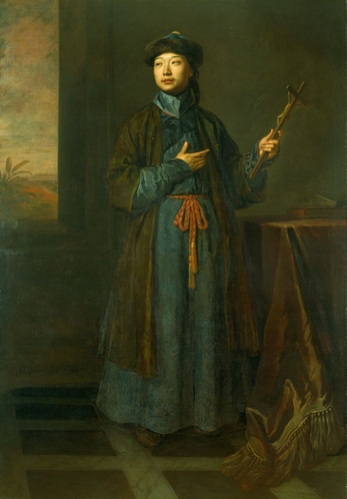
Shen’s presence in London coincided with a rising in interest in Chinese culture in England. Works such as John Webbs’ exaggerated and rather fantastical An Historical Essay Endeavoring a Probability that the Language of the Empire of China is the Primitive Language (1669), re-issued in 1678 as The Antiquity of China, and the regular translations of works from Dutch merchants and Jesuit missionaries on subjects from Chinese medicine to philosophy stimulated the interest of English scholars. After being informed about the ‘Chinese convert’, Thomas Hyde, holder of the Hebrew and Arabic chairs at Oxford and under-keeper of the Bodleian Library, invited Shen to visit Oxford and help him to catalogue and annotate the Chinese books and manuscripts in the library, including The Selden Map of China. Shen accepted the invitation, and his four weeks in Oxford are considered to be a seminal moment for English sinology. His collaboration with Hyde allowed English scholars to know, for the first time, the titles and contents of the mysterious Chinese works of Oxford. After cataloguing the Bodleian Chinese books, Hyde developed his interest in China, and planned to write a treatise on Chinese language based on his conversations with Shen. During the banquet held at the Bodleian in homage to James II, Hyde told the king, who was curious about the work of the ‘Chinese convert’ at the library, that he had ‘learnd many things of him’. As a testimony to Shen’s influence on his work, Hyde decided that in his official portrait for the Bodleian Library he should be depicted holding a scroll with Chinese characters.
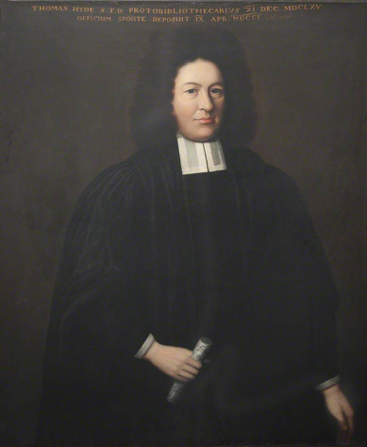
After finishing his work in Oxford, Shen returned to London where he had regular contacts with curious members of the Royal Society, including Robert Boyle. In April 1688, amid the political turmoil that led to the overthrow of James II, Shen travelled to Lisbon where he took his first vows as a Jesuit on 9 October 1690. One year later he embarked to Goa to complete his training before returning to China, but he died on 2 September 1691, near the coast of Mozambique.
The European reliance on Chinese sources and go-betweens was far from unique. The sixteenth century Portuguese humanist João de Barros counted on his collaboration with a well-educated Chinese, who was probably brought into Portugal as slave, to translate Chinese manuscripts and books. As Shen toured Europe, Emmanuel de Siqueira, also known as Zheng Manuo, a converted Chinese who joined the Jesuits, studied and worked in Rome, Bologna and Coimbra between 1651 and 1688. And in Paris, Shen also collaborated with Melchisédech Thévenot, the librarian of the Bibliothéque du Roi and one of the founders of the Académie Royale des Sciences. However, the encounter between Hyde and Chen offers a rare glimpse of an early modern encounter, and intellectual collaboration, between China and England in particular.
João Vicente Melo

A condemnation of excess, and a praise of the Aristotelian ‘golden mean’, was a rigorous benchmark for self-examination in sixteenth and seventeenth-century moral literature and political thought. Yet gentlemen also praised the desires and passions in a way that subversively celebrated the decadence of sin. ‘The Meane-observer, (whom base Safety keepes,)/Lives without honour, dies without a name,/And in eternall darkness ever sleeps’, declared Samuel Daniel in a sonnet in 1592. Daniel’s poem expressed a commitment to the pursuit of beauty even when its attainment was forbidden. To glut oneself on the sight of beauty and the allures of the flesh was perhaps ill-advised, but desire was also an inevitable part of existence. To many young gentlemen, the mean – golden, venerable, politically preferable – was also boring.
Last year's TIDE trip to Seville and Zafra for the Anglo-Iberian workshop catapulted us into the baroque and its visions of delight. Following in the trail of early modern English travellers to Spain, I began to think about how Protestants confronted the sacred sites of a Catholic country. Here was a world saturated by the emotive, passionate intimacy and yet grandeur of Christian theology – a theology that Protestants had shared with Catholics only a generation before. Gold, silver, and ornate woodwork filled dozens of early modern churches, from the vaulting splendour of Seville Cathedral to La Macarena, a later church filled with seventeenth-century figures and furnishings. Hearts were encased in wrought frames, directing the viewer to consider his or her inward being with somewhat macabre theatricality. Navigating the physical spaces of worship, and thinking about the role of art and architecture in expressing belief, revealed the importance of moving beyond Protestant rhetoric against Catholics in print to understanding the experience of travel and faith. In the messy lived reality of the Tudor and Stuart worlds, the relationship between England and Spain were hardly polarities, and we risk losing a fuller understanding of early modern identities when we fail to consider the formative weight of place, memory, and cross-cultural exchange on the individual.
It is commonplace to highlight the English aversion to Spain during this period, and certainly this existed. The unpopular Catholic reign of Mary Tudor and the Spanish Philip II, reports of the atrocities committed by Spanish armies in the Netherlands, gruesome tales of the Spanish Inquisition and the ‘Black Legend’ circulating in post-Reformation society, and the 1588 Armada all hardened English attitudes towards Spain. Anti-Spanish sentiment reached a fever pitch following the outbreak of the Thirty Years’ War in 1618, where James’ daughter, Elizabeth, became enmeshed in the Bohemian revolt against the Hapsburg dynasty. Charles I disguised himself and travelled secretly to Spain to consider the possibility of marrying the Spanish Infanta in 1623; when he returned to England empty-handed, church bells around the country rang to express triumph at God’s intervention.
And yet, while imperial envy and confessional divide led to negative English views of Spain, ignoring the allure of the Iberian Peninsula on English travellers only perpetuates stereotypes of cultural rigidity and difference. English Catholics retained close links with Spanish networks of power, as seen through Jane Dormer, for example, a lady-in-waiting to Mary I who married a Spanish ambassador and spent the next fifty years of her life in Madrid and Zafra. The hatred of Spain emerges most vehemently in the rhetoric of puritan MPs, whereas courtiers and the realm’s Catholics often celebrated the 1604 Anglo-Spanish peace. James’ close friendship with Diego Sarmiento de Acuña, Count Gondomar was a lasting if unpopular one, and merchants traded with Spain for commodities from oranges to the tobacco sourced from the Spanish West Indies. The explorer Walter Ralegh, and the geographer Richard Hakluyt, acknowledged the necessity of learning from the Iberians in their own imperial pursuits, and from an intellectual, humanist perspective, Spain remained attractive in its grandiosity.

Within this context, we begin to see how receptive the English were to the palpable spaces of Spanish churches. ‘I was yesterday as the Escurial [outside Madrid] to see the Monastery of Saint Lawrence, the eighth wonder of the world,’ wrote James Howell of his travels across the Continent in the 1620s, ‘...what I have seen in Italy, and other places, are but baubles to it’. Richard Wynn, another traveller to Spain in the 1620s, described the same monastery as the finest in the world. Howell and Wynn did not, or perhaps could not, comment favourably on what Protestants viewed as a problematic relationship between baroque imagery and biblical truth. Instead, they expressed their admiration by focusing on the ingenuity and architecture of the spaces. Wynn bought a floor plan of the Escorial, modelled after Solomon’s temple, as a souvenir.
The advice of schoolmasters and Protestant polemicists against the attraction of Catholic countries begins to seem less indicative of actual cultural rigidity, and more like a fraught attempt to curb enthusiasm. ‘I was once in Italie my selfe,’ Robert Ascham wrote in 1570, ‘but I thank God, my abode there, was but ix days. And yet I saw in that little tyme, in one Citie, more libertie to sinne, then I ever heard tell in our noble Citie of London in ix yeares...For being unlike in troth of Religion, they must needes be unlike in honestie of living.’ Ascham specifically condemned the dangers brought by beholding excess: in their Churches, Catholics ‘[mask] Ceremonies, to delite the eye’. Thomas Palmer, writing his advice to travellers in 1606, though somewhat less fantastical, gravely condemned those travellers who indulged in Catholic ritual. While it was important to observe certain customs when travelling, Palmer acknowledged, ‘let men avoid to sacrifice or do reverence to any idol...For though many have so large a conscience, that they perswade themselves, so they keepe their hearts to God, they may bend their knee, and bow themselves before such trash without hurt at all, yet God will not forget the hypocrisy’. The Catholic ‘estimation of reliques & images’, Palmer maintained, must be combatted, for a traveller went to new places to gather state secrets and better themselves for the good of their country, not to imperil their souls.
The concerns voiced by Protestant writers point to the way that English travellers engaged with Spain in a manner that had the potential to influence their lives when they returned in England. Tobie Matthew created a stir by travelling lavishly through Europe in the early seventeenth century and converting to Catholicism, despite being the son of a Calvinist theologian and the archbishop of York. Happily ensconced in Italy and Spain, Matthew wrote to Dudley Carleton in 1608 proclaiming that life on the Continent enabled him to ‘eate good melons, drinke wholesome wines, [and] look upon excellent devout pictures’. The English ambassador in Venice, Henry Wotton, was damning of Matthew: he was a leader, Wotton wrote, of ‘a certain knot of bastard Catholiques’, a crew of pleasure-seeking bon vivants who had descended into debauched sensuality. Living in Catholic countries had, as Protestant authorities feared, swayed Matthew into beguiling idolatry, for he ‘appeared stronger in his perversion and professing popery more than ever’, and this influenced his political associations when he returned to London.

The potency of the senses on individual self-fashioning had the capacity to change a subject’s confessional and cultural identity, and it is worth thinking more about how spaces of worship and personal encounters with Catholicism moved English travellers to behave differently, to seek spiritual assurance, to make new friends or to forge political alliances that could endanger their own lives. Gold-encrusted hearts, weeping Christs, wax figures and ‘excellent devout pictures’ moved viewers to inward contemplation and outward action. Some English Catholics returned from abroad to die as condemned traitors on London scaffolds; others were shaped by their travels in the things they translated, or the committees they sat on in parliament. ‘Receive this close embrace’, wrote Luisa de Carvajal, a Spanish Catholic living in London from 1607, ‘with immense love brimming...Repose on the sacred flowering bed and inflame yourself with love so passionate...in my very own arms...you will enjoy what no one has deserved’. The palpability of Catholic space was a risky affair for Protestants, authorities knew, because they encouraged succumbing to intense feeling -- passions that were not directed to the orthodoxy of the Protestant church and the monarch at its head, but to different forms and objects of devotion.
Lauren Working
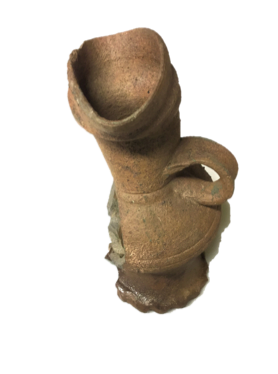
The objects in our next #gateofaccess series may at first seem a world away from the Tudor portraits or the Italianate neoclassicism that often embody the polished appeal of the Renaissance. Here, we present a defence of the ordinary, where the broken, misshapen things found in rubbish heaps, rather than museum displays, reveal subtle but moving insights into the lives of English individuals. Humanists themselves acknowledged that while a correlation between inner virtue and outer beauty remained the ideal, ‘it is rather good to see a man of body imperfect and disproportioned if he be endued with vertues’. Beautiful bodies with corrupted minds, wrote Lodowick Bryskett in his discussion of civility in 1606, were ‘nought else but a gay vessell filled with vice’.
Working in conjunction with the Museum of Liverpool, this series of objects focuses on the excavations at Rainford in St Helen’s, Merseyside, twelve miles from Liverpool city centre. These objects were excavated by archaeologists and volunteers from National Museums Liverpool and the Merseyside Archaeological Society in 2013, after Sidney Meadows, a local resident, found a seventeenth-century vessel in his garden when digging up a pear tree. Assisted by a grant from the Heritage Lottery Fund, this team excavated some 10,000 fragments of pottery and clay pipes in what once served as a kiln dump. Objects from excavations at Bickerstaff, also in Lancashire, are also included here, and reveal the presence of Huguenot glassmakers in local parishes.
The lids, glass, fractured cups and jugs, and colourful pieces of tobacco pipes show the connectedness of local and transatlantic trade, and highlight the influence of continental Europe on production and craft in sixteenth and seventeenth-century England. As our weekly images over the next seven weeks will show, the earthenware display Italian and Germanic styles; glass fragments and parish records testify to the presence of migrant French glassmakers; and attempts at sgraffito suggest a curiosity, or perhaps demand, for Italian techniques in producing clay objects. A Sieburg imitation jug (see image above) resembles the German stoneware so popular in London in the late medieval era, and archaeologists have suggested that potters may have been experimenting with the craft by imitating or adapting the vessels they encountered through popular continental imports. Surviving glass from Bickerstaff indicate the applied furnace decoration typical of the products made by Huguenot glassmakers, many of whom arrived in England from the 1560s, fleeing persecution during a period of devastating confessional strife in France. Tobacco pipes speak to the accelerating appeal of tobacco following increased English activity in the Atlantic from the late sixteenth century, particularly after the establishment of Virginia in 1607. These pipes, in colourful terracotta hues ranging from yellow to green, indicate that although the Pipe Makers’ Company in Westminster held a monopoly on pipe production, local industries used whatever material they had at hand to cash in on an increasingly popular pastime. The particular organic matters of peatland ecosystems made for a specific aesthetic that contrasts to the white Dorset clay pipes used in and around London. All our showcased objects, in fact, offer insight into the convergence between the natural world and man-made things, inviting a consideration of colour schemes and the appearance of domestic interiors as a result of these crafts. Glassware exhibited shades of green created by high levels of iron in the sand used in firing, and the hundreds of coarseware jugs offer a range of hues from dark brown to purple-black. In small, subtle ways, regional firing techniques in artisanal workshops, and the natural resources provided by the peat, moss, coal, and soil in and around Liverpool, offer a way to imagine the aesthetics of the everyday.
These objects hint at broader changes in industry and production, and the role of migration in effecting these changes. They also expose a good deal of law-breaking and questionable morality. The text we show in this series contains the death of a French glassmaker in an entry for December 1600: ‘a stranger slayne by one the glassmen/beinge a frenchman ther workinge’. Profound changes to the glassblowing industry were underway in the Jacobean era, after King James and parliament agreed that using wood for fuel endangered the realm’s forests. Coal, rather than timber, was to be used instead, leading to new firing conditions, and establishing the north as a crucial centre for the realm’s coal production. While the Seiburg imitation jug or French glass demonstrate the influence of Europe on form and technique, the glass and tobacco pipes impel us to face the Atlantic. The Virginia Company made concerted efforts in the 1610s and 1620s to establish glassmaking in Jamestown, where the abundance of timber presented no problems for fuel. The Company employed skilled migrants from Germany and Poland to the colony in 1608, and Italian glassmakers in 1622.
Do small, misshapen objects and mistakes belong in the Renaissance? The answer must be yes. Broken and faulty objects are the humble underbelly of the cultural glory of those Holbeins and Rubens and banqueting halls. They indicate the tireless efforts of craftsmen and artisans as cultural producers. Because the Seiburg jug is ‘a waster, warped and damaged’, it has survived as an example of how, and which, objects were locally produced. Bryskett’s appraisal of human bodies as vessels, and of the possible virtues of imperfection, becomes a fitting way to end as well as begin. The unwieldy clunk of the kiln stilts (below) may have been created purely as props to fire glazed earthenware, but it is because they were never meant to be admired or preserved that they show something remarkable – imprints of the craftsman’s fingers, a reminder of the intimate relationship between people and things, and the power of objects to transmit the past through time.
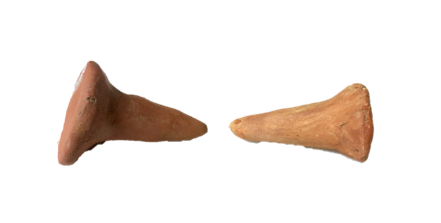
Lauren Working
Works cited
Lodowick Bryskett, A discourse of civil life (London, 1606; STC 3959).
Sam Rowe and Liz Stewart eds., Rainford’s Roots: The Archaeology of a Village (Liverpool: National Museums Liverpool and Merseyside Archaeological Society, 2014).
Robert Philpott ed., The Pottery and Clay Tobacco Pipe Industries of Rainford, St Helens: New Research (Liverpool: Merseyside Archaeological Society, 2015).
On 20 November, TIDE held its first seminar of the academic year on the theme of ‘English Travellers, Spies, and Diplomats in Foreign Courts’ with Joan-Pau Rubiés (Universitat Pompeu Fabra, ICREA) and Nadine Akkerman (Leiden University). These two excellent papers prompted a great deal of discussion amongst the attendees, despite an unexpected fire alarm.
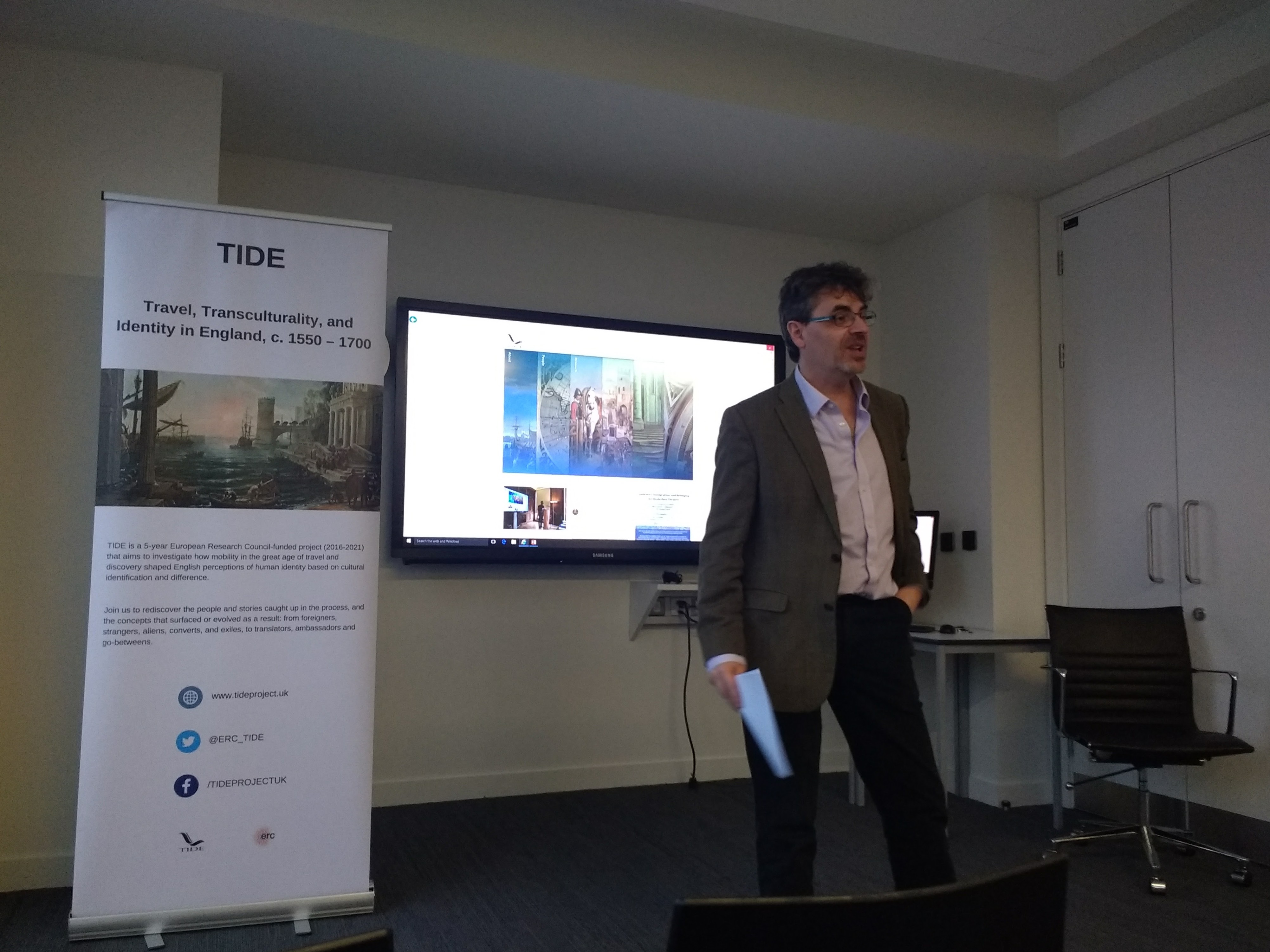
Joan-Pau Rubiés’s paper, ‘Traveller, observer, spy: assessing the status of English accounts of the Ottoman and Mughal states in the seventeenth century’, explored existing definitions and categories of early modern travellers, as well as the status of knowledge and knowledge production through travel. The most influential and successful collection of travel accounts was that edited by Giovanni Battista Ramusio, who proposed a critical model of systematic verification based on the principle that empirical experiences and observations of modern travellers could correct or update knowledge provided by classical authors. This contributed to the emergence of a new type of traveller: one who travelled motivated by the value of acquiring knowledge for knowledge’s sake and aspired to produce new forms of knowledge for an emerging and cosmopolitan republic of letters, rather than simply fulfilling specific political, economic or religious aims. Examples of this new kind of traveller include Henry Blount, who travelled through the Levant to gain knowledge through ‘ocular’ experience and published his stories in A Voyage to the Levant (1636), and Edward Terry, the chaplain of Sir Thomas Roe’s embassy to the Mughal court, who wrote A Voyage to East-India (1655). Although these authors were engaged with English projects of commercial and colonial overseas expansion, they articulated nationalist rhetoric with cosmopolitan views reflecting the concerns of their wide-ranging audience who, despite different confessional and national backgrounds or allegiances, shared an educational tradition and intellectual practices. Blount’s and Terry’s accounts illustrate how travel writing and the figure of the philosophical travel writer contributed to the formation of a dynamic cosmopolitan intellectual movement which influenced the European Enlightenment. The information provided by these early sixteenth century travel accounts had a profound impact on European intellectual circles, although its accuracy was sometimes uncertain, and as Joan-Pau observed, rumours, exaggerations and ‘fake news’ were alive and well in the seventeenth century. Similarly, such journeys sparked fear that by gaining knowledge of other countries, travellers would be corrupted and lose their connection to home, becoming citizens of nowhere. The political concerns of the twenty first century, it transpires, are not so new after all.
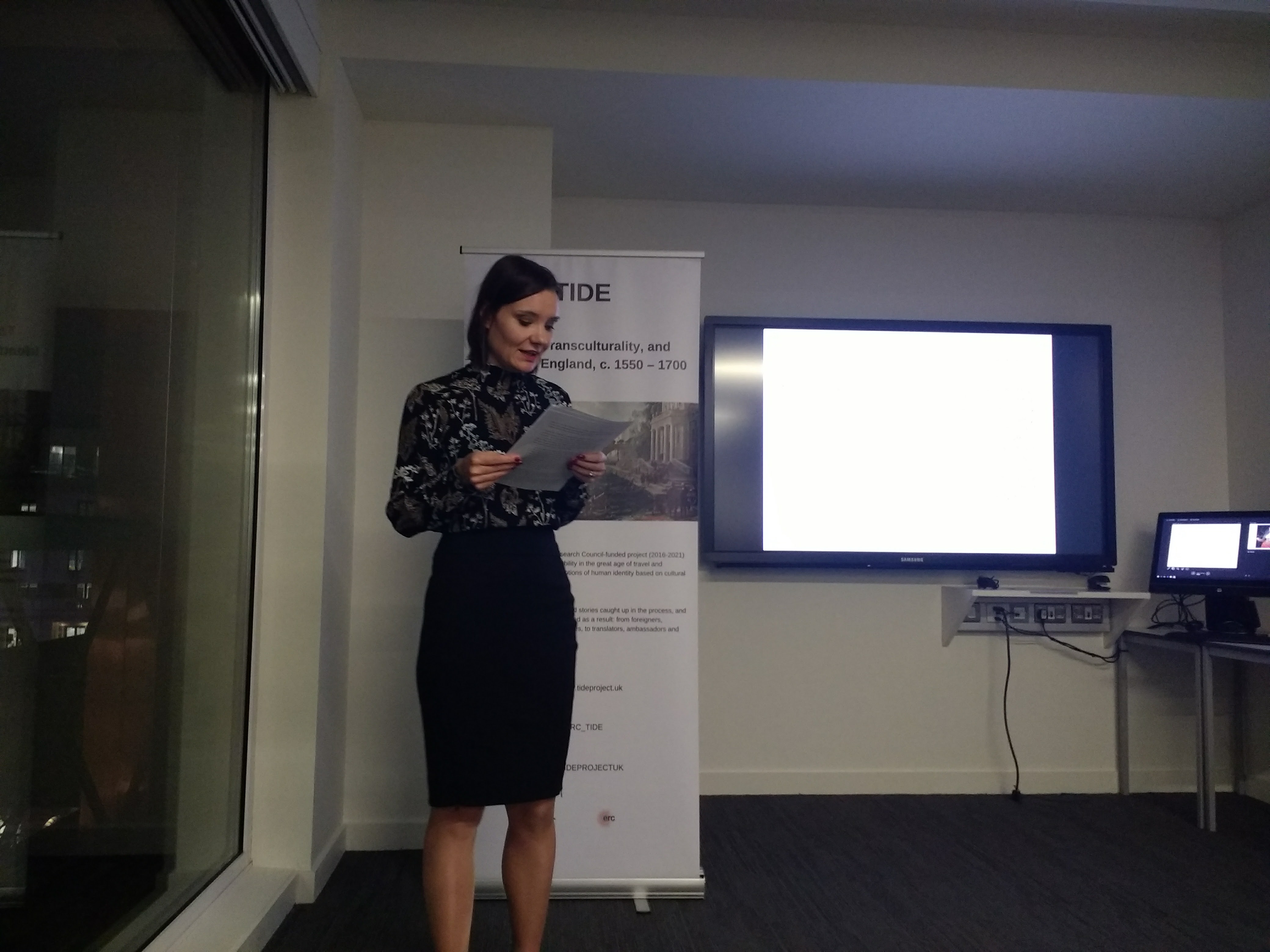
Nadine Akkerman’s paper on ‘Informal Diplomacy: The Correspondences of 17th Century Ambassadors’ Wives and Women Spies’ explored the fascinating role of women as intelligencers in seventeenth century Britain, despite a dramatic interruption by the fire alarm. Women’s letters have traditionally been assumed to contain ‘domestic’ content about marriage and children and so were often overlooked by censors. By the seventeenth century women had established ways of using this status to disseminate sensitive information, with Lady Carlisle hiding the news that ‘10,000 soldiers rise against the King’ amidst exhortations for her husband to return to her and ‘the babe in my belly’. By disguising the contents of their letters, women could use typically ‘female’ discourses about marriage and children to their advantage. The wives of ambassadors – or ambassadresses –occupied central and privileged positions at court and became integral to negotiations. Using the same means as female spies, these ambassadresses similarly manipulated gender prejudices to conceal or pass information, with some performing this role without the knowledge or permission of their husbands. As with men, there was a thin line between diplomacy and intelligencing, and the question rose as to whether an ambassadress could be an honourable spy. They certainly functioned as such, with Countess Rivers, Lady Aubigny and the Percy sisters as particularly prolific examples, though there is no appropriate term for this specifically female power. There are also significant archival issues which make the lives and roles of these women hard to trace as considerably fewer female penned letters have been preserved, while the role of intelligencer also means that sensitive letters may have been destroyed to protect their senders. As Nadine noted, the best spy is the one who leaves no trace – making these women spies some of the best.
Emily Stevenson
TIDE were delighted to welcome Sarah Howe, our visiting writer for 2018, to Liverpool this week for a series of events which drew visitors from across the university and the wider public. Sarah Howe’s first book, Loop of Jade, won the TS Eliot Prize and The Sunday Times/PFD Young Writer of the Year Award, and was shortlisted for the Seamus Heaney Centre Poetry Prize and the Forward Prize for Best First Collection. Sarah is also a lecturer in poetry at King’s College London.
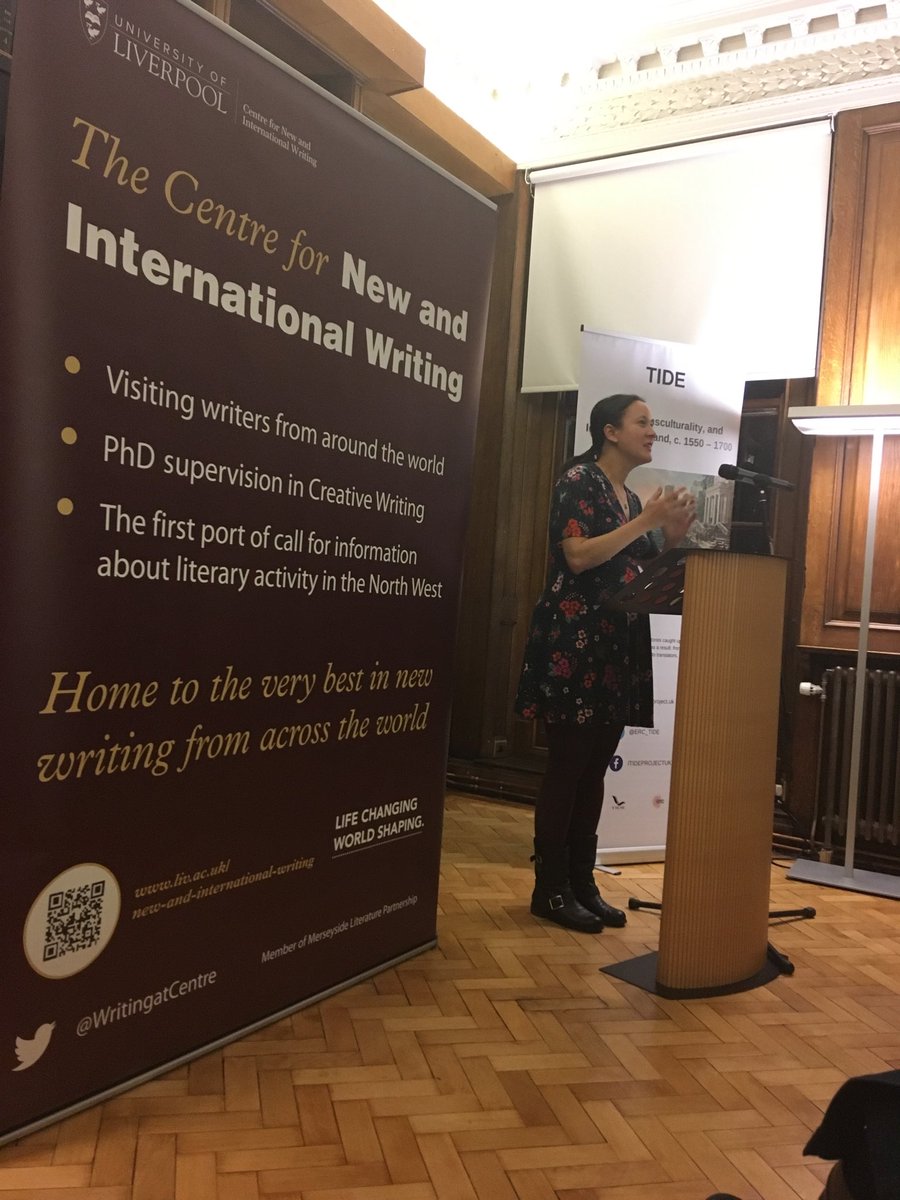
Run by the University of Liverpool’s Centre for New and International Writing, the Miriam Allot Visiting Writers Series hosts a diverse range of emerging writers every year. For the second event of this year’s series, the Centre co-hosted a reading with TIDE on 14 November featuring Sarah Howe and Anthony Joseph, the Colm Tóbín Fellow in Creative Writing at the University of Liverpool. Held in the Old Library in the School of Arts, the two authors read selections of their work to a large and appreciative audience of academics and non-academics alike. Anthony Joseph, who kicked off the readings, is a poet, novelist, musician and lecturer, selected in 2005 as one of fifty black and Asian writers who have made major contributions to contemporary British literature. He is the author of four poetry collections as well as six critically-acclaimed albums and a novel, The African Origins of UFOs, and has received an AHRC postgraduate scholarship to complete his doctoral thesis, a ‘fictional biography’ of Lord Kitchener. Rather than the famous Kitchener of WWI war posters, this Lord Kitchener was a Trinidadian calypsonian who arrived on the Empire Windrush, and features in the famous footage of its arrival singing ‘London is the Place for Me’. Anthony shared parts of this work at the reading, sharing emotive and entangled stories that highlighted the resonances between modern Caribbean-British migrations, and TIDE’s focus on issues of transculturality and in-betweenness in the early modern period. This was apparent in Anthony’s poem about the oceanic tides that carried migrants across the Atlantic towards England, and in the extracts he shared from his upcoming novel, Kitch, where characters discuss the differences between Trinidad and London, and the attitudes they are faced with on arrival.
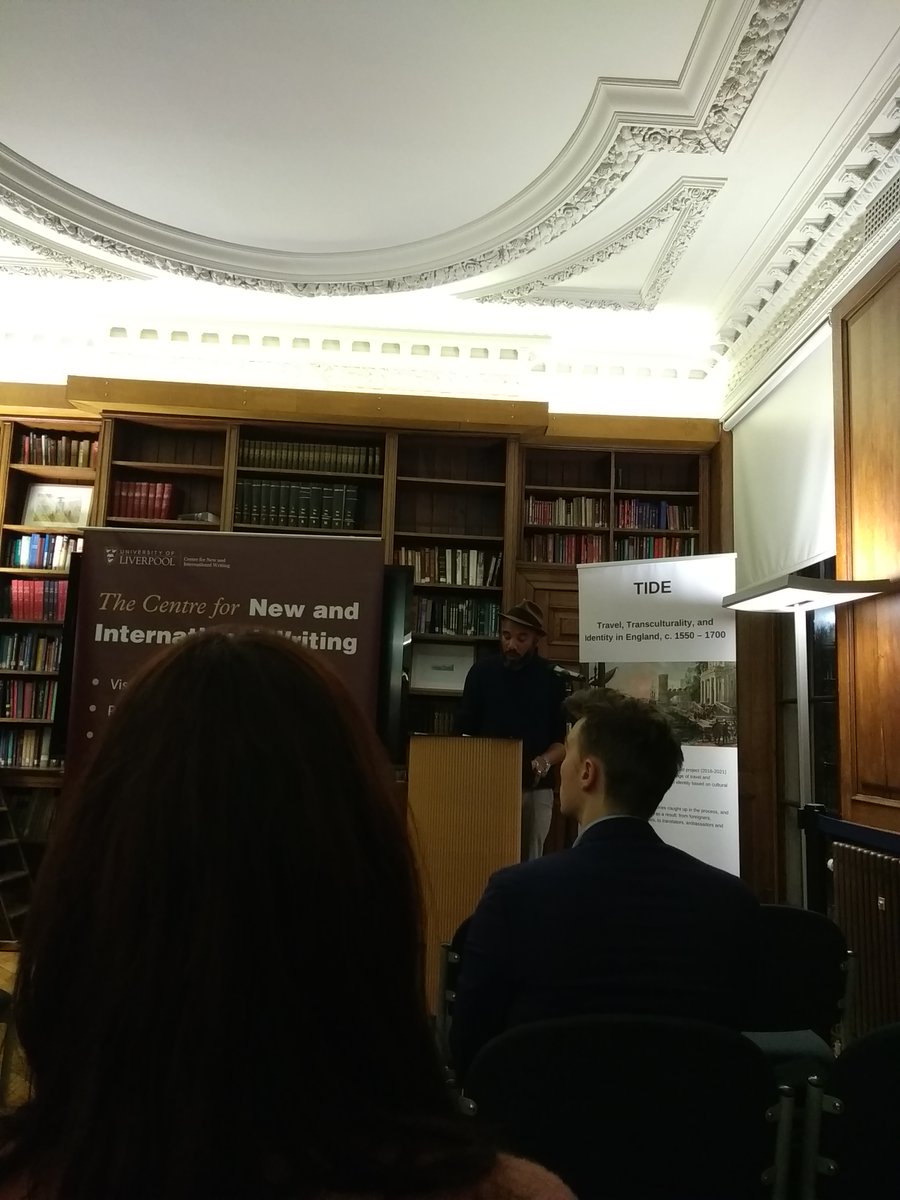
Sarah Howe read select poems from Loop of Jade, and treated the audience to pieces from her newest unpublished work. Sarah’s interest in Renaissance words and images emerged from her introduction to her first reading, which she dedicated to ‘all the early modernists out there’. What followed was a moving poem about memory and human fragility, as she reminisced about sneaking into the Fellows’ Garden at night during her undergraduate days in Cambridge to dance around Milton’s mulberry tree. She read ‘The Countess of Pembroke’s Arcadia’, a poem imagining the death of the Renaissance poet Sir Philip Sidney in the Netherlands in the 1580s, to the obvious delight of TIDE director Nandini Das. Sarah also introduced her recent work on the BBC Radio 4 series ‘Conversations on a Bench’, where poets choose a bench from which to sit and converse with strangers before transforming their experience of these conversations into verses of their own. Sarah chose the only bench in London’s Chinatown, outside a bubble tea shop on Gerrard Street. Her poems conveyed the experience of a gambler – Gerrard Street being the street with the highest concentration of betting shops in the UK – facing the devastating costs of his addiction, with the struggles of an illegal immigrant desperate to stay with his family, and the story of a young ‘BBC’ man – ‘British-born Chinese’ – struggling with the perception of his identity as a constant state of in-between.
On November 15, TIDE held a workshop with Sarah Howe for creative writing PhD students. The event offered these students the opportunity to share their work with Sarah, who commented on their work and offered feedback in an interactive session. The students unanimously gave glowing feedback afterwards, many commenting on how useful they had found the chance to critically reflect on their work with a professional poet. While not all students had heard of the work done by TIDE before, the workshop generated interest in future events run by the project, and helped them draw links between modernity and early modernity in ways they hadn’t considered – a definite success!
Emily Stevenson
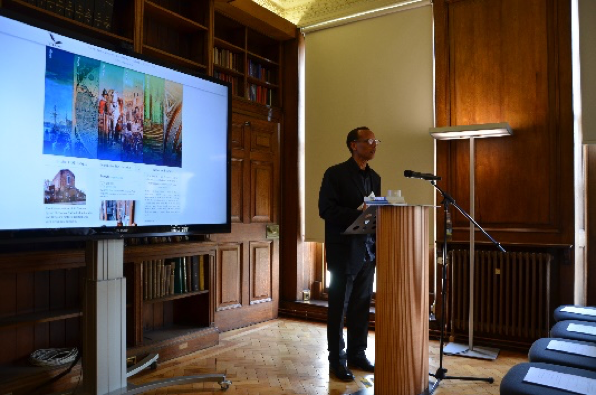
The archival spirit, the impulse and compulsion to dig deep into the past may as well be hardwired given its widespread practice and endurance through time. Even within ancient cultures deemed without libraries that predate big data there were symbols and oral rituals that paid homage to the past as a reliquary of wisdom. For example, the image of the Sankofa bird in Asante Adinkra in Ghana shows a bird that carries an egg on its back and has its head turned backwards as if to protect that egg and with a clear eye on the path behind it. Sankofa comes from the Twi language, and means “go back and get it” The image of the bird and the word function together as symbols with global applications.
Contemporary researchers of the Medieval and Early Modern eras, spared the burden of chaperoning eggs with them during the course of their research, nevertheless practice the same hindsight as that bird, the same looking back in order to understand the nature of one’s forward momentum. But in the case of a history of fragments, where the references are so scant they seem to be precursors of the art of minimalism, a degree of detective work of joining the dots and filling the large gaps appear to go hand-‐in-‐hand with the discovery of hidden gems in the past. It is not just a case of making things up. The links between two salient facts instruct the invention that tries credibly to bridge them.
In one instance, where a black woman is hanged in London, many questions arise about the brief reference to the simple fact that a black woman was hanged with nine others in seventeenth century London. It is not just a curious mind nosing around a fragment about a sad matter. Profound and glaring absences surround this woman’s life and brutal death, so much so that they become almost living themselves, bubbling at the site of this fragmentary reference. How did the black woman end up in London? What did she do to make the fledgling state of the day take her life from her? Was she a mother? Married? And so on.
Writers worth their salt see the fragment and feel, at an almost molecular level, a huge sense of outrage on behalf of that poor woman. The questions become an ethical commitment to her, close to a contract so it seems, to help fill in some of the questionnaire about her, even if invention and imagination must supplement the piecing together of those fragments and help to reanimate that lost life.
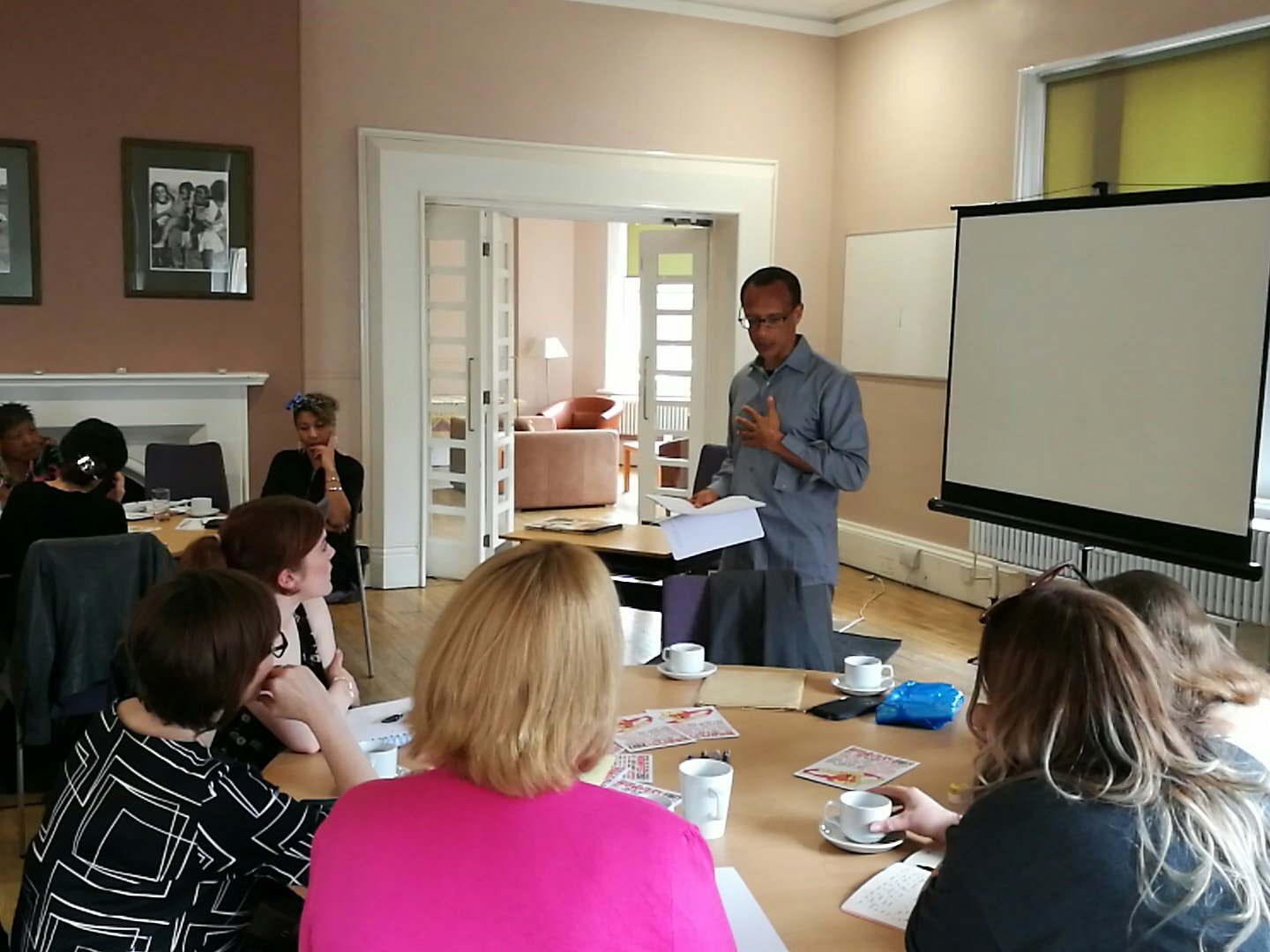
Simon Schama’s Dead Certainties (1991) shows us that where there is a gap between one fact and another some ingenuity is called for on the part of the researcher who must bridge that gap or abandon the project. The gap is a permission slip for the imagination to get to work and make it possible, by filling in the absence, for the researcher to carry on (and remain calm).
From Toni Morrison’s Playing in the Dark (1992) we learn that absences are not restricted to mimimalist documentation in history. She writes that black presences in literature are absent presences, a function of being there in the most scant detail in order to glorify whiteness and help white characters in fiction to become actualized (fully realized flesh and blood personas with an interior landscape to boot). Since Morrison’s example is contemporary it lends itself to what I can only call theoretical teleportation, to being applied to any period in any location.
Applied to that black woman who is hanged, it is possible to see her as an absent presence in need of the same imaginative largesse applied to globetrotting whites who benefited from their relations to servile and more stationary blacks. The move back in time to earlier and earlier emblems of black belonging works in exact opposition to claims that blacks do not belong in Britain or arrived there too recently to earn full participation in the civil and political economy.
Our (feeling for her, I cannot help being proprietorial) black woman is international in her body. Clearly from some other place and living in London, she signals that the British part of the transatlantic slave trade may have left large numbers of blacks in the cities and before that trade, it implies that mercantile capital had its black subjects popping up in far flung places as well.
At a genealogical level, were she a mother, we can assume that she left a genetic trail in the city with descendants who have blended into the general populace. She scratched about for a living or she may have had a trade of some kind, who knows? A fiction writer might be able to tell at least one likely trajectory for a black woman in the seventeenth century. She needs a name, an imagined biography and dreams, as counters to her sliver of a record for a life.
Liverpool’s archive goes further, earlier, deeper and more broadly than individual characters. Cartographies, European and global trade routes, ever-‐burgeoning cities, New World epistemologies, and the roots in antiquity of our modernity, comprise some of the projects flourishing there. Other Liverpool University Depart of English faculty who are involved are the writers and researchers, Sandeep Parmar, Deryn Rees-‐Jones and Lucienne Loh.
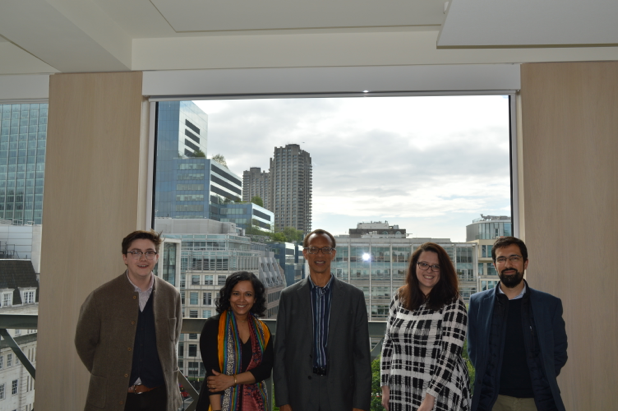
I was lucky to enjoy a short residency in the city of Liverpool and make use of the facilities of the university. That TIDE is based in the School of the Arts points to the importance of deep research for critical thinking and for the arts of the imagination and belies its many connections to the community. I visited the Slave Museum at the thriving docks, met local writers, David Byrne, Levi Tafari, and many activists at a May Day parade. I conducted a writing workshop as part of the Writing on the Wall Liverpool festival, organized by Madeline Heneghan and Mike Morris. (You won’t meet two souls more committed to the health of the city than Madeline and Mike.) The workshop consisted of a series of writing exercises built around a selection of entries in church registers and other public notices from the sixteenth and seventeenth centuries.
For the Miriam Allott lecture, I read and answered questions at a public event held at the university. In TIDE’s small but vibrant office, a tight ship me-‐maties, aarrh, (I channel a pirate) run by Emma-Louise Whitehead, I had many conversations with TIDE’s three young scholars, Haig Smith, Jõao Vincente Melo, and Lauren Working, and research associate, Roger Christofides, all under the expert tutelage of Nandini Das, project director.
The visit culminated with a discussion at the LRB Bookshop across from the British Museum between broadcaster and historian, David Olusoga, the novelist and historian Catherine Fletcher and me, with Nandini Das as Chair. Here, the talk and Q&A. with the audience forged links with an antique and with an Early Modern past in confirmation of what Faulkner said about history – “the past is never past.”
Fred D’Aguiar
On the 19th November 2017, the TIDE project and Before Shakespeare are hosting a workshop exploring the diverse audiences of Elizabethan playhouses and their surrounding neighbourhoods, based at the University of Liverpool’s London campus, 33 Finsbury Square. Working with The Dolphin’s Back, we will be looking at a range of plays, archival documents, diaries, and other materials to ask: Who visited Elizabethan playhouses? What might it mean to put non-English characters on stage? What does dramatic engagement with issues of immigration, identity, and belonging tell us about sixteenth-century playing spaces? This blog takes us back to the site of that workshop some four hundred odd years ago, in order to think about the neighbourhoods on the doorstep.
Today, in the heart of the City and amid its glassy towers, Finsbury Square smacks more of balance books than playbooks. Yet it is at the heart of London’s long and crucial history of cosmopolitanism.
Elizabethan England had a mixed relationship with immigration. It welcomed religious refugees and offered patents to immigrant craftspeople settling in the country. At the same time, there were considerable tensions about non-English labour and the government recorded lists of immigrants, demanding reasons for their living in England, their occupation, and their religious proclivities. These recorded lists are often known as the “Returns of Strangers.” In early modern England, “stranger” was a flexible term, but here can be defined as a foreign-born individual resident in a particular parish or community. The mixture of resentment, distrust, fear, and othering often resulted in the persecution of immigrant settlers and their communities.
Here, we introduce some of the Londoners who lived in the surrounding neighbourhoods, ahead of exploring their fictional equivalents in the drama of the late sixteenth century and their and others’ real-life presence among the audiences and neighbourhoods of early playing spaces.
![Roughly on the spot of what is later known as “Upper Moorfields” and in the area known in the 1570s and 1580s as the recreational land Finsbury Fields (just north of Moorfield and the ditches outside the city wall). To the left was the neighbourhood north of Cripplegate and to the right the growing neighbourhoods north of Bishopsgate, whose main road extended north from the church of St Botolph’s without Bishopsgate, past Bedlam Hospital, into Norton Folgate, and north through Holywell and St Leonard’s parish in Shoreditch. Section of “Plan of London (circa 1560 to 1570),” in Agas Map of London 1561 ([s.l.], 1633), British History Online http://www.british-history.ac.uk/no-series/london-map-agas/1561/map [accessed 22 October 2017].](http://www.tideproject.uk/wp-content/uploads/2017/11/Picture1.jpg)
The characters populating the neighbourhoods around Moorgate and who live in the vicinity of the playhouses in Shoreditch are an important factor in thinking about the rise of commercial playing, not least when a number of the earliest plays surviving from those playhouses prominently feature “strangers,” black men and women, European merchants, and debates about the economic, social, and cultural consequences of immigration in London.
Some of the individuals living in and around Moorgate, Bishopsgate, Norton Folgate, and Shoreditch offer intriguing connections between the city and the stage. Robert Wilson is found resident in the parish of St Botolph’s Without Bishopsgate in the 1580s, when he is described in a legal case, rather conspicuously, as a “player” (LMA MJ/SR/0258/56). He appeared alongside fellow actor John Dutton in a tax return for the parish in 1582 and 1587 (TNA E179/251/16, TNA E115/118/24, and E115/403/110).
A few minutes up the road in Norton Folgate, Wilson might have come across one Peter Rastringinge, a buttonmaker from France and his wife Margaret, both born in Armentiers and having lived in England for 12 years. There may well have been a local edge, therefore, to Wilson’s depiction of the character Fraud in his play from the late 1580s, The Three Lords and Ladies of London. In that play, Fraud takes on a disguise as an “artificer” from France, who is selling various gilded buttons. Far from being an outlandish satire or send-up of a foreign merchant, Fraud’s deception speaks very literally to the type of individual audiences would have seen or known. Perhaps Peter Rastringinge, his wife, colleagues, or fellow countrypeople would have seen the play themselves, begging the question of how self-consciously such an episode might have been performed or how inclusive or exclusive such a spectacle might be.
The notion of an “English” person is itself up for debate in this period. London’s city council periodically took pains throughout the 1570s and 1580s to make it clear that children of immigrants retained an immigrant status themselves. These questions are at issue in plays that interrogate the issue of nationhood—including those featuring Englishmen fighting abroad on the behalf of foreign princes, such as George Peele’s The Battle of Alcazar—and also in plays that explicitly think about generational difference itself. In The Three Ladies of London, the eponymous ladies have a more complex relationship to their city and country than the title might initially suggest, as do surrounding characters. Lucre’s grandmother is, audiences are informed, Venetian, and we learn that she is in fact a second- or third-generation immigrant to London. She in turn enquires of Usury, “why came thou to England?”, and Usury replies:
"I have often heard your good grandmother tell,
That she had in England a daughter, which her far did excell:
And that England was such a place for Lucre to bide,
As was not in Europe and the whole world beside...”
In the same exchange, Simony recounts his birth in Rome, where he dwelled with monks and friars, before “they invited me / with certain other English merchants” to visit England.
Exactly this question of generational status, nationhood, and belonging is at issue outside the playhouse. Again, in the same parish as the The Three Ladies’s author, Thomas Wilson, a clerk noted in 1586 the case of a mixed-race child—the baptism of ‘Elizabeth, a negro child, born white, the mother a negro’ (GL MS 4515/1). What exactly is meant by such a description remains unclear. However, the notion of a ‘negro child, born white’ highlights the complicated perceptions early modern Englishmen and women had of identity, status, and indeed the legibility or visibility of an otherness that the parish clerk is keen to mark out. A year later a little further east, at St Botolph Aldgate, twenty-year-old ‘Mary Phillis of Morisco, being a blackmore’ was baptized (GL Ms 9234/6). The parish clerk in detail also noted down Mary’s conversion narrative, describing how she had been in the country for between thirteen and fifteen years after living with ‘one Millicent Porter a seamster’ and was now ‘desyrous to becom a Christian.’
Indeed, the area around St Botolph’s included one of England earliest black communities. On the 22 October 1586, 'Christopher Cappervert, a blacke moore' was buried at the church (Guildhall Library [GL] MS 9222/1). The term blackamoor most often referred to an individual from Sub-Saharan Africa, and put colour at the heart of early modern English conceptions of identity. In his 1600 translation of the North African humanist scholar Leo Africanus’ Description of Africa, John Pory described the ‘principall nations’ of Africa as including ‘the Africans or Moores, properly so called; which last are of two kinds, namely white or tawnie Moores, and Negros or black Moores’(Pory, The History and Description of Africa Ed. Robert Brown, 1896, 20). Grammars and dictionaries of the time made similar associations: ‘The Negro’s [sic], which we call the Black-mores’ (Ralegh, The history of the world, 1614, L2r.)
The following year, 'Domingo, beinge a Ginnye negaro and beinge servaunt to the Right Worshipfull Sir William Winter' was also buried at St Botolph’s after succumbing to consumption (tuberculosis) (GL MS 9234/1, f.127v). Between 1586 and 1596, 8 black men and women were registered by the parish clerk at St Botolph’s as being buried, including 'Suzanna Peavis a blackamore servant to John Deppinois’ (GL MS 9221/1) and a black man 'suposed to be named Frauncis' who was a 'servant to Peter Miller a beare brewer” (GL MS 9223). In 1594, close by in St Stephen Coleman Street (now Gresham Steet), a black woman named 'Katernine' who had been 'dwelling with the Prince of Portingal' was buried (GL MS 28867).
The neighbourhood of St Botolph’s was also home to a variety of European immigrants, including one Peter Favale, 'of Bolyuia de Grace' and one Poll Germall, a Genovese gentleman who lives with Favale. They both attended the English church and had been in the country 30 and 10 years respectively. Individuals also circulated between city and court life. The parish was home to John Baptist Violer, a servant of Queen Elizabeth. Searches have afforded little information about 'Violer,' and 'John Baptist' is a popular name, including among stranger preachers. There is, though, another John Baptist, of Castiglione, who also had status in the royal household at this time; Giovanni Battista Castiglione is described in a letter to Emperor Ferdinand in 1558 as 'one of [Queen Elizabeth’s] favourite and private chamberlains' (qtd Bolland 42, 'Alla Prudentissima' in Leadership and Elizabethan Culture, Ed. Peter Iver Kaufman, 2013). He formed part of a small network of individuals in royal circles the early years of Elizabeth’s reign, and Thomas Blundeville’s dedication to Leicester of an advice manual, A Very brief and profitable treatise, printed in 1570 thanks 'my very friend Mayster John Baptist Castiglion one of the Gromes of hir Highnesse privy chamber' (A2v). The St Botolph’s John Baptist, however, is likely a different man, given his suffix, 'Violer.' Other court-associated immigrants were present down the road in St Alphege parish (in Cripplegate, near the London wall), where Frauncisco Ytalion and Ambrose Ytalion could be found, both musicians to the Queen who had dwelt in England 27 and 30 years respectively by the year 1571.
Moregate, Cripplegate, Shoreditch, and the areas around them are examples of the mixed reception of stranger communities in England. They were home to many foreign artisans, particularly silkweavers. These silkweavers came from various parts of Europe, including a number born in Valencia who dwelt in Shoreditch at St Leonard’s parish in the early 1580s. A list of immigrants from 1571 included one John Deboyse, a Frenchman, who had the curious occupation of 'morispykemaker' (that is, Moorish Pike-Maker, a weapon); he was a denizen and member of the French church.
In some cases, as strangers increasingly settled in these areas in London, anti-immigrant sentiment increased amongst the English population. The most notorious of these incidents were the Evil May Day Riots of 1517, the first documented race riot and worst case of violence against immigrants in early modern London.

Evil May Day is at the centre of the Elizabethan play The boke of Sir Thomas More (which survives in a manuscript composed and revised between c. 1593 and 1600 by Munday, Chettle, Dekker, Heywood, Shakespeare), itself coming out of and responding to increased tensions between English Londoners and “strangers” in the 1590s. In 1517, the areas surrounding Moregate, including Cripplegate, Bishopsgate and Aldgate, did not escape the violence that ripped through London, both during and after the riot, as gallows were erected at the main sites of the riot to execute the perpetrators.
It is not only men who characterise the occupations of these lists of immigrant residents. Norton Folgate was also home to a widow and denizen, Thomasine Barny, who “useth shoemaking.” She was born in “Ortwayes"—perhaps Orthez, in the south west of France, which had a substantial Protestant/Huguenot population and a Calvinist-leaning university; it was also the centre of some gruelling fighting during the conflicts between Catholics and Protestants in France, including a major battle (won by the Huguenots) in 1569. Barny had lived in England for 15 years and had two (likely French) servants, John Morsonne and Jakery du Roye (Returns 2: 369). The authority, skills, and commercial savvy of the three ladies in Wilson’s play have their counterparts in the city of London, too.
Up to the east of Finsbury in Hallywell Street in 1583 lived Petruccio Ubaldino, noted in the list of names “of all the Straungers inhabiting within the Precinct of Hallywell Streete” as “an Italian, a gentleman belonging to the Courte, hath been here 27 years” (2: 367). Ubaldini was a soldier who came to England in the 1540s, and he worked as an illuminator while also writing and translating texts. In his years in England in the 1560s, Ubaldini taught Italian and acted in comedies at court, as well as transcribing letters and eventually working on state business across Europe (for more details see ODNB, Cecil H. Clough).
Ubaldini, while being an actor himself, also provides some of the background material for one of the Elizabethan stage’s prominent characters, Thomas Stuckley. Stuckley worked abroad for foreign princes, and features in Peele’s play The Battle of Alcazar fighting for the Spanish. Ubaldini had written for Lord Burghley an account of Gregory XIII’s invasion of Ireland, which started under this infamous Englishman-abroad, in 1577 (TNA SP 9/102 and BL Add. MS 48082, fos. 87-121).

The area outside and around Cripplegate was home for some years to one Francis Marquino. He is described in 1571 as a “sylkworker,” an occupation he shared with many of his European neighbours, and he lives in (St Michael’s) Wood Street in 1571 with his wife, Levena, having been in England for 12 years. He is noted that year to be a denizen and member of the Dutch church, and he and Levena had 4 children. In 1576, he is to be found in St Peter’s Cripplegate, and by 1583 he has seemingly established an international school in Shoreditch or Hoxton. The list of strangers in the area for that year describes him as a “scolemaster” born in Lombardy, living with Levina (or Lavinia) and now with 8 children (all born in England). He “hath 24 scholars, strangers’ sons, born in England,” as well as an usher named Peter Hurblock (2: 370). It is curious to think that Lavinia and her family may have been part of an early audience for Shakespeare’s Titus Andronicus, which includes the brutal rape and mutilation of Titus’s daughter, Lavinia. While the Roman and “foreign” subject-matter of Shakespeare’s plays is often said to distance the content from England itself, these names were not wholly exotic and echoed the communities on the doorsteps of playhouses and playwrights.
Francis Marquino, like Ubaldini, also worked as a translator for the printer John Wolfe: he rendered A politike discourse most excellent for this time present: composed by a French gentleman, against those of the League, which went about to perswade the King to breake the allyance with England, and to confirme it with Spaine into English for publication in 1589 (STC 13101). Beyond this, there seems to be little more information about his life. His apparent change of profession may be due to an error in the 1571 return or a new direction for Marquino. (Francis and Lavinia are noted with little information in 1560 and 1561; in the latter list of attendees of the Dutch church, Francis Marquino is called a “caligarius”—a shoemaker—adding confusion to his profession or suggesting a man who liked to change trades (1:274).) The substantial information provided in the 1583 return, however, gives the details particular weight, and a sizeable “stranger” school for second-generation immigrants in the suburbs surrounding Finsbury and the Shoreditch playhouses gives fascinating texture to our understanding of the neighbourhoods north of Bishopsgate.

All of these individuals live in the vicinity of various leisure pursuits surrounding Moorfield. John Stow’s Survey of London (1598) explains that Moorfield was used for recreational activity, in particular walking, shooting, and wrestling. During Henry VIII’s reign, the area was enclosed and populated with impressive summerhouses. In the later sixteenth century, further beyond Finsbury lay part of London’s waste disposal system, and Stow bemoans the “laystalls of dung” with three windmills placed on top, around which “the ditches be filled up, and the bridges overwhelmed” (Z8v). In the later years of the sixteenth century, these areas north of the walls underwent a period of change and growth, especially in the burgeoning suburban neighbourhoods to the east and west of Moorfield and Finsbury. Seeing these surroundings populated by French weapon-makers, Italian courtiers, and black men, women, and children speaks to the diversity of London but also underscores some of the issues about identity, nationhood, and belonging at the heart of so many Elizabethan plays.
We look forward to exploring the role of immigration in Elizabethan plays, thinking about who formed their audiences, and contemplating the sentiment of belonging in these contexts on the 19th November. If you would like to join us, tickets are available on Eventbrite.
Works Cited:
Clough, Cecil H. “Ubaldini, Petruccio.” Oxford Dictionary of National Biography Online. Web. 3 Nov. 2017.
Kirk and Kirk, eds. Returns of Aliens Dwelling in the City and Suburbs of London. Parts 1-2. Huguenot Society of London, UP, 1902.
Leadership and Elizabethan Culture, Ed. Peter Iver Kaufman. Palgrave Macmillan, 2013.
Stow, John. Survey of London. London, 1598. Early English Books Online. Web. 3 Nov. 2017.
Wyatt, Michael. The Italian Encounter with Tudor England: A Cultural Politics of Translation. Cambridge UP, 2005.
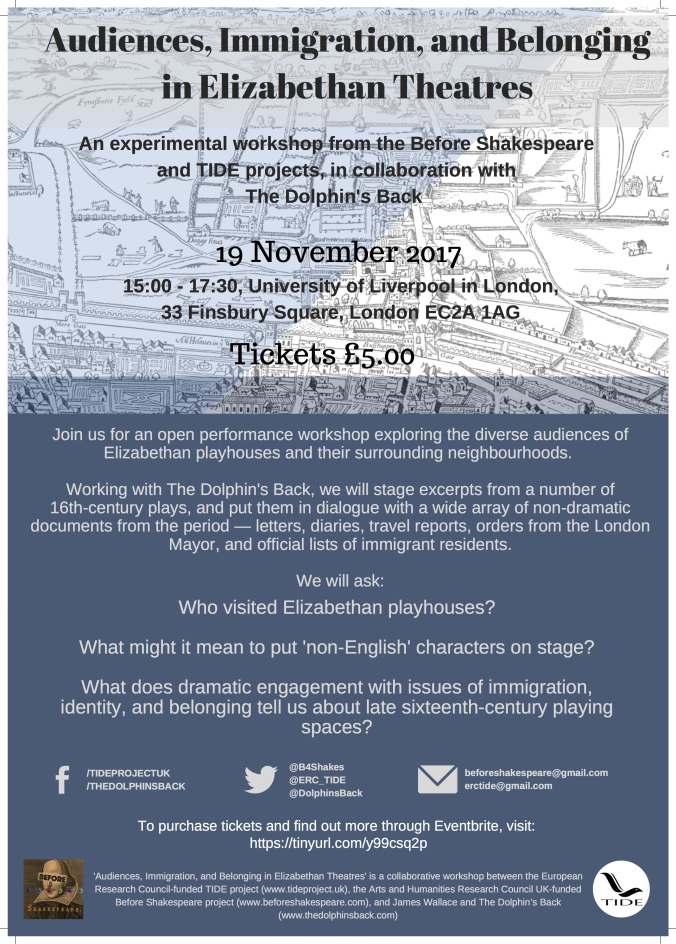
On Calle Alfonso XII, immediately after Plaza Duque de la Victoria, stand the remains of what was once one of the main references for many English visitors to Seville: the Jesuit College of St. Gregory. Founded on 12 November 1592 by Robert Parsonio, the ‘arch-Jesuit’ feared by the Elizabethan authorities, the college was destined for English students who would be trained to serve in the dangerous Jesuit missions in England. Like the English colleges in Italy or France, the college in Seville offers insight into the lives of English Catholics outside England itself. While state discourse in the post-Reformation period was continually scattered with paranoid references to the networks of Catholic alliances beyond England, TIDE’s recent visit to the college in Seville prompted my curiosity about what the English actually did when they went to study and teach in European colleges, and how this informed both English and Spanish fears about orthodoxy and political stability.
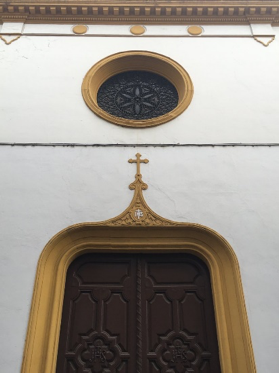
Encouraged by the success of The Royal College of St. Alban, founded in 1589, Roberto Parsonio, as he was known by the Spanish, believed that Seville’s privileged position as the main hub of Spanish colonial trade had the potential to offer to the English Jesuits a much welcomed access to wealthy patrons and to the necessary logistics to travel with relative safety to England. It is interesting to note that the reasons behind Parson’s decision to establish an English college in a busy and wealthy port city like Seville were the same that led many of his Spanish companions to avoid investing in public education. Despite its importance and prosperity, Seville lacked a major university, though the University of Seville was founded in 1505. In 1570, the Andalusian provincial explained that the hesitations of the Jesuits were motivated by the ‘acute but volatile Sevillian mind’. Young Sevillians, wrote the provincial, were ‘brought up in affluence, idleness and luxury’. The city was a place where ‘every day brings many novelties from the land and the sea which distracts the youth from their studies’. This made Seville, as well as all other large urban centres and port cities, ‘incapacitated for learning, because there are many distractions, and many opportunities for vices, carnal joys and continuous novelties’. The provincial’s observations on the Sevillian character, however, seemed to hide another problem: the quality of the few students who entered the only grammar school run by the Jesuits in Seville, and who were described as ‘poor and uncultured’.
Parsons founded St. Gregory’s in a period when Jesuit social and intellectual prestige was boosting in Seville. The Spanish Crown expressed an inclination to help English Catholic exiles for both religious and political reasons. Philip II supported the foundation of St. Gregory’s, and the powerful dukes of Medina Sidonia were among the protectors of the Colegio de los Ingleses. If the political and financial support granted by the Spanish monarchy and grandees ensured the immediate success of the college, the decision of Pope Clement VIII in 1594 to grant to St. Gregory’s the same degrees and titles previously conceded by the Church to Oxford and Cambridge bolstered the prestige of the college.
Also in 1594, St. Gregory’s began to gain the reputation of a cradle for martyrs following the death of one of the college founders and teachers, Henry Walpole, who was executed in London and acclaimed a martyr by the Jesuits. Walpole’s celebrated martyrdom was followed by the death of two students, Robert Waller and Thomas Egerton, for excessive penitence in 1595. In 1600, Thomas Hunt was the first St. Gregory’s graduate to be executed in England. These first martyrs of the Colegio de los Ingleses generated a popular veneration throughout Seville and the rest of Andalusia. Sevillians, wrote Parsons, looked to St. Gregory’s ‘with a kind of admiration of them, to see many Inglish tender youthe al bred and borne in this Queene’s reign and yet so forward and fervent in their religion as to offer themselves to al kinde of difficulties, afflictions and perils of the same’.
The arrest and execution of Henry Walpole in 1594 led the Elizabethan authorities to regard the Colegio de los Ingleses as potential platform for ‘popish’ conspiracies organised by English Catholics with the help of Spain. During his examination, Walpole indicated that St. Gregory’s contained 40 English students, but refused to reveal their names. The college was at times a harbinger of political radicalism – in 1597, it was associated with a supposed plot to assassinate Queen Elizabeth, which involved a former English prisoner of the Sevillian Inquisition and the Jesuit Richard Walpole. The plot consisted of poisoning the queen’s gloves with perfume, taking advantage of knowledge about poison, and links to the household of the earl of Essex.
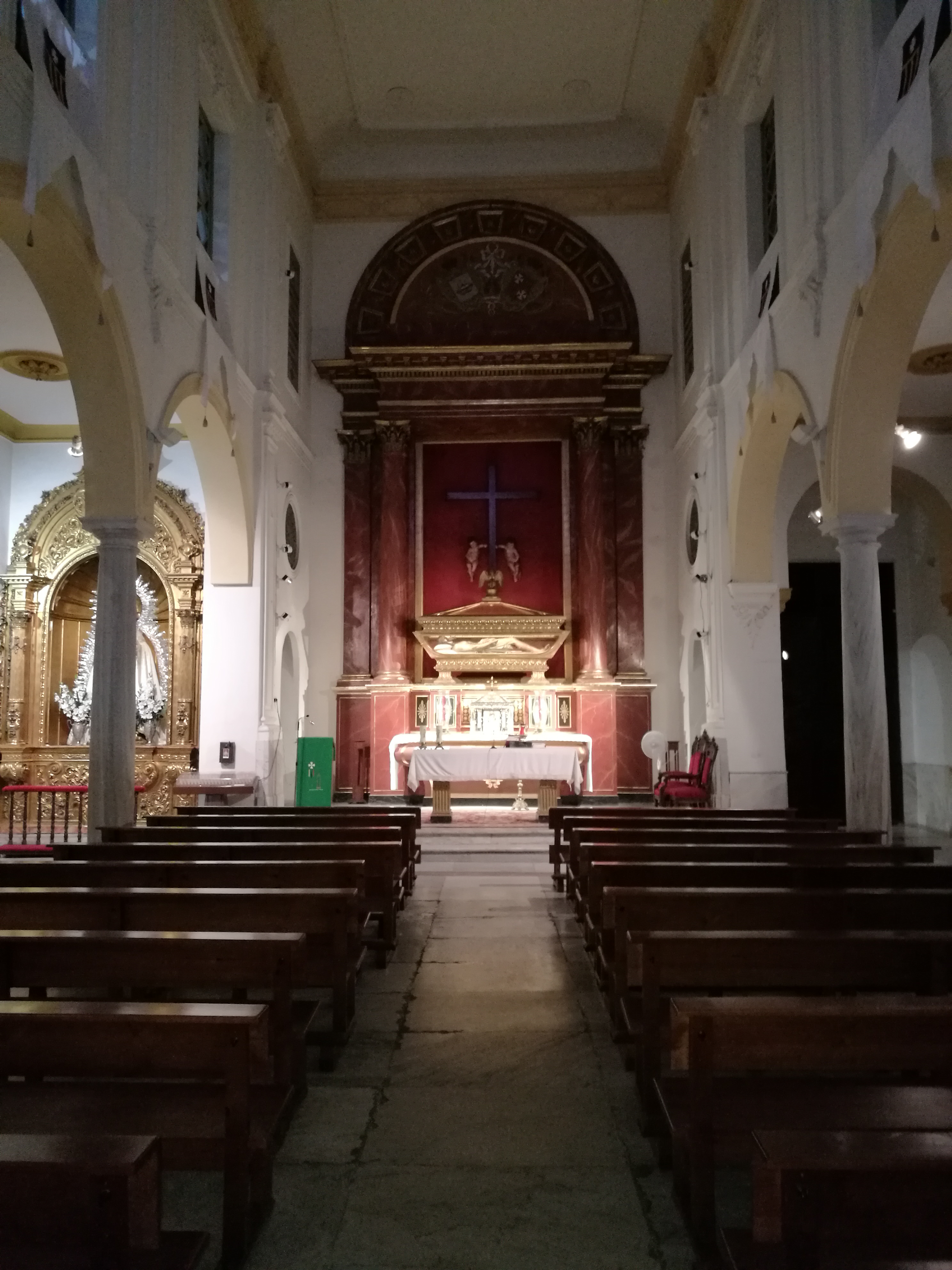
The reputation of the college as politically and religiously subversive was reinforced by the recurrent employment of the members of St. Gregory’s as interpreters for the Sevillian Inquisition. Parsons and the administrators of the college always sought to establish good relations with the Holy Office in order to avoid any sort of suspicion regarding the presence of young Englishmen at Seville, who could be under the influence of heretical ideas. The students of St. Gregory’s were often enthusiastic supporters of the Inquisition. In 1616, Francisco Peralta, the rector of St. Gregory’s, mentioned that one student who was being sent to England, had earlier thanked the Inquisition for protecting the college and declared his desire to see the Holy Office ‘establish in England and other provinces plagued by heresy, in order that by its means religion might be kept pure and undefiled as it was in Spain’.
In spite of their adherence to Catholic orthodoxy, some sectors of the Spanish Church feared that the English Jesuits could not be trusted for coming from a heretic country. Most of these fears originated in xenophobic feelings which depicted the English as a people of ‘barbarous customes and manners’, or conspiracy theories that suggested that the English students of the Valladolid and Seville colleges were spies that wanted to destabilise Spain and spread Protestantism across Iberia.
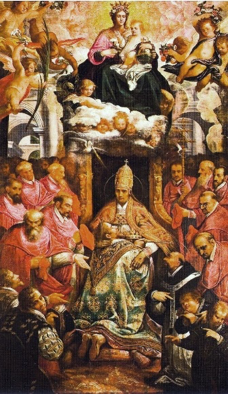
St. Gregory’s reputation as cradle of martyrs and a bastion of the Counter-Reformation was reflected by the artworks that decorated the college and its church. Painting such as the anonymous Virgen de los Ingleses (1593) or Juan de Roela’s El Triunfo de San Gregorio (1608) represented the prestige of the college, as well as it allowed the English Jesuits to develop an interesting narrative of a devoted Catholic England which would eventually triumph over Protestantism. This message was also transmitted in the pamphlets, accounts, poems and plays written by the members of the Colegio de los Ingleses. Ballads and poems dedicated to St. Gregory’s martyrs such as Henry Walpole and other Catholics executed in England were especially popular. The college was also famous for the plays staged by its members which usually attracted a considerable audience and offered a much welcomed source of revenues.
Money was often a problem for the Colegio de los Ingleses. Though Parsons gained the patronage of Philip II and the Andalusian grandees, the gradual improvement on Anglo-Spanish relations after the ascension of James I, and Parson’s death in 1610, had a profound impact on the wealth and fortunes of the college. As Spain tacitly recognised the triumph of Protestantism in England, St. Gregory’s role as a bastion of English Catholicism lost much of its appeal. Without the capacity to attract wealthy and influential sponsors, the survival of the Colegio de los Ingleses often relied on the alms collected by students in the streets of Seville or Cadiz. One 1626 account of the college mentioned that the alumni of St. Gregory’s sold images of St. Thomas Becket and St. Thomas of Canterbury to the crews of the ships that sailed from the Andalusian ports to the Americas.
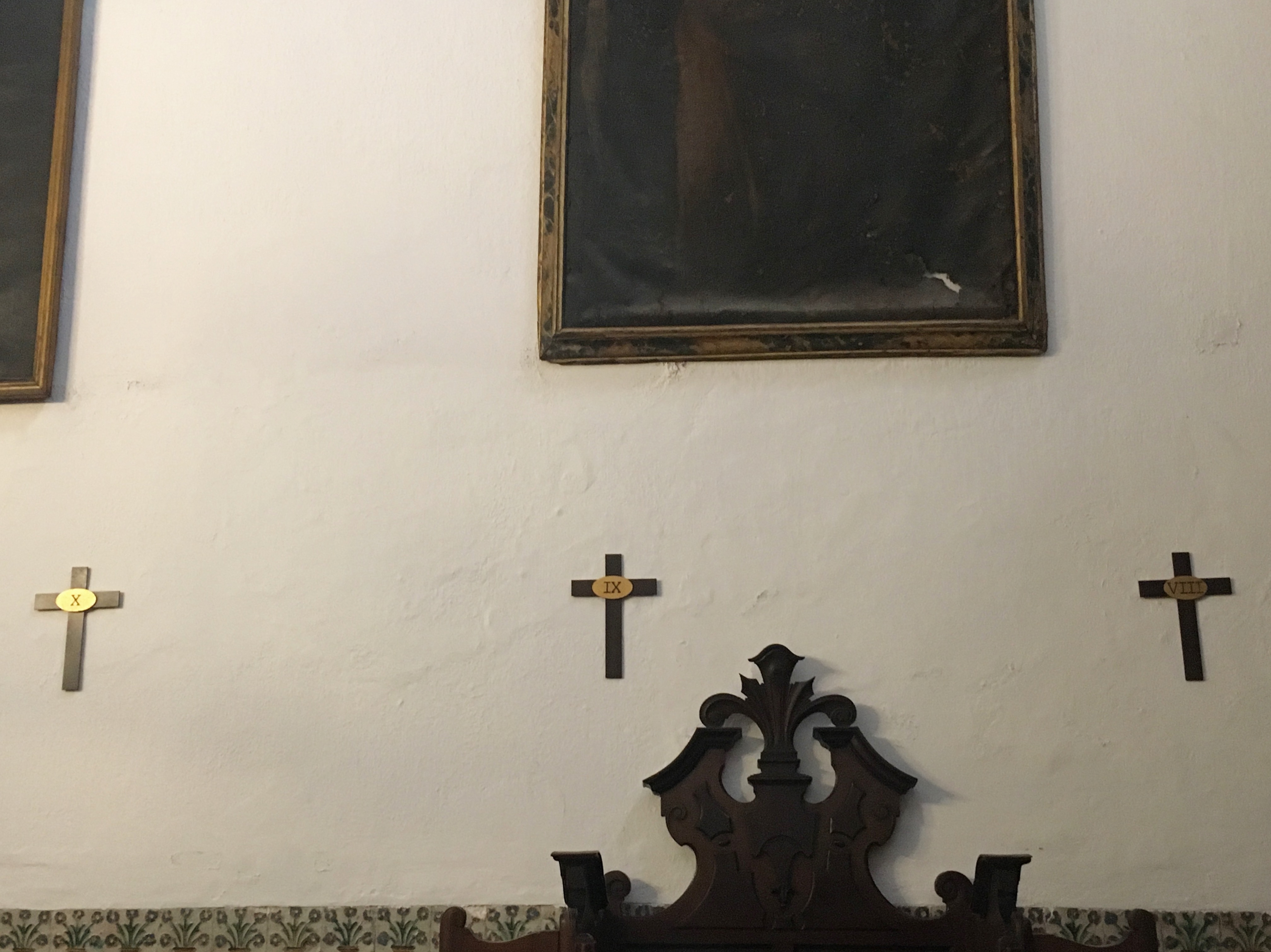
Towards the middle of the seventeenth century, Seville also started a slow decline which accelerated the college’s decay. In 1626, the great flood of the Guadalquivir River caused serious damage to the college buildings. The great plague of 1649 decimated a considerable number of students and staff. In order to maintain its existence, the college began to accept Spanish, Irish, and other foreign students. In 1662, the college counted with only five students; in 1692, only two. A year later, there were no English students at St. Gregory’s. The suppression of the Society of Jesus in 1767 was the final death blow of the Colegio de los Ingleses. After the expulsion of the Jesuits from Spain, part of the buildings of St. Gregory’s served as the headquarters of the Real Academia de Medicina of Seville until 1932, when, due to the poor state of the buildings, the buildings were demolished and replace by the present School of Hispanic-American Studies. The church, however, survived, and was leased to the Hermandad del Santo Entierro, one of the brotherhoods of the Sevillian Holy Week, and is today the headquarters of the Mercedarians at Seville.
Today the remains of St. Gregory’s no longer suggest an English presence. But just a few metres from the old Jesuit college and church stands the biggest department store of Seville: El Corte Inglés, ‘the English cut [tailoring]’, on a street where the presence of the English therefore continues to linger.
João Vicente Melo
A guest blog from our TIDE intern, Alex Claridge
Recently, Dr Lauren Working and I travelled to Norton Priory in Runcorn, Cheshire, to view the site and visit its collections. St Christopher, the patron saint of travellers, stood in the entrance hall of the museum to greet us on our arrival, as he had done for many travellers in the centuries before us. J. Patrick Green has suggested that the statue, possibly commissioned on the promotion of the Augustinian priory to abbey status in 1391, was chosen because of Norton’s proximity to the River Mersey, its role in the Mersey crossing, and its encouragement to be hospitable to travellers.
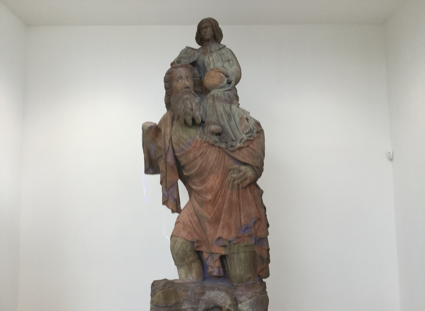
The priory’s reputation for hospitality has not diminished over the centuries, and we were warmly received by Lynn Smith, senior keeper of the collections. We met to discuss possible collaborations between Norton Priory and TIDE, starting with the project’s #gateofaccess social media partnership, which uses artefacts as points of access to tell stories of travel and transculturality in early modern England. During our trip, we found a remarkable range of objects that reveal the connections between Merseyside and the wider world. Norton Priory is the most excavated monastic site in Europe, and it was exciting to be in a hub of such active and ongoing research. The museum incorporates the medieval under-croft with its Norman arches, the Georgian wine cellar, and the first-floor ballroom, which is now converted into exhibition space. The upstairs offers a bird’s eye view of the archaeological site of the priory, where the cruciform shape of the church is easily identifiable, its nine-hundred-year-old foundations exposing a long history of human activity.
While the medieval and the Georgian eras are particularly well-researched, TIDE hopes to shed some light on the objects dating to the period in between, which demonstrate England’s reliance on travel and international connections. Of particular interest for our project were the leather shoes from the Tudor house (built on the site after Richard Brooke’s purchase of the priory in 1545), and the wine bottles, jugs, and seals connected with the later stately house. As with many of the medieval wares, the Tudor items demonstrate the international nature of the site, and include a drinking jug imported from Cologne via Chester and a German Bellarmine jug, decorated with the face of a wild man.
We were given free rein to explore the museum, which includes clay pipes, oil lamps, ceramics, a Tudor tyg (two-handled jug), and a female skeleton. The interactive displays highlight migration patterns and Runcorn’s historic links to Dublin, London, Flanders, Saintonge, Santiago de Compostela, Hippo, Rome and Jerusalem. The museum also contains a number of early modern cooking and dining utensils that further demonstrate the priory’s reliance on European commerce and networks of trade. Our visit concluded with a wander through the garden and the pear orchard. The head gardener guided us through the grounds’ marvellous array of plants, including the recreated medieval herb garden, and pointed out diverse planting typical to early modern English households.
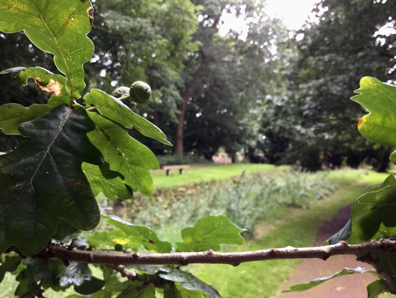
To me, the site visit to Norton Priory offered a glimpse into the value and importance of interdisciplinarity. Visiting historical sites, and having conversations with specialists in other disciplines, including botany and archaeology, broadened my understanding of the historical world beyond texts. Entering the spaces of the past, and seeing its physical remnants, gave me the opportunity to develop new perspectives on the past, ones that can enrich my academic research and my understanding of how humans in the medieval and early modern eras lived their lives. Physical objects can also help instil a sense of the past to non-academics, and can be an important means of providing wider frameworks for text-based research. I was thrilled to find that the visit opened up the possibility for future collaboration, not just for #gateofaccess but through other opportunities to engage with the public through seminars, talks, and even theatre.
Alex Claridge
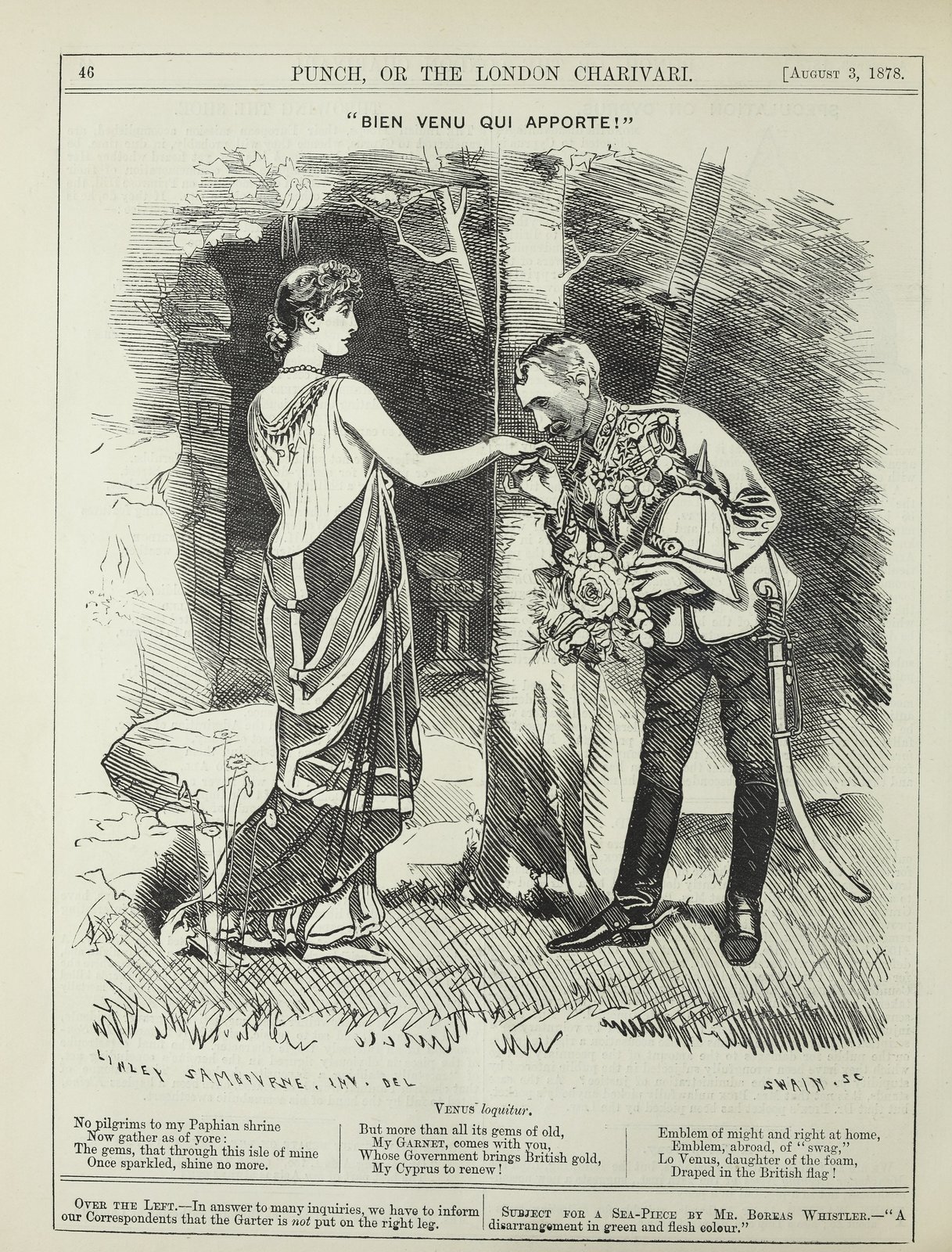
The romantic, widely-marketed image of Venus and her luscious island of love casts a respectable veil over the sex and sacrificial killing of ancient myth, orgiastic rites that early modern writers gleefully explored. But, in the later colonial period, there was a more nefarious return to those early modern perceptions of violent, excessive indulgence. Ancient and early modern myths matter, and persisted, in the making and unmaking of modern Cyprus.
When all was well with British rule in Cyprus, Venus was depicted as a friendly and pliant goddess. Punch magazine had her draped in the Union Jack to welcome Sir Garnet Wolseley, the island’s first High Commissioner. This very Victorian goddess – whitened and receptive – is the one most recognisable to us today. But she signified more than love, romance and meaningful gazes: Venus and her people were portrayed as willing subjects of domination. Sir Richmond Palmer, governor of Cyprus in the 1930s, made it clear when explaining that both Cypriots and their goddess ‘expect to be ruled, and, in fact, prefer it’ (quoted in Given: 423). In other words, Palmer expressed that Cypriots liked to be dominated.
In this phallocentric realm of control, Nicosia’s cabaret industry thrived as urbanisation and a heavy military presence overwhelmed the old side-alley brothels, with the house girls especially popular with the ‘Cabaret Government of Cyprus’ (Constantinou: 286). Then, between 1955 and 1959, during the vicious, chauvinistic campaign by EOKA (Ethniki Organosis Kyprion Agoniston/National Organisation of Cypriot Fighters) for an end to British rule and union with Greece, the image of Venus became a contested one. For EOKA, the goddess was easy propaganda, her Hellenic form of Aphrodite a sure indicator of what they saw as the island’s eternally Greek nature, justifying independence from Britain and union with the ‘motherland’.
British soldiers and civilians were dying at the hands of EOKA in those ‘emergency years’ and, coincidentally or not, the previously-overlooked issue of prostitution became a concern for the British press too. In the collective psyche, this was again a hazardous place of sexual indecency, just as it was in the sixteenth and seventeenth centuries. This time, however, that perception had effects beyond the stage and the page.
Further, responding to EOKA’s reclamation of the goddess, the colonial government championed her more explicitly Middle Eastern incarnation, Astarte. Late nineteenth-century visitors to Cyprus had often chosen Astarte, rather than Venus, as most appropriate to an island they considered as a non-European site, neither Greek nor Turkish. William Hepworth Dixon said it most straightforwardly: ‘In blood and race both men are Cypriotes’ (20). This was Cyprus as a standalone Middle Eastern site, with the pan-Mesopotamian Astarte as its emblem of diversity. But the colonial administration shifted the emphasis.
Elizabeth Alicia Maria Lewis wrote that Cypriots were more like Astarte than the Europeanised Venus of Punch because, like Astarte, they were ‘oriental’. By this, Lewis meant they were ‘slothful, mendacious, voluptuous’ (202). It was this analogy that the ‘Cabaret Government of Cyprus’ picked up on, an analogy that painted Cypriots as morally degenerate and racially impure, bolting genetic corruption onto the goddess’s ancient immorality. And the morally degenerate and genetically impure cannot govern themselves (see Given: 419–23; Papadakis: 239–40). They’re asking for domination, whether they know it or not. A recent batch of Foreign and Commonwealth Office files released to The National Archives lays bare the intention to polarise the island’s largest communities as racially incompatible, a process that would have to be ‘artificially induced [. . .] over a period of ten years or more’ (The National Archives, FCO 141/4363: ‘Partition’).
It is this vision of Greek-speaking Christians and Turkish-speaking Muslims as diametrically opposed, of their union as impossible miscegenation, which has led to the island’s division since the war of 1974. Those ‘artificially induced’ oppositions – enthusiastically adopted by fanatical Greek and Turkish nationalists and manufactured during British rule – are now so deep-rooted that the July 2017 collapse of the most recent UN-brokered talks for reunification were as unsurprising as they were upsetting. The erotic, bawdy myths surrounding Venus that were titillating inspiration for Shakespeare and other early modern writers have a very different political afterlife on the island, one that contributed to its devastation and ongoing division.
Roger Christofides
Constantinou, A. C. (2013), ‘Cyprus and the Global Polemics of Sex Trade and Sex Trafficking: Colonial and Postcolonial Connections’, International Criminal Justice Review, 23 (3): 280–94.
Dixon, W. H. (1879), British Cyprus, London: Chapman & Hall.
Given, M. (2002), ‘Corrupting Aphrodite: Colonialist Interpretations of the Cyprian Goddess’, in D. Bolger and N. Serwint (eds.), Engendering Aphrodite: Women and Society in Ancient Cyprus, 419–28, Boston, MA: American Schools of Oriental Research.
Lewis, E. A. M. (1894), A Lady’s Impression of Cyprus in 1893, London: Remington.
Papadakis, Y. (2006), ‘Aphrodite Delights’, Postcolonial Studies, 9 (3): 237–50.
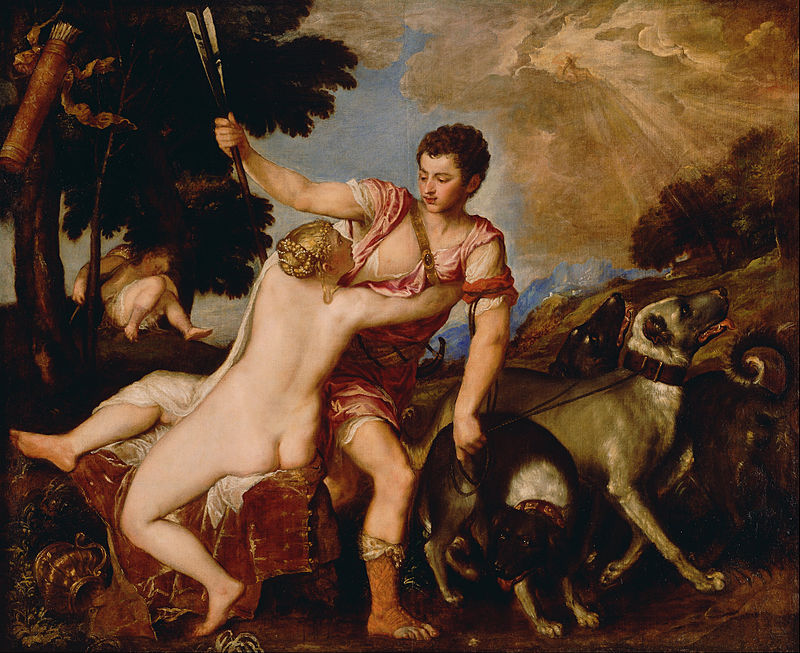
One summer morning, bright and early, the phone rang. It was my cousin, a radio show host. He was running a sketch on different places to visit over the holidays, with minor celebrities arguing the merits of one place or another. Having failed to land anyone recognisable to pitch for Cyprus, he asked me. So I answered the phone in my best Cypriot accent and pretended to be a ‘locally renowned’ bar owner from a coastal town. (We never decided on a specific town. And no one asked, which is just as well.) And then I pitched. Golden sand. Blue sea. The horizon’s still seam of water and sky. Sunsets melting into it. And then what people really want. Romance. Love. A glass of wine on a lonely beach table. An evening dress a-flow and an open shirt unbuttoned just enough. Meaningful gazes. Lastly, the money shot: ‘Leaving Cyprus will break your heart.’ And all of these familiar heteronormative signifiers worked due to the popular conception of Cyprus as the island of love, of Cyprus as Aphrodite’s island. This manufactured image is unavoidable today – the pictures of the goddess on souvenirs; the bars, restaurants and hotels bearing her name; and the Venus de Milo sculpture on the Cyprus Tourism Organisation’s logo above the slogan ‘Cyprus in your heart’. Yet the codes of mainstream romance the goddess embodies are far from how she was perceived in early modern times.
Arthur Golding’s influential translation of Ovid’s Metamorphoses, read to death by Shakespeare and his contemporaries, paints Cyprus as a place of lusts both unacceptable and violent. This is an exotic island where visitors were said to be sacrificed by pagan cults worshipping Aphrodite, and where a threatening climate of unchecked promiscuity bred children ‘voyd of grace’ (127, 128). The most famous of those children was Hermaphroditus, the intersex offspring of the goddess’s adulterous affair with Mars. Cyprus was a site of transgression, and Venus – to give her the Roman name by which she was then more commonly known – was the mythical embodiment of its transgressive propensity.
Venus’s love affairs and the aggressive sexuality she inspired were common themes. In Venus and Adonis, Shakespeare imagines her at her lascivious best as she desperately tries to seduce Adonis: ‘Graze on my lips, and if those hills be dry, | Stray lower, where the pleasant fountains lie’ (ll. 233–4). Thomas Lodge, in a poem in Robert Allot’s poetry compendium England’s Parnassus, describes ‘Her louely locks her bosome hanging downe, | Those nets that first insnard the God of warre’ (356). An angry Claudio in Much Ado About Nothing wrongly accuses Hero of unfaithfulness, comparing her alleged waywardness to the ‘savage sensuality’ of Venus (4.1.58–60 (60)). England’s Parnassus has an entire section dedicated to the goddess in which John Harrington’s poem ‘Of Cyprus’ celebrates the island as ‘lustfull, (for dame Venus meete) [. . .] With wanton damsels walking in each street, | Inuiting men to pleasure and repast’ (353). Harrington’s ‘wanton damsels’ were likely inspired by the myth of pre-marriage prostitution, where, as Stephen Batman’s translation of Bartholomaeus’s De Proprietatibus Rerum puts it, fathers offered up their daughters ‘to such straungers as came into the Countrye, to bée by them deflowred’ (fol. 221v). Romance. Love. Meaningful gazes.
That’s not to say that conventional associations with beauty and romance were not present too, but, in a way less apparent to those who read about or visit Cyprus today, Venus invoked orgiastic excess and danger. On her journey from Near Eastern classical myth to the stage and page of the sixteenth and seventeenth century, she became a more complex, sensual and pornographic symbol. This was, after all, the goddess who breathed life into Pygmalion’s statue so that he could ravish her. As Marston put it in The Metamorphosis of Pygmalion’s Image, she was the ‘sacred Queene of sportiue dallying [. . .] Whose kingdome rests in wanton reuelling’ (1598a: 12). And these mythical narratives of licentiousness ran so deep they permeated everyday speech. Venus was also known as ‘Cypria’ and the adjective ‘Cyprian’ signified both the place and the supposed amorousness of its people.
So should you happen to be in Cyprus having a drink served to you by a locally-renowned bar owner on the golden-sanded beach of a coastal town, perhaps overlooking lovers swimming beneath the Rock of Aphrodite, where the story goes she was born from the foam of the sea, consider the difference between our perception of the goddess and her birth place and that of early modern Englanders. When thinking about Cyprus, Shakespeare’s pitch for visiting Venus’s isle might have ended with a very different kind of money shot to mine.
Roger Christofides
Allot, R. (ed.) (1600), Englands Parnassus: or, the choysest flowers of our moderne poets, London: for N. L[ing], C. B[urby] and T. H[ayes].
Bartholomaeus, A. (1582), Batman vppon Bartholome, his booke De proprietatibus rerum, trans. S. Batman, London: Thomas East.
Marston, J. (1598), The metamorphosis of Pigmalions image, London: Edmond Matts.
Ovid (1567), The. xv. bookes of P. Ouidius Naso, entytuled Metamorphosis, trans. A. Golding, London: William Seres.
Shakespeare, W. (2011), The Arden Shakespeare Complete Works, R. Proudfoot, A. Thompson and D. S. Kastan (eds.), London: Bloomsbury.

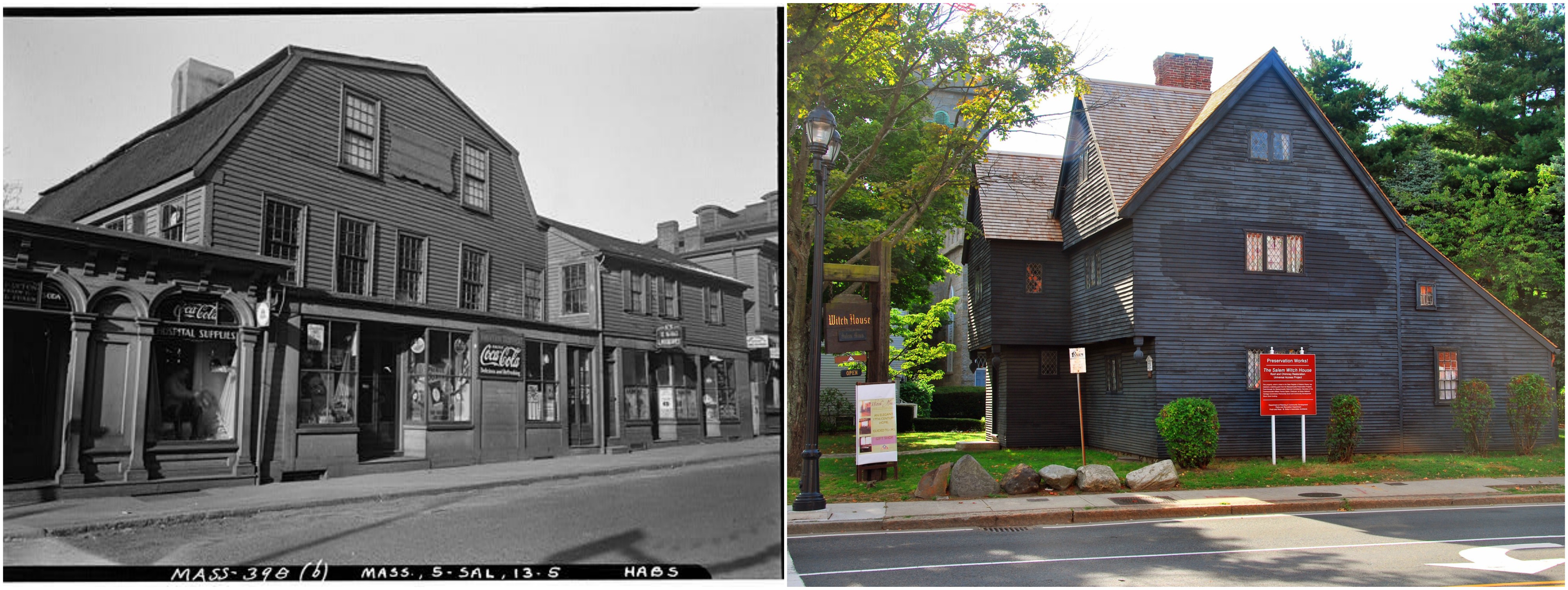
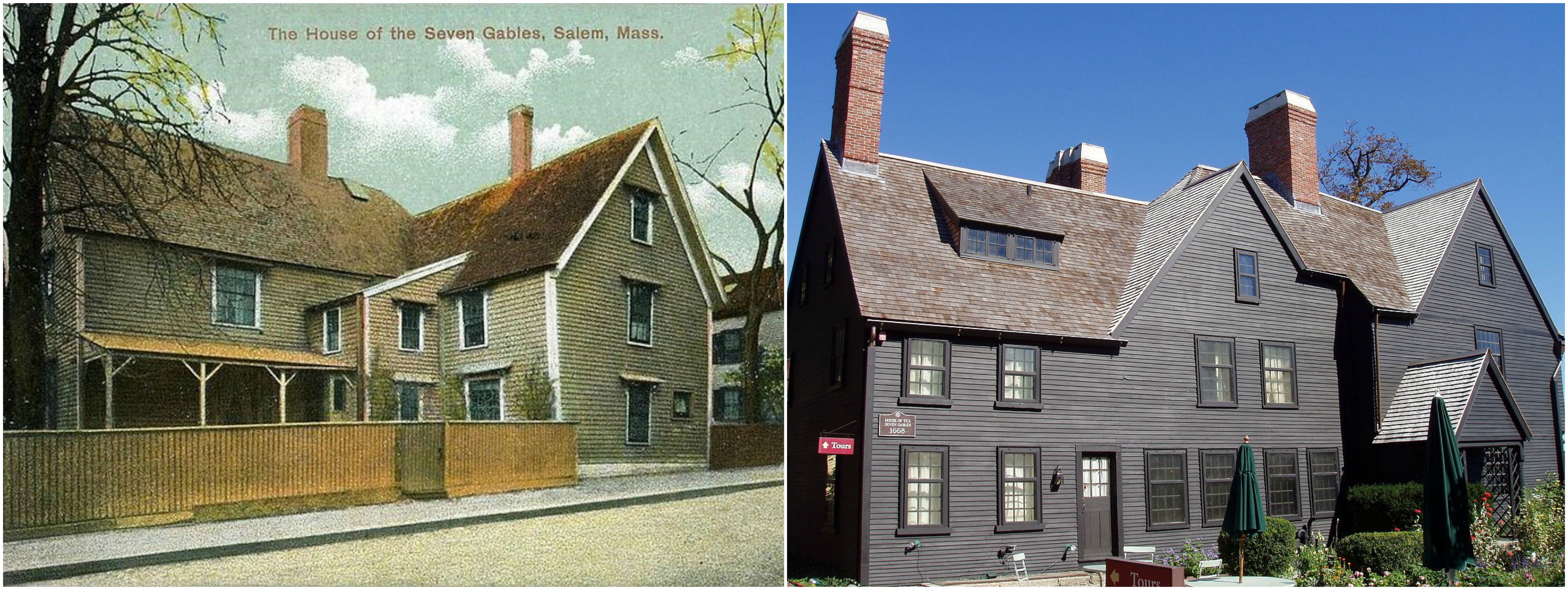

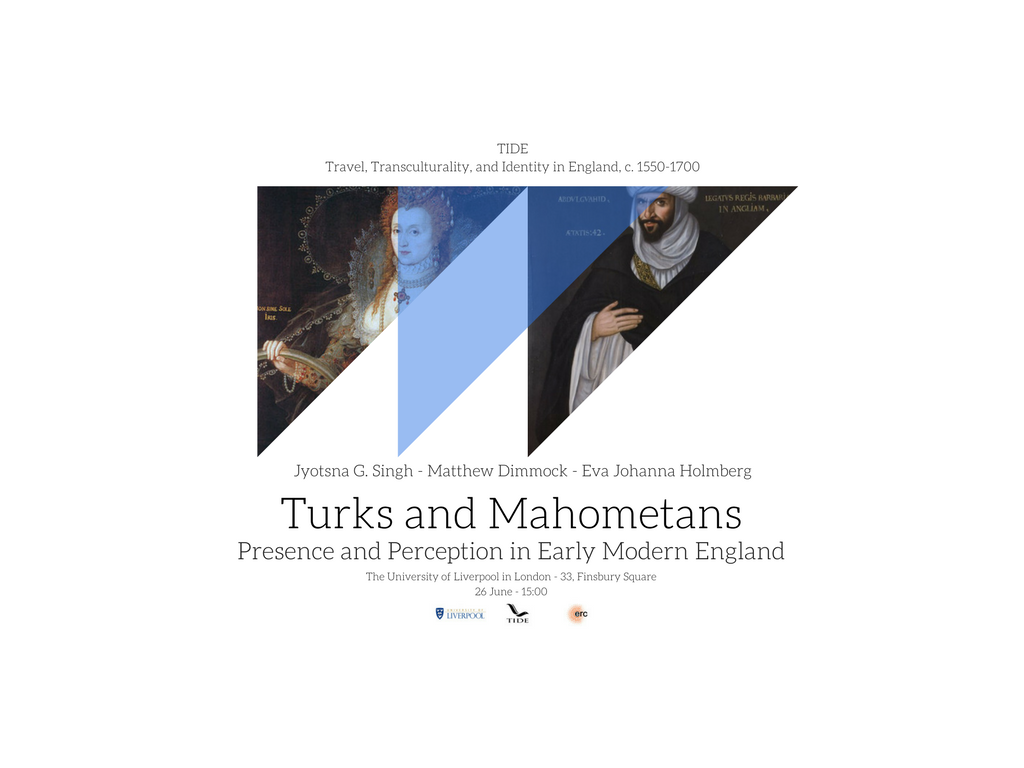
On 26 June, TIDE organized its second seminar of 2017 on the theme of ‘Turks and Mahometans: Presence and Perception in Early Modern England’ with Jyotsna G. Singh (Michigan State University), Matthew Dimmock (Sussex University) and Eva Johanna Holmberg (University of Helsinki; Queen Mary, University of London).
Jyotsna G. Singh’s paper, ‘English Encounters with Islam in Mughal India’, explored the perceptions of Islam and Mughal sociability in the accounts written by Sir Thomas Roe and Edward Terry during the reign of Emperor Jahangir (1605-1627). The self-entitled ‘Conqueror of the World’ ruled over a period of prosperity and cultural dynamism. As the ruler of an ethnically and religiously diverse empire, Jahangir continued the policy of religious tolerance adopted by his father, Akbar, which instigated a series of debates between different Islamic orthodox and heterodox factions. Islam and the thriving Indo-Persian culture of Jahangir’s court were, however, marginal topics in the first English accounts of Mughal India. Although the chaplain of Roe’s embassy, Edward Terry rarely analysed the Islamic movements or the theological debates that agitated the Timurid court, and his account is more concerned with ethnographic observations that could be relevant to the practical interests of the East India Company. Although not interested in the religious life of the empire, Roe was rather interest in Mughal practices of sociability. His regular contacts with relevant courtiers and officials were reflected in several passages where he described court rituals and the hospitality he received from Mughal grandees. Indeed, throughout his account of the hospitality offered by Jamaluddin Hussain, the governor of Bengal, Roe presents an image of Muslim civility and society that contrasted to the negative perceptions of Islamic peoples that circulated in early modern Europe.
On ‘Mahomentans invoking Mahometanism in Early Modern England’, Matthew Dimmock explored the experiences of Muslims based in England during the Elizabethan period. Early modern English works on Turks and Mahometans often reflected several tensions between the polemicist literature which depicted Islam as an erroneous belief, the emergence of England as a leading Protestant power against Catholic Europe, and the importance of expanding English trade to Islamic regions. The shared geopolitical interests between England and powers such as Morocco or the Ottoman Empire often influenced more or less positive views of Muslim peoples which, albeit refuting the supposed errors of Islam, highlighted the opposition of Turks, Moors and other Mahometans against the Catholic rivals of England – Spain, Portugal and France. An example of this perception is the sermon read in 1586 by Meredith Hanmer to celebrate the conversion of Chinano, a Muslim Ottoman born in Greece who was among a group of Turks enslaved by the Spanish that were captured by Sir Francis Drake in the West Indies. Unlike his companions, who returned to the Ottoman Empire, Chinano remained in England. Hanmer celebrated Chinano’s decision as both a triumph of Protestant Christianity over Islam and an English victory over Spain, but his The Baptizing of a Turke is particularly interesting for devoting several pages to the life of Muhammad in which Hanmer refutes the Prophet and the Alcoran, suggesting at the same time that Islam and Catholicism were two variants of an erroneous monotheistic belief based on idolatry. Hanmer’s diatribes against Muhammad suggested that ‘Mahometanism’ could be a stepping-stone to true Christianity, but they also served as pretext to use the conversion of Chinano as an allegory for the triumph of English imperial ambitions and Protestantism over Spain and the Catholic Church.
Eva Johanna Holmberg examined the English perceptions of non-Muslim communities in the Levant. Her paper, entitled ‘Slaves of the Sultan: Perceiving the Non-Muslim peoples of the Levant’, examined the English perceptions of the ethnic and religious minorities of the Ottoman Empire. English interest in the Levantine populations was motivated by the emerging literature with recommendations for travellers to gather information on geography, languages, government, religions, peoples and manners. English observers of the Levant were often impressed by the mobility and diasporic movements of the Greek, Armenian and Jewish communities of the Ottoman Empire. The fact that these communities lived under the rule of an Islamic polity, and the widespread use of Arabic by the Christian communities, was often perceived as a worrying sign of Islamization that undermined their unique identity and revealed a committed allegiance or acceptance of the rule of the Great Turk. The fact that the biblical regions between the Mediterranean Sea and the River Jordan were under Muslim rule, and occupied by a diverse population formed by Muslims, Jews, Orthodox Greeks, Armenians, Catholics and Syriac Christians, favoured the development of an idea of moral decadence of the heartlands of Christianity which simultaneously praised the superiority of England and Protestant Christianity. Jerusalem and the Holy Land were also considered to be the most adequate places to examine in situ the Jews, since this region was their ancestral home, and their customs less exposed to alien influences. Such concerns with the religious and ethnic integrity of the non-Muslim peoples of the Levant often reflected growing English anxieties related to the occupation of Ireland, the fragmentation of English Protestantism into different churches, and the commercial and colonial expansion in the Atlantic and Asia.
A roundtable coordinated by Nandini Das (TIDE) closed the seminar. The three speakers were invited to comment on the state of their field. Jyotsna G. Singh stressed the need to study the historical evolution of Islamic societies, in particular the Safavid and Mughal empires, and their connections to regions outside the influence of Islam as a central part of the early modern and contemporary worlds. Together with the need to explore with more detail Robert Cecil’s influence in the English efforts to extend diplomatic contacts to China and the Islamic world, Matthew Dimmock emphasized the relevance of understanding the evolution of English taxonomies employed to describe other peoples and religions, especially through comparative studies of English and other European experiences. Following these observations, Eva Johanna Holmberg accentuated the importance of collaborative works between different experts in the field, giving as an example the growing interest in merchant cultures and networks in the study of cross-cultural exchanges.
The issues and concerns raised by the speakers during the roundtable echoed the recent scholarly debates on Anglo-Islamic relations such as the panels on 'Globalism' and 'England and Islam' at the last annual meeting of the Renaissance Society of America (30 March – 1 April 2017), where scholars of the Islamic world have noted that the establishment of cross-linguistic collaborations between English scholars and experts on Islamic polities are renewing the field.
João Vicente Melo
Between 23 April and 5 May, TIDE welcomed Fred D’Aguiar as the first TIDE visiting writer. Poet, novelist and playwright Fred D'Aguiar was born in London in 1960 to Guyanese parents. He lived in Guyana until he was 12, and returned to England in 1972. He is currently Professor of English at UCLA.
His two first collections of poetry, Mama Dot (1985) and Airy Hall (1989) were published to much acclaim and won the Guyana Poetry Prize in 1989. Continental Shelf (2009), a U.K. Poetry Book Society Choice, was shortlisted for the UK’s T.S. Eliot Prize in 2009. His first novel, The Longest Memory (1994) won both the David Higham Prize for Fiction and the Whitbread First Novel Award, and was made into a film by Channel 4 (UK). His play, A Jamaican Airman Foresees His Death, was performed at the Royal Court Theatre (London) in 1991. Days and Nights in Bedlam, a radio play commissioned by BBC Radio 3, was broadcast and webcast in October 2005. Recently, he has published his seventh poetry collection, Rose of Toulouse (2013), and Children of Paradise (2014), a novel on the Jonestown killings.
During his residency in Liverpool, Fred took part in several activities organised by TIDE and the Centre for New and International Writing (University of Liverpool), including a public reading of his poems as part of the Miriam Allott series, a graduate masterclass, a creative writing workshop (in collaboration with the community organisation, Writing on the Wall), and a talk held at the London Review Bookshop with the historian, Catherine Fletcher (Swansea University), historian and broadcaster, David Olusoga, and TIDE Director, Nandini Das (University of Liverpool). Throughout his two weeks in Liverpool, Fred worked closely with TIDE’s research team, attended research meetings and seminars, and responded to the research material the TIDE team are currently collecting and analysing about the status of Africans in early modern England. Fred’s collaborative work with TIDE will result in the production of new writing in response to the team’s research.

To celebrate and mark the presence of our first Visiting Writer, TIDE interviewed Fred on his collaboration with TIDE, and the influence of history, transculturality, and mobility in his writing.
What are your impressions of TIDE and your time in Liverpool?
TIDE is a part of an old and venerable Northern institution, the University of Liverpool. If you think of universities outside London when you head up the M1, Liverpool is there, together with Newcastle, Manchester, and so on. And it is a coastal city in which, historically, I have always been interested because of the trade. It was one of the most important ports. And I was also interested because in the early 1980s, when we had all the rioting, if people had to name three cities, they would say the Brixton riots, and then they might say Toxteth, and then they might mention Bristol’s St. Paul’s. People would name Liverpool because the Toxteth uprisings were a signal that there was a black community that had the critical mass of numbers to stage a riot to be noticed. And then we realised that something was going on outside London in terms of a black presence because of that disturbance. So Liverpool has been there as a historical and cultural centre with a presence and significance for me.
I study TIDE because the project has two roles. The first is an institutional one, in that TIDE is a project within the university system of research and recovery. The second role seems to be a communal one, which is something I have been trying to do in my residency, by addressing those in forwards and backwards currents between the university and the community, particularly in terms of what TIDE has uncovered about black presences in Britain that predate the Atlantic trade. Within the community, things like the writing workshop that we did, (which I feel put people in touch with that early history), are really necessary. Also, you have a group of historians of different backgrounds and expertise, present in an English Department, another important crosscurrent. I think this is deeply inter-disciplinary in a really healthy way, because departments talk about cross-disciplinary practices, but it is very hard to make it a reality. My impressions are of a firm and memorable project with the capability of making waves academically and leaving a lasting imprint within the academy and in the community.

How did mobility and transculturality influence you as a writer?
Black Britishness is inherently transnational. If you look at a black presence in Britain, you then have to research the journeys made to the UK, and then it is interracial, because blacks married whites, there were christenings, births and deaths in church records. Diaries, such as the one kept by Pepys, mention black people as courtiers, and there are many narratives told through intermediaries or self authored (written by himself, herself) etcetera. So many sources, in fact, that you soon realise how interpretations of blackness become crucial to our understanding of a black presence on the island. So recovery is both a task of a cataloguing of blacks (who were they? Where were they? What did they do? How did they get here?) alongside questions about who helped them and who interpreted their behaviour and made it possible for them to live or not live.
I grew up in the Caribbean, I have a grandfather from Madeira, and these things are very interesting to me as cultural and geographical markers. I like the in-between-ness caused by mobility. It is very fertile ground for a writer. I think if you have a certain landscape, as I do with the US – same threshold relationship, of being there, but not quite there – you have this ‘in-between-ness’, this pivot between these places, where you make something that is quite fertile. It’s not just about building bridges between them; there is another territory that is created and imagined by virtue of this pivot. So I like that in-between-ness, and I like that threshold culture of moving from one place to another as something unresolved, in perpetual motion. What you carry, what you learn and pick up when you arrive, how you belong or do not belong, seems to be a continuous dance of being human. I am glad to have a third landscape. Before the US came into the picture, the Caribbean/UK nexus was a bit of a binary, (between Guyana and the UK). As a writer, I was not satisfied with it because there was always a third place, that I imagined, that could break that binary. And now, with the US, I have a geographical third space, and I am more contented with a trinity, not quite happy as a clam, but in awe of a rich complication of territories. It brings with it another tension, more nuances, another listening ear.
Your poetry and novels are inspired by historical events. How do you engage with historiographical works and materials from the past?
There is an essay by Toni Morrison,‘The Site of Memory’, in which she talks about the need to write the interior lives of people whose presences were sketched out too thinly, and so while their humanity is absent in the sketch, that same humanity is present in the stuff you do as a writer when you imagine a biography for them. Morrison’s essay, is about imagination and vision. For me, in the creative writing exercises at our workshop, I want people to really try to imagine some life for the people they are looking at as statistics, fragments, imagine an interiority for them, which amounts to the beginnings of a full life. As a writer, you jump across the divide between you and the material you recover or find. The act of recovery is not just pulling out a name, a date, a quotation or a location. It is really about a missing biography that you have to see, presume, imagine, and then envision on their behalf, because that fragment is all those badly represented subjects left as evidence that they were alive. For a writer that fragment becomes fertile territory. A second useful book, which compliments the Morrison essay is Simon Schama’s book, Dead Certainties. When facts end and you need to know more, how much can you imagine as a way to get from one piece of evidence to another? What is probable and likely is based on what you know. You can imagine a trajectory for that information on behalf of the character, because something is missing between two events. The act of imagination is to write a logical course for the person. But there is a kind of truth that researchers have to obey, which writers don’t have to be loyal to in order to function legitimately. Writers tend to take liberties with fragmentary evidence partly because we see our own location as a conversation with that fragmented information.

How do you think your work with TIDE will evolve?
I quite liked the creative writing workshop we did with Writing on the Wall. Many of the people who were there had never seen that material before, and I really liked some of their responses to the material. First of all we all arrive at the workshop with different expertise – PhDs, people currently studying for PhDs, people who left school early, poets, memorialists, novelists, people who write short stories, everybody was in the room. The great unifier of difference is vulnerability, so I thought the early material was good for them, because it was very unlikely that anybody would have seen it. It made people think ‘wow this way back, it is not something recent’, so that gave people a chance to respond in any form they wanted. It felt like a place where they could play with their imagination and take their chances, because everybody else was doing the same thing.
I want to see what everybody wrote and build something from there. It is unusual to have multiple responses to this type of material from the community, from different walks of life. And of course, I am going to think about what I wrote, what they are writing, and see what can be developed from there. And I will write something about the Slavery Museum and the May Day march which I found really a wonderful thing to do. I can see some parts to what I am going to do, and I am thinking about those parts, and this notion about academia and the community in some sort of dialogue.
I am fascinated by this early period in English history, a time in which gaps abound and where tracks lead back to Roman times. I would love to see a museum exhibition that really acknowledges black presences in Britain before the slave trade and its horrors, something before the de-humanisation of the process of slavery, something of human exchange, possibly assimilation as well. I think that it is important for school kids to see something of themselves that predate painful bondage. That’s one thing I took away from TIDE. That kind of presence, a human presence, before de-humanising slavery became dominant. The conversation with the present where groups want to claim space as theirs and exclude others, makes that early history a crucial one of perpetual cross currents, comings and goings and complex facets to acts of belonging.
1 May 2017 marks the five hundredth anniversary of the first documented race riot and greatest outbreak of violence against immigrants in early modern London. Its story is one of anxiety and frustration that was directed as much at the state as it was at the foreigners themselves. In our own climate of fear and insecurity, its themes seem strikingly familiar, but it also inspired one of the most impassioned pleas for the protection of refugees in the English language.
[…contd.]
The May Day riot of 1517 had disclosed a rift within English society. At the time, London’s immigrant community accounted for about 6% of the total population. The English cloth industry in particular offered a ready job market for Flemish and Dutch cloth workers, but there were also affluent communities of French, German, and Italian or ‘Lombard’ merchants who ensured English access both to European markets and trade, and to the crucial continental banking that governed that trade. However, while ostensibly setting the native English against foreigners and immigrants, the 1517 riot was much more fundamentally about widespread frustration among the common people with the state and the Tudor establishment itself. It set poor apprentices and labourers against what they perceived to be the affluent guilds and merchant networks of the city, and it set the city against the court. It fed on rumours of secret negotiations of the powerful, which lined the pockets of the already-rich, both English and foreign, at the cost of the livelihood of the ordinary Englishmen. Even a year earlier, on 28 April 1516, an anonymous bill stuck to the door of St Paul’s had accused the king and his council of financial collusion with foreigners ‘to the undoing of Englishmen’. The riot put both London’s status as a centre of trade and Henry’s own authority as a monarch at risk, and the nature of the uprising meant that the news was likely to circulate all the more widely internationally. It is probably only to be expected that the strength of the response of the authorities was as striking as the lack of preventative action leading up to the event.
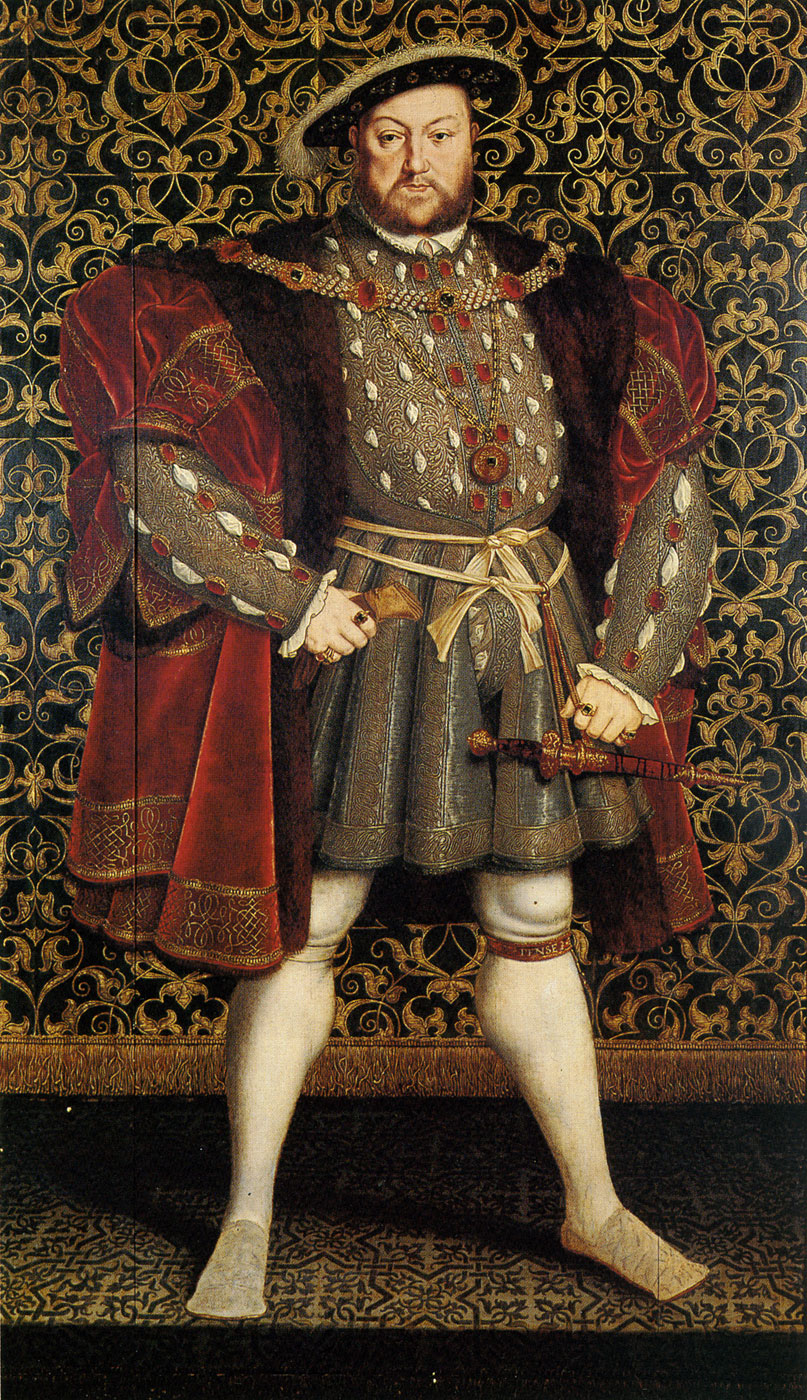
In the early hours of May morning, as the rioters started dispersing, the Mayor and his men arrested almost 300 people. Around 5 o’clock in the morning, the king’s forces led by the Duke of Norfolk and others entered the city, and the business of dispensing punishment began. The first trials took place on 4 May. The prisoners were charged not with rioting, but with the much more serious crime of high treason, on the grounds that attacking foreigners both breached the King’s peace within England, and put at risk the peace that Henry had established with all other Christian princes in continental Europe. It is not clear exactly how many men were executed. The two major contemporary historiographers, Edward Hall and the Italian humanist Polydore Vergil, mention 17 and 15 respectively, the Venetian ambassador, Sebastian Justinian mentions 20, while the Papal nuncio or representative, Francesco Chieregato, claimed the much higher figure of 60.
London was still essentially under a 24-hour curfew, with city proclamations specifying that women were to be controlled as strictly as the men, and were not allowed to ‘come together to babble and talk’ (Hall). Over 1300 soldiers brought by the Duke of Norfolk and the Earl of Surrey roamed the streets, and according to Hall, they ‘spake many opprobrious words to the citizens, which grieved them sore’. Hall’s account claims that most of the watermen, priests and servingmen guilty of rioting escaped, and only the ‘poor prentices were taken’, and that some of the boys arrested were little more than children, no more than thirteen years old. Even the account of Polydore Vergil, whose own immigrant status in England understandably made him far more critical of the rioters than Hall, noted in his History of Britain that some who were punished ‘had fallen in with that rabble…more by chance than any deliberation.’ However, Edward Howard, Knight Marshall and youngest son of the Duke of Norfolk ‘showed no mercy, but extreme cruelty to the poor younglings in their execution’. The Mayor and the King’s representatives then arranged to have 11 pairs of gallows to be set up at the main sites of the riot, from Aldgate and Blanchappleton, to Saint Martin’s and Newgate. According to Polydore Vergil, ‘This was a sight unseen in all previous ages, to see so many gallows erected at the same time throughout the city, and it distressed the townsmen’s minds so much that these were removed two weeks later.’ In the meantime, ‘like true subjects’ the people ‘suffered patiently,’ despite easily outnumbering the soldiers (Hall). It was clear that Henry and Wolsey would need to do something quickly to recoup both international prestige and peace in the city.
That political turn began on 7 May, when John Lincoln was brought to court. In his defence, he claimed, ‘My Lords, […] you knew the mischief that is ensued in this realme by strangers, […] many times I have complained, and then I was called a busy fellow: now our lord have mercy on me’. He was executed, but then there was a carefully-engineered dramatic last minute reversal of fortunes. A message of pardon from the king arrived to save the handful of other rioters scheduled to hang after him even as they had ‘the rope about their neckes’, and ‘then the people cried, ‘God save the king’. This was simply a practice-run. On 22 May, Henry followed this with a great public performance of royal power and mercy in the great hall at Westminster, specially hung with tapestry of cloth of gold and decorated with a canopy of brocade for the occasion. This was apparently the result of an intercession by Henry’s wife, Catherine of Aragon, but it is quite likely that the move was masterminded by Wolsey and Henry himself as a way of defusing the standoff between the people and the state. In front of fifteen thousand Londoners, the mayor and representatives of the city, and key courtly figures and lords of the realm, the king and Cardinal Wolsey rebuked both the city and the people for the riot and the danger that it had posed to the King and the state. Then the 400 men and 11 women arrested in the aftermath of the riots were brought in. They had been stripped to their undershirts, and each had a noose around their neck, as if about to be hanged. They threw themselves on their knees, crying for mercy. Cardinal Wolsey and the lords publicly interceded on their behalf, the king appeared moved, and finally relented, but not before more speeches about the rightful duties of citizens had been delivered, and ‘everybody wept for joy’ (Chieregato). Henry and Wolsey had managed to re-engineer the riot against aliens and immigrants into a means of publicly asserting royal power both over the city’s wealthy merchants and guildsmen, and the ordinary labourers, workers and apprentices.
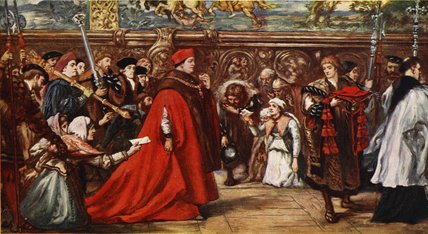
Riots would continue to occur in London from time to time, but the ‘Evil May Day’ of 1517 became notorious, as many historians have pointed out, because such violent outbreaks of resentment against foreigners was an exception in London, not the norm. Years later, however, as waves of Protestant religious refugees from trouble-torn Europe kept seeking shelter in the post-Reformation England of Henry’s daughter, Elizabeth I, radically changing the very nature of its neighbourhoods, and civic unrest became more frequent in the city once more, a group of writers would raise the ghost of that first race riot once again. More’s involvement in the events of the May Day riot forms a substantial part of The Booke of Sir Thomas More, co-written by Anthony Munday and Henry Chettle in the 1590s. Famously, it was criticized by the Master of Revels, Sir Edmund Tilney, who had the power to stop plays from being performed. On the top of the first page of the still-existing manuscript is his hand-written note, ending in what amounts to a thinly-veiled threat: ‘Leave out…the insurrection wholly and the cause thereof, and begin with Sir Thomas More at the Mayor’s sessions, with a report afterwards of his good service done, being Sheriff of London, upon a mutiny against the Lombards – only by a short report and not otherwise, at your own perils.’
Yet the revisions by multiple writers in the manuscript show no sign that his edict was obeyed. And in one of the most substantial additions, a three-page section that is now generally accepted to be in the hand of William Shakespeare, More addresses the rioting mob and invites them – and the audience – to engage in an act of collective empathy. Instead of the poor Englishman railing against the affluent foreigner, ‘Imagine that you see the wretched strangers,’ his More tells the crowd, ‘Their babies at their backs and their poor luggage,/ Plodding to the ports and coasts for transportation,/ And that you sit as kings in your desires […]’. Instead of the foreigner arriving on English shores, he asks them to imagine banishment, spurned like dogs from door to door, ‘like as if that God/ Owed not nor made not you’:
What would you think
To be us’d thus? This is the strangers’ case
And this your mountainish inhumanity.
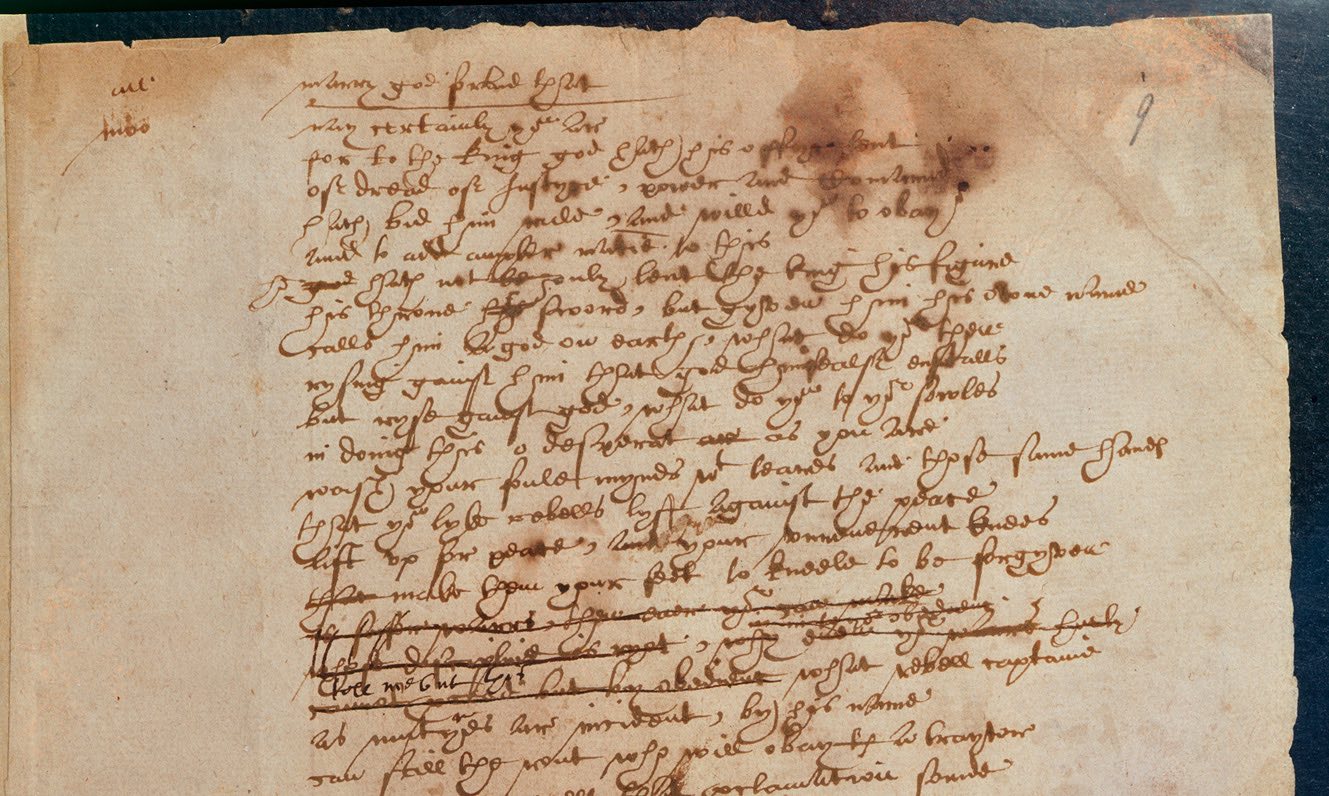
There is no record to show that The Booke of Sir Thomas More was ever performed, but quite understandably in our current climate of anxiety, More’s speech has gained a new popularity. Its humanity seems fresh and contemporary, its image of the ‘stranger’s case’ uncannily prescient, but perhaps its greatest achievement is one that remains implicit. In its very existence, in its insistence on acting as a mirror in which a harried, troubled, anxious English public sees its own face reflected in the face of a stranger in need, the play claims back the May Day riot from Tudor statecraft, which had tried so hard to turn it simply into an instrument of political maneuvering.
Nandini Das
1st May 2017 marks the five hundredth anniversary of the first documented race riot and greatest outbreak of violence against immigrants in early modern London. Its story is one of anxiety and frustration that was directed as much at the state as it was at the foreigners themselves. In our own climate of fear and insecurity, its themes seem strikingly familiar, but it also inspired one of the most impassioned pleas for the protection of refugees in the English language.
Fights among drunk young apprentices was common enough on the May Day holiday in London, but in the days leading up to the end of April, 1517, there were whispers on the streets about bigger trouble brewing. Following a tough winter and a severe outbreak of the dreaded sweating sickness, there was a rising sense of discontent among the ordinary people, and foreign merchants and workers became popular targets of that frustration.
Edward Hall (1497-1547) was a twenty-year-old student at King’s College, Cambridge, at the time. The report he would write subsequently in his Chronicle is inflected by his mistrust of foreigners and his bias against the Lord Chancellor, Cardinal Thomas Wolsey, but it gives us the clearest account of the events. According to Hall, things had been set in motion over two weeks earlier by a disgruntled broker called John Lincoln, who blamed the foreign merchants and workers in London for everything that was arguably wrong with the city. He tried to get Henry Standish, the preacher appointed to deliver the hugely popular Easter Monday sermon at St. Mary Spitall in Bishopsgate, to drum up popular support for his cause. When Standish turned him down, he approached the designated preacher for the Tuesday, a Dr Bell or Beale. On the day, Bell began his sermon with a ‘pitifull bill’ about the ‘extreme povertie’ of the king’s subjects. The ‘aliens and strangers eate the bread from the poore fatherless children, and take the living from all the [artisans], and the entercourse [business] from all the merchants’, he claimed, and the only solution was a public uprising: ‘as the hurt and damage grieveth all men, so muste all men set to their willing power for remedy, and not to suffer the said aliens so highly in their wealth’. After all, God gave this land to Englishmen, ‘and as birds would defend their nest, so ought Englishmen to cherish and defend themselves, and to hurt and grieve aliens for the common weale’.
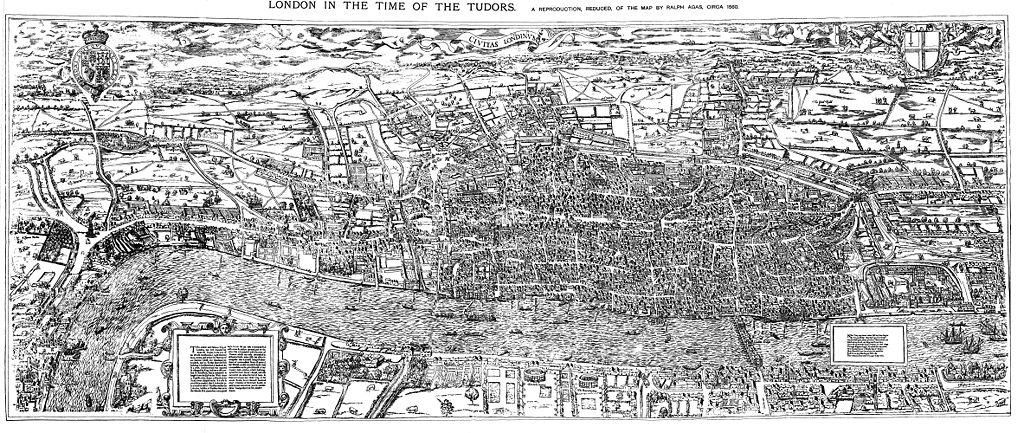
Small acts of violence started soon after, till on 28 April, a small group of young Englishmen were arrested for assaulting ‘Aliens as they passed by the streets’. That triggered what Hall describes as a ‘common secret rumour’ about a planned insurrection on May Day, when the city would ‘rebel and slay all Aliens’. Foreigners in London were obviously anxious. Hall mentions that many of them ‘fled out of the city’ as a precaution, and the Venetian Ambassador, Sebastian Giustinian later wrote back in his report to the Venetian Signory that he ‘represented this state of things to the Cardinal [Wolsey], who promised to make provision against any accident on that day’, but Wolsey and the Tudor establishment showed no actual signs of responding to the threat.
What happened next on 30 April 1517, the day before the riot, shows every sign of an administrative fiasco, in which a last-minute scramble to put safeguards in place to ensure civic safety ended up instigating the very thing it wanted to avoid. That morning, frustrated that despite his reassurances, Wolsey showed no signs of taking the threats seriously, Giustinian the Venetian ambassador decided to take matters in his own hands. His report to the Signory notes that ‘being warned of many threats used by the populace, and having witnessed many acts of violence perpetrated by them, [he] went to Richmond, where the King was residing, and showed him the peril to which all foreigners were exposed.’ Henry’s response was to assure Giustinian that he would ‘take every precaution’, although all he did was to spread the news that he was going to return to London with a large army to impose peace, ‘though in reality he never quitted Richmond’. Giustinian’s audience with the king, however, obviously got Wolsey to act: he summoned the mayor of London and the city council, and demanded if they knew anything about the rumours of the planned riot. ‘”No surely,” said the Mayor,’ according to Edward Hall’s account, ‘and I trust so to govern them that the king’s peace shall be observed.’ Then he hurried back to find out whether city officials were aware of the rumour. By this time it was 4 o’clock in the afternoon. By 7 o’clock in the evening, the Mayor and the city officials had panicked enough to hold an emergency meeting in the Guild Hall to decide on the measures to be taken. After much debate, they decided that the two options were to either impose a curfew or organise a ‘set of honest persons [and] householders’ to patrol the streets, and a message was sent to Wolsey just before 8 o’clock in the evening for his order. Half an hour later, Sir Thomas More, then undersheriff of London and Richard Brooke, Sergeant at Law, arrived with Wolsey’s decision, that a curfew would be imposed till 7 o’clock the next morning.
With the drinking and the festivities on the eve of the holiday already in full flow on the streets of the city, the aldermen of London now had barely half an hour to impose that curfew and get everyone back in their houses. One of the aldermen to rush back to their wards was Sir John Monday [or Munday], who saw two young men indulging in a bit of impromptu fencing or ‘playing at bucklers’ while surrounded by a large group of spectators. He asked them to leave, and when one of them irreverently asked why, he made the mistake of trying to drag him away physically by his arm. That small spark was enough: the standard rallying cry of apprentices, ‘Prentices and clubs,’ immediately started up around them. Munday managed to escape with his life, but the damage was done; the riot had begun. By 11 o’clock at night there were about seven hundred angry Londoners in Cheapside, from ‘serving men and water men [to] courtiers’, and within a short space of time their number had more than doubled to over a thousand. The mob stormed Newgate prison and took out the men who had been put under arrest on 28 April for attacking foreigners.
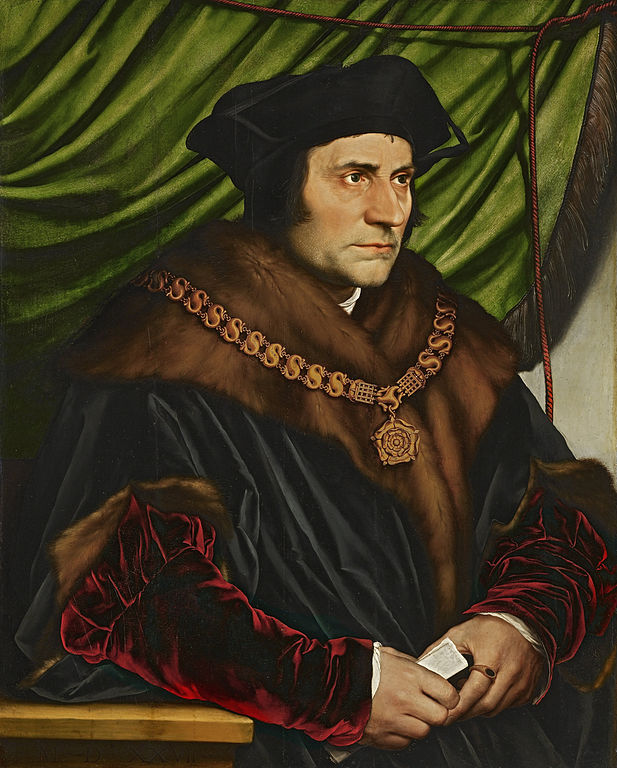
At Saint Martin’s, where a large number of mostly Dutch and French artisans lived, Sir Thomas More, in his capacity as the under-sheriff of London, almost persuaded the rioters to stop. However, in a moment of dramatic misunderstanding, some of the bricks and hot water that the besieged householders of Saint Martin’s had started throwing out on the mob struck a sergeant of arms called Nicholas Downes who was standing with More. His angry response, crying ‘Down with them’ in pain, was picked up immediately by the mob, and the riot continued.
At Leadenhall, they attacked the house of John Meautys, a merchant from Picardy and a secretary to King Henry VIII, who was suspected of harbouring French pickpockets and unlicensed foreign wool-workers. According to a report in the chronicle of the Grey Friars of London, Meautys barely managed to escape with his life by apparently hiding in the gutters of his house, but his house was looted. In Blanchappleton near Aldgate, the mob looted the houses of foreign shoemakers, and threw their stock into the streets. Although no deaths were reported, hundreds were injured – both foreigners and well-meaning Londoners who tried to pacify the rioters – and a swathe of destruction and unrest continued to spread across the city for over four hours. Worried about things going completely out of control, the Lieutenant of the Tower of London, Sir Richard Cholmeley, ordered his men to fire ordnance into the City, but ultimately the riot ran out of steam naturally. By 3 o’clock on May Day morning, peace had been restored in London. Now it was time for both the city and the Tudor establishment to pick up the pieces.
Nandini Das
[To be continued…]
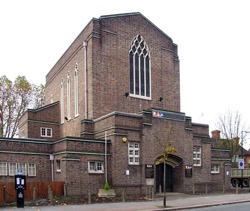
As 2016 drew to a close, Acton in West London hosted a number of dignitaries for the consecration of the first Syriac Orthodox Cathedral in Britain, St Thomas Cathedral, an event which at the time received very little media attention. Amongst the many notable figures in the congregation, were Prince Charles, Richard Chartres, the then Bishop of London, and the Patriarch of Antioch, His Holiness Mor Ignatius Aphrem II. The occasion was both a celebration of the flourishing Syriac community in Britain, and a sombre reminder of the plight of a community who having fled their homeland, in Syria and Iraq, have settled in Britain. To historians of migration, the position of the Syriac community in Britain today is a familiar story shared by differing religious communities across the centuries.
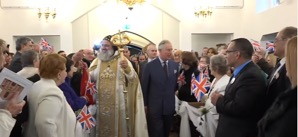
In his short speech to the congregation Prince Charles noted the dual symbolism of the occasion. Not only did the consecration of the Cathedral mark a ‘deeply encouraging’ moment for the Syriac community in Britain, but it also highlighted the ‘unbearable misery and anguish that have been so cruelly inflicted upon’ the Syriac Christian community in the Middle-East. The leader of the Syriac Orthodox Church in the UK, Archbishop Mor Athanasius Toma Dawod, noted that although a celebration the event was bitter sweet as ‘our joy has not been complete, as all our churches have been left in ruins after ISIS destroyed them.’
Refugees fleeing religious persecution is an old story. Since the middle of the sixteenth century, Europe was engulfed in repeated religious conflicts which reached its climax during the Thirty Years’ War (1618-1648), and displaced thousands of people across the continent. One of the most influential moments in triggering mass religious migration was sparked by the Edict of Fountainebleu in 1685 (also known as the Revocation of the Edict of Nantes). The Edict, which significantly curtailed the rights of the Calvinist Protestants of France (also known as Huguenots), marked the high point of two centuries of intermittent persecution against communities on the basis of religion in continental Europe.
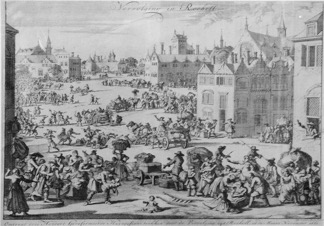
One seventeenth century minister graphically wrote of the plight of the people caught up in the upheavals. John Bulteel, a migrant minister, wrote of ‘the Churches of Germany swimming in their own blood, those of France in their tears, all in the midst of their ruin and apprehensions of greater dissolution.’ In England, he concluded, ‘these poor flocks’ had been ‘received, and put under covert as in a place of refuge and sanctuary of a holy temple.’
The idea that Britain was a religious sanctuary for persecuted religious communities was popular motif in the seventeenth century. One Armenian migrant, and merchant proclaimed that “the English nation hath always been esteemed in foreign countries for their civility towards strangers.” In a petition to Oliver Cromwell in the Spring of 1656 a group of French and Dutch Protestants wrote how they fled to England’ thereby swapping ‘persecution for protection’ And where, living under the protection of Cromwell and the English government the petitioners they ‘accounted themselves most happy.’
That said, then as now, refuge was often accompanied by hostility. For, many of those who arrived in England continued to face public paranoia and hostility. While the 1656 petitioners expressed their happiness to have escaped oppression in Europe, the main body of their petition detailed the behaviour of local English people, who on several occasions burned down their Church and burned carrion on their consecrated ground. Even the Armenian merchant primarily complained that he had been tricked out of money and left destitute by an Englishman.
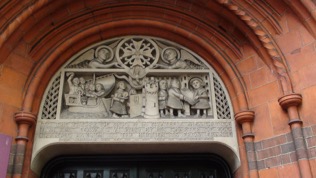
In her letter to the congregation at St Thomas,’ the Prime Minister, Teresa May declared that ‘the appalling violence that has afflicted so many areas of the Middle East reminds us how fortunate we are to live in a country where different religious beliefs are not only tolerated, but welcomed.’ That may well be, but many in the congregation would have noted that her government had refused to allow three Archbishops from the Syriac Church to enter Britain to attend the cathedral’s consecration. Britain may be proud of its history of religious tolerance, but this is by no means an unproblematic legacy.
Haig Smith
TIDE is delighted to have this blog post co-hosted on the Refugee History website. Read more about their activities at refugeehistory.org.
On 20 March, TIDE organized its first seminar of 2017 on the theme of ‘Catholic Transculturality in Early Modern Europe’ with Jane Stevenson (King’s College, University of Aberdeen) and Peter Davidson (Campion Hall, University of Oxford). ‘The Royal Nun: religion and exile’, the paper presented by Jane Stevenson, examined an oratorio performed and probably written in St Monica's, an English Augustinian convent in Louvain. Peter Davidson’s paper, ‘Cultural bilinguality in baroque America?’, explored the connections between the European baroque and the Mexican and Andean visual imagery. The following text and images are an excerpt of Peter Davidson’s paper that show us how the dialogue between the visual imagery of Europe and America created hybrid works of art that could be read in two visual languages simultaneously.
These four images raise a fascinating possibility, that Peter Paul Rubens had seen the culturally-hybrid Andean image originating from what is now Bolivia known as The Virgin of the Cerro Rico of Potosí. Rubens certainly changed his design between his first sketch and the final version to alter the outline of the mountain and to add the sun and the moon on the columns. The more the two images are contemplated, the more the possibility of influence from America to Europe seems worth considering. Certainly, Rubens was working for the Antwerp Jesuits at this time in his life, and Jesuits from the Flemish province had taken part in the missions in South America. Further food for thought is offered by the presence in the carving of the marble altar-rails (dated 1653) of the Antwerp Jesuit church of the grain plants of the Americas: maize, quinoa and amaranth, an iconography remarkable in its implications of dialogue and cultural inclusion.
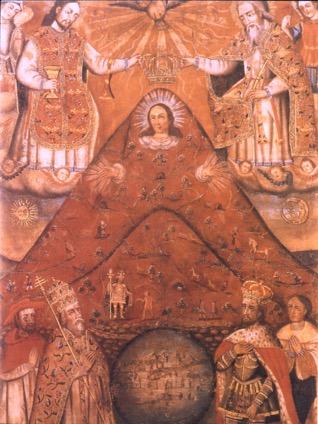
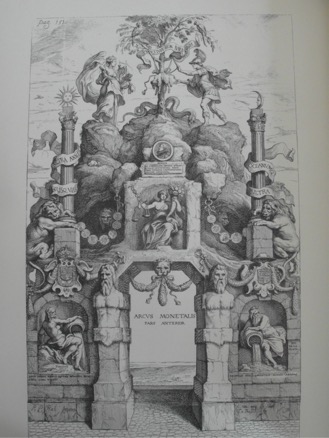
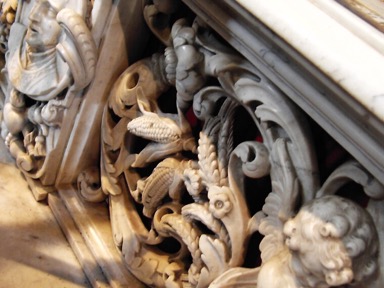
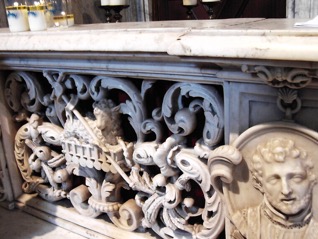
Peter Davidson
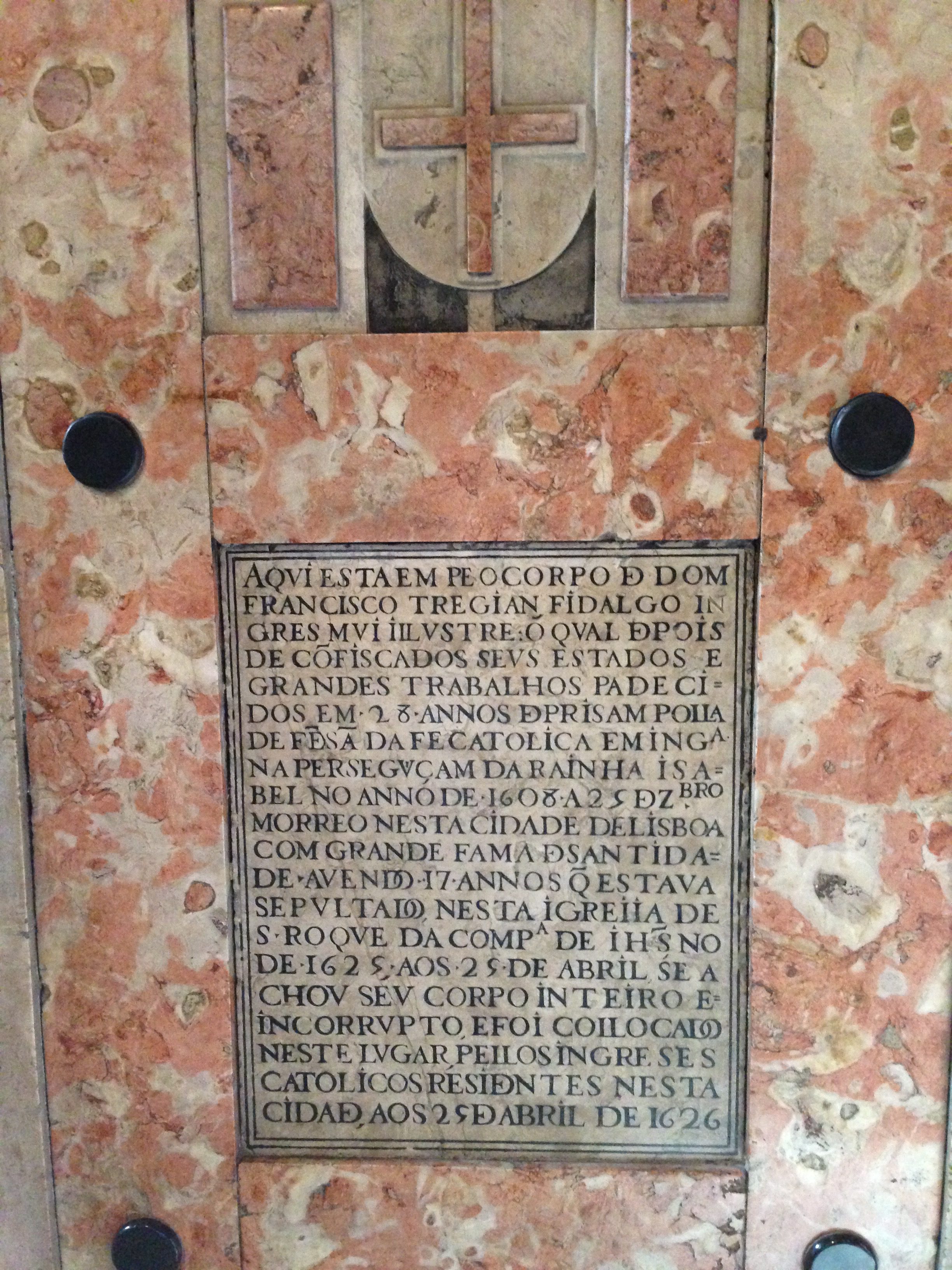
Those who visit the Saint Roch Church in Lisbon would probably pay more attention to the extravagant baroque chapel of St. John the Baptist, than to the little tomb of an Englishman who died in 1608 named Francis Tregian. Some four hundred years ago, the resting place of the first Catholic recusant to lose his entire estate under Queen Elizabeth attracted several visitors who hoped to be blessed by a man who died in the odour of sanctity.
Tregian was one of the wealthiest men of sixteenth century Cornwall, with an estimated estate worth three thousand pound, a considerable amount for the period. His wealth and support to persecuted recusants made him an obvious target during the Elizabethan repression of Catholics. On the night of 8 June 1577, Tregian was arrested for lodging Cutberth Mayne, an English missionary from Douai accused by the Elizabethan authorities as a Papal agent sent to prepare a rebellion against the Queen. However, Tregian’s biographer, probably inspired by the growing reputation of Elizabeth as a depraved woman across Catholic Europe, suggested that real motive behind his arrest was his refusal to the Queen’s improper advances.
Doubts surrounding Tregian’s trial forced the initial death sentence to be remitted to life imprisonment and the definitive confiscation of his estate. After almost twenty-eight years as an itinerant prisoner, Tregian was released by James I in 1606 and permanently banished.
Like many Catholic exiles, Tregian’s first stop was Douai. He then travelled to Madrid where he was received by Philip III, who granted him a life pension for his staunch defence of Catholicism against Elizabethan heresy and repression. After receiving his pension, Tregian settled in Lisbon with his family.
The Portuguese capital, then under Spanish Habsburg rule, was one of the main destinations for Catholics fleeing England. The city was easily accessible from the north Atlantic and, was one of the main economic hubs of early modern Europe which had long-established trade links with England, and offered many economic possibilities. Lisbon also offered another precious advantage as a Catholic refugee. Iberia was not troubled by the religious wars afflicting the Low Countries and France, which had been the initial destination for the first waves of English recusants. It was precisely the relative safety of Lisbon that led a group of English Bridgettine nuns to settle in the city in 1594, after a peripatetic existence between England, Flanders and France.
The arrival of the wandering English nuns was a propaganda coup for Spain, a clear demonstration of Philip II’s role as the leader of the Catholic world. However, the English Bridgettine became a serious problem for the Portuguese ecclesiastical authorities. Regarded as the last survivors of the English religious order, the nuns developed a particular institutional and national identity. During the exile in Spanish Flanders, the English Bridgettine sought to segregate themselves from their foreign sisters and to recruit only English women. These isolationist practices troubled the archbishop of Lisbon, who refused to grant such privileges, considering that they violated the rules of the Bridgettine Order and the decrees of the Council of Trent. The dispute would only be solved after the intervention of Pope Clement VIII, who decided to place the English nuns under papal protection, ensuring that they would always be allowed to only recruit their countrywomen.
The efforts made by the English Bridgettine nuns to preserve a distinct English identity was something shared by other Catholic refugees. The increasing association between Protestantism and Englishness made the identity of Catholic exiles extremely complex. In the eyes of many English Protestants, the fact that some recusants decided to leave England, and embrace the life of and exile under the protection of foreign rulers, made their Englishness and actions particularly suspicious. Such accusations led some exiles, like the Bridgettine nuns, to develop a sense of Englishness based on an ostentatious rejection of the cultural practices of their host societies, an attitude that, as the reaction of the archbishop of Lisbon reveals, often clashed with the cultural inclusiveness of the early modern Catholic world. Others, however, sought to accommodate their English identity with foreign cultural currents and modes of sociability. Students of the English colleges of Rome and Valladolid, for example, often used Italian and Spanish as their preferred idioms.
When Francis Tregian’s tomb was exhumed in 1625, the local English Catholic community sensed a rare opportunity to solve the tension between their national identity and Catholic universalism. Tregian’s body was found to be uncorrupted, confirming the odour of sanctity that surrounded his death. The news of the uncorrupted body attracted many Lisbonians to Saint Roch’s Church and rumours of miracles associated to the English recusant started to circulate across the city. Aware that Tregian could generate a popular cult and had the potential to be canonised, the English exiles staged a solemn ceremony to rebury the body. Attended by many locals, the ceremony celebrated Tregian as an English Catholic hero. The body was buried standing up (an allegory to his resistance to Elizabethan repression) in a new elegant, but discrete tomb in the west pulpit. While the epigraph was in Portuguese, the text celebrated the heroic and moral virtues of an Englishman who resisted against Protestant heresy. This option allowed the English Catholics of Lisbon to accommodate their Englishness to the host society, as well distinguish themselves from their Protestant countrymen who also lived in the city. In other words, Tregian’s tomb was creatively used as a symbol of Catholic Englishness which allowed exiled recusants to state their national identity and be a part of their host society.
João Vicente Melo
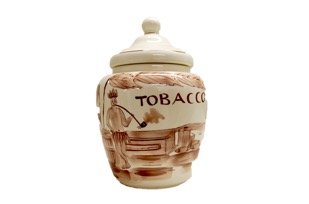
What is #Gateofaccess?
‘Any object, intensely regarded,’ observes Buck Mulligan in James Joyce’s Ulysses, ‘may be a gate of access to the incorruptible eon of the gods’.
We’ll leave presumptions about the eon of the gods to neoplatonists, but we at TIDE thought ‘gate of access’ aptly conveyed the importance of objects in engaging with the past, and, with it, the human condition. The term evokes the potency of objects and texts as artefacts, which transport us beyond what we think we know and push us to new knowledge.
In light of this, we’ve designed our new Twitter hashtag, #Gateofaccess, to focus on objects from English collections that enrichen our understanding of transcultural exchange in the early modern period. A sixteenth-century glove, for example, worn by an Englishman but stitched with Venetian silk using Indian chintzes, indicates the influence of other cultures on consumerism and taste in Elizabethan England. Africans in Stuart portraiture, or English governors or ambassadors depicted wearing Native American or Persian accessories, might be used to raise questions over ethnic difference and social status. How, we might then ask, do these examples of cultural hybridity complicate the anxieties about foreign influx and influence so often depicted in printed works?
One day a week, in series that last four to six weeks, our Twitter account, @ERC_TIDE, will exhibit objects in partnership with a particular museum or collection. Working closely with curators and archivists, these tweets will showcase objects of transculturality while highlighting the archives belonging to a range of local and national galleries and libraries. By working with various cultural institutions and research departments, #Gateofaccess will explore how objects can help foster a dialogue about the past, while encouraging more people to engage with their history through art and cultural institutions.
Our first showcase: tobacco and global competition
Our first #Gateofaccess is a collaboration between TIDE, Liverpool Special Collections and Archives, and the National Pipe Archive. Thanks to the robust efforts of John Fraser (1836 – 1902), secretary of printing and publishing for Cope’s Tobacco Company in nineteenth-century Liverpool, the university owns an abundance of early modern tobacco treatises and pamphlets. Beyond printed works, the National Pipe Archive houses their vast collections of pipes, tins, jars, and related objects, at the University of Liverpool’s Department of Archaeology.
These objects reveal the transcultural elements inherent in sixteenth and seventeenth-century debates about health, morality, imperialism, and pleasure. Mingling concerns over global competition, religious orthodoxy, and a fierce sense of national pride, tobacco became a battle ground over which English anxieties over identity were fought.
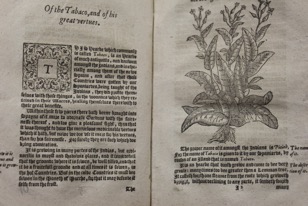
Medicinal texts like John Frampton’s translation of Nicolas Monardes’ Joyfull newes out of a new-found world (1596) explored fundamental questions about the properties and effects of tobacco. Did tobacco ‘corrupt’ the body? If it was indeed ‘healthful’, as some doctors claimed, did it corrupt the soul? A copy of Monardes’ Joyfull newes in Special Collections here at Liverpool indicates that the owner of the treatise actively used the book to solicit medical advice. The marginalia notes the cures that American commodities might provide for such ailments as the ‘gut & sweat’. Treatises about tobacco highlight both texts as objects, passed around and annotated, and illustrate the transculturality of tobacco debates: Englishmen were reading texts written by the Spanish and French, about a plant cultivated in America and smoked by ‘pagans’.
As for the pipes themselves, they show us that beyond written debates about medicine and the ethics of smoking, the material object influenced English social rituals and reflected the successes of imperialism through the booming tobacco trade. Pipes with the smallest bowls were made in the early seventeenth century, while the larger pipes indicate the availability and low cost of tobacco by the later seventeenth century, as English tobacco exports from the colonies escalated. The historian Edmund Morgan went so far as to liken the Virginia of the 1620s to the rough frontier towns of the Klondike during the 1890s gold rush, a ramshackle world where merchants, labourers, and surveyors arrived with dreams of striking rich.
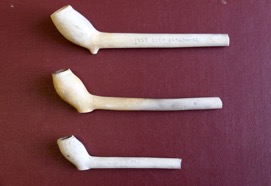
The colour of the clay, too, tells a story of cultural difference. While keeping the overall form of the bowl and stem, the English rejected pipes modelled on those of the Algonquians who taught them to cultivate the plant in North America. Rather, pipes in England, from the earliest examples, were made of the whitest possible clay, eschewing overt associations with Native American ritual. Of the thousands of tobacco pipe fragments that survive, there is no evidence of a single example of a Native American pipe, characterised by darker clay and thicker, larger bowls. The absence of evidence in the archive can be as indicative as what is included in it.
Our #Gateofaccess series launches on Twitter this week @ERC_TIDE. Don’t hesitate to contact the project’s public engagement coordinator, Dr Lauren Working (l.working@liverpool.ac.uk), to discuss #Gateofaccess collaborations in more detail.
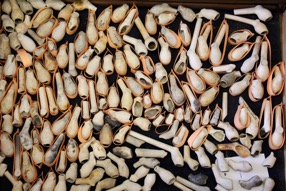
Lauren Working
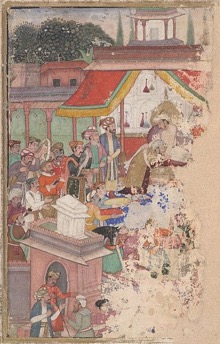
On 1 February, the Global History and Culture Centre of the University of Warwick held a workshop on Cross-Cultural Diplomacy Compared: Afro-Eurasian Perspectives (16th-18th Centuries), part of a series of events organized by the Leverhulme Trust funded project Cross-Cultural Diplomacy Compared led by Guido van Meersbergen. Focusing on the diplomatic interactions between Europeans and South Asians, this project aims to expand our understanding of early modern cross-cultural exchanges and develop a truly global perspective on the transcultural dimensions of early modern diplomacy.
The workshop gathered a number of specialists in diplomatic, cultural, and global history to discuss their own work and the recent trends in Global History and New Diplomatic History. Joan-Pau Rubiés surveyed the conceptual and methodological questions surrounding the study of cross-cultural diplomacy and transculturality, proposing an approach that measures cultural distance by exploring diplomatic interactions as a complex process of cultural learning that helped to create a common ground of understanding between agents from different cultural backgrounds. Such an approach requires a careful study of the specific political and economic (and sometimes individual) agenda behind these contacts, as well as the coeval concepts that influenced the perceptions and attitudes of different agents. Rubiés also emphasized the need to develop a model of skeptical calibration based on case-studies in which it is possible to confront both European and local sources. Christine Vogel gave a paper the ritual and performative dimensions of early modern cross-cultural diplomacy. Focusing on her research on European diplomatic interactions with the Ottoman Empire, Vogel proposed the use of semiotic analysis of cross-cultural diplomatic rituals to better understand how the communication and negotiations between agents of different cultural backgrounds emerged.
Other papers focused on specific case-studies of cross-cultural diplomacy in West Africa and South Asia. Following his recent comparative studies of the diplomatic practices of the Dutch and English East India Companies in Mughal India, Guido van Meersbergen proposed a typology of six modes of diplomacy based (1) royal embassies, (2) high profile embassies led by company agents, (3) small-scale petitioning at the imperial court, (4) the employment of local brokers, (5) provincial diplomacy and (6) local diplomacy. These different types of diplomatic contacts allow us to better understand how the Dutch and English companies adopted elements from the local diplomatic practices that made them able to operate in the Mughal political landscape. Lennaart Bes presented four examples of protocol breaches in the Dutch interactions with Ikkeri, Madurai, Tanjavur and Ramnad, in order to examine how the diplomatic rituals and etiquette performed at these South Indian courts were used to reinforce, maintain or change relationships. The paper given by Christina Brauner examined the uses of concepts of statehood in the treaties signed between European and African powers noting the existence of a semantic change in the descriptions of African sovereigns and polities which often echoed the early modern European debates on republics and monarchies, the emergence of Orientalism and the profound transformations of the West African political landscape.
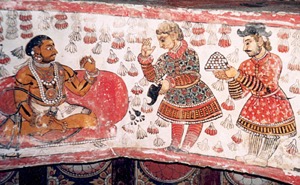
The workshop concluded with a roundtable formed by Nandini Das, Zoltán Biedermann and Guido van Meersbergen. The three discussants reviewed the many issues raised throughout the previous panels. Nandini Das opened the debate by arguing that the study of cross-cultural diplomacy should take into account the individual perceptions and emotional reactions of those who participated in cross-cultural interactions. Besides the analysis of personal affective narratives, the cumulative influence of the experiences and memories of diplomatic agents should also be explored with more detail, in order to better understand the connections between diplomatic practices, cultural memories and the movement of people. Another important question that needs to be explored with more attention is the reaction that host societies had to the diplomatic practices brought by Europeans, and the ways in which the host nations also passed through a process of learning and accommodation. Zoltán Biedermann’s intervention underlined the methodological difficulties in identifying and analysis personal feelings in the existing sources. Biedermann also noted that the difficulties faced by most Europeans in imitating or adapting to South Asian diplomatic practices. Such problems reveals that there was a long and complex process of learning specific diplomatic modus operandi, one that mobilized different cultural experiences and political traditions which requires a careful use of concepts such as ‘connected histories’ and ‘mondialisation’. Guido van Meersbergen’s comments highlighted the need to consider the existence of a Eurasian continuum while analyzing the many ways how Europeans developed practices based on Islamic diplomatic culture. The role of prejudices in cross-cultural diplomatic encounters should also be reconsidered, especially when examining the performance of rituals, the exchange of correspondence or the classifications of social and ethnic groups.
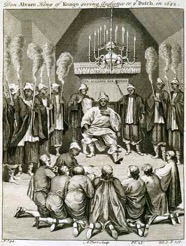
The discussions raised by the papers and the roundtable focused around several key aspects of the recent studies on early modern cross-cultural diplomacy, suggesting future paths for research. All the participants pointed out the need to develop comparative studies based on a cross-geographical focus, as well as on the confrontation of different types European and Asian or African sources. The success of such an approach will necessarily require collaborative works joining scholars studying different regions and with varied linguistic skills. Another issued debated throughout the workshop was the importance of understanding the differences between the figure of the ambassador and the practices of diplomacy, which often involved a myriad of other formal and informal agents that played a pivotal role in establishing contacts and negotiations. The discussions also pointed out the need to examine the importance of religion in diplomatic rituals, as well as the role of religious figures as diplomats.
Cross-Cultural Diplomacy Compared was indeed an excellent space for discussion which allowed the authors of the most recent ground-breaking studies in early modern cross-cultural diplomacy to reassess their work and explore future avenues of research.
João Vicente Melo
Teaching recommenced this week at the University of Liverpool, and the TIDE project is likewise gearing up for a busy calendar over the coming spring and summer. The first weeks of 2017 have been a time of concentrated planning for the team, and we have been fortunate enough to be joined for several of these sessions by partners we have gained during our first semester. In the course of consolidating our plans and vision for TIDE, we have looked back across our first months, as well as forward to the months to come: something of a double blog here, then, to make up for the holiday break.
Our first term as a project concluded, just ahead of Christmas, with our formal launch. Held in the Old Library, School of the Arts, we were joined by School and Faculty colleagues from across a number of disciplines. Guests also included University engagement and development staff, postgraduates, academics from John Moores and Liverpool Hope universities, and representatives from community arts and regional cultural initiatives.
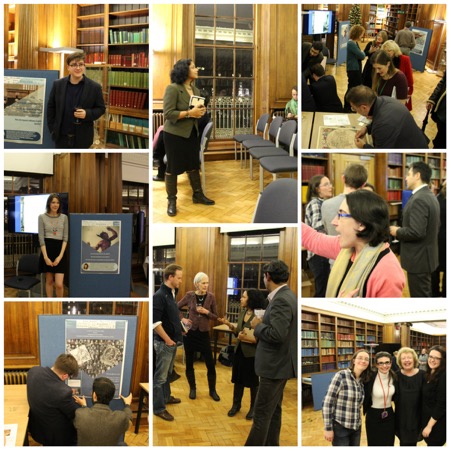
We were also delighted to host the award-winning poets Vahni Capildeo and Sarah Howe, as well as actors and staff from our neighbours, the Everyman Theatre. Our aim was to engage attendees creatively with some of the project’s central concerns. After a brief introduction to our work from Nandini Das, Project Director, and a welcome from Professor Paul Simpson, Head of English, each of the poets performed a selection of their recent works, before the actors read aloud extracts from a number of primary materials chosen by the team.
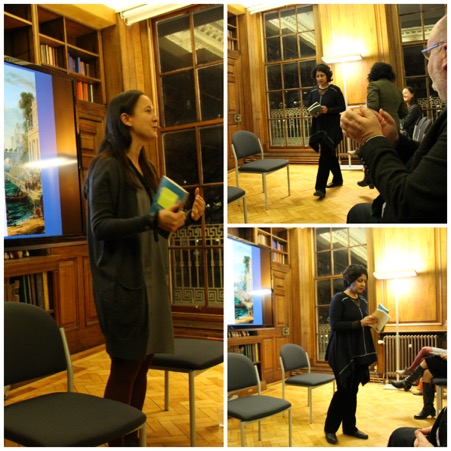
Our poets’ readings suggested some of the intricacies attached to human movement and travel. For its ‘enthralling exploration of self and place, of migration and inheritance’, Howe’s first full collection was awarded the T. S. Eliot Prize in 2015. Awarding Capildeo’s latest collection its 2016 winner, the Forward Prize for Poetry said of the volume, ‘When people in the future seek to know what it's like to live between places, traditions, habits and cultures, they will read this’. It was a real pleasure to meet the poets, and we are delighted that Sarah Howe will return to TIDE in 2018, as our Visiting Writer.
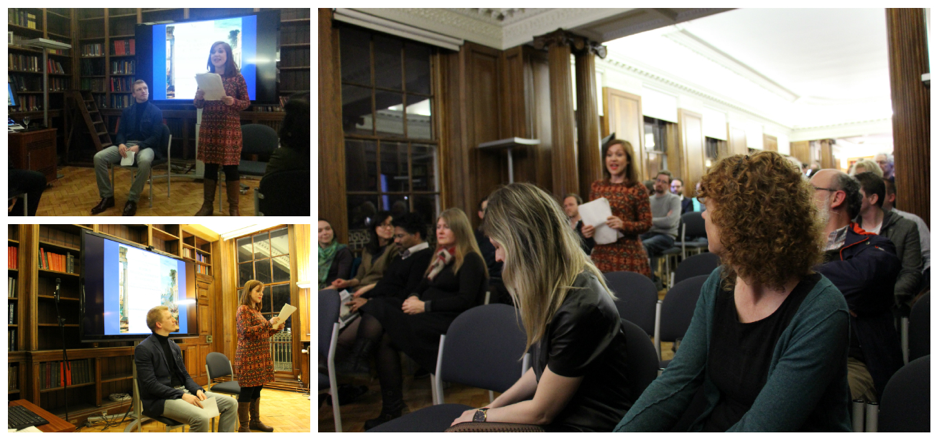
The performed extracts provided another stimulus for approaching cross-cultural encounters and exchange. Hearing first-hand written accounts, also read aloud, lent a new immediacy to these individual transcultural navigations, into and out of early modern England. A hat-making Flemish refugee writes to his wife on the attractions of Norwich – with a shopping list of items missed from home; an African scholar, by turns traveller, hostage, and convert, wryly invokes fable to consider our shifting motivations to belong. The rehabilitation and analysis of such voices, whether famous or forgotten, is core to the work envisioned for TIDE. This will be pursued, particularly, through our planned 24 case studies, running from the project’s second year.
Following these readings, attendees were invited to browse our displays, which posed questions underpinning our various research strands and detailed our current work, including that on Keywords (on which, more below). These stands prompted lively discussion amongst attendees, and highlighted many possibilities for partnership, outreach, and further project research.
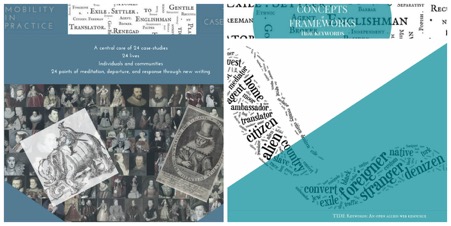
We were keen to use the evening to prompt interaction with our work, rather than merely to present it, so attendees were invited to chart their geographical histories onto a bespoke 1641 world map, using pins and string. Of the finished result, Professor Das wrote: ‘the map provided a potent visual example of . . . entangled trajectories; bringing to life the global connections between peoples and countries that the project seeks to illuminate’.
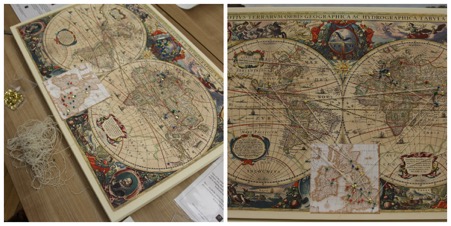
The launch also marked the arrival of our third postdoc. Joining us from Barcelona, João completes our initial team, and the launch seemed a fitting way to welcome him full-time onto the project. The international make-up of the TIDE team is, we feel, a strength of the project. As the project progresses, our planned activities across Europe, America, and Asia will no doubt benefit from the global links already represented within the TIDE office. With most of us travelling to take up our positions with TIDE, it seemed a fitting celebration when the team too, all now in situ, added our travel threads onto the map. This now holds pride of place – fully pinned, and a real conversation starter – over the office mantelpiece.
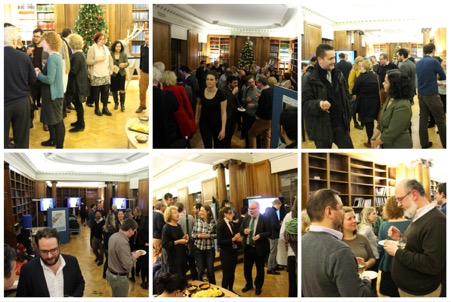
Finally, it was important to thank the strategic and support staff who assisted with establishing TIDE and the project office here in the School of the Arts in 2016. As TIDE’s administrator, I would like to extend our thanks, again, for the many forms of support offered so generously to us during our earliest days.
To read the University’s own coverage of the event, with details of our research and engagement aims, plus our Visiting Writers programme, please click here.
Moving on, we are particularly pleased to have now begun work with our departmental linguists, in consultation with linguistics-led projects further afield, on our Keywords strand. You can follow our progress through our chosen catalogue via #TIDEKeyword, on our Twitter account; we will be building an open access web resource in order to share our findings, over summer 2017.
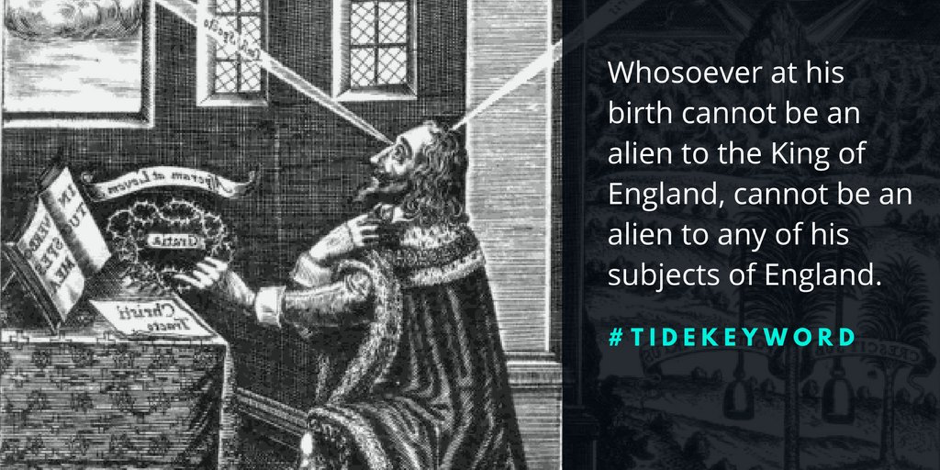
On social media, also look out for our upcoming #Gateofaccess digital media partnership, launching mid-February. TIDE will be working with curators and archivists to showcase early modern artefacts, in particular those objects which are lesser-known or not on permanent display.
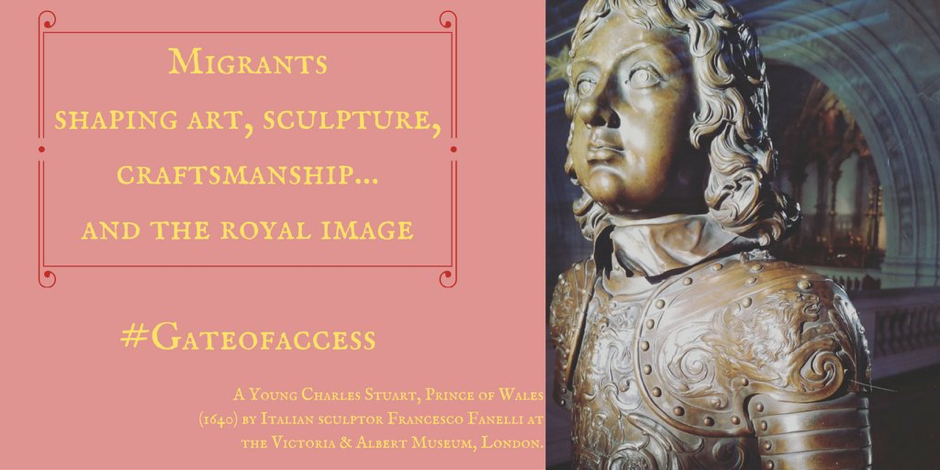
We are currently working with Special Collections staff at the University of Liverpool itself, before expanding the series into partnership with other local, national, and international collections. This week the postdocs have been lucky enough to delve through the University’s museums and libraries holdings, and were surprised by some of the objects our archivists had uncovered. We hope that by sharing these objects, all from 1550-1700, and, moreover, by examining their untold stories and contexts, the project will illustrate new and unusual routes into understanding the period.
And while you are online, watch out for a flurry of #TIDEtravels tweets over the next few months. Having started with a workshop in Warwick and meetings in Oxford last week, members of the team are soon off to a number of events in Manchester and London, with conferences in Barcelona, New Hampshire, and Illinois already scheduled in between now and June. Our social media will cover our out-of-office research trips: check out our Twitter and new Instagram pages for a peek at where we’re headed and what we’re up to.
As well as travelling ourselves, we look forward to the arrival in late April of our first Visiting Writer, novelist, essayist, poet, and playwright Fred D’Aguiar, Professor of English at UCLA. Fred D’Aguiar will fly from Los Angeles for a fortnight’s residence at TIDE, taking in both our Liverpool and London campuses.
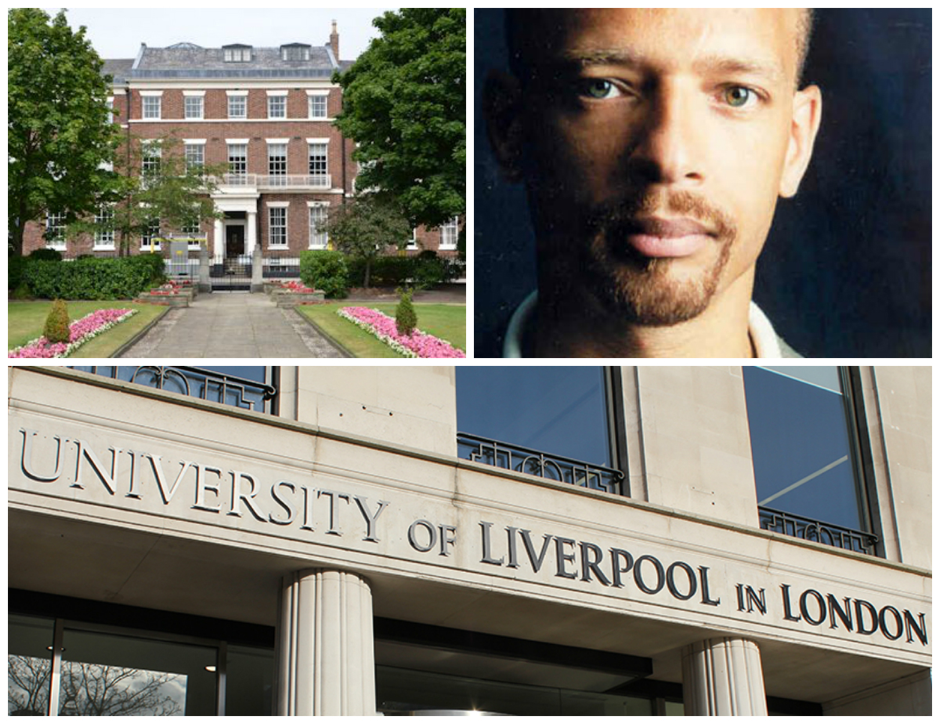
Right now our postdocs are surrounding themselves with archival materials, and collating their best findings to spark Fred’s imagination with insights into the diversities of early modern London, and just some of its many voices, before he joins us later this spring. Fred will then produce new creative work over the following six months, in response to his time spent with the project.
Either side of Fred’s visit, and again across our Liverpool and London sites, we are also planning half-day research seminars, in March and June. Aware of how swiftly our first year is passing, we also look ahead with excitement to the expansion of our team in our second year. Do check back in with us for further news of this, as well as events in the pipeline for autumn, very soon. With best wishes from all at TIDE!
Emma-Louise Whitehead (Project Admin)
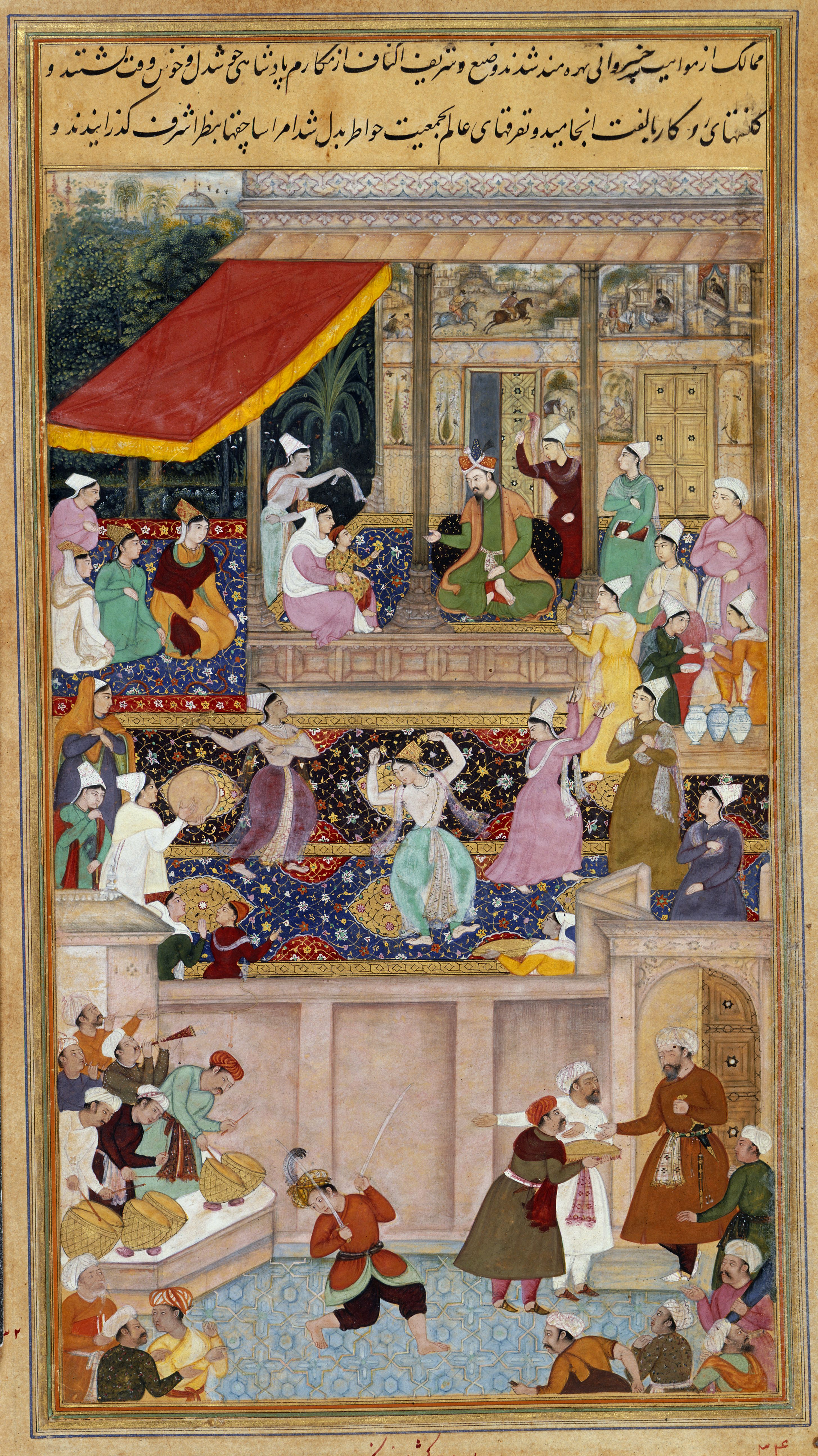
Image: The British Library
A small boy sits in his mother’s lap. Around them is a scene of great rejoicing. Music plays, people holding gifts and wearing turbans look on in adoration. But at the centre, the child and his parents gaze at each other with single-minded focus: for them, nothing else exists. The parents have wandered long as exiles, dependent on the charity of others, but now a great moment of change is finally upon them. The boy’s father looks deceptively calm, but he points his hand towards the child, as if to say – look, here he is – the boy who will be the shelter and refuge of the whole world.
The setting may sound terribly familiar when I put it this way. Not all is as it seems, though, because the actual painting that I am describing is very far from the image that a description like this is bound to evoke in this season. There are no stars here, no shepherds, and certainly no farm animals. Instead, there is the glint of the two swords that the juggler in center foreground holds in his hands. A group of musicians to our left play kettledrums and bugles. In the middle distance, there are dancing girls. The child and his parents sit in a rich pavilion of scarlet and gold.
But if you squint and peer beyond them in this small painting, which can be seen on the British Library’s superb digitised manuscripts site, on the walls of that pavilion you’ll see yet more paintings – tiny murals. In the first of these, there are men on horseback in a more familiar countryside setting. In the next panel, the three men have dismounted, they now kneel in front of what looks like a tiny figure with a child on her lap. That, now, looks like the familiar Adoration of the Magi. But what it is doing here takes us back to a moment when two very different worlds came together more than 400 years ago.
Jalal-ud-Din Akbar, Jahanpanah (‘Shelter of the World’), Shahanshah (‘King of Kings’), the third and perhaps greatest ruler of the sprawling empire that dominated the subcontinent from the sixteenth century till the 1850s, commissioned this book, the Akbarnama, in the late 1590s, and the manuscript in question was probably prepared around 1602-03. One of its most striking early stories tells us how Akbar, separated as a baby from his parents when his father Humayun had been exiled from India, was reunited with them at the age of three. The painting I described accompanies that story, showing the moment when, in a test devised by his father, Akbar demonstrated his ‘divine light’ by recognising his mother in a crowd of women after the long separation – and rushed unhesitatingly into her waiting arms.
The scene in the mural behind the mother and child might be a tacit acknowledgement of the shared elements between Islam and Christianity, but to leave it at that would only be half the story. Akbar’s curiosity about other cultures and religions was well-known. He commissioned translations from Sanskrit and other languages into Persian, the official language of the Mughal empire, and experimented with the idea of a syncretic religion. One of his radical ideas was the establishment of a debating hall, the Ibadat-khana, where intellectuals of all faiths came to discuss matters of philosophy and religion. It is here, in 1580, that some new guests arrived, like a very different journey of the magi – three Jesuit fathers whom Akbar had invited from the newly established Portuguese settlement in Goa. The Jesuits knew Akbar’s reputation as a great connoisseur, so instead of trivial gifts, they brought books and paintings – Albrecht Durer’s ‘Virgin and Child’ was among them, and a copy of a multi-volume illustrated Bible. They celebrated Christmas in Akbar’s presence, and displayed a crib decorated with religious paintings. In the extreme right-hand corner of those tiny inset wall-murals in the Mughal painting of Akbar’s childhood, you can see a figure, dark-robed like a Jesuit priest, looking on.
The Jesuits were of course keen to convert the Mughal emperor, but despite their hopes and hours of conversation, that did not happen. What did occur, however, was much more interesting. At the studios of the Mughal court, Hindu and Muslim artists pored over accumulating examples of ‘exotic’ European images and techniques. The result is a breath-taking fusion of cultures. Among the albums of paintings produced at successive Mughal courts, therefore, we find exquisite pieces that range from copies of Durer’s engravings and Michelangelo’s Noah from the Sistine Chapel, to European elements seamlessly absorbed into Mughal matter – angels and haloes, cherubs with wings, flowers, gowns, European-style cross-framed chairs.
And then, of course, there are paintings like this one, where the conversation among cultures almost goes unnoticed. Between the child and mother in the foreground, and the pair we can only just make out in the background, there is a world of difference. Yet there is acknowledgement of an innate human connection as well, an acknowledgement of displacement and exile, of losing homes and coming home. This painting, now digitised like many items in the British Library’s collection of Indian art and manuscripts, is evidence of the extraordinary creativity of the court with which Europe, and especially the British, would have a close but tumultuous history of interaction in centuries to come. But more importantly, it is evidence of a kind of curiosity – of the ability to ask, to listen, to enter into a conversation and to draw connections rather than boundaries – that no written record can convey.
Nandini Das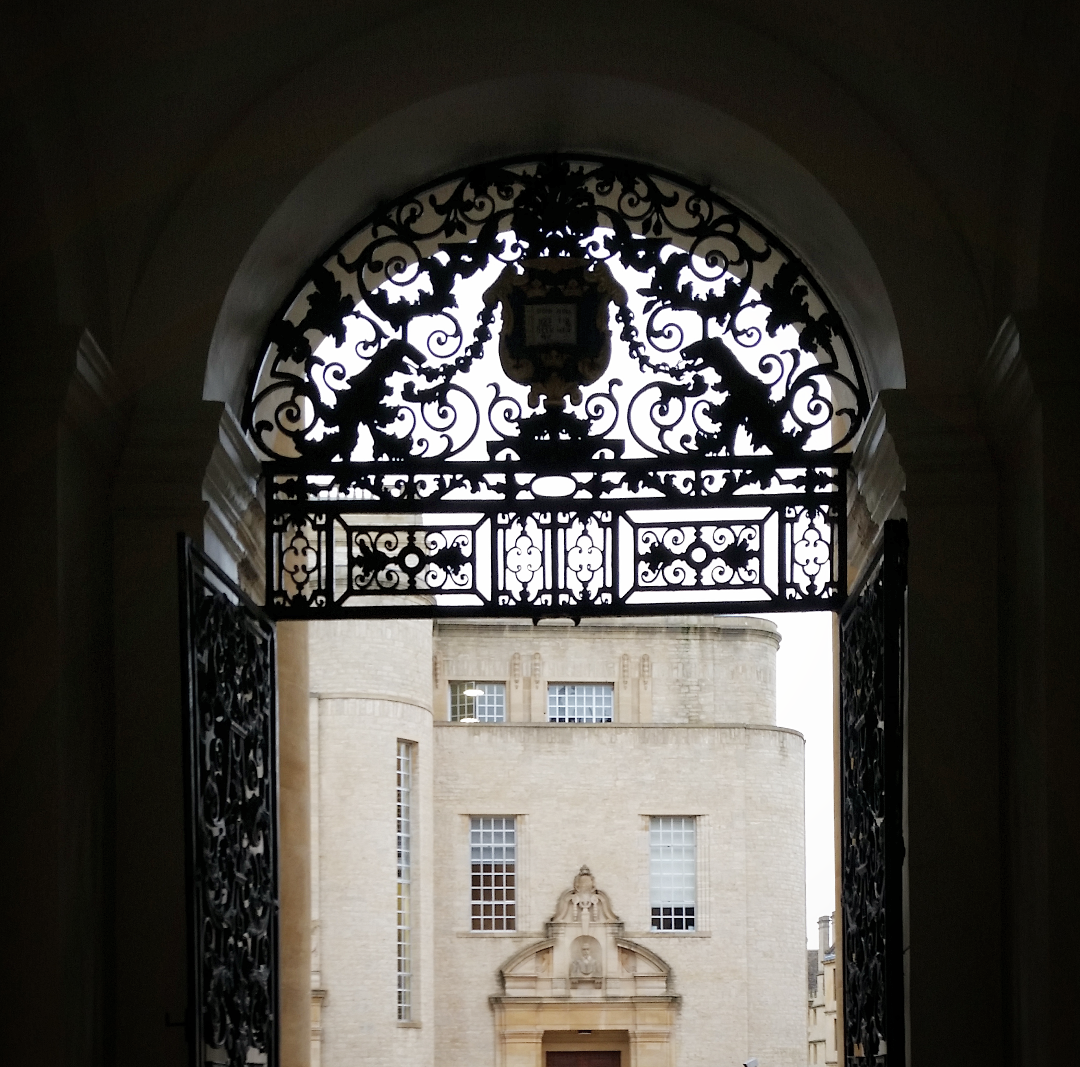
The geographer and clergyman Richard Hakluyt died in good company: 1616 also marked the death of two internationally-renowned writers, William Shakespeare and the Spanish author Miguel de Cervantes. Shakespeare's iambic pentameter and Cervantes' re-working of chivalric romance have continued to grace school curricula and playhouses around the globe; by comparison, Hakluyt's impact is less immediately apparent.
The Hakluyt Society, in conjunction with the Bodleian Library and Museum for the History of Science in Oxford, held a two-day conference in November 2016 to examine Hakluyt's legacy at the four-hundredth anniversary of his death. His two editions of The Principal Navigations, Traffiques, and Voiages of the English Nation (1589, enlarged 1598-1600), have long been considered some of the most important collections of English travel writing ever published, and the conference assembled an international cohort of speakers who presented current research on their work for the forthcoming Hakluyt Society edition of The Principal Navigations. A number of scholars discussed the particularities of English interactions with indigenous peoples, from Africans in Guinea to the Algonquians in Virginia. Mary Fuller examined the casualties of Anglo-Inuit exchange in the English search for the Northwest Passage, and complicated the "us" vs. "them" mentality of English voyages by highlighting the heterogeneity and factions among ship crews. Other papers engaged with the continuity between state policy and trade in the late middle ages and early modern period through Hakluyt's inclusion of a fourteenth-century poem; the importance of naval history and the experience of seamen in effecting expansion; the mercantilist emphasis of Hakluyt's second edition; and the English desire to exploit global markets, such as Indian cotton. Joyce Chaplin delivered a keynote lecture that argued that English attitudes towards natural resources and climate-based notions of human physiognomy set the groundwork for the enslavement of non-European peoples, to disastrous consequences.
The discussions that emerged from the papers centred around several key aspects of early modern global historiography, suggesting future avenues for research. One is the continuing development of environmental studies and ecocriticism as important approaches in the history of expansion, which was, after all, fundamentally about land and the exploitation of its resources. As Joyce Chaplin put it, pro-imperial authorities and their agents saw a relationship between economies and ecosystems. The Greek oikos and the Latin oeco were terms that denoted households, but also the management of the estates themselves. Secondly, papers highlighted the need to reconstruct the experience of non-European peoples, especially their capacity to dictate the terms of Anglo-indigenous exchange. Surekha Davies pointed out that instances of the passive voice in Hakluyt might offer hints as to moments when indigenous peoples dominated colonial encounters, at times when Europeans struggled to successfully dictate the terms of the exchange. Related to attempts to recalibrate approaches to intercultural encounters, other papers emphasised the value of using non-English language sources to enhance and complicate global historiography. Persian accounts of English diplomatic missions, such as Anthony Jenkinson's in the 1560s, both offer correctives to the source manipulation of Safavid chronicles while offering new perspectives on English writings about diplomatic encounters in the east. Finally, presenters stressed the ongoing importance of tracing the intimate networks between patrons, merchants, gentlemen, and travel writers who produced knowledge about, and effected, empire, which was nothing if not a collaborative effort.
The conference concluded with a public lecture by the historian and BBC broadcaster Michael Wood, who used early modern travel narratives from Asia and South America to question the very idea of discovery: who, he asked, really "discovered" whom in any given exchange?
Scholars today are wary of celebrating Hakluyt's use of geography, given his imperial aims, but Principal Navigations remains a rich source for accessing the lives of individual agents, and for understanding large-scale historical change. To Hakluyt, the English would not thrive from insularity, and could only find themselves by engaging with the rest of the world.
Lauren Working
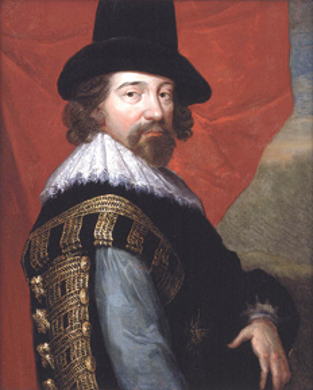
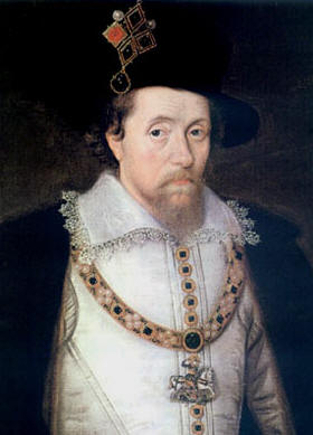
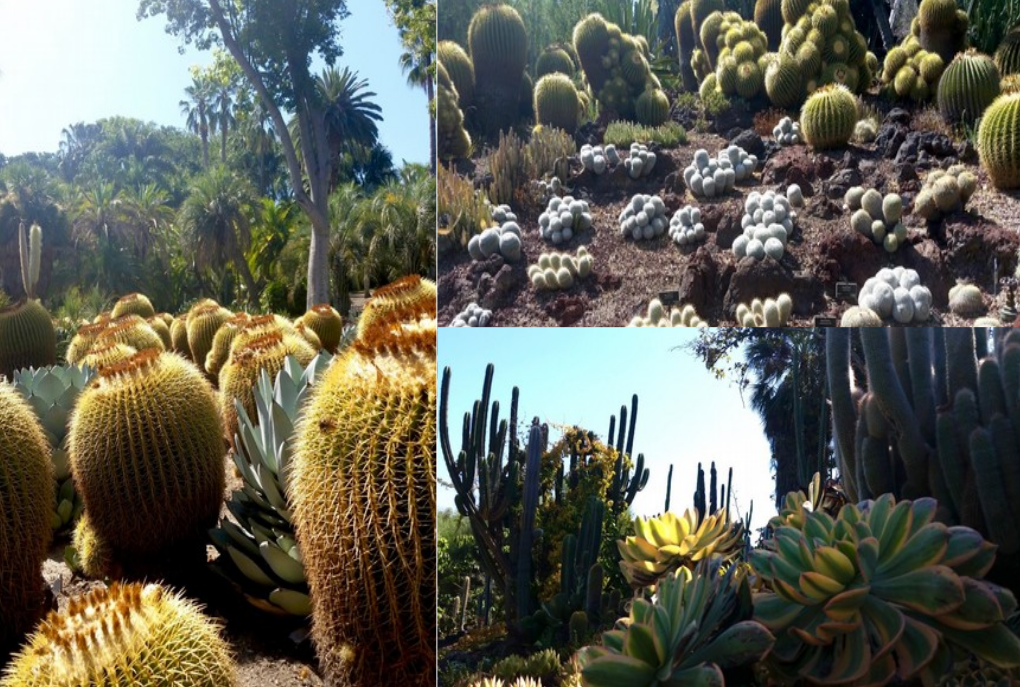
Image by Lauren Working
I recently returned from a warm and fruitful summer at the Huntington Library in California. As a short-term research fellow, I went to explore how English attempts to ‘civilise’ other peoples in the Elizabethan and Jacobean eras informed the way writers and policy-makers articulated their own civility and conceived of their political responsibilities, at a time when the success of English colonisation was by no means secure.
The first age of expansion exposed English men and women to diverse cultures, but it also forced the English to see their own values in relation to the peoples they encountered. A strange mix of curiosity and disdain, vulnerability and superiority mark many speeches, plays, and political discourses from this time. The Scottish king James VI’s ascension to the English throne in 1603 created intense, often xenophobic concerns over the influx of Scots in England, for example. Libels and satires mocked the king’s Scottish entourage at court, and in Calvin’s Case (1608), the highest justices of the realm debated whether the king’s Scottish subjects were entitled to English privileges, such as land-holding in England, or whether they remained legal ‘aliens’. Debates over how to categorise or assimilate foreigners were accompanied by images that perpetuated assumptions about the perceived inferiority of those beyond England, whether in the Highlands or in America:
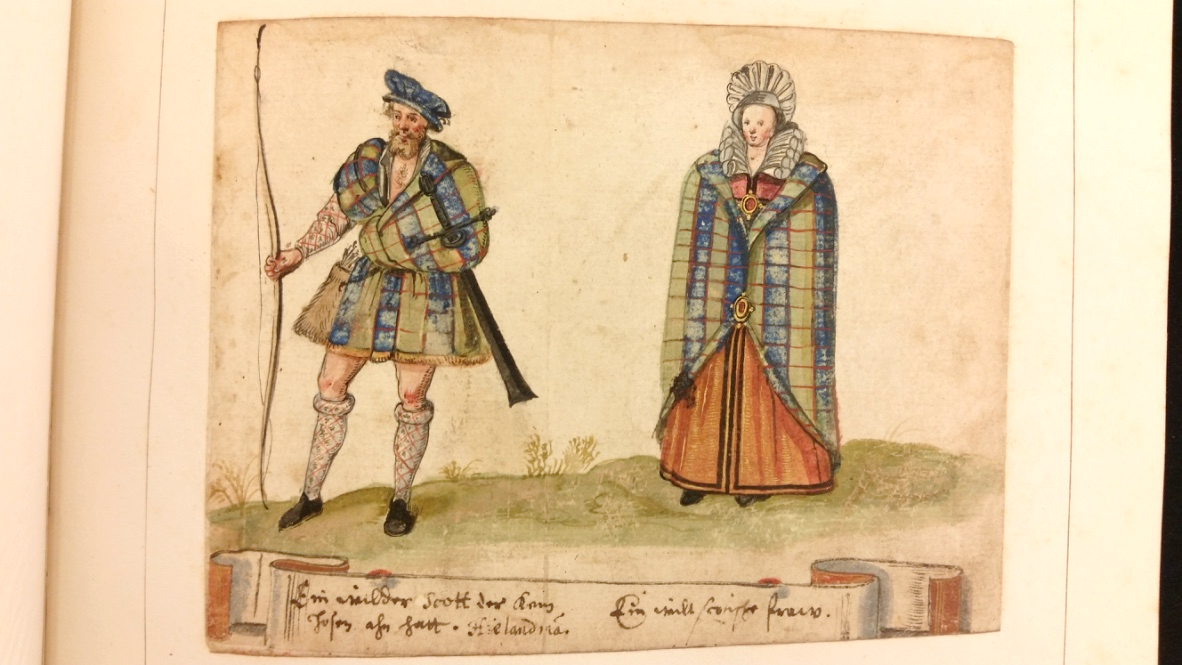
Huntington Library MSS: HM 25863, f. 28r.
Image by Lauren Working.
Authorities in Protestant England attempted to enforce strict codes of personal behaviour as a means of social control: civility became an important component to creating a godly, obedient society, and intercultural encounters played a role in how these manners were articulated. Moral literature probed the tensions between virtue and travel, between the exoticism of other cultures and fears of internal corruption. At the Huntington, I found that conduct books, with their discussions over the rising fashion for tobacco smoking, provided rich sources for thinking about the influence of intercultural exchange on the social lives of London gentlemen.
In 1617, Richard Brathwaite translated a humorous Continental drinking manual into English, adding a unique component of his own. Dedicating half the text to the subject of tobacco, Brathwaite framed the urbane gentleman as one informed by, and invested in, the world beyond him. The text mentioned Africans and Bermuda, Ireland and navigation. It also expressed an awareness of status – not just between Englishmen and non-Englishmen, but between the elite and non-elite. Projecting stylish gentlemen as witty versifiers and frequenters of tobacco houses, juxtaposed against the ‘common sort’ who visited alehouses and who failed to follow the carefully-prescribed rituals of gentlemanly social interaction, Brathwaite’s text insinuated that members of the ruling elite were those who possessed the necessary civility and political acumen to successfully oversee colonization: that even the potentially destabilising influence of an indigenous commodity like tobacco might be artfully incorporated into the rites of sociability and informed discourse.

Huntington Library, 60460.
Image by Lauren Working.
Early colonial texts and maps are among the many celebrated collections at the Huntington, but its costume books and conduct literature offer some clues as to how the ideas behind empire and state were conceived and enacted – not beyond the realm, but within it. As TIDE aims to investigate in coming months, the intermingling of cultures shaped domestic institutions, discourses, and narratives through relationships and processes that must be approached beyond oppositional terms like ‘self’ and ‘other’, or ‘European’ and ‘native’, to those in between.
When most people think of the great age of travel and discovery in the sixteenth and seventeenth centuries, they think of great ships, of voyages and new worlds. They think of intrepid adventurers going out to discover new countries and new peoples, of colonisers laying claim on places whose very existence had been unknown to Europe before their arrival. But that’s only part of the story.
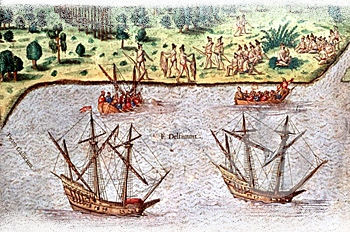
The great age of travel and discovery was also a period when cross-cultural encounters led to radical developments in the way we think about human identity. Human movements across borders increased under the combined impact of multiple political, economic, religious and social factors throughout this period. And as they did, the ways in which we think about difference – between countries, between races, between one human being from this part of the world and one from another – developed rapidly as well, and began to take recognisable shapes and forms.
This is an active, rapidly growing field of scholarship. We are increasingly, and perhaps unsurprisingly, attending to the impact of such cross-cultural encounters from a number of disciplinary perspectives. However, in a field that tends to be framed predominantly in terms of cultural clash and boundaries, there is both room and a need to explore a different story: the story of transculturality and betweenness. In a period marked by mobility, what did it mean to belong, or not to belong? What did it mean to move between cultures, countries, languages, faiths? How did you see yourself, and how did others see you, when you did so? Were assimilation and segregation the only two options available? Could one not be both this and that, a third thing, both part of the world one had left and the world one occupied? These questions seemed urgent enough when the idea of TIDE was formulated a few years ago, but against the backdrop of the unprecedented scale of crisis and anxiety about human mobility and migration that has unfolded since then, they seem even more important to ask, and to understand today.
In sixteenth century England, such questions brought up some of the earliest debates about nationhood, birth-right, about the impact of such human movements – be it willing or forced – on economic stability. Elizabeth I’s repeated licenses granted in the 1590s to the merchant Casper van Senden to deport black strangers brought over to England strike a strangely familiar note. They are ‘to the great annoyance of her own liege people,’ she writes, who ‘co[vet] the relief which these people consume’. English social history is full of that invisible black presence which has only recently begun to be excavated.
Elsewhere, English movements abroad also brought up issues about identity, contending loyalties, and the fraught boundaries between religious and national affiliations. When an Englishman changed his faith, was he still an Englishman? In the summer of 1586, the first English ambassador to the great Ottoman empire, William Harborne, wrote a letter pleading for the release of some English sailors taken prisoner by the Ottomans. His letter is addressed to ‘Assan Aga, Eunuch & Treasurer to Hassan Bassa king of Alger, which Assan Aga was the sonne of Fran. Rowlie of Bristow merchant, taken in the Swalow’. Suddenly, what seems to be international diplomatic correspondence becomes a letter from a Norfolk-man to the lost son of a Bristol merchant, exhorting him to be ‘another Joseph’ and do his utmost to help the English cause.
At home, literature provided a means through which such questions and anxieties could be probed, tested, and pushed to their limits. What does it mean when Shakespeare has his Moorish convert Othello say at the end of his play:
Set you down this And say besides, that in Aleppo once, Where a malignant and a turban’d Turk Beat a Venetian and traduced the state, I took by the throat the circumcised dog, And smote him, thus.
The incident in Aleppo involved a Muslim Turk who attacked a Christian Venetian. Othello says that he then smote that “circumcised dog” for hitting a Christian – so is he now, as he stabs himself, seeing himself as the Christian protector of Venetian honour, or the “malignant [...] Turk” who had raised his arms against Venetian honour and was therefore punished? What does our interpretation, and our affective response to Othello at this moment say about us?
And as both the playwright and his audience would have known, it did not require a different skin colour, or language, to make a ‘stranger’ of a human being. Shakespeare himself was legally a ‘stranger’ in the city of London – as would have been a good cross-section of his audience – economic migrants from other parts of England, whose collective presence made London the metropolis it was to become.
Over the next five years, I hope that TIDE’s investigation will help us to break new ground in understanding cross-cultural encounter from the perspective of its most involved agents: what it meant to be an alien, a foreigner, a stranger; how these terms – so supremely value-laden today – evolved; and how institutions of law, religion, society, and economy, and the human imagination through art and literature dealt with such figures. The outlines etched by that macroscopic enquiry will be filled in by our excavation of the trajectories of individual figures, by the illumination of the lived worlds of the people whom such terms attempted to encapsulate. And because such issues remain as potent and alive today, we will work closely with poets, novelists and artists who will help us to look at this material with fresh eyes. Even as our academic work attempts to rethink our current understanding of cultural differentiation and assimilation in this defining period, the writers’ meditations on the project’s themes, and imaginative responses to the project’s findings will provide a lasting legacy – an imaginative resource for the border-crossings of the future.
Nandini Das






